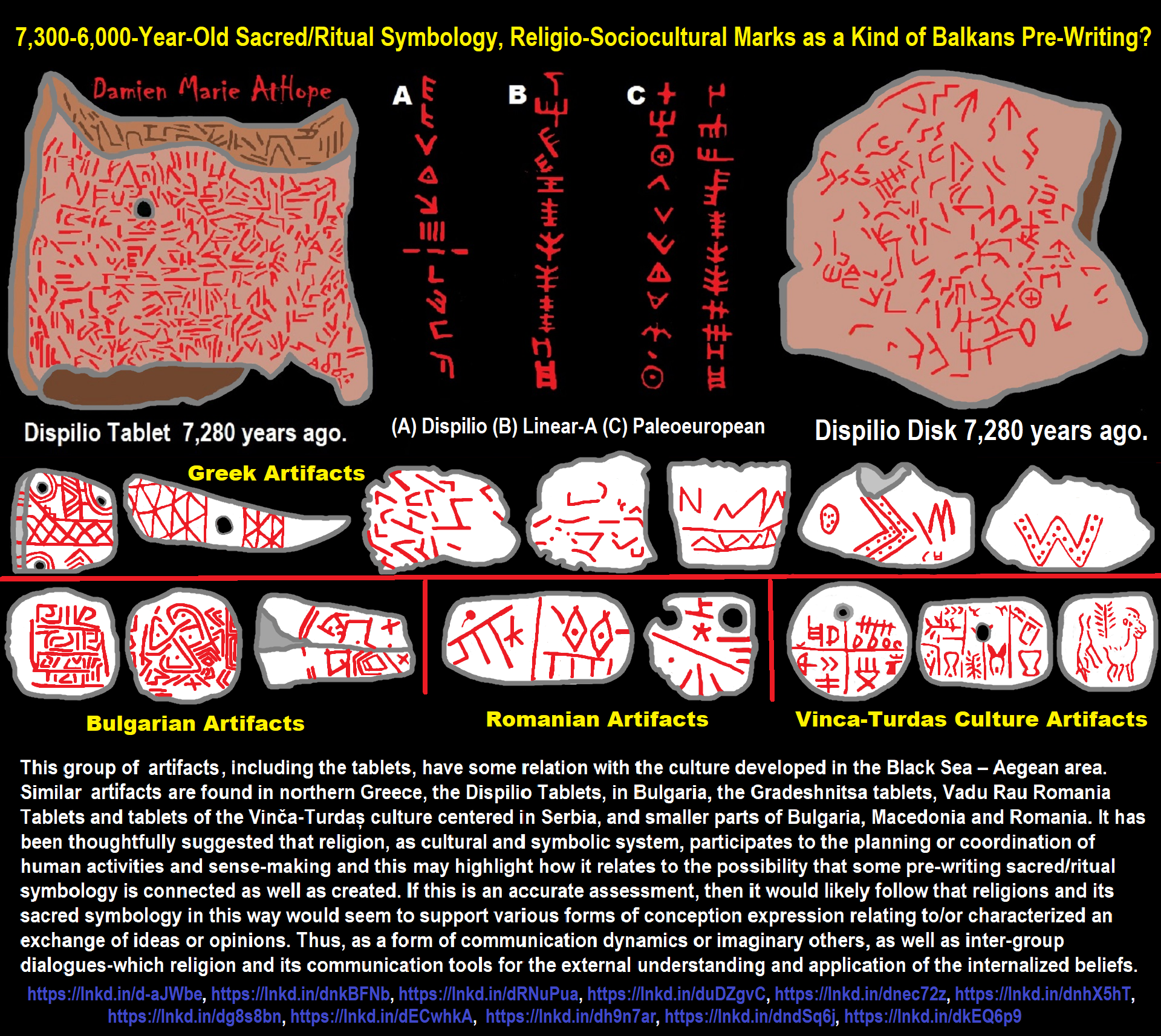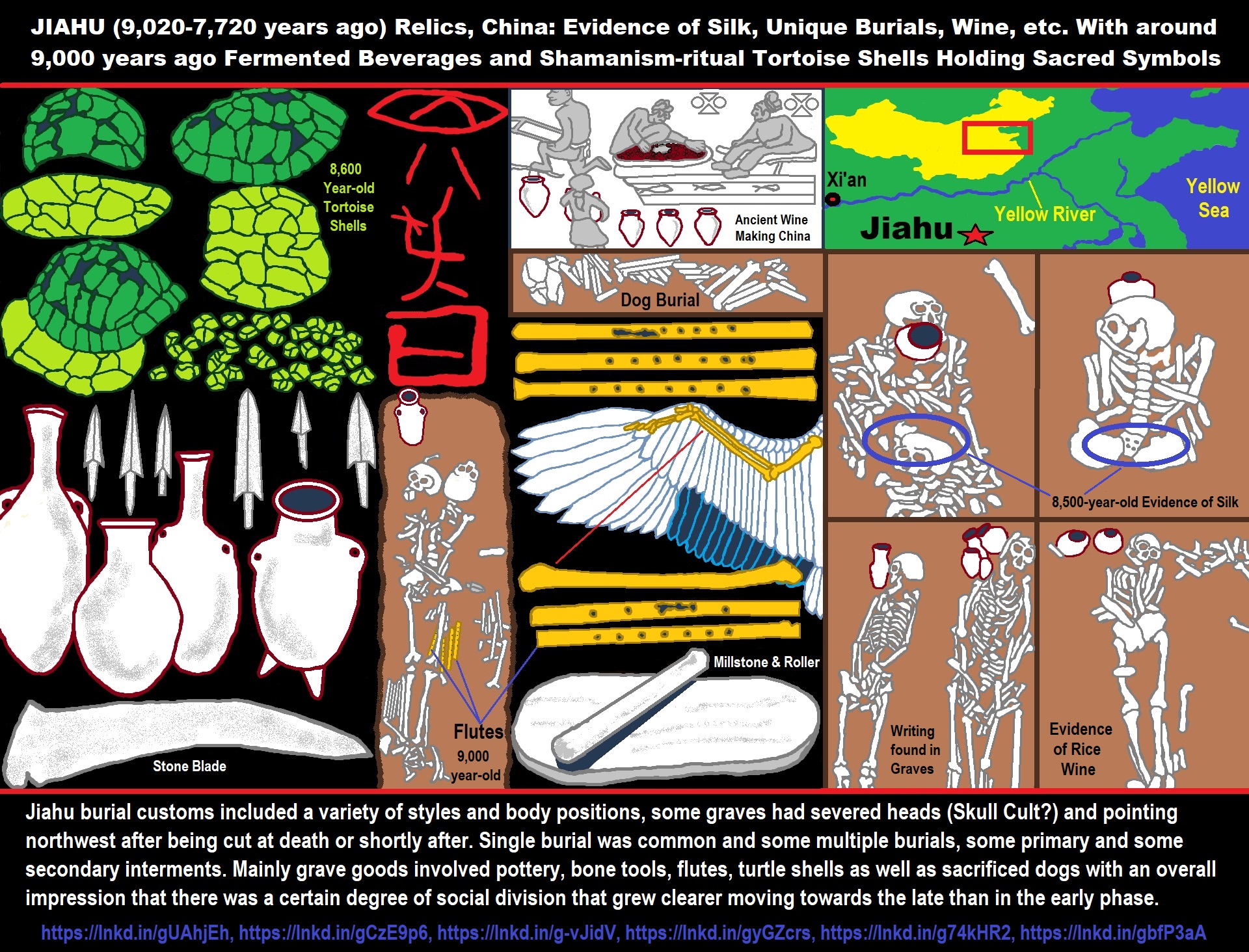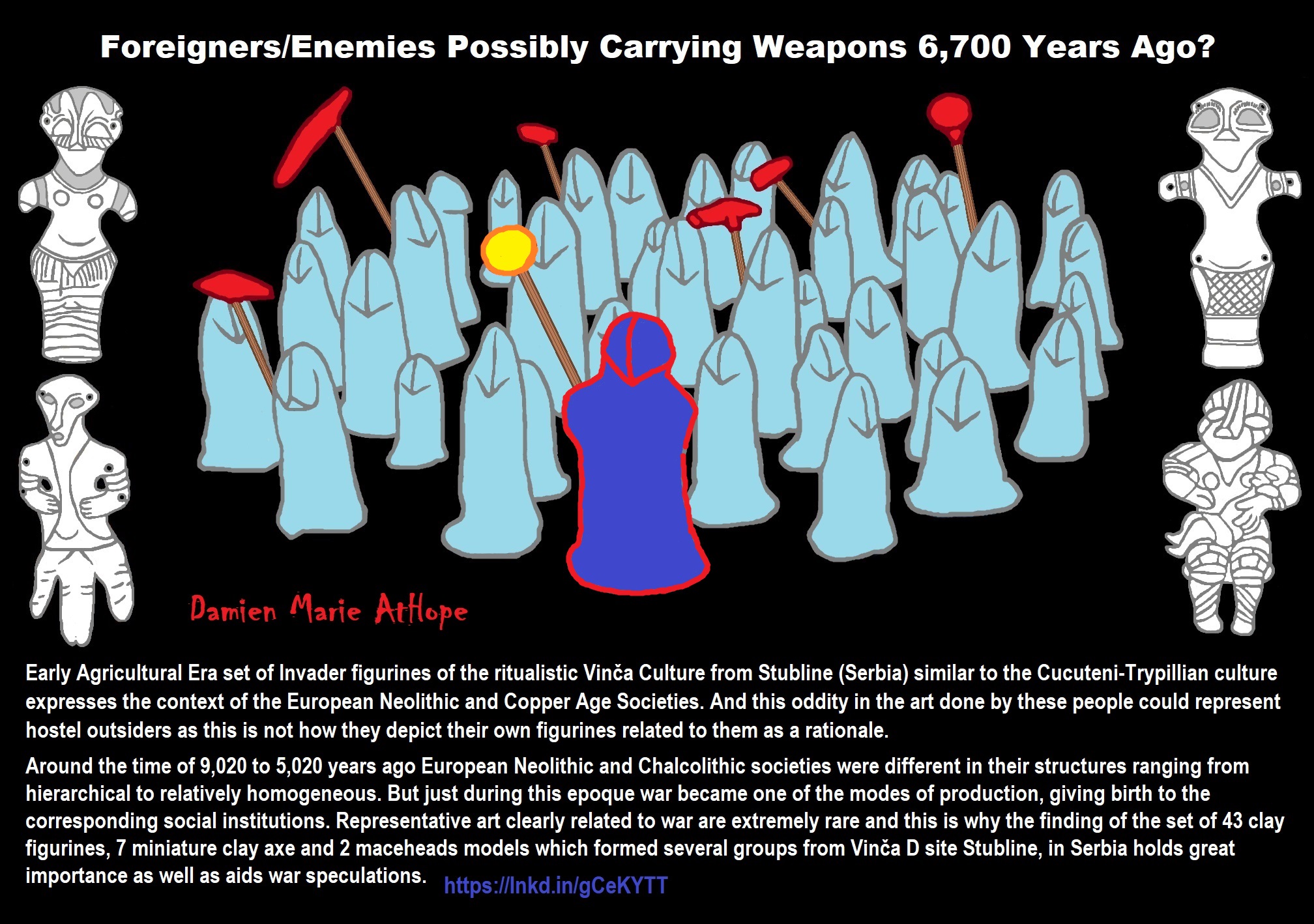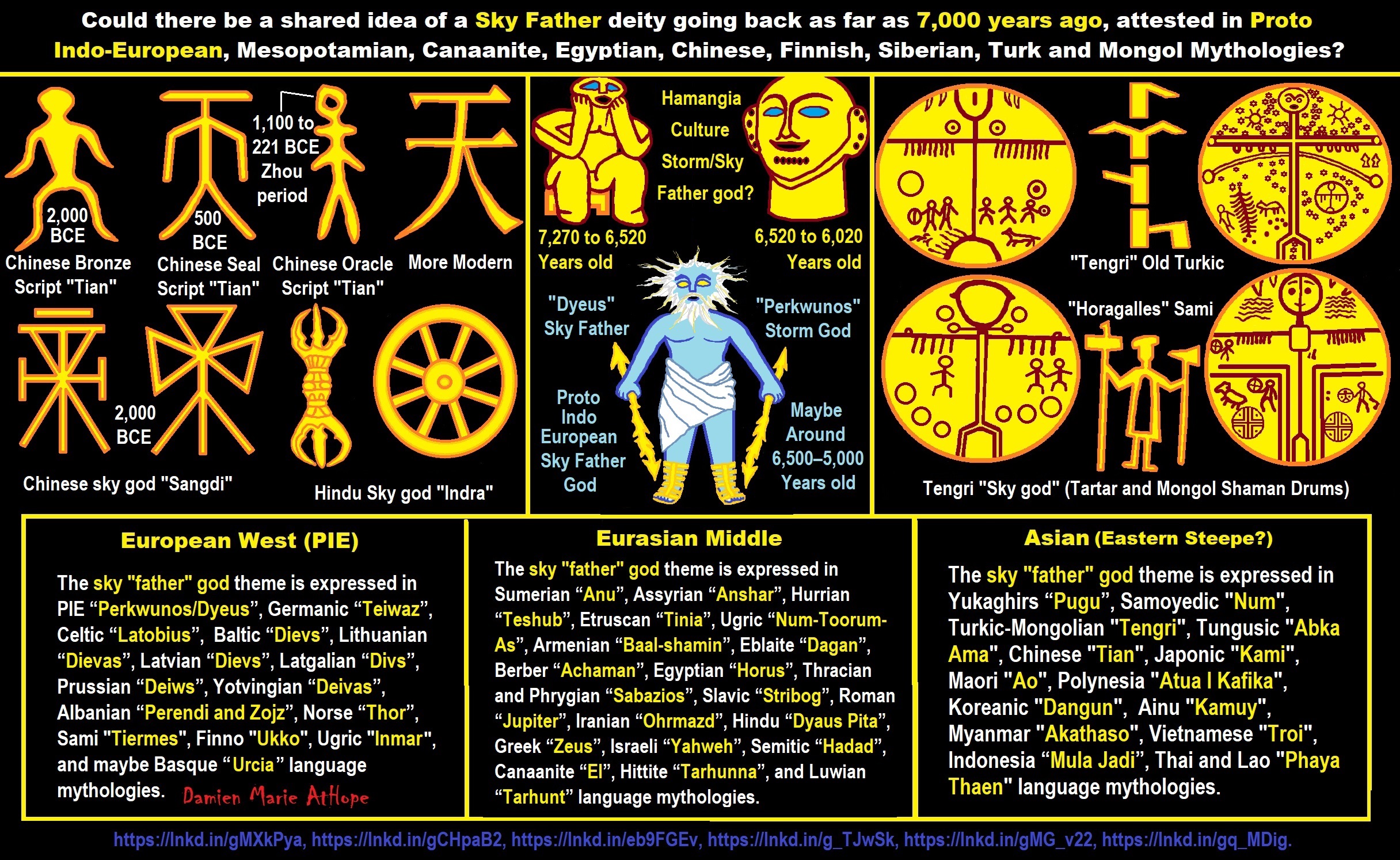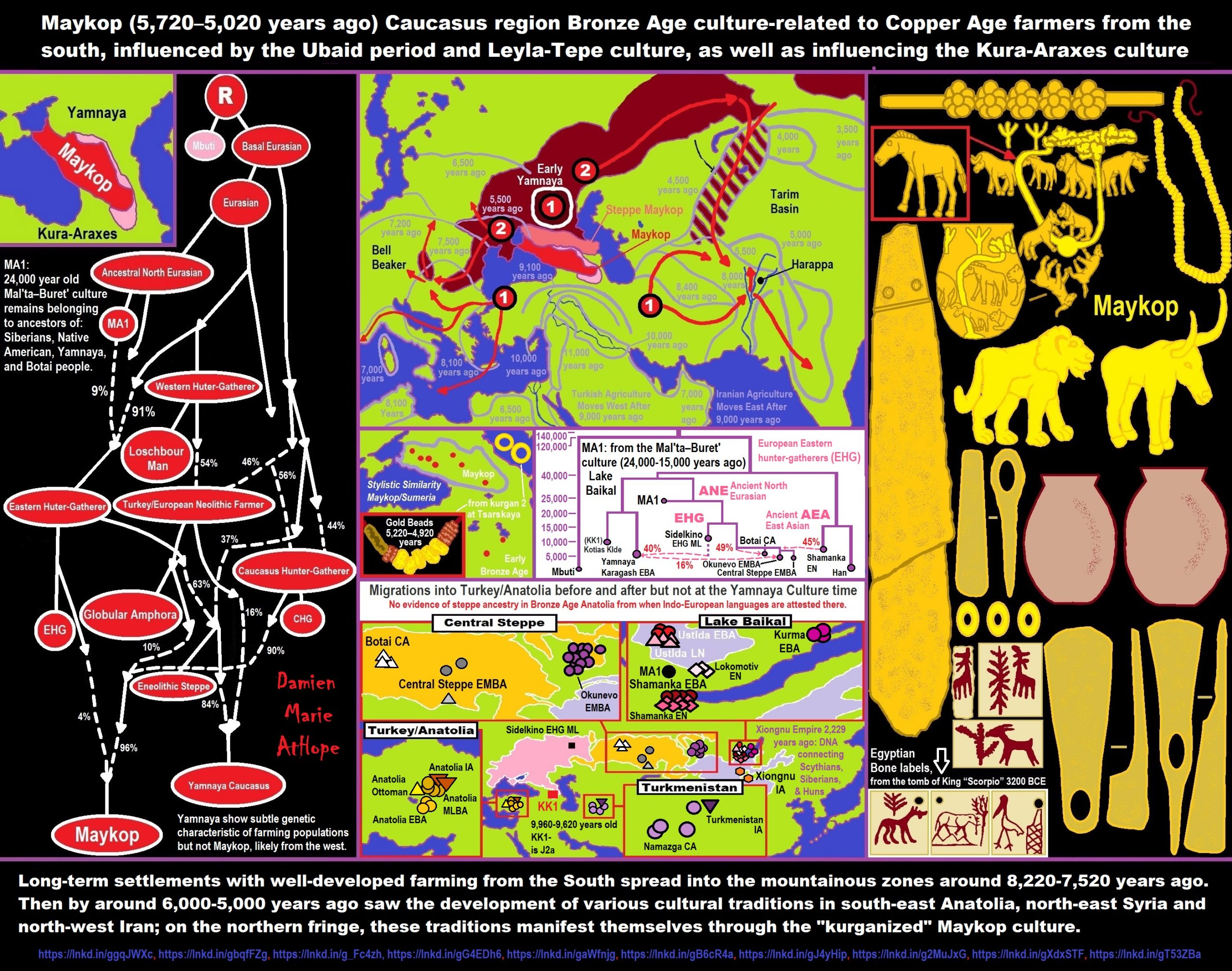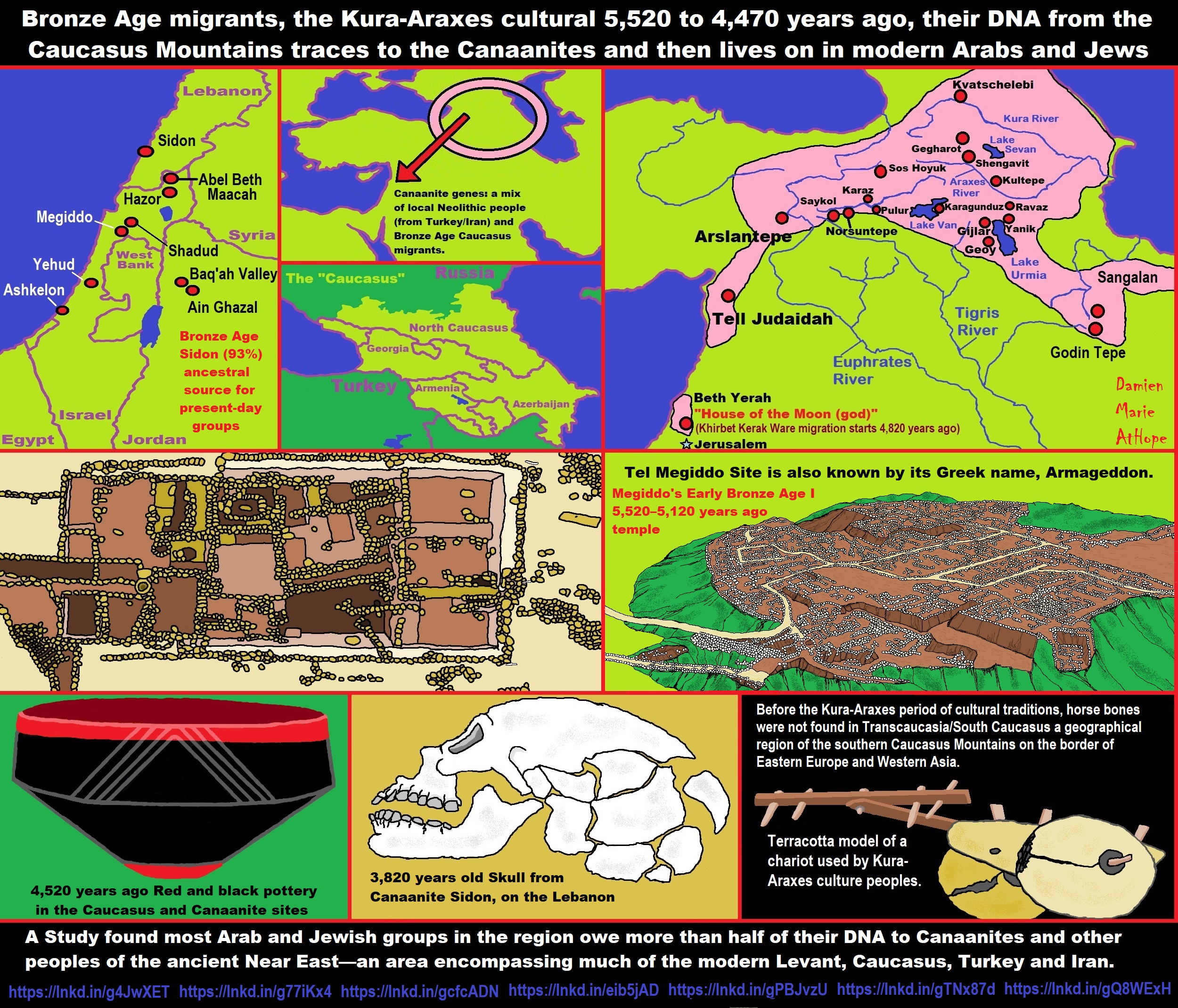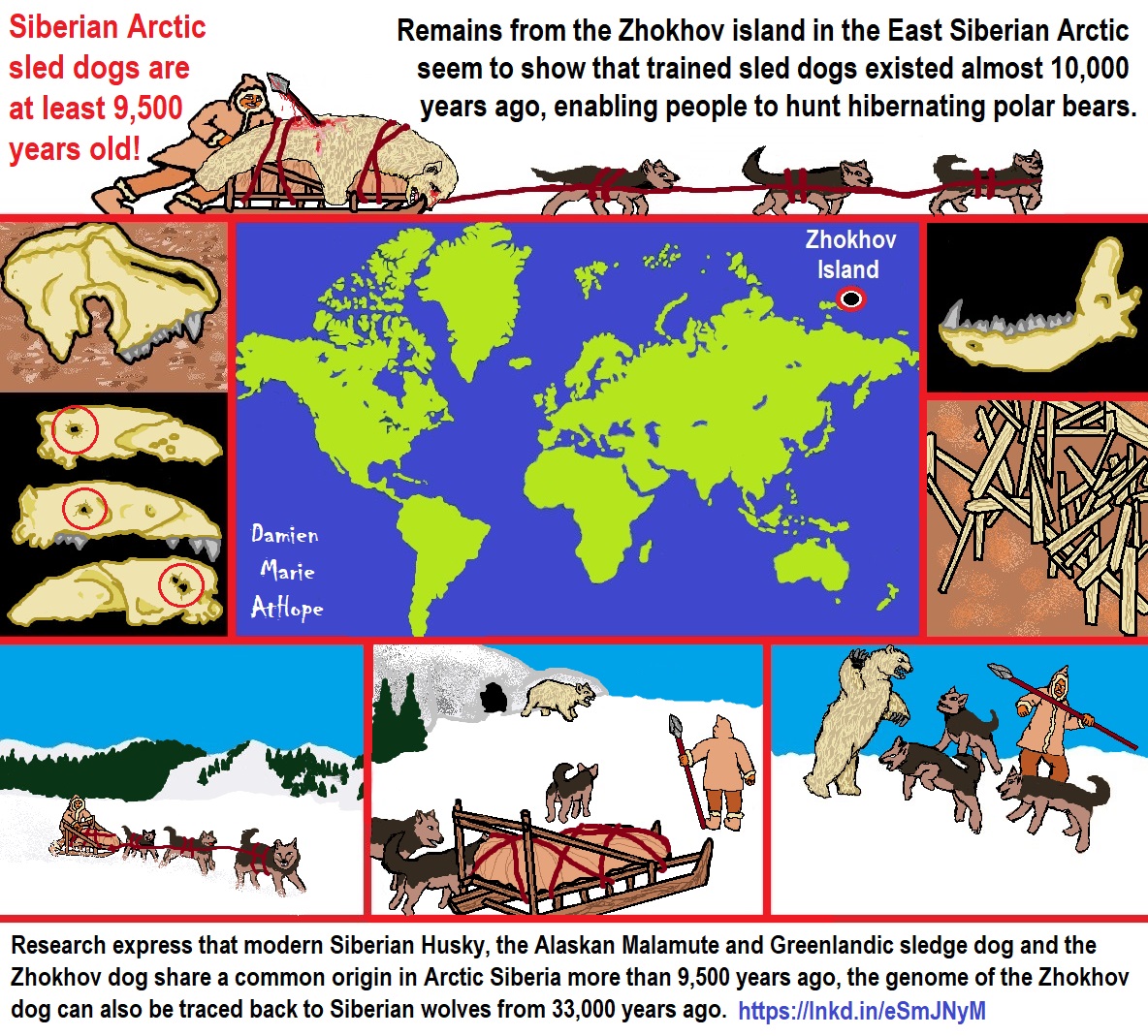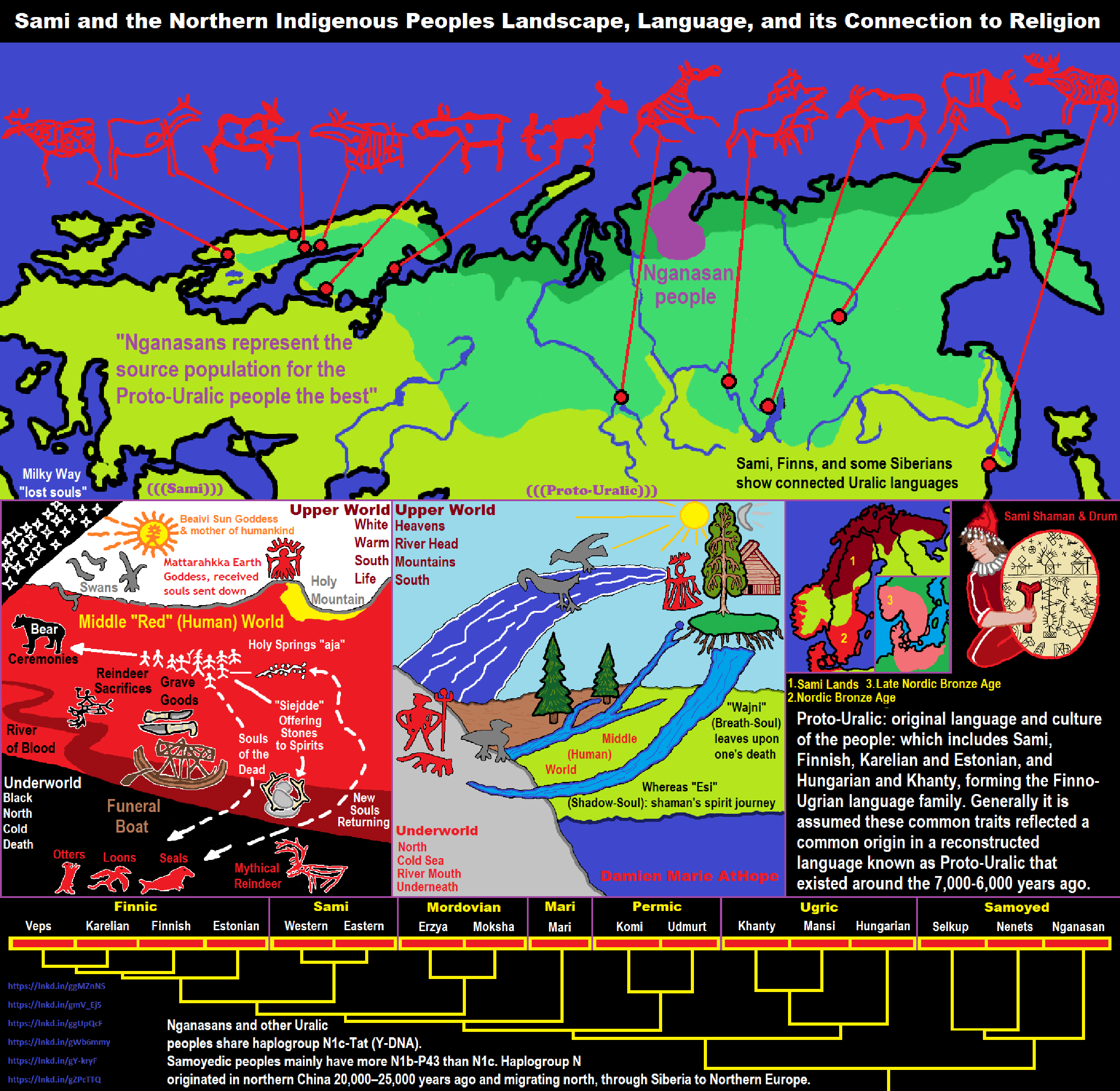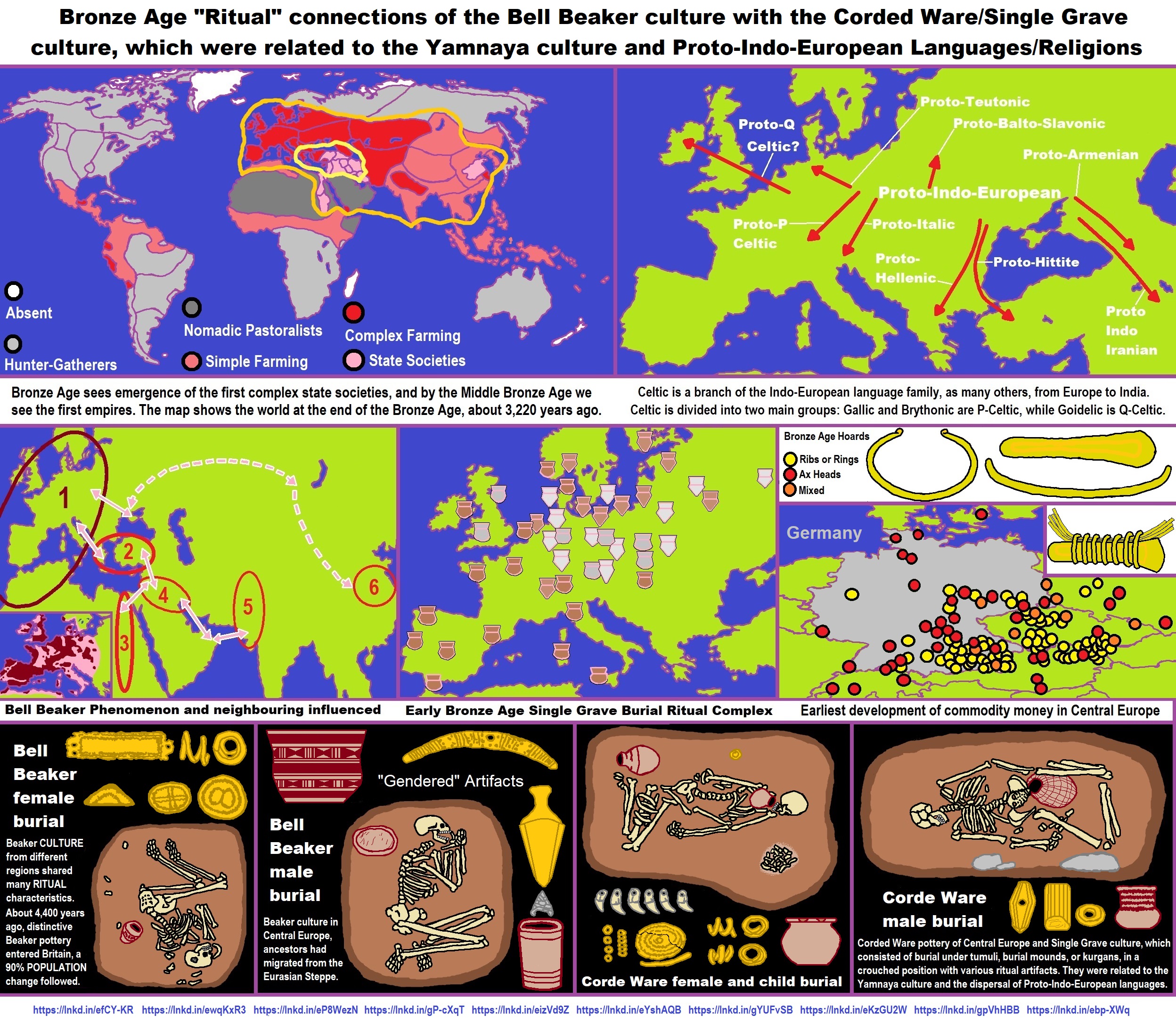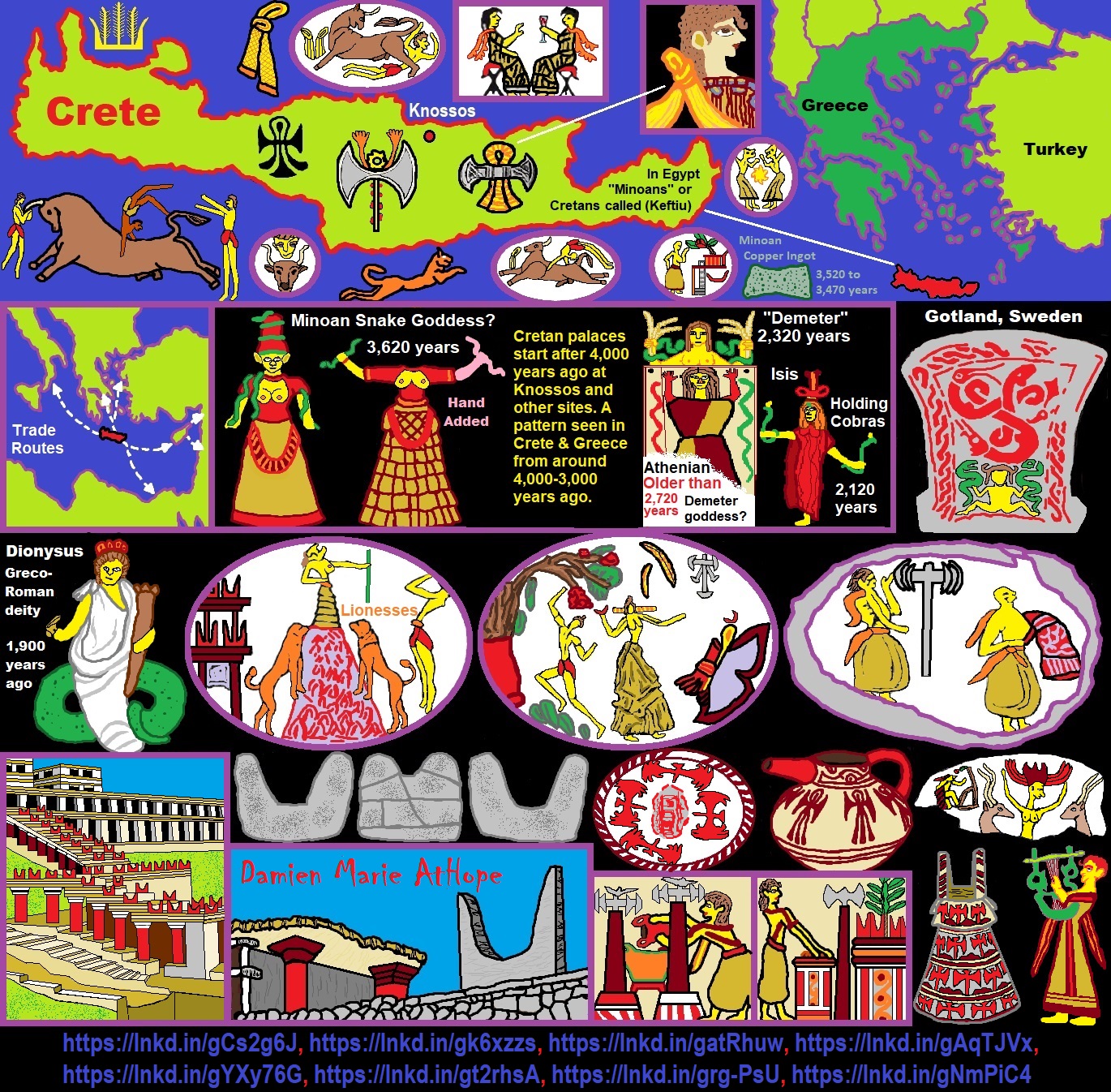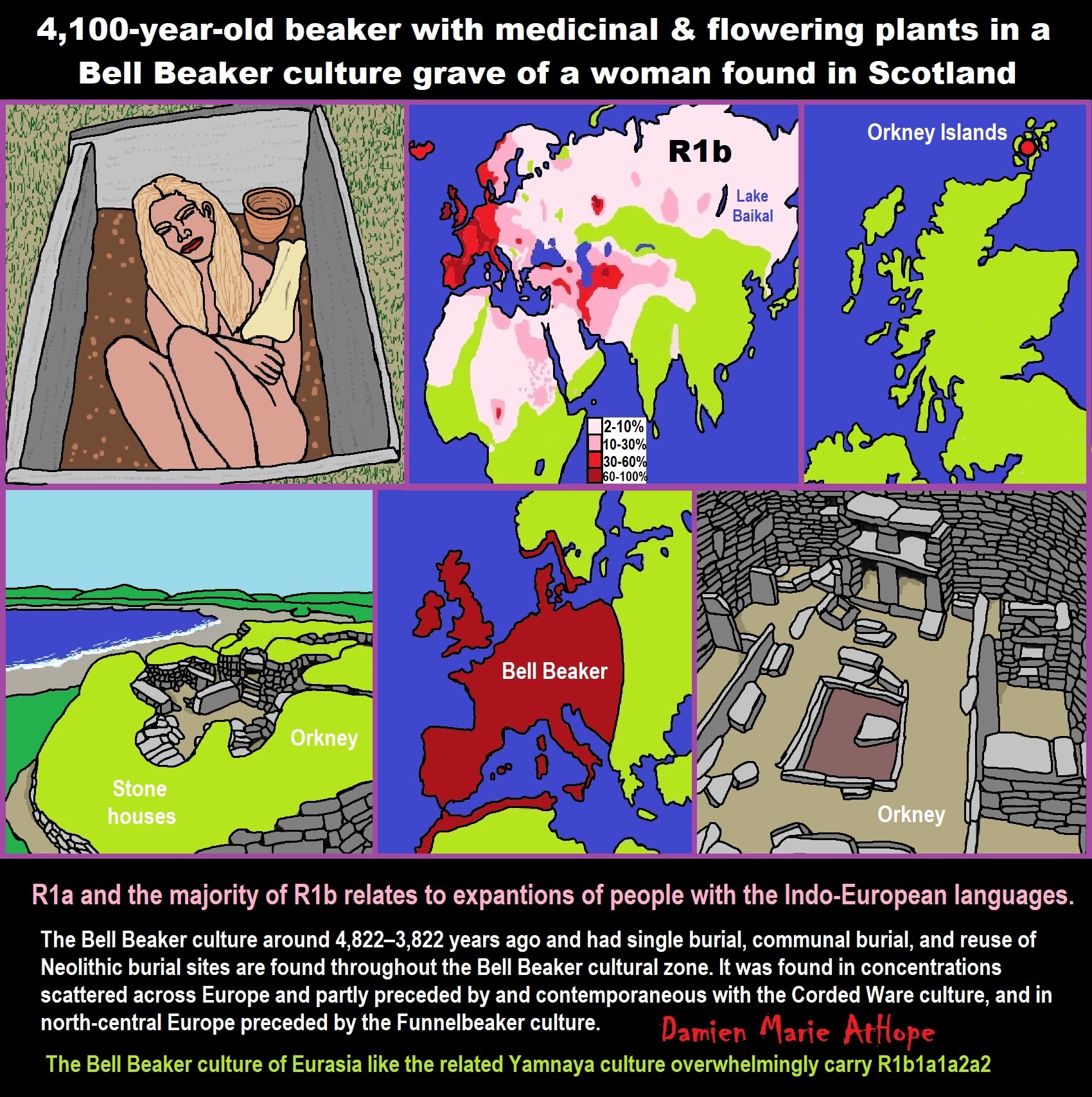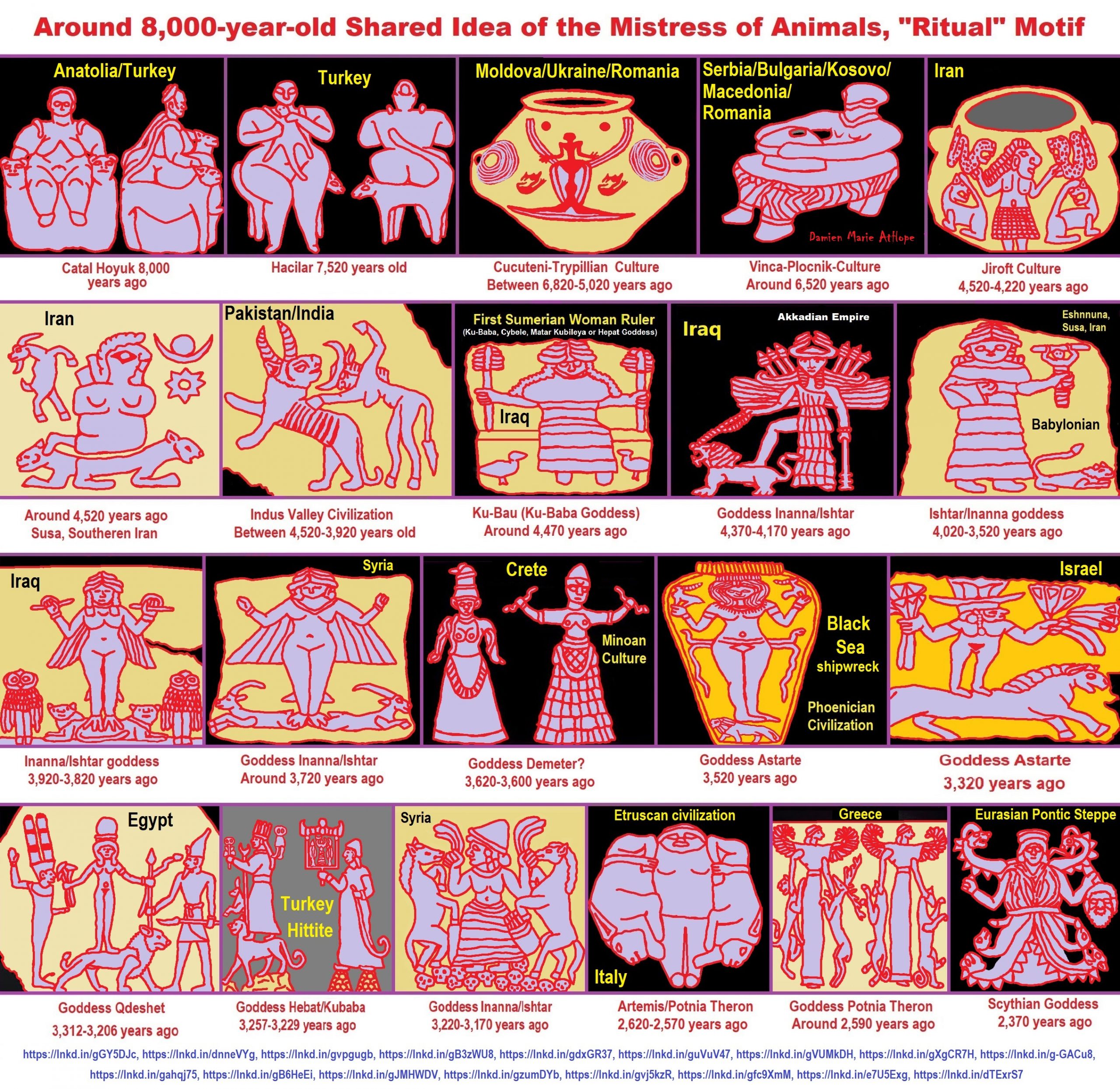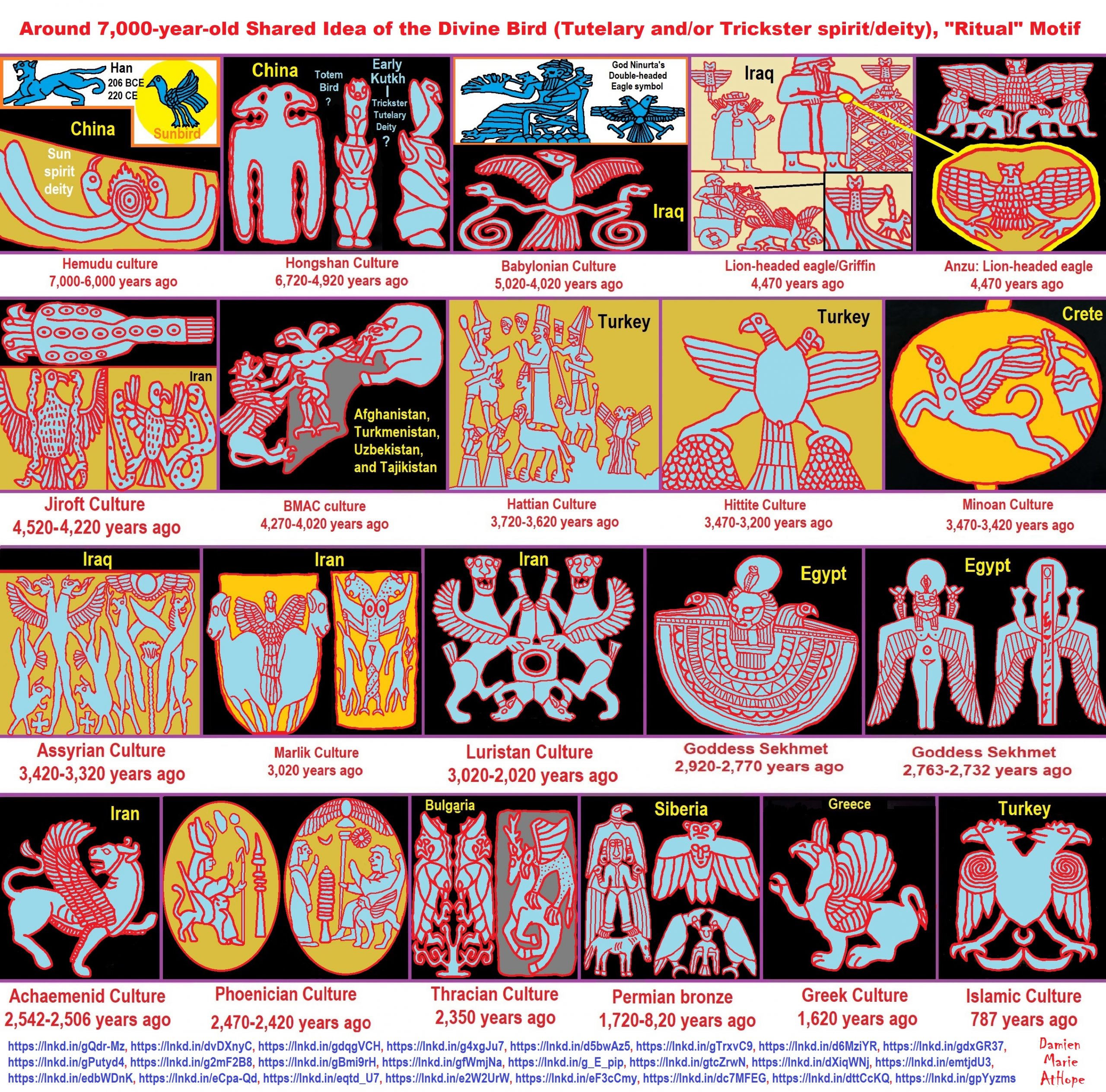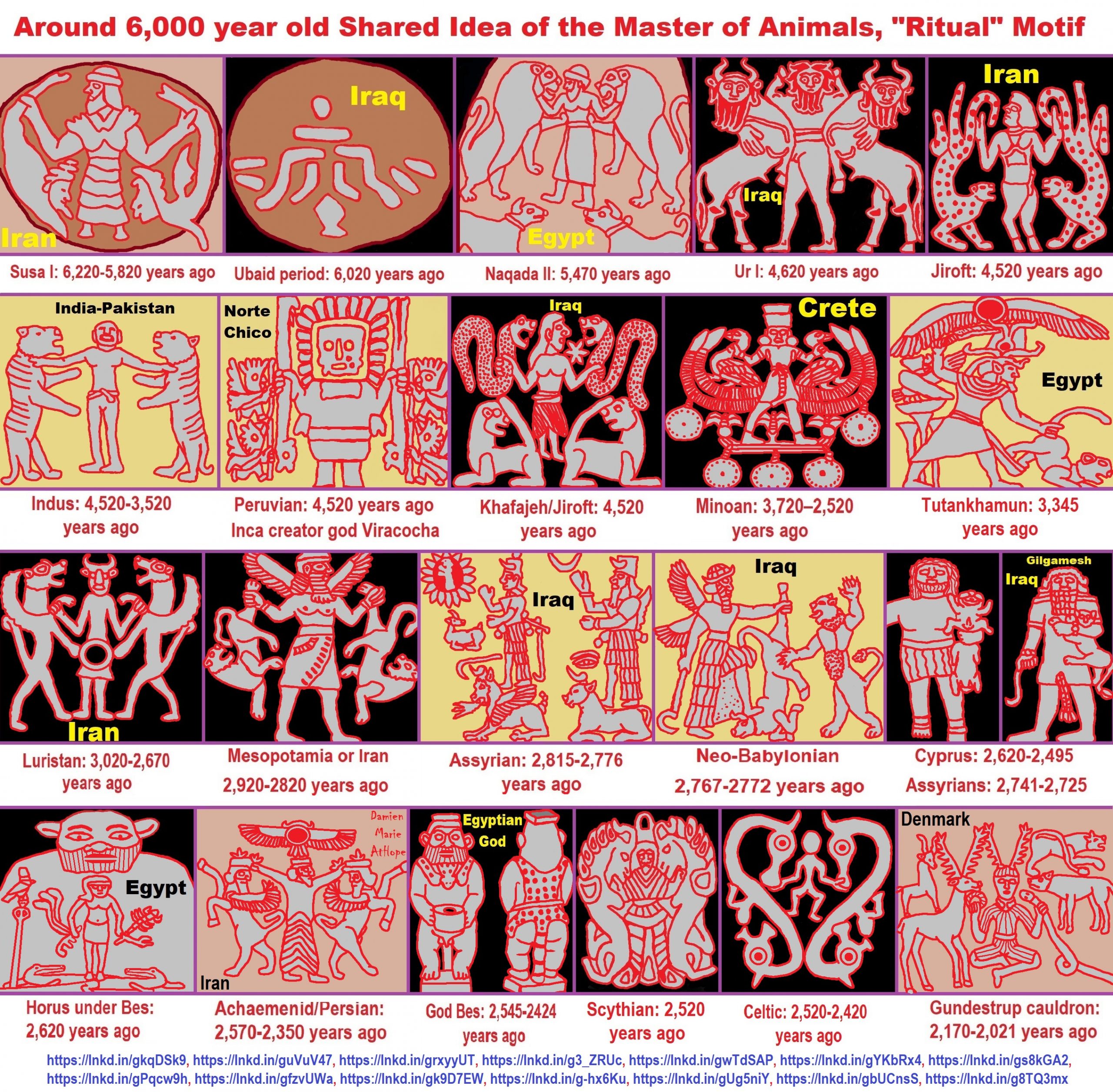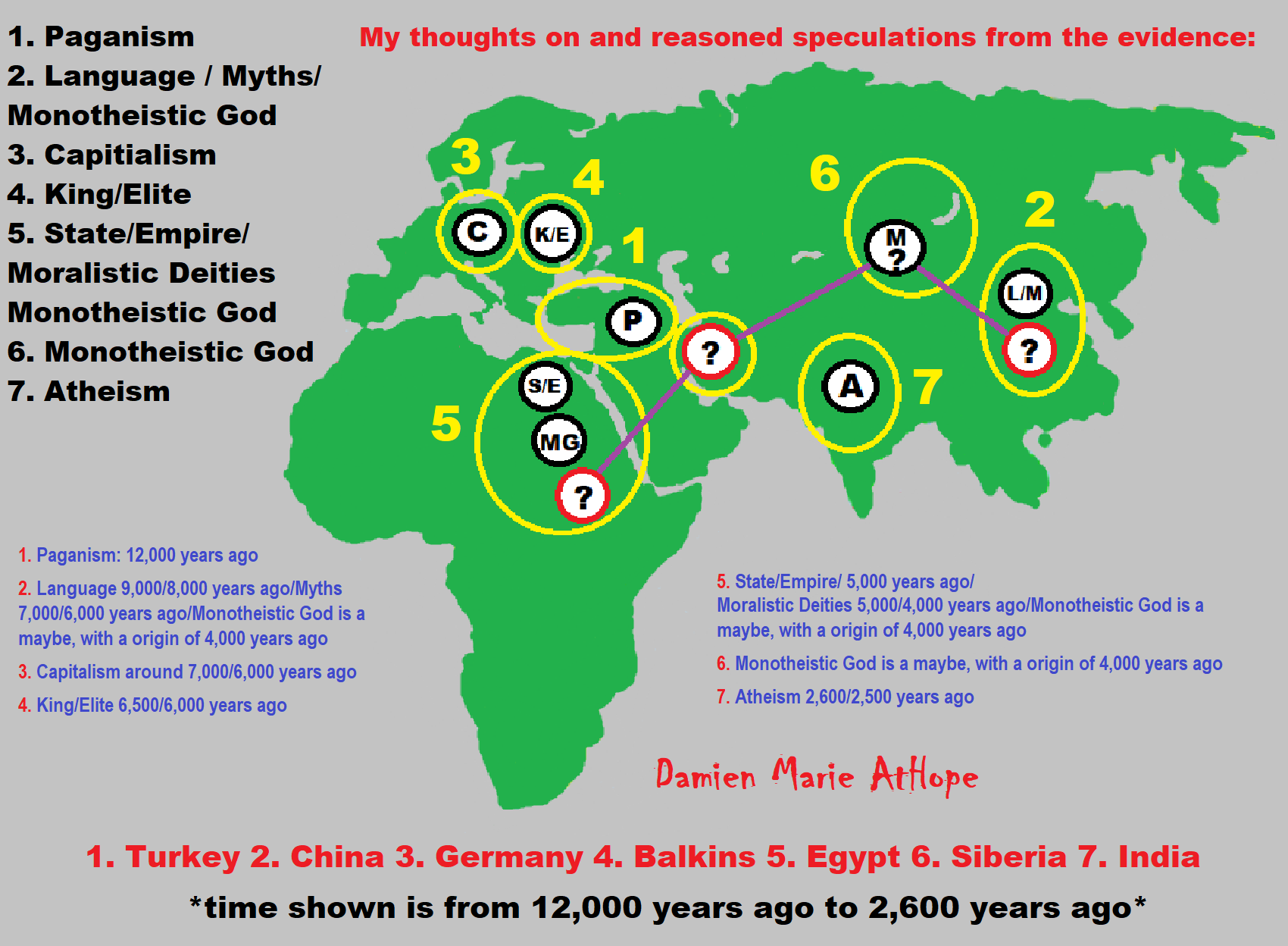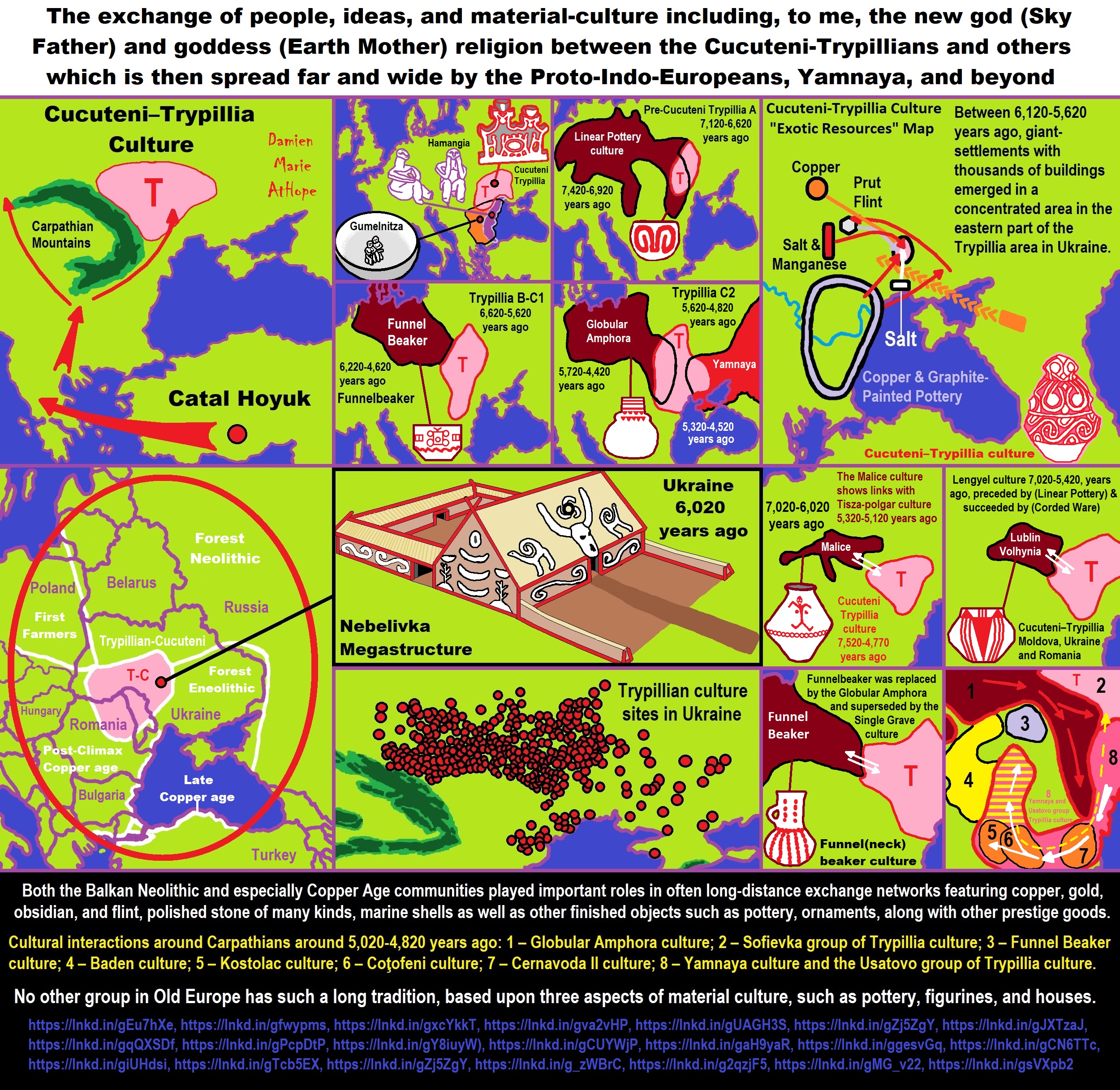
ref, ref, ref, ref, ref, ref, ref, ref, ref, ref, ref, ref, ref, ref, ref, ref, ref, ref, ref, ref
The exchange of people, ideas, and material-culture including, to me, the new god (Sky Father) and goddess (Earth Mother) religion between the Cucuteni-Trypillians and others which is then spread far and wide by the Proto-Indo-Europeans, Yamnaya, and beyond?
“These ideas are my speculations from the evidence.”
European Culture Links:

I am still researching the “god‘s origins” all over the world. So you know, it is very complicated but I am smart and willing to look, DEEP, if necessary, which going very deep does seem to be needed here, when trying to actually understand the evolution of gods and goddesses. I am sure of a few things and less sure of others, but even in stuff I am not fully grasping I still am slowly figuring it out, to explain it to others. But as I research more I am understanding things a little better, though I am still working on understanding it all or something close and thus always figuring out more.
Sky Father/Sky God?
“Egyptian: (Nut) Sky Mother and (Geb) Earth Father” (Egypt is different but similar)
Turkic/Mongolic: (Tengri/Tenger Etseg) Sky Father and (Eje/Gazar Eej) Earth Mother *Transeurasian*
Hawaiian: (Wākea) Sky Father and (Papahānaumoku) Earth Mother *Austronesian*
New Zealand/ Māori: (Ranginui) Sky Father and (Papatūānuku) Earth Mother *Austronesian*
Proto-Indo-European: (Dyḗus/Dyḗus ph₂tḗr) Sky Father and (Dʰéǵʰōm/Pleth₂wih₁) Earth Mother
Indo-Aryan: (Dyaus Pita) Sky Father and (Prithvi Mata) Earth Mother *Indo-European*
Italic: (Jupiter) Sky Father and (Juno) Sky Mother *Indo-European*
Etruscan: (Tinia) Sky Father and (Uni) Sky Mother *Tyrsenian/Italy Pre–Indo-European*
Hellenic/Greek: (Zeus) Sky Father and (Hera) Sky Mother who started as an “Earth Goddess” *Indo-European*
Nordic: (Dagr) Sky Father and (Nótt) Sky Mother *Indo-European*
Slavic: (Perun) Sky Father and (Mokosh) Earth Mother *Indo-European*
Illyrian: (Deipaturos) Sky Father and (Messapic Damatura’s “earth-mother” maybe) Earth Mother *Indo-European*
Albanian: (Zojz) Sky Father and (?) *Indo-European*
Baltic: (Perkūnas) Sky Father and (Saulė) Sky Mother *Indo-European*
Germanic: (Týr) Sky Father and (?) *Indo-European*
Colombian-Muisca: (Bochica) Sky Father and (Huythaca) Sky Mother *Chibchan*
Aztec: (Quetzalcoatl) Sky Father and (Xochiquetzal) Sky Mother *Uto-Aztecan*
Incan: (Viracocha) Sky Father and (Mama Runtucaya) Sky Mother *Quechuan*
China: (Tian/Shangdi) Sky Father and (Dì) Earth Mother *Sino-Tibetan*
Sumerian, Assyrian and Babylonian: (An/Anu) Sky Father and (Ki) Earth Mother
Finnish: (Ukko) Sky Father and (Akka) Earth Mother *Finno-Ugric*
Sami: (Horagalles) Sky Father and (Ravdna) Earth Mother *Finno-Ugric*
Puebloan-Zuni: (Ápoyan Ta’chu) Sky Father and (Áwitelin Tsíta) Earth Mother
Puebloan-Hopi: (Tawa) Sky Father and (Kokyangwuti/Spider Woman/Grandmother) Earth Mother *Uto-Aztecan*
Puebloan-Navajo: (Tsohanoai) Sky Father and (Estsanatlehi) Earth Mother *Na-Dene*
ref, ref, ref, ref, ref, ref, ref, ref, ref, ref, ref, ref, ref, ref, ref, ref, ref, ref, ref, ref, ref, ref, ref, ref, ref, ref, ref
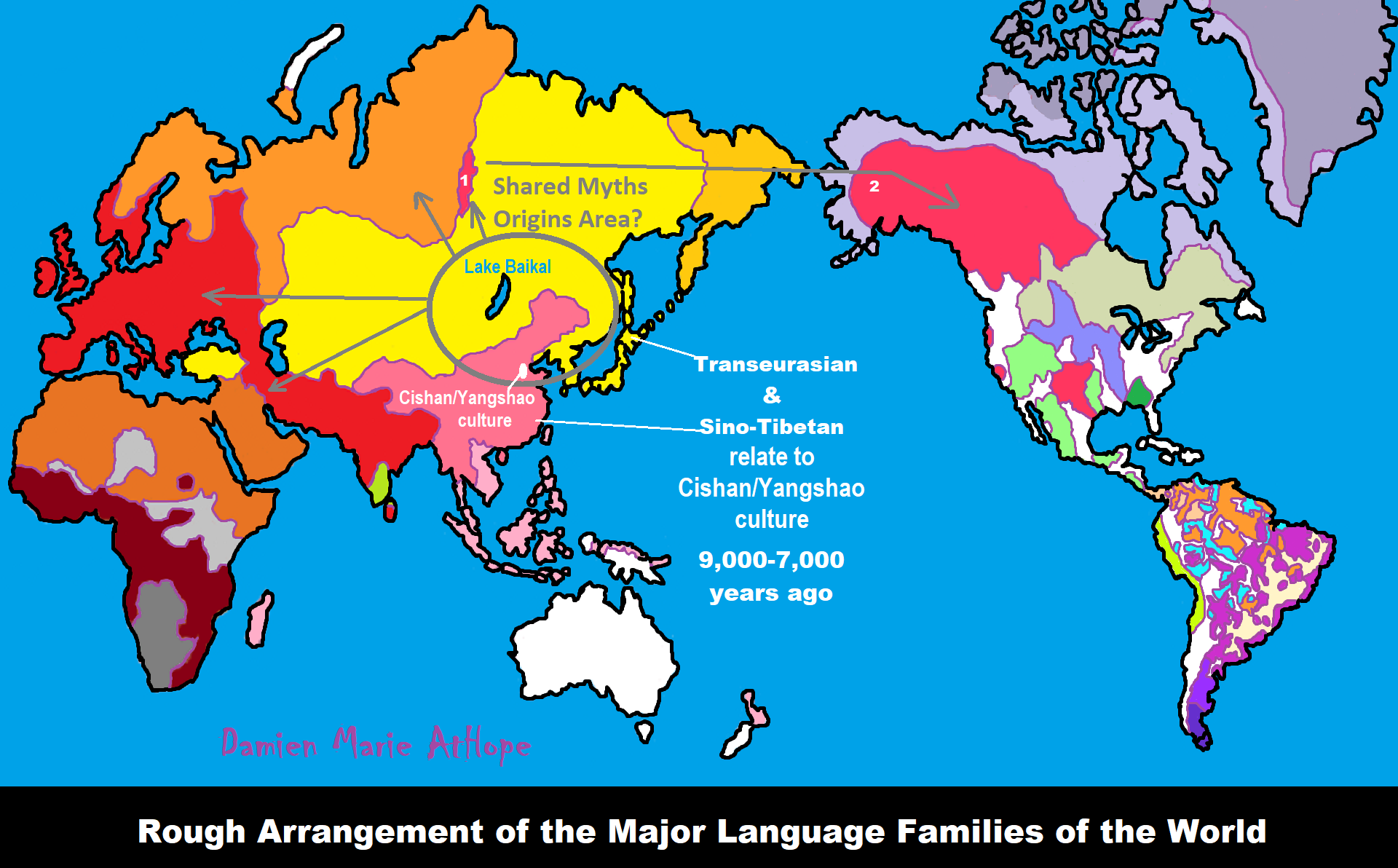
“1 central Eurasian Neolithic individual from Tajikistan (around 8,000 years ago) and approximately 8,200 years ago Yuzhniy Oleniy Ostrov group from Karelia in western Russia formed by 19 genomes affinity to Villabruna ancestry than all the other Eastern Hunter-Gatherer groups” https://www.nature.com/articles/s41586-023-05726-0
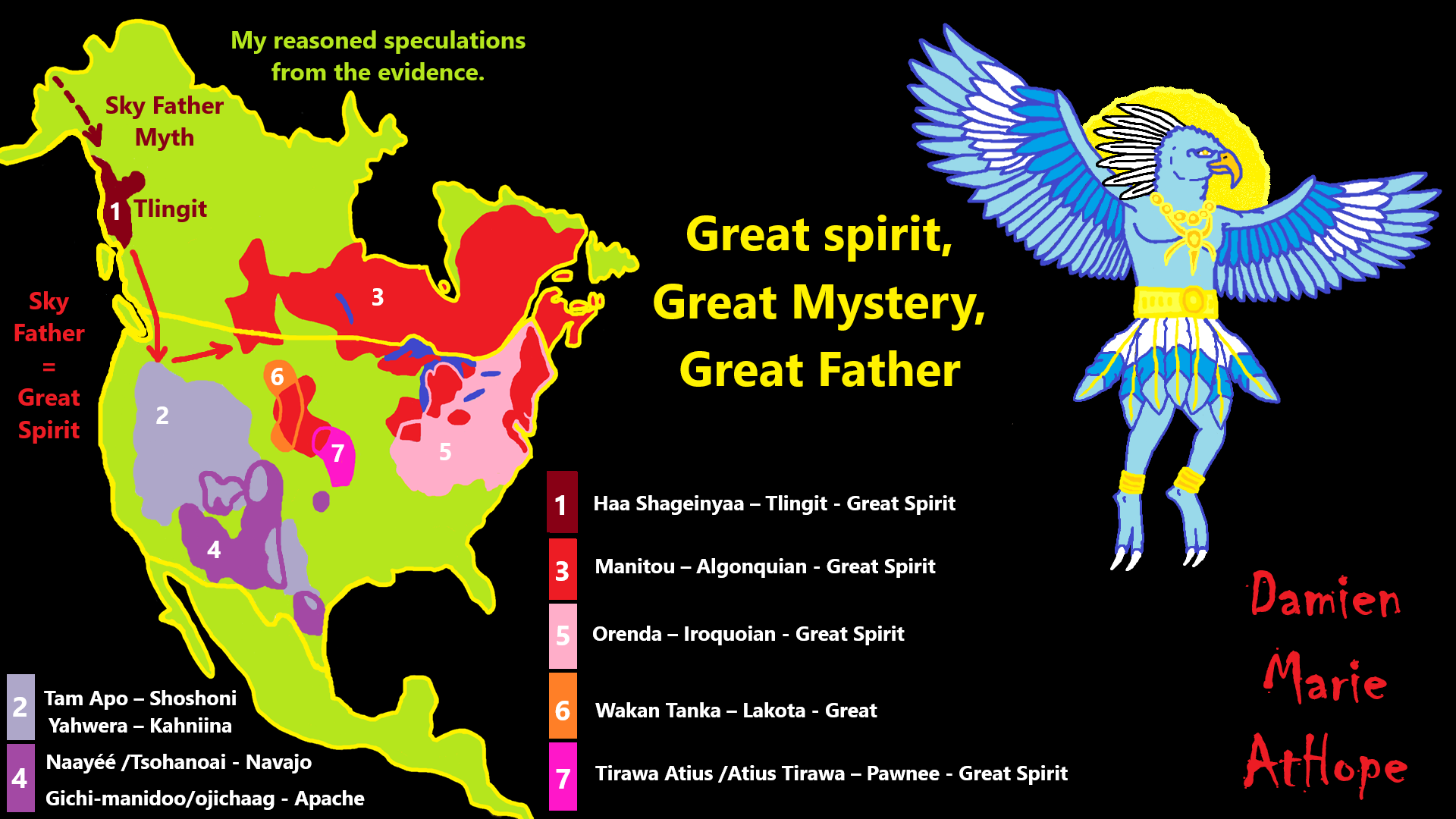
“The Great Spirt and the Evil one Native American (Navajo): the Fathers of All Fathers. The Supreme Being. The Father of the Holy People. The Great Spirit. (watches us by light like sun light or moon light) = Sky Father creator and maker to all things, corn pollen prayer are offered, sacred stone offering to, protect us by the light of the sun. The Great Spirit is a common reference among many Native American Tribes.” ref, ref
There are three types of the Great Spirit thinking (to me):
- Great Spirit (animistic type): “Great Mystery” likely no referred gender.
- Great Spirit (totemistic/shamanistic type): “Great Spirit” is likely not fully seen as a god/goddess-type spirit, it could be an animal but may have male or female gender.
- Great Spirit (paganistic type): “Great/High God” likely a male gender commonly related to the sun or blue/clear sky.
The Great Spirit
“The Great Spirit” is the English translation of the name of the creator god in many Native American traditions, particularly Algonquian and Siouan tribes. Since Algonquian tribes were the first Native American cultures encountered by English speakers, “Great Spirit” became a common term referring to Native American creator deities in general, and was also frequently used as the word for “God” in translations of Christian texts into Native American languages. Indeed, many Native American people consider the Great Spirit and the Christian God to be one and the same. Other Native American people are less receptive to this idea, believing that today’s notion of the Great Spirit was mostly constructed by missionaries. The truth is probably somewhere in the middle– many Native American tribal traditions definitely did include some form of the Great Spirit in their creation myths and religious rituals, but some tribes never had such traditions until after colonization. And in other tribes, while there had always been the belief in a Great Spirit or Great Mystery that provided order to the spiritual world, this belief system became significantly altered after contact with Christianity, and modern conceptions of the Native American Great Spirit may not be a very accurate representation of the original Native spirituality.” ref
“Makunaima: High God, Creator, “God” or “Great Spirit” but not personified. Tribal affiliation: Akawaio, Pemon, Macusi, Carib. Related figures in other tribes: Kururumany (Arawak). The Sun, the Frog, and the Fire-Sticks: A Guyanese Carib legend about Makunaima and his twin brother Pia.” ref
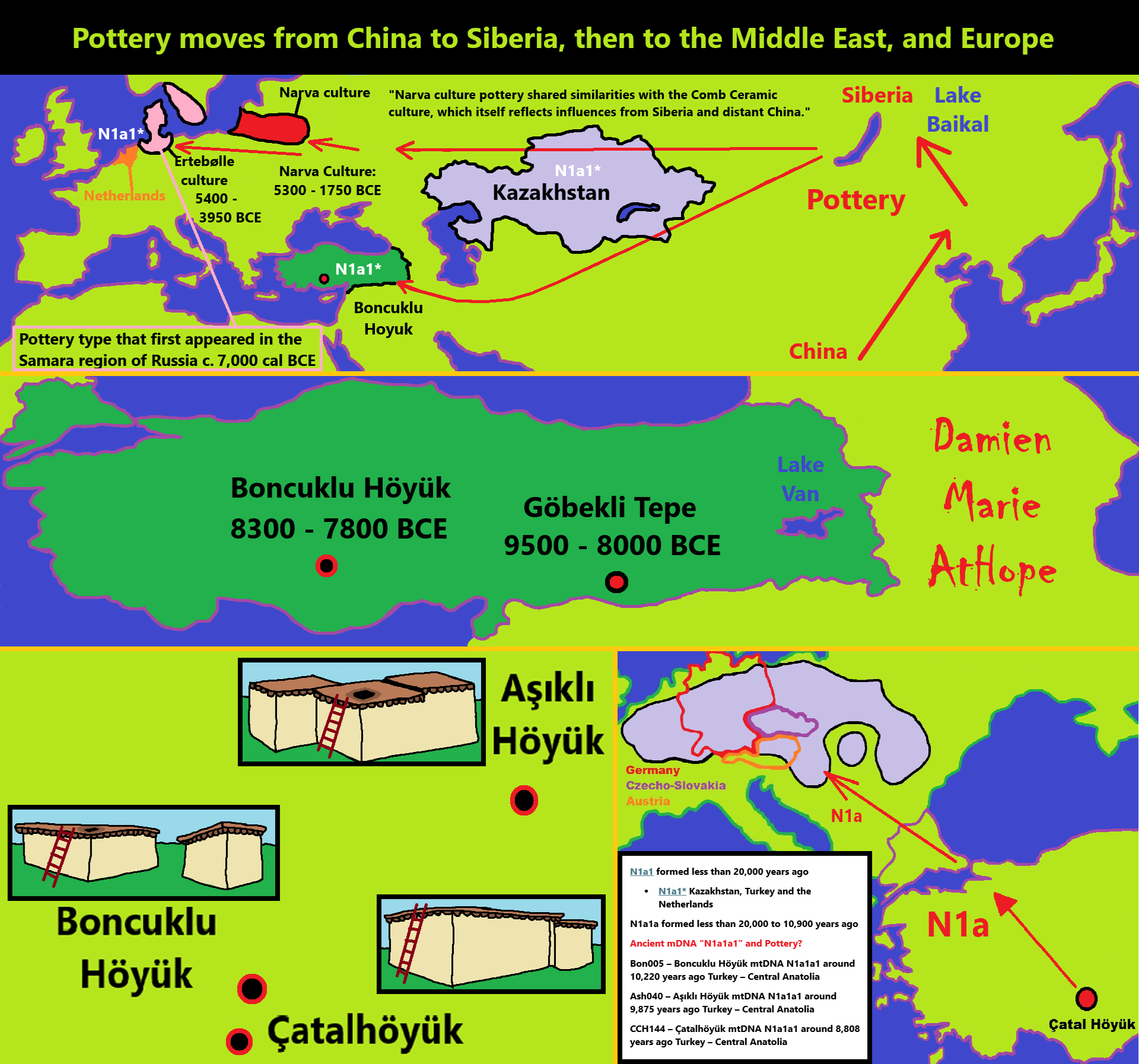
Pottery from at 10,000 at Boncuklu Höyük, to Aşıklı Höyük, to Çatalhöyük, then Europe by around 7,500 years ago.
Pottery moves from China to Siberia, then to the Middle East, and Europe

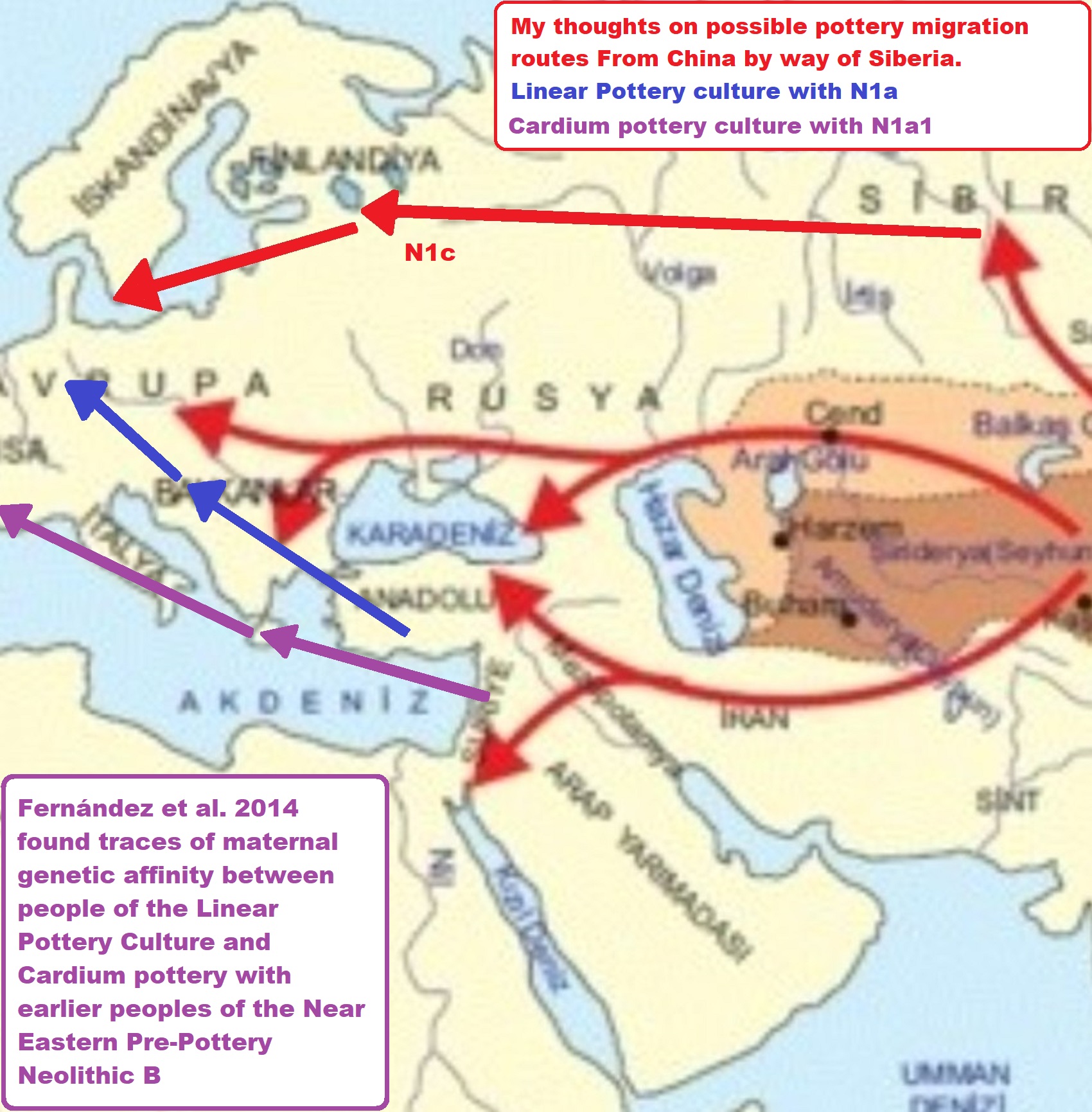

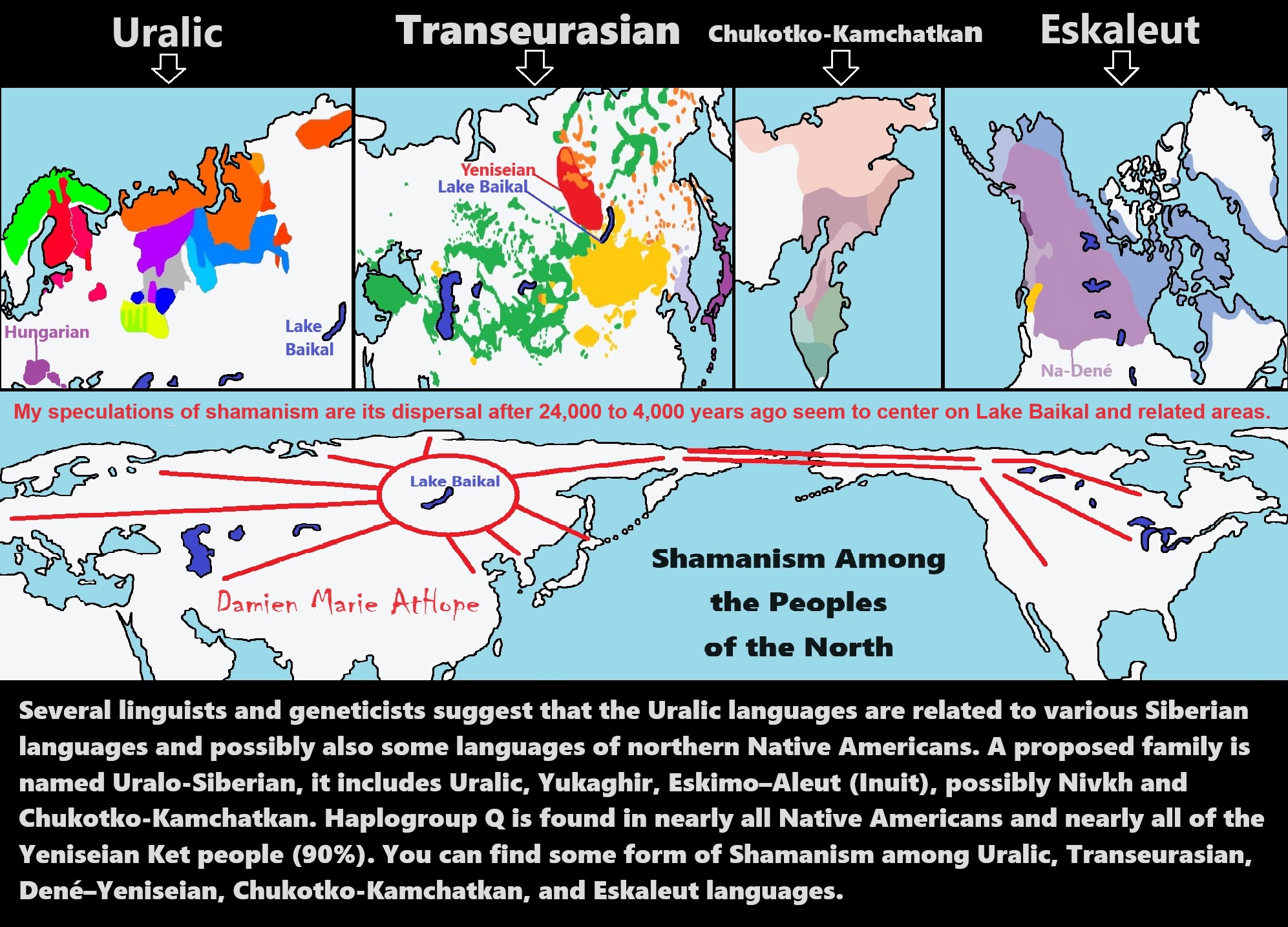
ref, ref, ref, ref, ref, ref, ref, ref, ref
“Several linguists and geneticists suggest that the Uralic languages are related to various Siberian languages and possibly also some languages of northern Native Americans. A proposed family is named Uralo-Siberian, it includes Uralic, Yukaghir, Eskimo–Aleut (Inuit), possibly Nivkh, and Chukotko-Kamchatkan. Haplogroup Q is found in nearly all Native Americans and nearly all of the Yeniseian Ket people (90%).” ref, ref
You can find some form of Shamanism, among Uralic, Transeurasian, Dené–Yeniseian, Chukotko-Kamchatkan, and Eskaleut languages.
My speculations of shamanism are its dispersals, after 24,000 to 4,000 years ago, seem to center on Lake Baikal and related areas. To me, the hotspot of Shamanism goes from west of Lake Baikal in the “Altai Mountains” also encompassing “Lake Baikal” and includes the “Amur Region/Watershed” east of Lake Baikal as the main location Shamanism seems to have radiated out from.
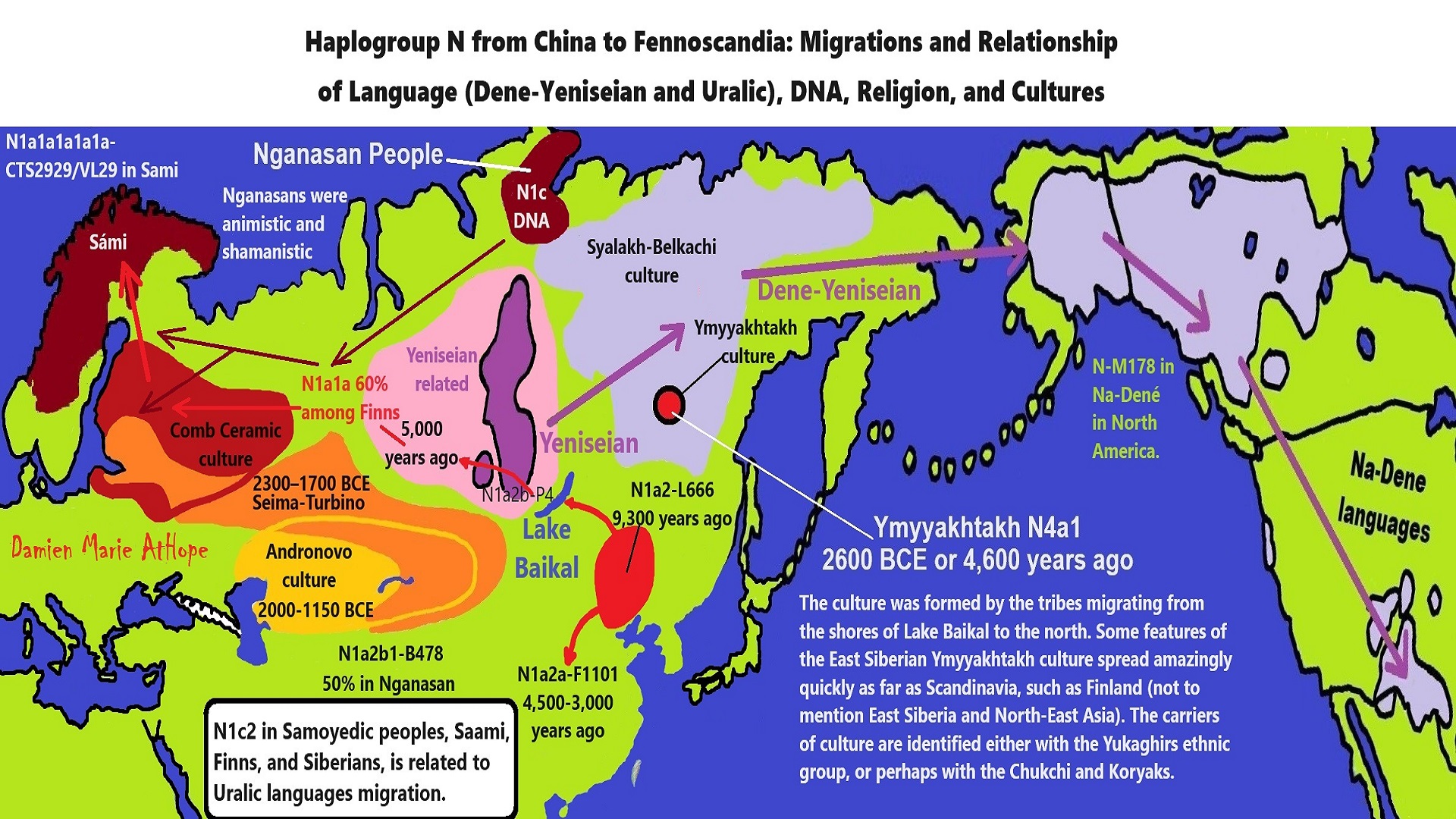
Postglacial genomes from foragers across Northern Eurasia reveal prehistoric
mobility associated with the spread of the Uralic and Yeniseian languages
Abstract
“The North Eurasian forest and forest-steppe zones have sustained millennia of sociocultural connections among northern peoples. We present genome-wide ancient DNA data for 181 individuals from this region spanning the Mesolithic, Neolithic, and Bronze Age. We find that Early to Mid-Holocene hunter-gatherer populations from across the southern forest and forest-steppes of Northern Eurasia can be characterized by a continuous gradient of ancestry that remained stable for millennia, ranging from fully West Eurasian in the Baltic region to fully East Asian in the Transbaikal region. In contrast, cotemporaneous groups in far Northeast Siberia were genetically distinct, retaining high levels of continuity from a population that was the primary source of ancestry for Native Americans. By the mid-Holocene, admixture between this early Northeastern Siberian population and groups from Inland East Asia and the Amur River Basin produced two distinctive populations in eastern Siberia that played an important role in the genetic formation of later people. Ancestry from the first population, Cis-Baikal Late Neolithic-Bronze Age (Cisbaikal_LNBA), is found substantially only among Yeniseian-speaking groups and those known to have admixed with them. Ancestry from the second, Yakutian Late Neolithic-Bronze Age (Yakutia_LNBA), is strongly associated with present-day Uralic speakers. We show how Yakutia_LNBA ancestry spread from an east Siberian origin ~4.5kya, along with subclades of Y-chromosome haplogroup N occurring at high frequencies among present-day Uralic speakers, into Western and Central Siberia in communities associated with Seima-Turbino metallurgy: a suite of advanced bronze casting techniques that spread explosively across an enormous region of Northern Eurasia ~4.0kya. However, the ancestry of the 16 Seima-Turbino-period individuals–the first reported from sites with this metallurgy–was otherwise extraordinarily diverse, with partial descent from Indo-Iranian-speaking pastoralists and multiple hunter-gatherer populations from widely separated regions of Eurasia. Our results provide support for theories suggesting that early Uralic speakers at the beginning of their westward dispersal where involved in the expansion of Seima-Turbino metallurgical traditions, and suggests that both cultural transmission and migration were important in the spread of Seima-Turbino material culture.” ref
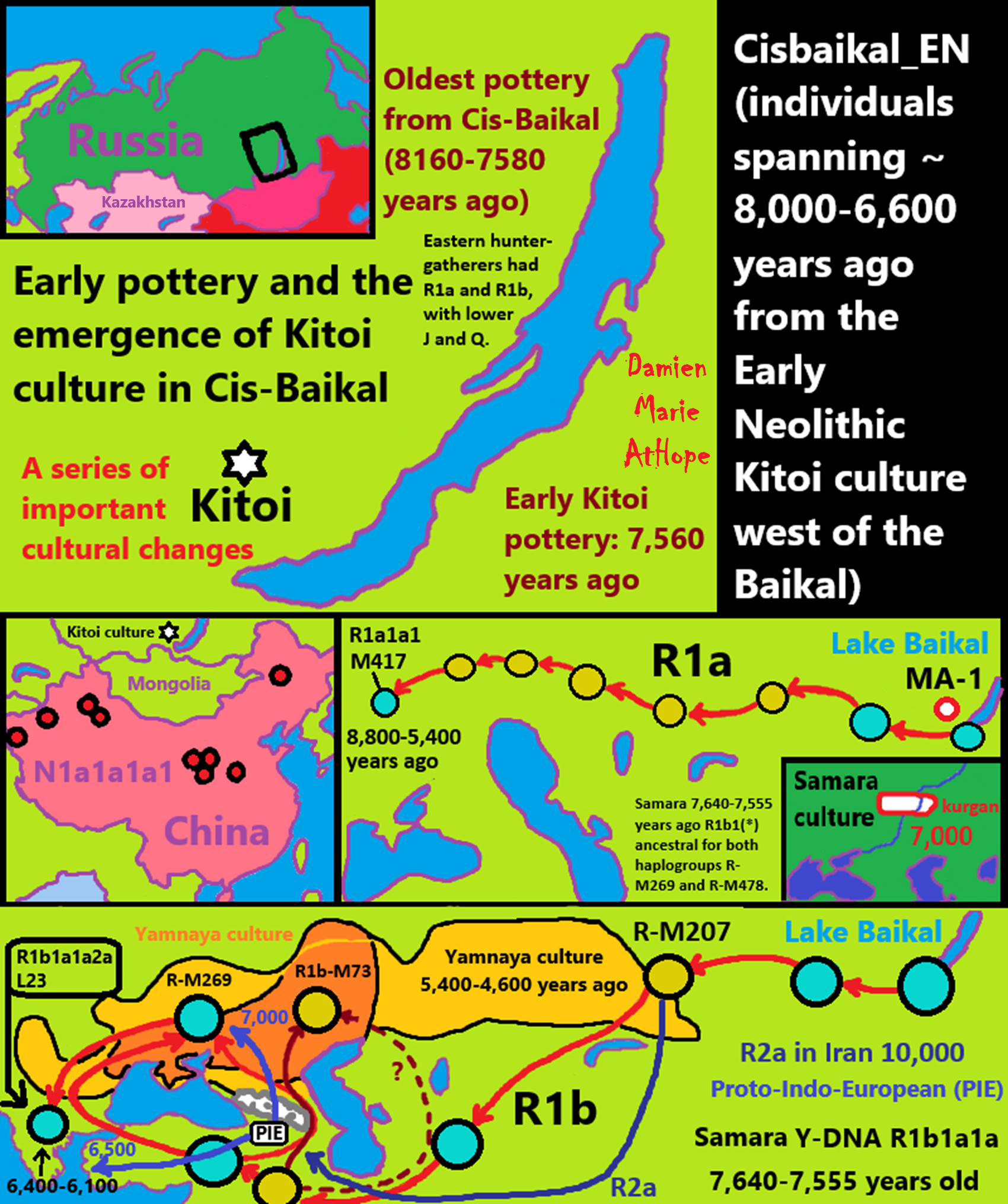
ref, ref, ref, ref, ref, ref, ref, ref, ref, ref, ref, ref, ref, ref, ref, ref, ref, ref, ref
Early Russian Pottery in Cisbaikal Kitoi culture 7,500 years ago, Samara culture 7,000 years ago, and Yamnaya culture 5,600–4,600 years ago, as well as Proto-Indo-European emergence
“The area east of Lake Baikal in Siberia is one of the few regions in Eurasia where pottery was already used during the Late Pleistocene and Early Holocene. Such early pottery complexes were identified in Ust’-Karenga XII, Studenoye 1, Ust’-Menza 1, and Ust’-Khyakhta 3, dated at about 12-000-11,000 years ago. While around 20,000 years ago East Asian hunter-gatherers were already making ceramic pots. (It seems to Damien) that ceramics spread continually from the earliest centers in China, then Japan, and next the Russian Far East, lastly towards the west, all the way to Europe.” ref
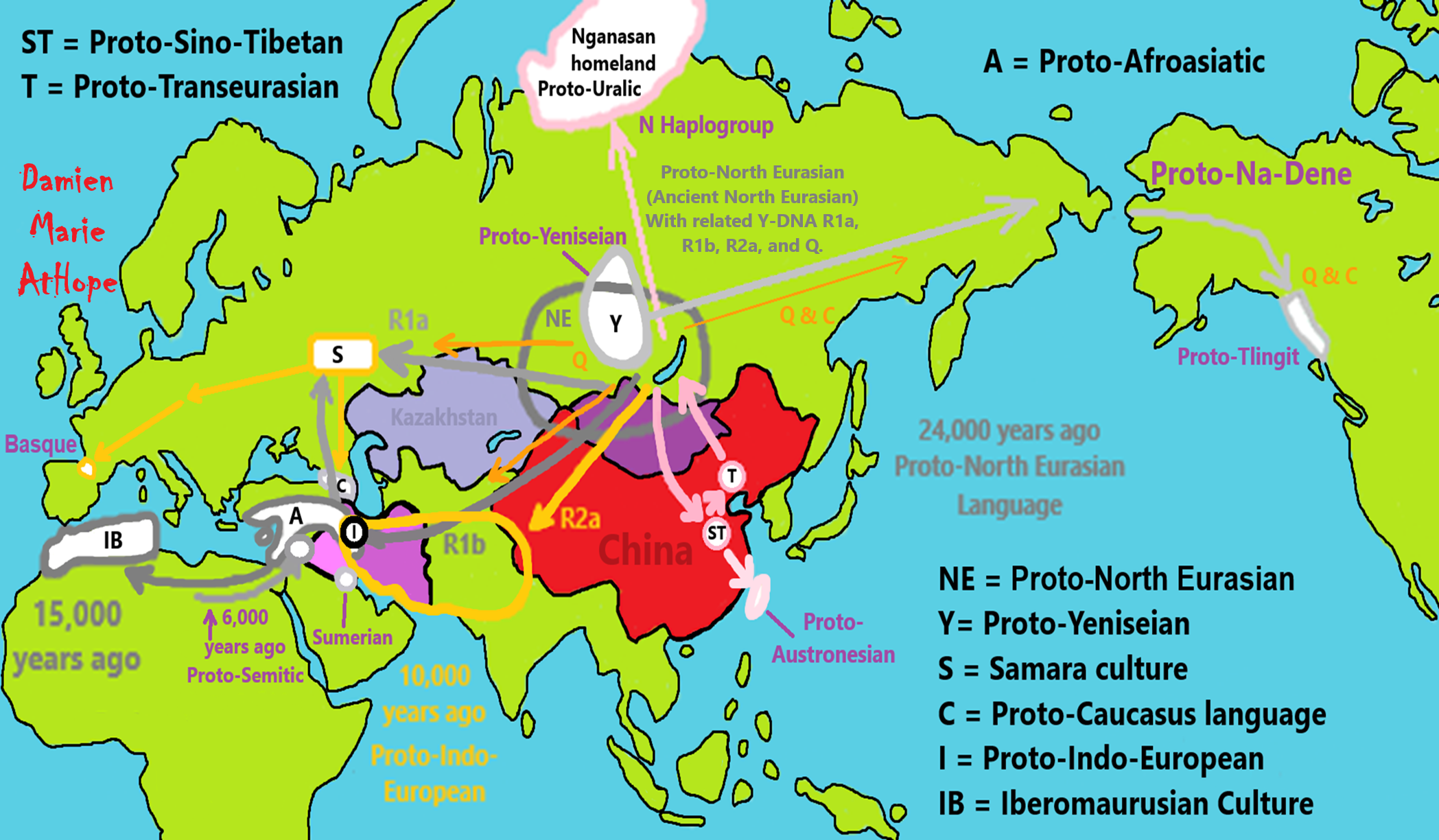
ref, ref, ref, ref, ref, ref, ref, ref, ref, ref, ref, ref, ref, ref, ref, ref, ref, ref, ref, ref, ref, ref, ref, ref, ref, ref, ref, ref, ref, ref, ref
This art above explains my thinking from my life of investigation
I am an anarchist (Social anarchism, Left-wing anarchism, or Socialist anarchism) trying to explain prehistory as I see it after studying it on my own starting 2006. Anarchists are for truth and believe in teaching the plain truth; misinformation is against this, and we would and should fight misinformation and disinformation.
I see anarchism as a social justice issue not limited to some political issue or monetary persuasion. People own themselves, have self/human rights, and deserve freedoms. All humanity is owed respect for its dignity; we are all born equal in dignity and human rights, and no plot of dirt we currently reside on changes this.
I fully enjoy the value (axiology) of archaeology (empirical evidence from fact or artifacts at a site) is knowledge (epistemology) of the past, adding to our anthropology (evidence from cultures both the present and past) intellectual (rational) assumptions of the likely reality of actual events from time past.
I am an Axiological Atheist, Philosopher & Autodidact Pre-Historical Writer/Researcher, Anti-theist, Anti-religionist, Anarcho Humanist, LGBTQI, Race, & Class equality. I am not an academic, I am a revolutionary sharing education and reason to inspire more deep thinking. I do value and appreciate Academics, Archaeologists, Anthropologists, and Historians as they provide us with great knowledge, informing us about our shared humanity.
I am a servant leader, as I serve the people, not myself, not my ego, and not some desire for money, but rather a caring teacher’s heart to help all I can with all I am. From such thoughtfulness may we all see the need for humanism and secularism, respecting all as helpful servant leaders assisting others as often as we can to navigate truth and the beauty of reality.
‘Reality’ ie. real/external world things, facts/evidence such as that confirmed by science, or events taken as a whole documented understanding of what occurred/is likely to have occurred; the accurate state of affairs. “Reason” is not from a mind devoid of “unreason” but rather demonstrates the potential ability to overcome bad thinking. An honest mind, enjoys just correction. Nothing is a justified true belief without valid or reliable reason and evidence; just as everything believed must be open to question, leaving nothing above challenge.
I don’t believe in gods or ghosts, and nor souls either. I don’t believe in heavens or hells, nor any supernatural anything. I don’t believe in Aliens, Bigfoot, nor Atlantis. I strive to follow reason and be a rationalist. Reason is my only master and may we all master reason. Thinking can be random, but reason is organized and sound in its Thinking. Right thinking is reason, right reason is logic, and right logic can be used in math and other scientific methods. I don’t see religious terms Animism, Totemism, Shamanism, or Paganism as primitive but original or core elements that are different parts of world views and their supernatural/non-natural beliefs or thinking.
I am inspired by philosophy, enlightened by archaeology, and grounded by science that religion claims, on the whole, along with their magical gods, are but dogmatic propaganda, myths, and lies. To me, religions can be summed up as conspiracy theories about reality, a reality mind you is only natural and devoid of magic anything. And to me, when people talk as if Atlantis is anything real, I stop taking them seriously. Like asking about the reality of Superman or Batman just because they seem to involve metropolitan cities in their stores. Or if Mother Goose actually lived in a shoe? You got to be kidding.
We are made great in our many acts of kindness, because we rise by helping each other.
NE = Proto-North Eurasian/Ancient North Eurasian/Mal’ta–Buret’ culture/Mal’ta Boy “MA-1” 24,000 years old burial
A = Proto-Afroasiatic/Afroasiatic
S = Samara culture
ST = Proto-Sino-Tibetan/Sino-Tibetan
T = Proto-Transeurasian/Altaic
C = Proto-Northwest Caucasus language/Northwest Caucasian/Languages of the Caucasus
I = Proto-Indo-European/Indo-European
IB = Iberomaurusian Culture/Capsian culture
Natufian culture (15,000–11,500 years ago, Syria, Lebanon, Jordan, the Sinai Peninsula, and the Negev desert)
Nganasan people/Nganasan language
Na-Dene languages/Dené–Yeniseian, Dené–Caucasian
Proto-Semitic/Semitic languages
24,000 years ago, Proto-North Eurasian Language (Ancient North Eurasian) migrations?
My thoughts:
Proto-North Eurasian Language (Ancient North Eurasian) With related Y-DNA R1a, R1b, R2a, and Q Haplogroups.
R1b 22,0000-15,000 years ago in the Middle east creates Proto-Afroasiatic languages moving into Africa around 15,000-10,000 years ago connecting with the Iberomaurusian Culture/Taforalt near the coasts of Morocco, Algeria, and Tunisia.
R2a 10,000 years ago in Iran brings/creates Proto-Indo-European language and also a possibility is R1a in Russia around 9,000 years ago may have had a version of Proto-Indo-European language.
Around 14,000-10,000 years ago??? Proto-North Eurasian Language goes to the Yellow River basin (eventually relating with the Yangshao culture) in China creates Proto-Sino-Tibetan language.
Proto-Sino-Tibetan language then moves to the West Liao River valley (eventually relating with the Hongshan culture) in China creating Proto-Transeurasian (Altaic) language around 9,000 years ago.
N Haplogroups 9,000 years ago with Proto-Transeurasian language possibly moves north to Lake Baikal. Then after living with Proto-North Eurasian Language 24,000-9,000 years ago?/Pre-Proto-Yeniseian language 9,000-7,000 years ago Q Haplogroups (eventually relating with the Ket language and the Ket people) until around 5,500 years ago, then N Haplogroups move north to the Taymyr Peninsula in North Siberia (Nganasan homeland) brings/creates the Proto-Uralic language.
Q Haplogroups with Proto-Yeniseian language /Proto-Na-Dene language likely emerge 8,000/7,000 years ago or so and migrates to the Middle East (either following R2a to Iraq or R1a to Russia (Samara culture) then south to Iraq creates the Sumerian language. It may have also created the Proto-Caucasian languages along the way. And Q Haplogroups with Proto-Yeniseian language to a migration to North America that relates to Na-Dené (and maybe including Haida) languages, of which the first branch was Proto-Tlingit language 5,000 years ago, in the Pacific Northwest.
Sino-Tibetan language then moves more east in China to the Hemudu culture pre-Austronesian culture, next moved to Taiwan creating the Proto-Austronesian language around 6,000-5,500 years ago.
R1b comes to Russia from the Middle East around 7,500 years ago, bringing a version of Proto-Indo-European languages to the (Samara culture), then Q Y-DNA with Proto-Yeniseian language moves south from the (Samara culture) and may have been the language that created the Proto-Caucasian language. And R1b from the (Samara culture) becomes the 4,200 years or so R1b associated with the Basques and Basque language it was taken with R1b, but language similarities with the Proto-Caucasian language implies language ties to Proto-Yeniseian language.
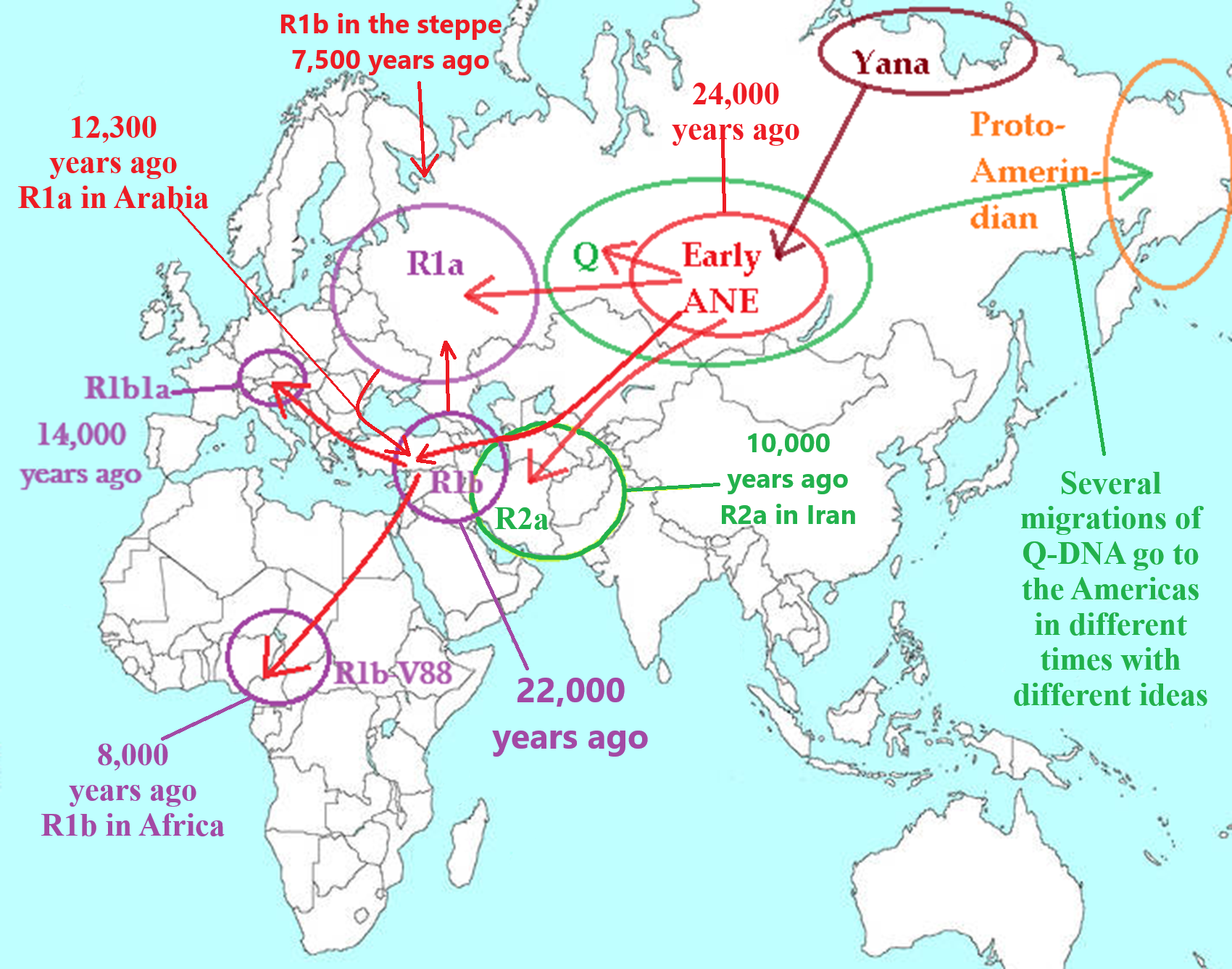
Haplogroup migrations related to the Ancient North Eurasians: I added stuff to this map to help explain.
People reached Lake Baikal Siberia around 25,000 years ago. They (to Damien) were likely Animistic Shamanists who were also heavily totemistic as well. Being animistic thinkers they likely viewed amazing things in nature as a part of or related to something supernatural/spiritual (not just natural as explained by science): spirit-filled, a sprit-being relates to or with it, it is a sprit-being, it is a supernatural/spiritual creature, or it is a great spirit/tutelary deity/goddess-god. From there comes mythology and faith in things not seen but are believed to somehow relate or interact with this “real world” we know exists.
Both areas of Lake Baikal, one on the west side with Ancient North Eurasian culture and one on the east side with Ancient Northern East Asian culture (later to become: Ancient Northeast Asian culture) areas are the connected areas that (to Damien) are the origin ancestry religion area for many mythologies and religious ideas of the world by means of a few main migrations and many smaller ones leading to a distribution of religious ideas that even though are vast in distance are commonly related to and centering on Lake Baikal and its surrounding areas like the Amur region and Altai Mountains region.
To an Animistic Thinker: “Things are not just as they seem, they may have a spirit, or spirit energy relates to them”
To a Totemistic Thinker: “Things are not just as they seem, they may have a spirit, or spirit energy relates to them; they may have religio-cultural importance.”
“Ancient North Eurasian population had Haplogroups R, P, U, and Q DNA types: defined by maternal West-Eurasian ancestry components (such as mtDNA haplogroup U) and paternal East-Eurasian ancestry components (such as yDNA haplogroup P1 (R*/Q*).” ref
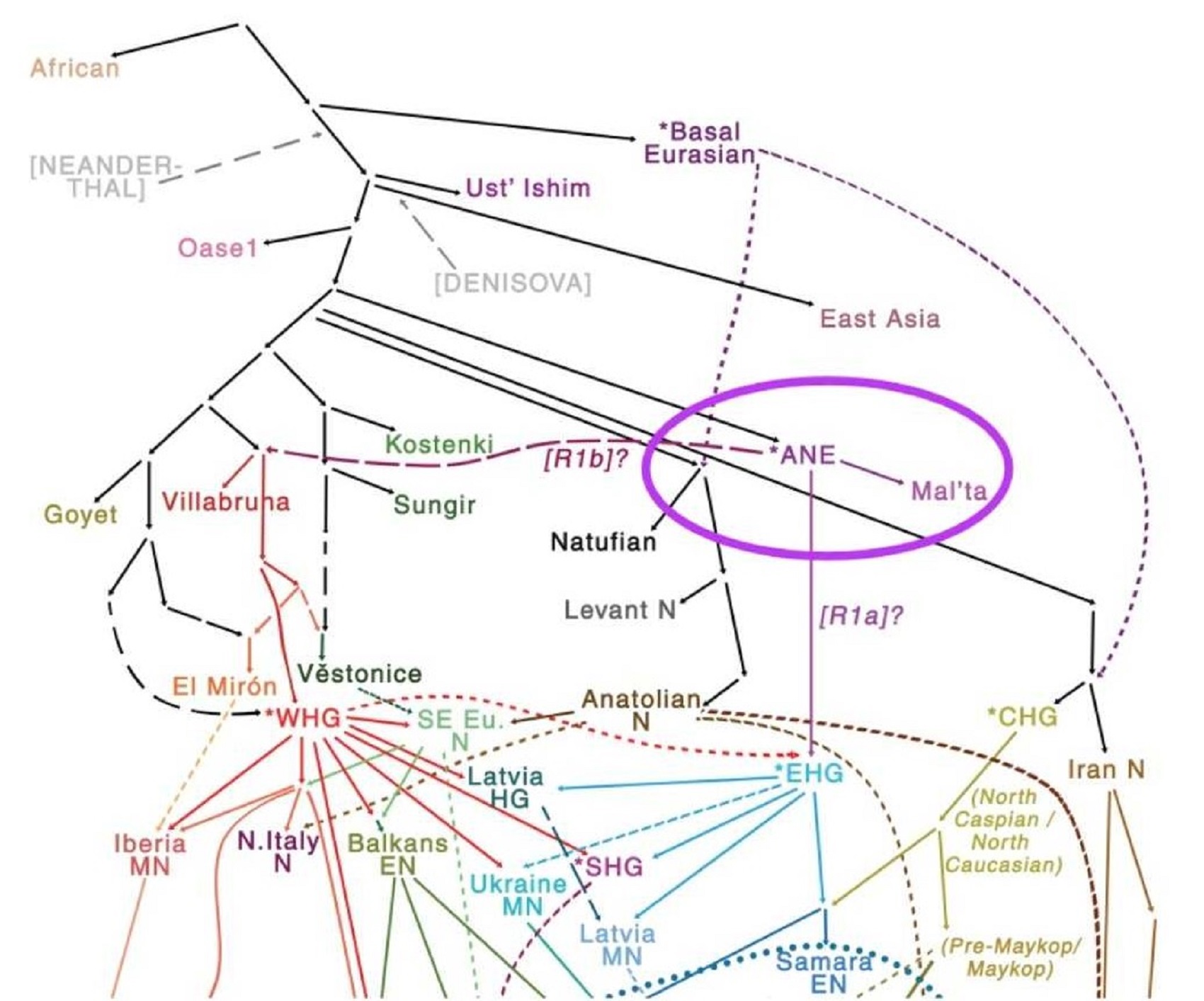
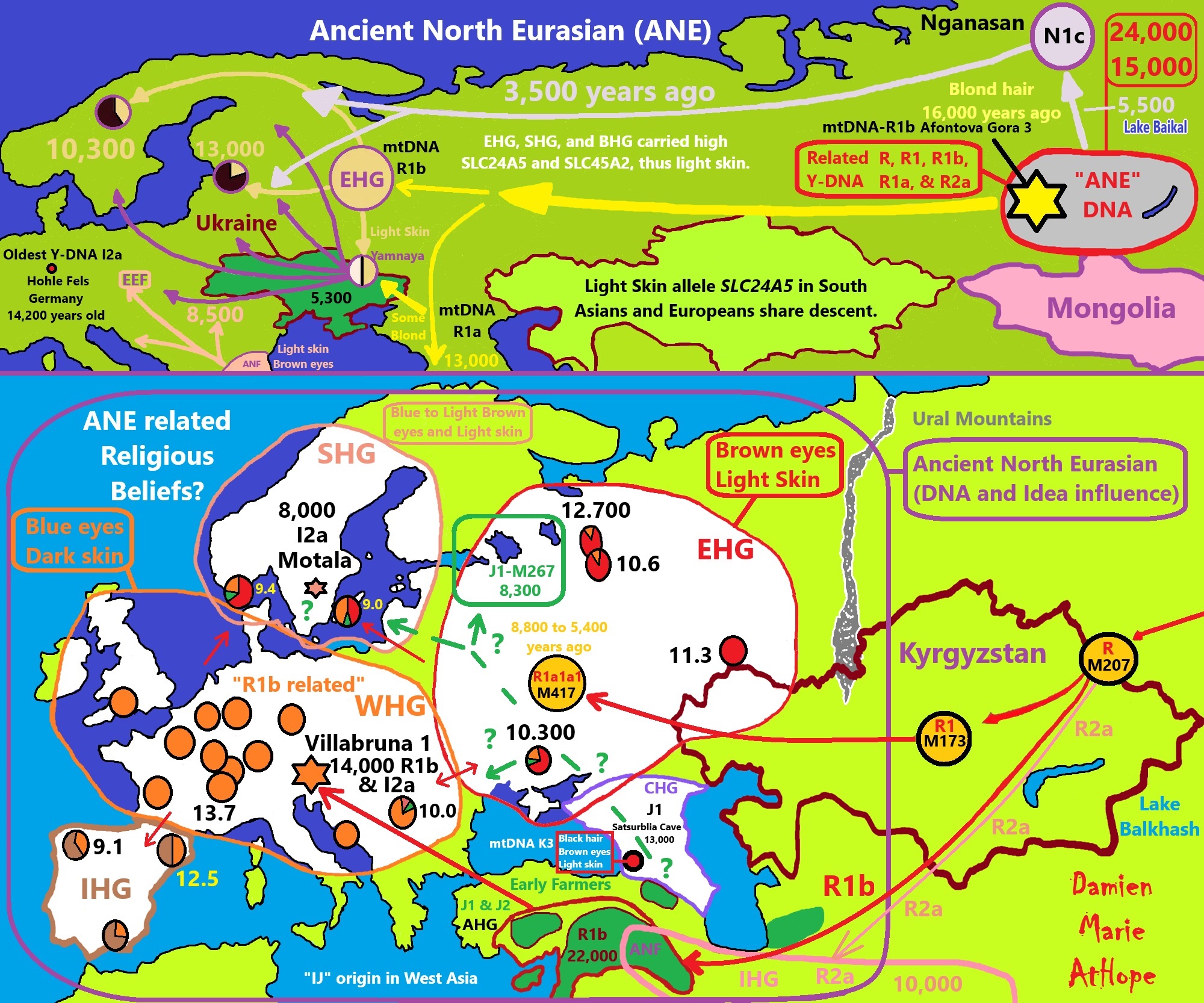
ref, ref, ref, ref, ref, ref, ref, ref, ref, ref, ref, ref, ref, ref, ref, ref, ref, ref, ref, ref, ref, ref, ref, ref, ref, ref, ref, ref, ref
Genetic Relations to Ancient North Eurasians (ANE):
Eastern hunter-gatherer (EHG)
Caucasus hunter-gatherer (CHG)
Zagros/Iranian Hunter-Gatherer (IHG)
Iranian Neolithic Farmers (INF)
Anatolian hunter-gatherer (AHG)
Anatolian Neolithic Farmers (ANF)
Early European Farmers (EEF)
Yamnaya/Steppe Herders (WSH)
Villabruna 1 (burial)/Ripari Villabruna rock shelter in northern Italy (14,000 years old)
Satsurblia Cave (burial) in the Country of Georgia (13,000 years old)
Motala (burial) (8,000 years old)
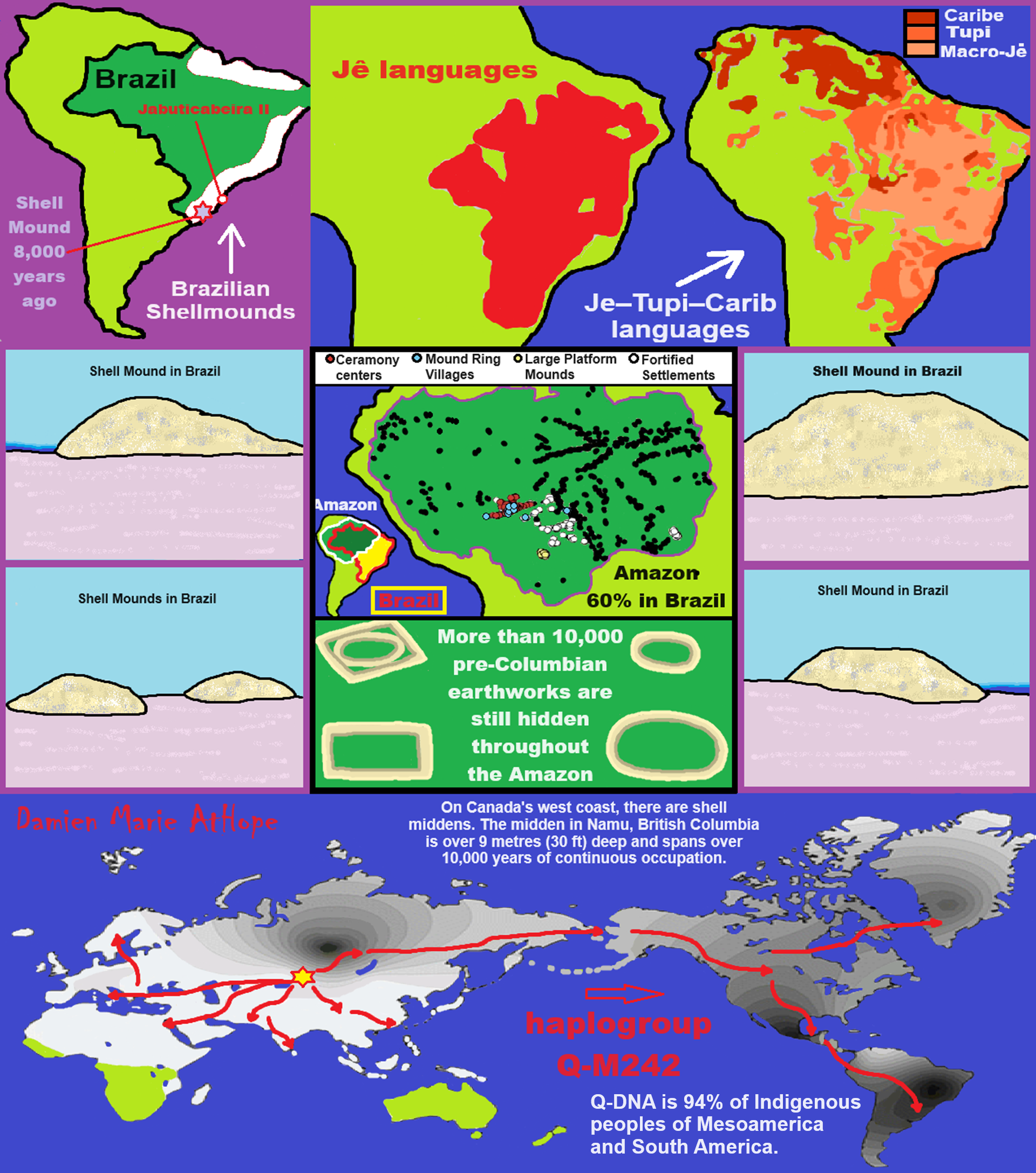
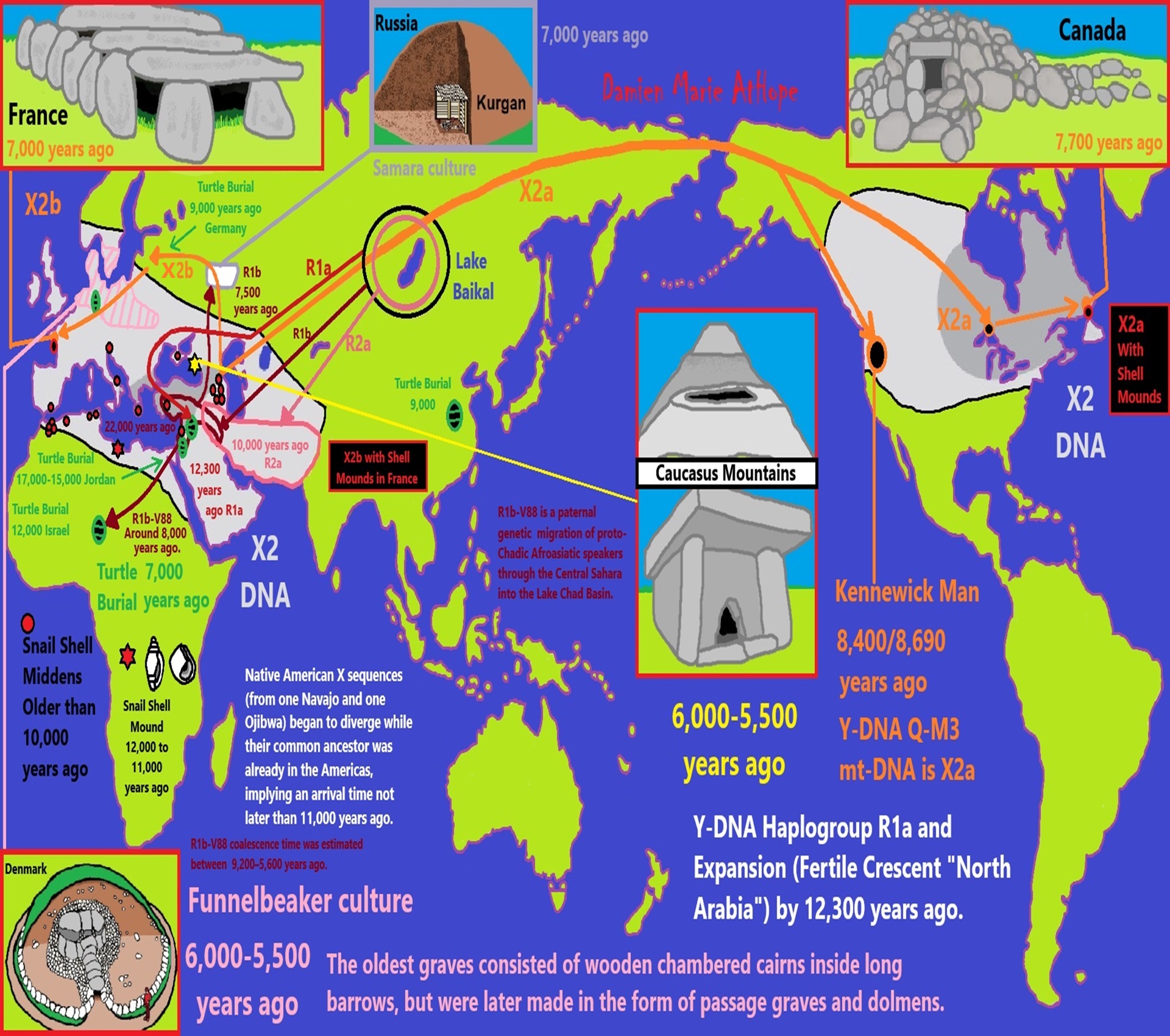
ref, ref, ref, ref, ref, ref, ref, ref, ref, ref, ref, ref, ref, ref, ref, ref, ref, ref, ref, ref, ref, ref, ref, ref, ref, ref, ref, ref, ref, ref, ref, ref, ref, ref, ref, ref, ref, ref, ref
Earth diver mythology or something similar??? Could be. In a way, snails are a kind of mound shape, thus similar to turtle shells, both may represent a mound of creation in the earth-diver myth. In Peru, there were snail shells, and snail shells are also used in the earth diver.
My thoughts on Dolmen origins and migrations, as well as Snail Shell Middens or Snail Burials/Turtle Shell Burials, and links from “Y-DNA R (R1a, R1b, and R2a)” migrations, maybe R2a leading to Proto-Indo-European, transferring it to R1b, taking it to the steppe 7,500 years ago.
Religion is a cultural product. So, it has been part of the human experience, similar to languages, from before we left Africa, spreading humanity across the world.

Groups partially derived from the Ancient North Eurasians
“The ANE lineage is defined by association with the MA-1, or “Mal’ta boy”, remains of 24,000 years ago in central Siberia Mal’ta-Buret’ culture 24,000-15,000 years ago. The Ancient North Eurasians (ANE) samples (Afontova Gora 3, Mal’ta 1, and Yana-RHS) show evidence for minor gene flow from an East Asian-related group (simplified by the Amis, Han, or Tianyuan) but no evidence for ANE-related geneflow into East Asians (Amis, Han, Tianyuan), except the Ainu, of North Japan.” ref
“The ANE lineage is defined by association with the MA-1, or “Mal’ta boy”, remains of 24,000 years ago in central Siberia Mal’ta-Buret’ culture 24,000-15,000 years ago “basal to modern-day Europeans”. Some Ancient North Eurasians also carried East Asian populations, such as Tianyuan Man.” ref
“Bronze-age-steppe Yamnaya and Afanasevo cultures were ANE at around 50% and Eastern Hunter-Gatherer (EHG) at around 75% ANE. Karelia culture: Y-DNA R1a-M417 8,400 years ago, Y-DNA J, 7,200 years ago, and Samara, of Y-haplogroup R1b-P297 7,600 years ago is closely related to ANE from Afontova Gora, 18,000 years ago around the time of blond hair first seen there.” ref
Ancient North Eurasian
“In archaeogenetics, the term Ancient North Eurasian (often abbreviated as ANE) is the name given to an ancestral West Eurasian component that represents descent from the people similar to the Mal’ta–Buret’ culture and populations closely related to them, such as from Afontova Gora and the Yana Rhinoceros Horn Site. Significant ANE ancestry are found in some modern populations, including Europeans and Native Americans.” ref
“The ANE lineage is defined by association with the MA-1, or “Mal’ta boy“, the remains of an individual who lived during the Last Glacial Maximum, 24,000 years ago in central Siberia, Ancient North Eurasians are described as a lineage “which is deeply related to Paleolithic/Mesolithic hunter-gatherers in Europe,” meaning that they diverged from Paleolithic Europeans a long time ago.” ref
“The ANE population has also been described as having been “basal to modern-day Europeans” but not especially related to East Asians, and is suggested to have perhaps originated in Europe or Western Asia or the Eurasian Steppe of Central Asia. However, some samples associated with Ancient North Eurasians also carried ancestry from an ancient East Asian population, such as Tianyuan Man. Sikora et al. (2019) found that the Yana RHS sample (31,600 BP) in Northern Siberia “can be modeled as early West Eurasian with an approximately 22% contribution from early East Asians.” ref
“Populations genetically similar to MA-1 were an important genetic contributor to Native Americans, Europeans, Central Asians, South Asians, and some East Asian groups, in order of significance. Lazaridis et al. (2016:10) note “a cline of ANE ancestry across the east-west extent of Eurasia.” The ancient Bronze-age-steppe Yamnaya and Afanasevo cultures were found to have a noteworthy ANE component at ~50%.” ref
“According to Moreno-Mayar et al. 2018 between 14% and 38% of Native American ancestry may originate from gene flow from the Mal’ta–Buret’ people (ANE). This difference is caused by the penetration of posterior Siberian migrations into the Americas, with the lowest percentages of ANE ancestry found in Eskimos and Alaskan Natives, as these groups are the result of migrations into the Americas roughly 5,000 years ago.” ref
“Estimates for ANE ancestry among first wave Native Americans show higher percentages, such as 42% for those belonging to the Andean region in South America. The other gene flow in Native Americans (the remainder of their ancestry) was of East Asian origin. Gene sequencing of another south-central Siberian people (Afontova Gora-2) dating to approximately 17,000 years ago, revealed similar autosomal genetic signatures to that of Mal’ta boy-1, suggesting that the region was continuously occupied by humans throughout the Last Glacial Maximum.” ref
“The earliest known individual with a genetic mutation associated with blonde hair in modern Europeans is an Ancient North Eurasian female dating to around 16000 BCE from the Afontova Gora 3 site in Siberia. It has been suggested that their mythology may have included a narrative, found in both Indo-European and some Native American fables, in which a dog guards the path to the afterlife.” ref
“Genomic studies also indicate that the ANE component was introduced to Western Europe by people related to the Yamnaya culture, long after the Paleolithic. It is reported in modern-day Europeans (7%–25%), but not of Europeans before the Bronze Age. Additional ANE ancestry is found in European populations through paleolithic interactions with Eastern Hunter-Gatherers, which resulted in populations such as Scandinavian Hunter-Gatherers.” ref
“The Ancient North Eurasians (ANE) split from the ancestors of European peoples somewhere in the Middle East or South-central Asia, and used a northern dispersal route through Central Asia into Northern Asia and Siberia. Genetic analyses show that all ANE samples (Afontova Gora 3, Mal’ta 1, and Yana-RHS) show evidence for minor gene flow from an East Asian-related group (simplified by the Amis, Han, or Tianyuan). In contrast, no evidence for ANE-related geneflow into East Asians (Amis, Han, Tianyuan), except the Ainu, was found.” ref
“Genetic data suggests that the ANE formed during the Terminal Upper-Paleolithic (36+-1,5ka) period from a deeply European-related population, which was once widespread in Northern Eurasia, and from an early East Asian-related group, which migrated northwards into Central Asia and Siberia, merging with this deeply European-related population. These population dynamics and constant northwards geneflow of East Asian-related ancestry would later gave rise to the “Ancestral Native Americans” and Paleosiberians, which replaced the ANE as dominant population of Siberia.” ref
Groups partially derived from the Ancient North Eurasians
“Eastern Hunter-Gatherer (EHG) is a lineage derived predominantly (75%) from ANE. It is represented by two individuals from Karelia, one of Y-haplogroup R1a-M417, dated c. 8.4 kya, the other of Y-haplogroup J, dated c. 7.2 kya; and one individual from Samara, of Y-haplogroup R1b-P297, dated c. 7.6 kya. This lineage is closely related to the ANE sample from Afontova Gora, dated c. 18 kya. After the end of the Last Glacial Maximum, the Western Hunter-Gatherers (WHG) and EHG lineages merged in Eastern Europe, accounting for early presence of ANE-derived ancestry in Mesolithic Europe. Evidence suggests that as Ancient North Eurasians migrated West from Eastern Siberia, they absorbed Western Hunter-Gatherers and other West Eurasian populations as well.” ref
“Caucasian Hunter-Gatherer (CHG) is represented by the Satsurblia individual dated ~13 kya (from the Satsurblia cave in Georgia), and carried 36% ANE-derived admixture. While the rest of their ancestry is derived from the Dzudzuana cave individual dated ~26 kya, which lacked ANE-admixture, Dzudzuana affinity in the Caucasus decreased with the arrival of ANE at ~13 kya Satsurblia.” ref
“Scandinavian Hunter-Gatherer (SHG) is represented by several individuals buried at Motala, Sweden ca. 6000 BC. They were descended from Western Hunter-Gatherers who initially settled Scandinavia from the south, and later populations of EHG who entered Scandinavia from the north through the coast of Norway.” ref
“Iran Neolithic (Iran_N) individuals dated ~8.5 kya carried 50% ANE-derived admixture and 50% Dzudzuana-related admixture, marking them as different from other Near-Eastern and Anatolian Neolithics who didn’t have ANE admixture. Iran Neolithics were later replaced by Iran Chalcolithics, who were a mixture of Iran Neolithic and Near Eastern Levant Neolithic.” ref
“Ancient Beringian/Ancestral Native American are specific archaeogenetic lineages, based on the genome of an infant found at the Upward Sun River site (dubbed USR1), dated to 11,500 years ago. The AB lineage diverged from the Ancestral Native American (ANA) lineage about 20,000 years ago.” ref
“West Siberian Hunter-Gatherer (WSHG) are a specific archaeogenetic lineage, first reported in a genetic study published in Science in September 2019. WSGs were found to be of about 30% EHG ancestry, 50% ANE ancestry, and 20% to 38% East Asian ancestry.” ref
“Western Steppe Herders (WSH) is the name given to a distinct ancestral component that represents descent closely related to the Yamnaya culture of the Pontic–Caspian steppe. This ancestry is often referred to as Yamnaya ancestry or Steppe ancestry.” ref
“Late Upper Paeolithic Lake Baikal – Ust’Kyakhta-3 (UKY) 14,050-13,770 BP were mixture of 30% ANE ancestry and 70% East Asian ancestry.” ref
“Lake Baikal Holocene – Baikal Eneolithic (Baikal_EN) and Baikal Early Bronze Age (Baikal_EBA) derived 6.4% to 20.1% ancestry from ANE, while rest of their ancestry was derived from East Asians. Fofonovo_EN near by Lake Baikal were mixture of 12-17% ANE ancestry and 83-87% East Asian ancestry.” ref
“Hokkaido Jōmon people specifically refers to the Jōmon period population of Hokkaido in northernmost Japan. Though the Jōmon people themselves descended mainly from East Asian lineages, one study found an affinity between Hokkaido Jōmon with the Northern Eurasian Yana sample (an ANE-related group, related to Mal’ta), and suggest as an explanation the possibility of minor Yana gene flow into the Hokkaido Jōmon population (as well as other possibilities). A more recent study by Cooke et al. 2021, confirmed ANE-related geneflow among the Jōmon people, partially ancestral to the Ainu people. ANE ancestry among Jōmon people is estimated at 21%, however, there is a North to South cline within the Japanese archipelago, with the highest amount of ANE ancestry in Hokkaido and Tohoku.” ref
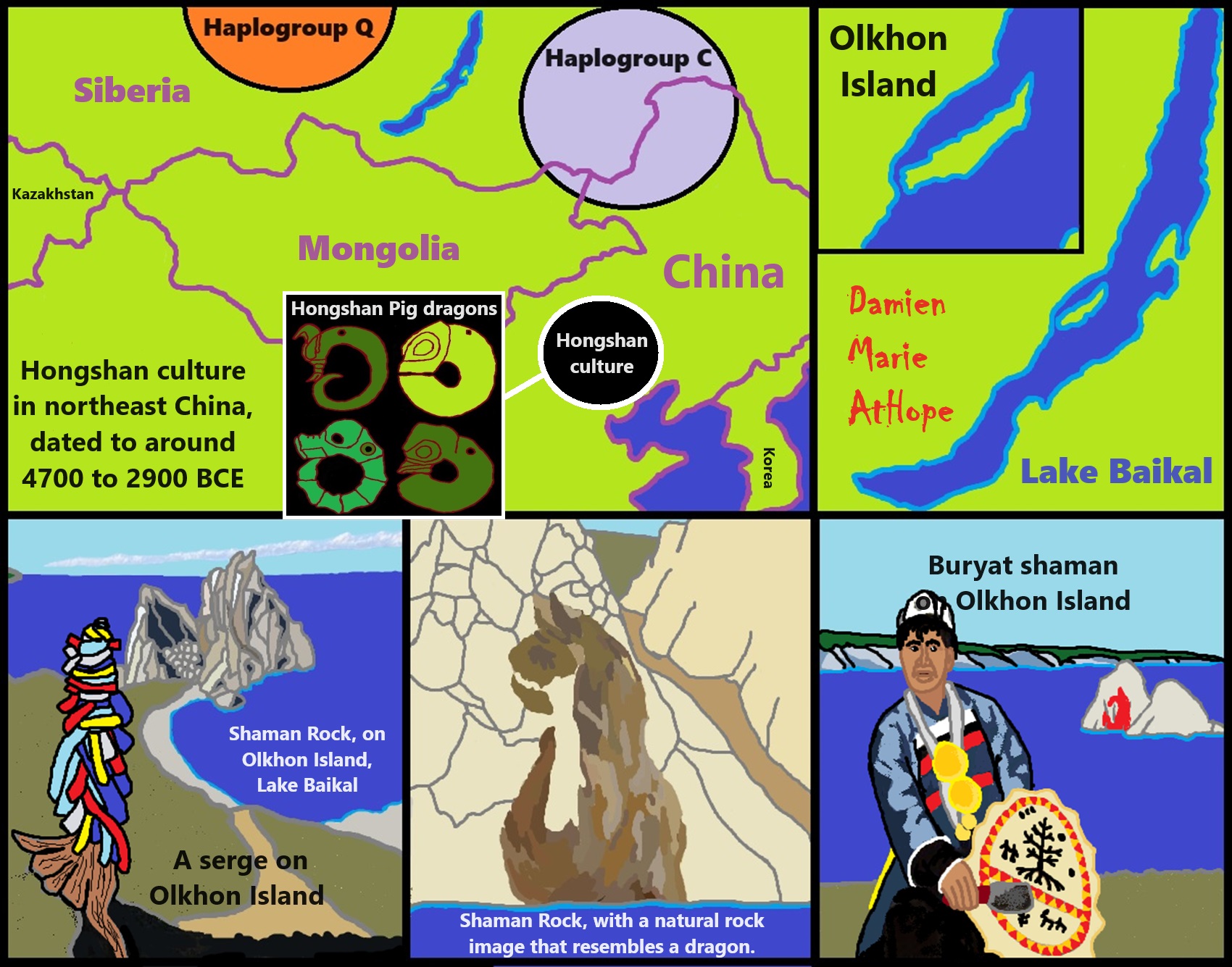
People may have first seen the Shaman Rock with the natural brown rock formation resembling a dragon between 30,000 to 25,000 years ago.
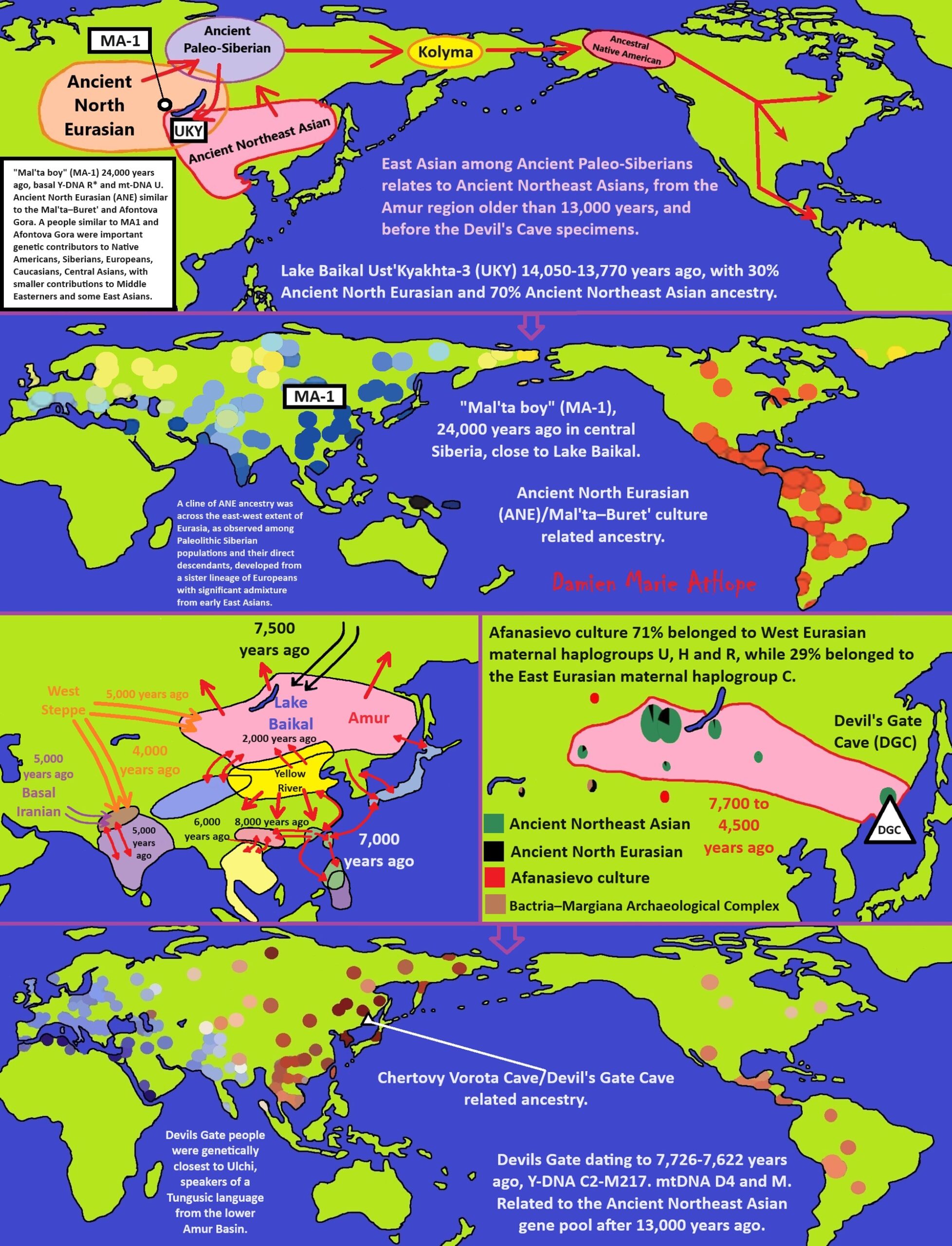
ref, ref, ref, ref, ref, ref, ref, ref, ref, ref, ref, ref, ref, ref, ref
“A 2016 study found that the global maximum of Ancient North Eurasian (ANE) ancestry occurs in modern-day Kets, Mansi, Native Americans, and Selkups. ANE ancestry has spread throughout Eurasia and the Americas in various migrations since the Upper Paleolithic, and more than half of the world’s population today derives between 5 and 42% of their genomes from the Ancient North Eurasians. Significant ANE ancestry can be found in Native Americans, as well as in regions of northern Europe, South Asia, Central Asia, and Siberia. It has been suggested that their mythology may have featured narratives shared by both Indo-European and some Native American cultures, such as the existence of a metaphysical world tree and a fable in which a dog guards the path to the afterlife.” ref
Ancient Northern East Asian/ later became Ancient Northeast Asian
Ancient Paleo-Siberian
Mal’ta–Buret’ culture (Mal’ta boy MA-1)
The Kolyma Shaitans: Legends and Reality (I only use just a small part)
“A unique “shaitan” burial was discovered on the bank of Omuk-Kuel Lake in the Middle-Kolyma ulus in Yakutia. According to the legends, buried in it are mummified remains of a shaman woman who died during a devastating smallpox epidemics in the 18th c. In an attempt to overcome the deadly disease, the shaman’s relatives used her remains as an emeget fetish. The author believes that these legends reflect the real events of those far-away years. The Arabic word “shaitan” came to the Russian language from Turkic languages. According to Islamic tradition, a shaitan is a genie, an evil spirit, a demon. During Russian colonization and Christianization of Siberia, all sacred things used by the aborigines as fetishes, patron spirits of the family, and the tribe, grew to be called “shaitans.” There are various facts, dating to the 18th and 19th cc., confirming that this word also referred to the mummified remains of outstanding shamans.” ref
“In the 1740s, a member of the Second Kamchatka Expedition Yakov Lindenau wrote, “Meat is scratched off the [shaman’s] bones and the bones are put together to form a skeleton, which is dressed in human’s clothes and worshipped as a deity. The Yukagirs place such dressed bones…in their yurts, their number can sometimes reach 10 or 15. If somebody commits even a minor sacrilege with respect to these bones, he stirs up rancor on the part of the Yukagirs… While traveling and hunting, the Yukagirs carry these bones in their sledges, and moreover, in their best sledges pulled by their best deer. When the Yukagirs are going to undertake something really important, they tell fortune using these skeletons: lift a skeleton up, and if it seems light, it means that their enterprise will have a favorable outcome. The Yukagirs call these skeletons stariks (old men), endow them with their best furs, and sit them on beds covered with deer hides, in a circle, as though they are alive.” (Lindenau, 1983, p. 155)” ref
“In the late 19th c., a famous explorer of aboriginal culture V. I. Jochelson noted the changes that occurred in the ritual in the last century and a half. So, the Yukagirs divided among themselves the shaman’s meat dried in the sun and then put it in separate tents. The dead bodies of killed dogs were left there as well. “After that,” V. I. Jochelson writes, “they would divide the shaman’s bones, dry them and wrap in clothes. The skull was an object of worshipping. It was put on top of a trunk (body) cut out of wood. A caftan and two hats – a winter and a summer one – were sewn for the idol. The caftan was all embroidered. On the skull, a special mask was put, with holes for the eyes and the mouth… The figure was placed in the front corner of the home. Before a meal, a piece of food was thrown into the fire and the idol was held above it. This feeding of the idol… was committed before each meal.” (V. I. Jochelson, 2005, pp. 236—237)” ref
“The idol was kept by the children of the dead shaman. One of them was inducted into the shamanism mysteries while his father was still alive. The idol was carried in a wooden box. Sometimes, in line with the air burial ritual, the box was erected on poles or trees, and the idol was taken out only before hunting or a long journey so that the outcome of the enterprise planned could be predicted. With time, the Yukagirs began using wooden idols as charms. V. I. Jochelson notes that by the late 19th c. the Yukagirs had developed a skeptical attitude towards idols and referred to them as “shaitans.” In this way, under the influence of Christianity, the worshipped ancestor’s spirit turned into its opposite – an evil spirit, a devil, a Satan.” ref
Ancestral Native American, Ancient Beringian
14,000-year-old Ust-Kyakhta-3 (UKY) individual found near Lake Baikal
Chertovy Vorota Cave/Devil’s Gate Cave
Bactria–Margiana Archaeological Complex
32,000-21,000 years ago Yana Culture, at the Yana Woolly Rhinoceros Horn Site in Siberia, with genetic proximity to Ancient North Eurasian populations (Mal’ta and Afontova Gora), but also Ust-Ishim, Sunghir, and to a lesser extent Tianyuan, as well as similarities with the Clovis culture


Pottery before the Pre-Pottery Neolithic? “YES”

ref, ref, ref, ref, ref, ref, ref, ref, ref, ref, ref, ref, ref, ref, ref, ref, ref, ref, ref
Here are my thoughts/speculations on where I believe is the possible origin of shamanism, which may have begun sometime around 35,000 to 30,000 years ago seen in the emergence of the Gravettian culture, just to outline his thinking, on what thousands of years later led to evolved Asian shamanism, in general, and thus WU shamanism as well. In both Europe-related “shamanism-possible burials” and in Gravettian mitochondrial DNA is a seeming connection to Haplogroup U. And the first believed Shaman proposed burial belonged to Eastern Gravettians/Pavlovian culture at Dolní Věstonice in southern Moravia in the Czech Republic, which is the oldest permanent human settlement that has ever been found. It is at Dolní Věstonice where approximately 27,000-25,000 years ago a seeming female shaman was buried and also there was an ivory totem portrait figure, seemingly of her.
And my thoughts on how cultural/ritual aspects were influenced in the area of Göbekli Tepe. I think it relates to a few different cultures starting in the area before the Neolithic. Two different groups of Siberians first from northwest Siberia with U6 haplogroup 40,000 to 30,000 or so. Then R Haplogroup (mainly haplogroup R1b but also some possible R1a both related to the Ancient North Eurasians). This second group added its “R1b” DNA of around 50% to the two cultures Natufian and Trialetian. To me, it is likely both of these cultures helped create Göbekli Tepe. Then I think the female art or graffiti seen at Göbekli Tepe to me possibly relates to the Epigravettians that made it into Turkey and have similar art in North Italy. I speculate that possibly the Totem pole figurines seen first at Kostenki, next went to Mal’ta in Siberia as seen in their figurines that also seem “Totem-pole-like”, and then with the migrations of R1a it may have inspired the Shigir idol in Russia and the migrations of R1b may have inspired Göbekli Tepe.
Göbekli Tepe Shamanism
From the journal Praehistorische Zeitschrift
“Abstract: The term shamanism is widely used in archaeology to describe early belief systems. Sometimes, this has taken the form of a one-size-fits-all-explanation, without a discussion of the concept or the cultural contexts it was applied to. Recently, the Early Neolithic (9600–7000 BCE) of southwestern Asia has become a focal point of this discussion. Sites like Nevalı Çori, Göbekli Tepe, Jerf el Ahmar, Körtik Tepe, Tell Abr’3, Tell Qaramel, Wadi Faynan 16, Karahantepe and Sayburç have produced rich evidence, mostly of an iconographical nature, that seems to offer direct insights into early belief systems. The current contribution uses one of the best-researched sites, Göbekli Tepe, as a case study to develop criteria for the identification of shamanism in the archaeological record.” ref
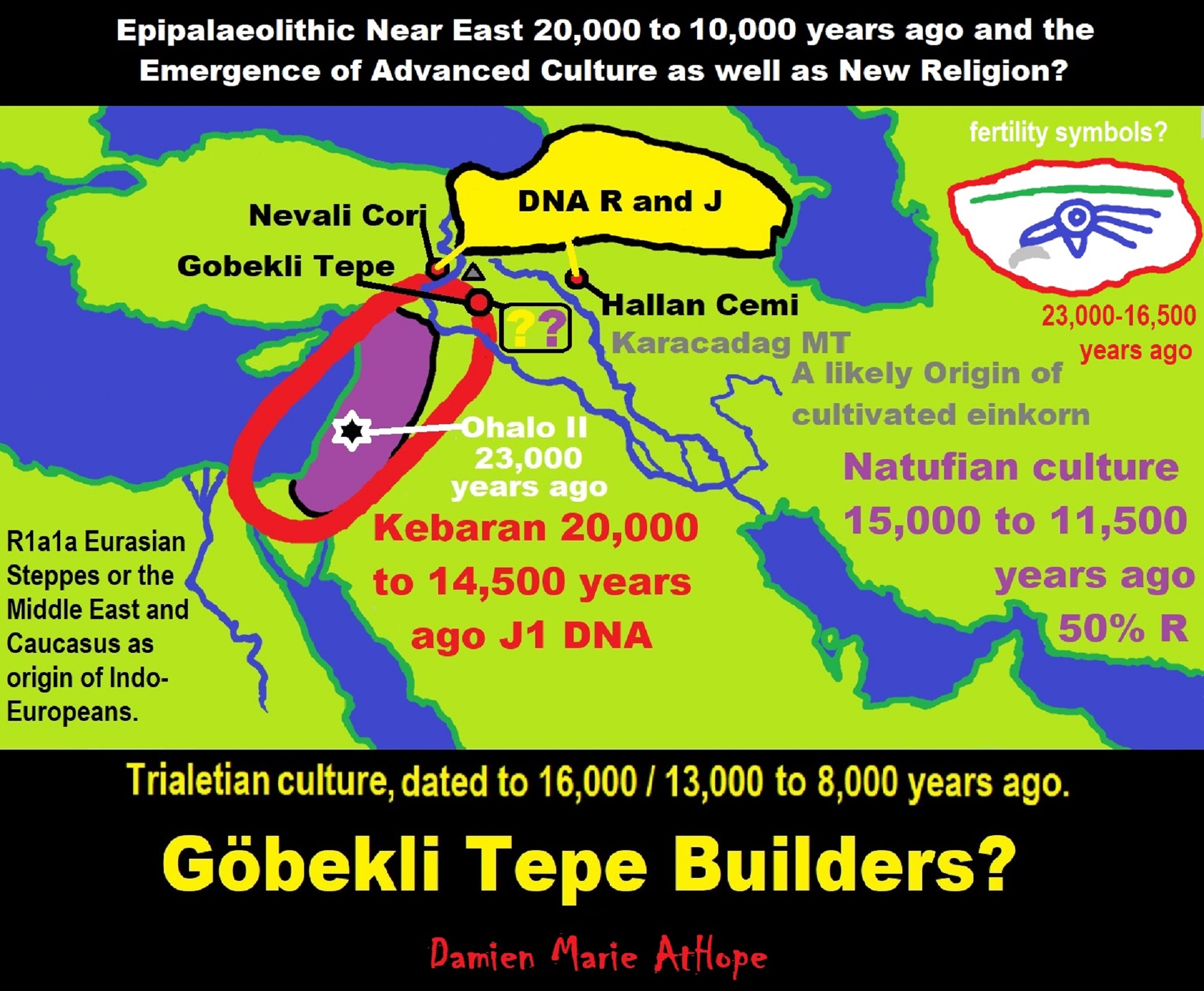
ref, ref, ref, ref, ref, ref, ref
Trialetian culture (16,000–8000 years ago) the Caucasus, Iran, and Turkey, likely involved in Göbekli Tepe. Migration 1?
Haplogroup R possible time of origin about 27,000 years in Central Asia, South Asia, or Siberia:
- Mal’ta–Buret’ culture (24,000-15,000 years ago)
- Afontova Gora culture (21,000-12,000 years ago)
- Trialetian culture (16,000–8000 years ago)
- Samara culture (7,000-6,500 years ago)
- Khvalynsk culture (7,000-6,500 years ago)
- Afanasievo culture (5,300-4,500 years ago)
- Yamna/Yamnaya Culture (5,300-4,500 years ago)
- Andronovo culture (4,000–2,900 years ago) ref
Trialetian sites
Caucasus and Transcaucasia:
- Edzani (Georgia)
- Chokh (Azerbaijan), layers E-C200
- Kotias Klde, layer B” ref
Eastern Anatolia:
- Hallan Çemi (from ca. 8.6-8.5k BC to 7.6-7.5k BCE)
- Nevali Çori shows some Trialetian admixture in a PPNB context” ref
Trialetian influences can also be found in:
- Cafer Höyük
- Boy Tepe” ref
Southeast of the Caspian Sea:
- Hotu (Iran)
- Ali Tepe (Iran) (from cal. 10,500 to 8,870 BCE)
- Belt Cave (Iran), layers 28-11 (the last remains date from ca. 6,000 BCE)
- Dam-Dam-Cheshme II (Turkmenistan), layers7,000-3,000 BCE)” ref
“Migration from Siberia behind the formation of Göbeklitepe: Expert states. People who migrated from Siberia formed the Göbeklitepe, and those in Göbeklitepe migrated in five other ways to spread to the world, said experts about the 12,000-year-old Neolithic archaeological site in the southwestern province of Şanlıurfa.“ The upper paleolithic migrations between Siberia and the Near East is a process that has been confirmed by material culture documents,” he said.” ref
“Semih Güneri, a retired professor from Caucasia and Central Asia Archaeology Research Center of Dokuz Eylül University, and his colleague, Professor Ekaterine Lipnina, presented the Siberia-Göbeklitepe hypothesis they have developed in recent years at the congress held in Istanbul between June 11 and 13. There was a migration that started from Siberia 30,000 years ago and spread to all of Asia and then to Eastern and Northern Europe, Güneri said at the international congress.” ref
“The relationship of Göbeklitepe high culture with the carriers of Siberian microblade stone tool technology is no longer a secret,” he said while emphasizing that the most important branch of the migrations extended to the Near East. “The results of the genetic analyzes of Iraq’s Zagros region confirm the traces of the Siberian/North Asian indigenous people, who arrived at Zagros via the Central Asian mountainous corridor and met with the Göbeklitepe culture via Northern Iraq,” he added.” ref
“Emphasizing that the stone tool technology was transported approximately 7,000 kilometers from east to west, he said, “It is not clear whether this technology is transmitted directly to long distances by people speaking the Turkish language at the earliest, or it travels this long-distance through using way stations.” According to the archaeological documents, it is known that the Siberian people had reached the Zagros region, he said. “There seems to be a relationship between Siberian hunter-gatherers and native Zagros hunter-gatherers,” Güneri said, adding that the results of genetic studies show that Siberian people reached as far as the Zagros.” ref
“There were three waves of migration of Turkish tribes from the Southern Siberia to Europe,” said Osman Karatay, a professor from Ege University. He added that most of the groups in the third wave, which took place between 2600-2400 BCE, assimilated and entered the Germanic tribes and that there was a genetic kinship between their tribes and the Turks. The professor also pointed out that there are indications that there is a technology and tool transfer from Siberia to the Göbeklitepe region and that it is not known whether people came, and if any, whether they were Turkish.” ref
“Around 12,000 years ago, there would be no ‘Turks’ as we know it today. However, there may have been tribes that we could call our ‘common ancestors,’” he added. “Talking about 30,000 years ago, it is impossible to identify and classify nations in today’s terms,” said Murat Öztürk, associate professor from İnönü University. He also said that it is not possible to determine who came to where during the migrations that were accepted to have been made thousands of years ago from Siberia. On the other hand, Mehmet Özdoğan, an academic from Istanbul University, has an idea of where “the people of Göbeklitepe migrated to.” ref
“According to Özdoğan, “the people of Göbeklitepe turned into farmers, and they could not stand the pressure of the overwhelming clergy and started to migrate to five ways.” “Migrations take place primarily in groups. One of the five routes extends to the Caucasus, another from Iran to Central Asia, the Mediterranean coast to Spain, Thrace and [the northwestern province of] Kırklareli to Europe and England, and one route is to Istanbul via [Istanbul’s neighboring province of] Sakarya and stops,” Özdoğan said. In a very short time after the migration of farmers in Göbeklitepe, 300 settlements were established only around northern Greece, Bulgaria, and Thrace. “Those who remained in Göbeklitepe pulled the trigger of Mesopotamian civilization in the following periods, and those who migrated to Mesopotamia started irrigated agriculture before the Sumerians,” he said.” ref
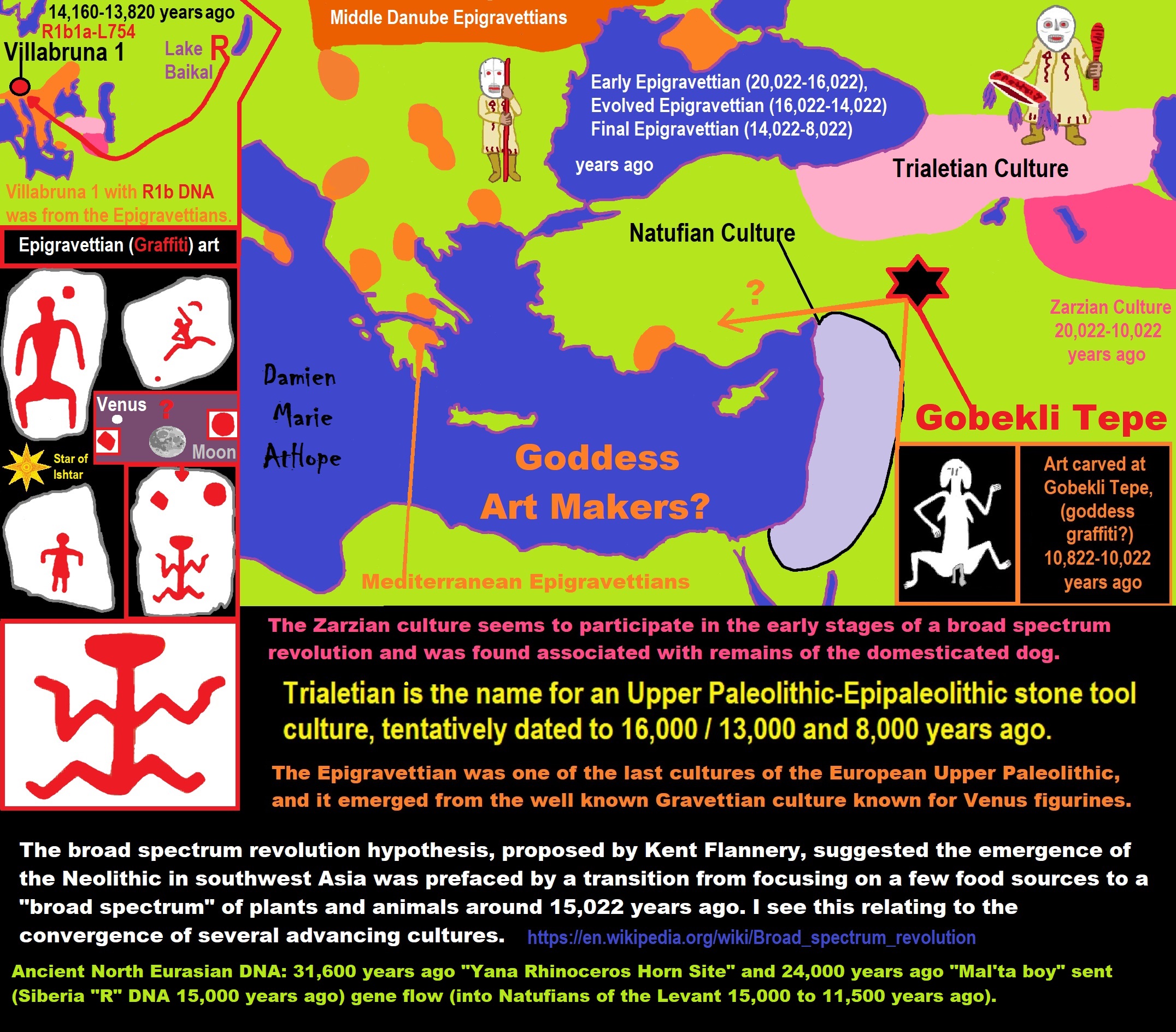
ref, ref, ref, ref, ref, ref, ref, ref, ref, ref, ref, ref, ref, ref, ref
Trialetian peoples which I think we’re more male-centric and involved in the creation of Göbekli Tepe, from its start around Pre-Pottery Neolithic A (12,000 – 10,800 years ago) began with their influence and this is seen in animal deities many clearly male and the figures also being expressively male themed as well at first, and only around Pre-Pottery Neolithic B (10,800 – 8,500 years ago) or so it seems with what I am guessing is new Epigravettian peoples with a more female-centric style (reminiscent but less than the Gravettians known for Venus figurines) influence from migration into the region, to gain new themes that add a female element both with A totem pole seeming to express birth or something similar and graffiti of a woman either ready for sex or giving birth or both. and Other bare figures seem to show a similar body position reminiscent of the graffiti of a woman.
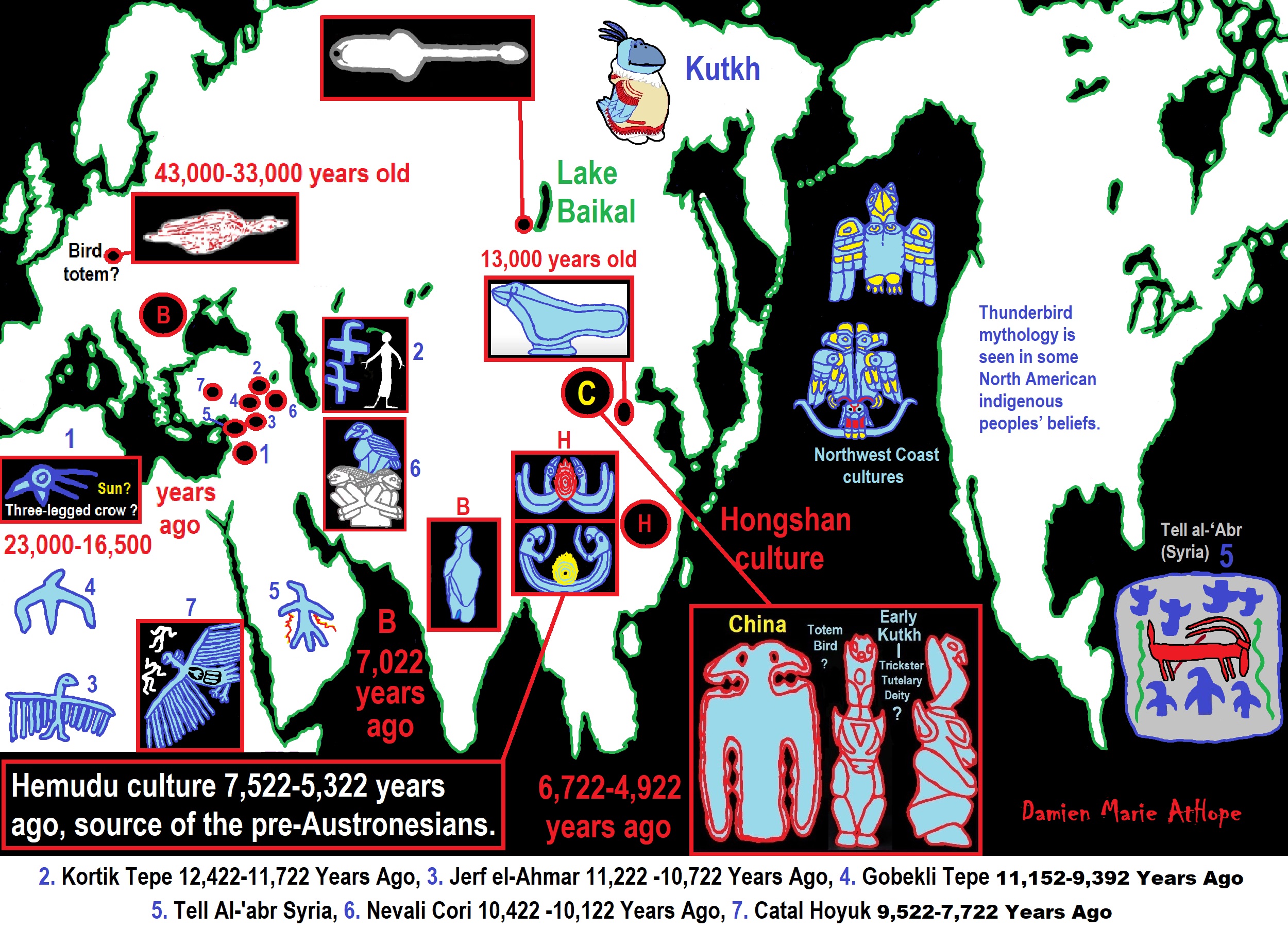
ref, ref, ref, ref, ref, ref, ref, ref, ref, ref, ref, ref, ref, ref
1. Kebaran culture 23,022-16,522 Years Ago, 2. Kortik Tepe 12,422-11,722 Years Ago, 3. Jerf el-Ahmar 11,222 -10,722 Years Ago, 4. Gobekli Tepe 11,152-9,392 Years Ago, 5. Tell Al-‘abrUbaid and Uruk Periods, 6. Nevali Cori 10,422 -10,122 Years Ago, 7. Catal Hoyuk 9,522-7,722 Years Ago
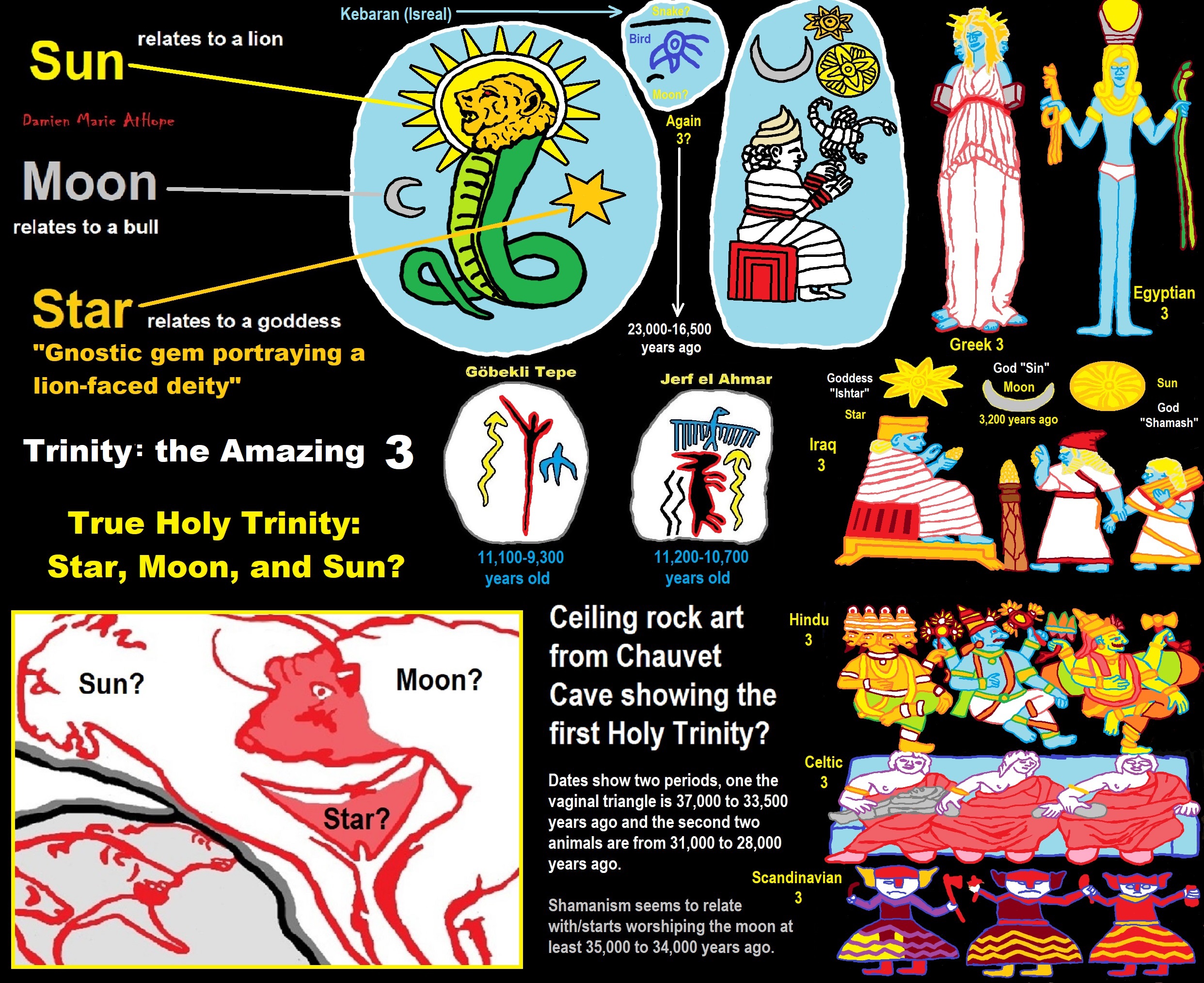

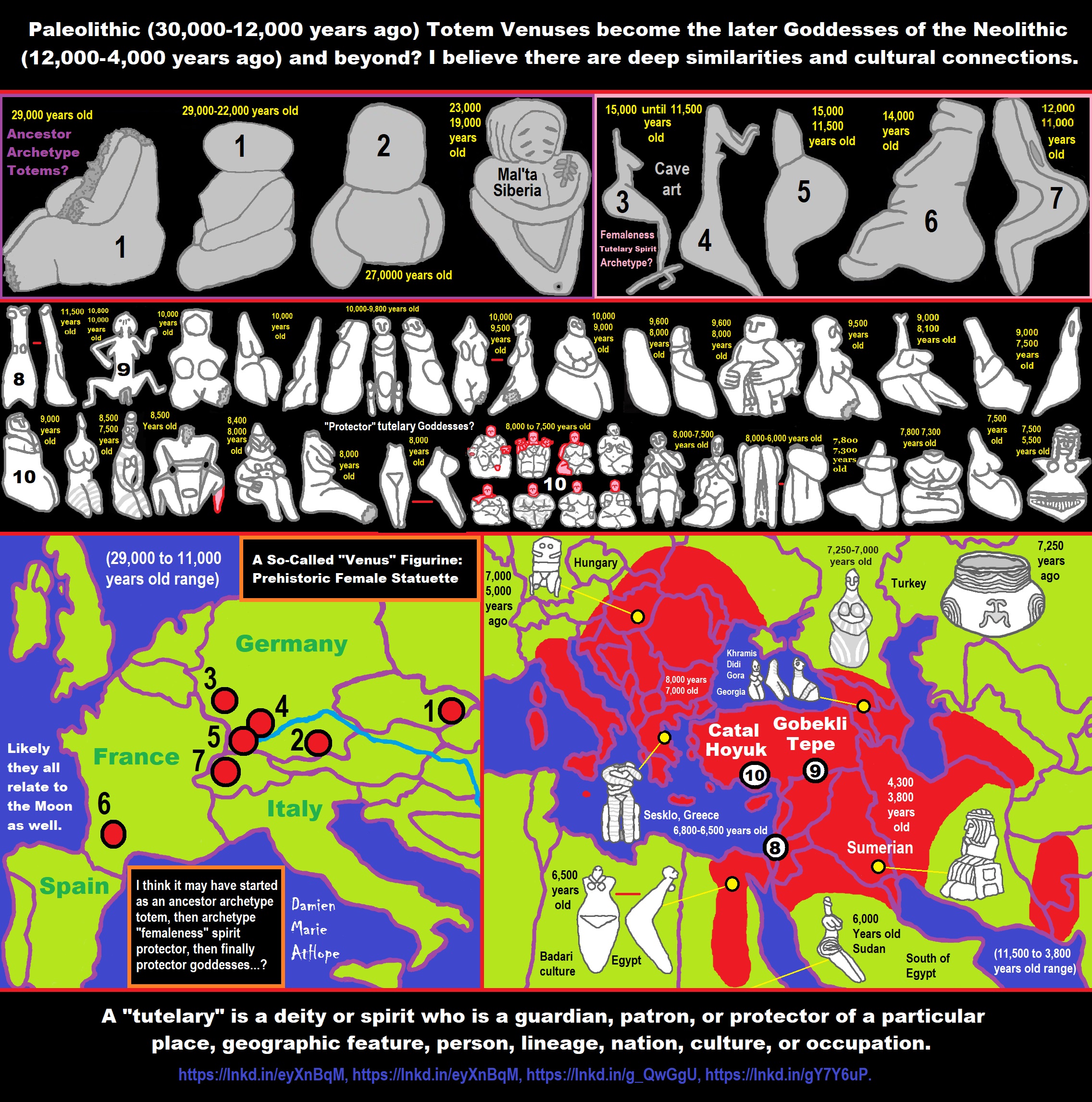

ref, ref, ref, ref, ref, ref, ref, ref, ref, ref, ref, ref, ref, ref, ref, ref, ref
“The shaman is, above all, a connecting figure, bridging several worlds for his people, traveling between this world, the underworld, and the heavens. He transforms himself into an animal and talks with ghosts, the dead, the deities, and the ancestors. He dies and revives. He brings back knowledge from the shadow realm, thus linking his people to the spirits and places which were once mythically accessible to all.–anthropologist Barbara Meyerhoff” ref

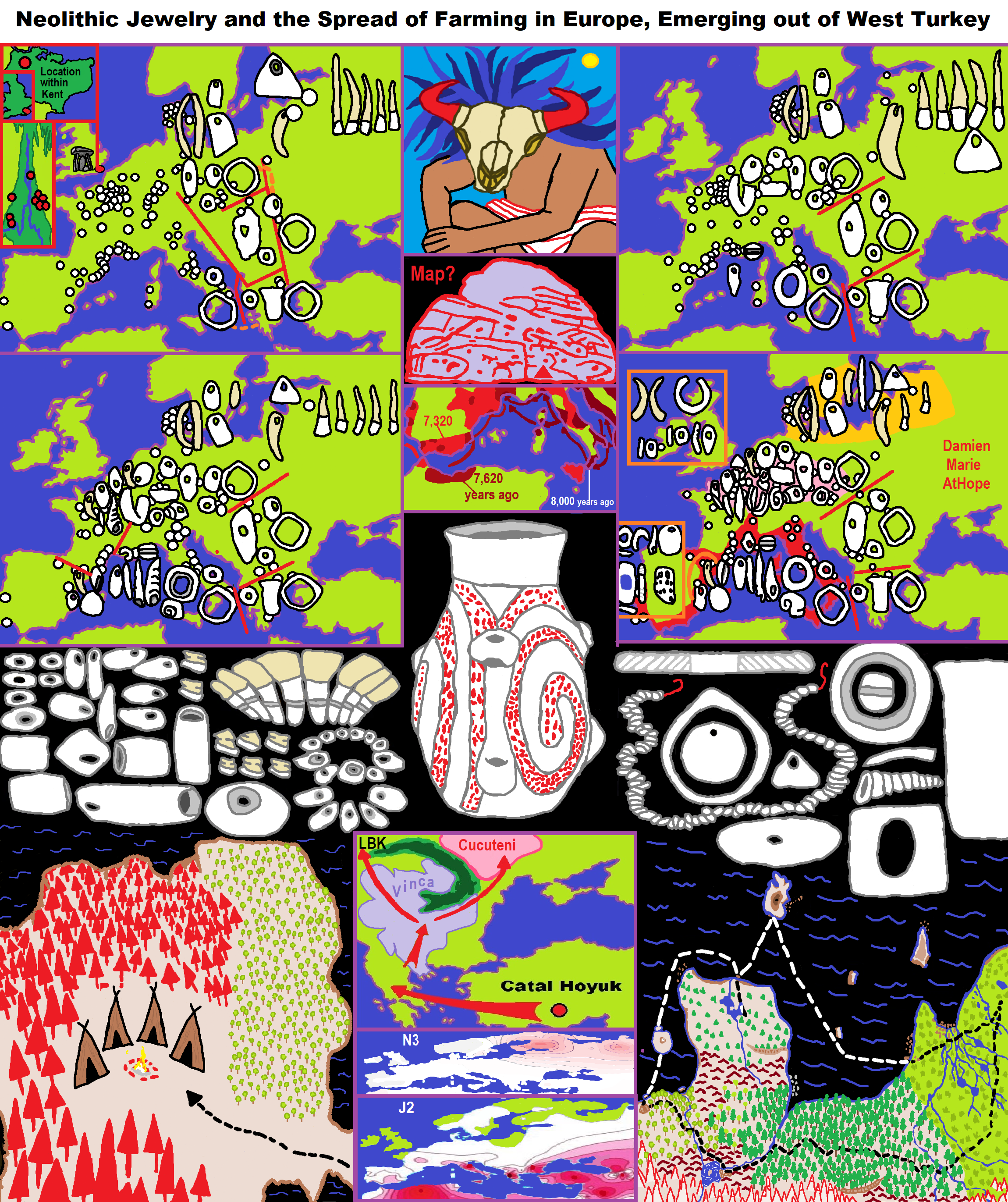
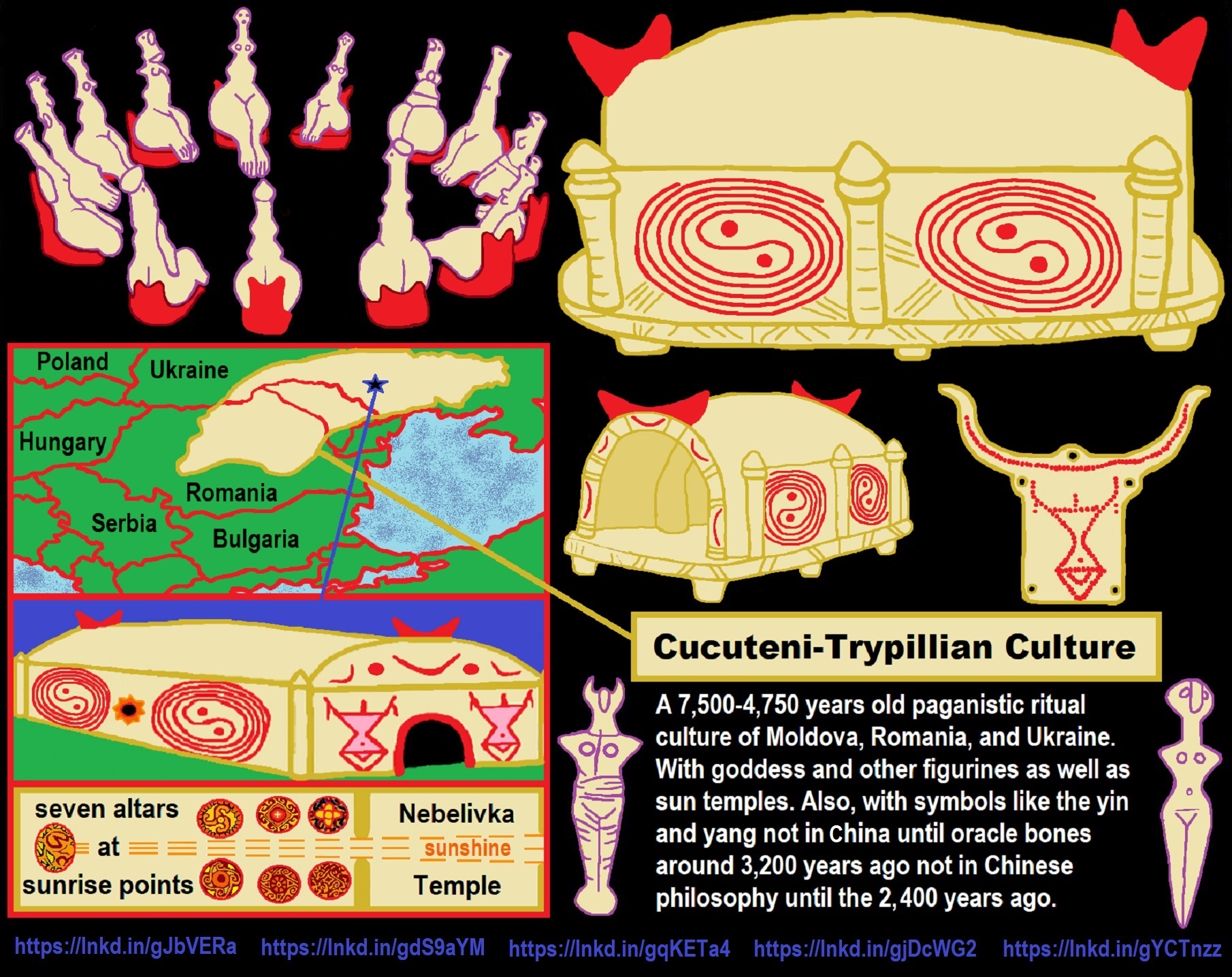
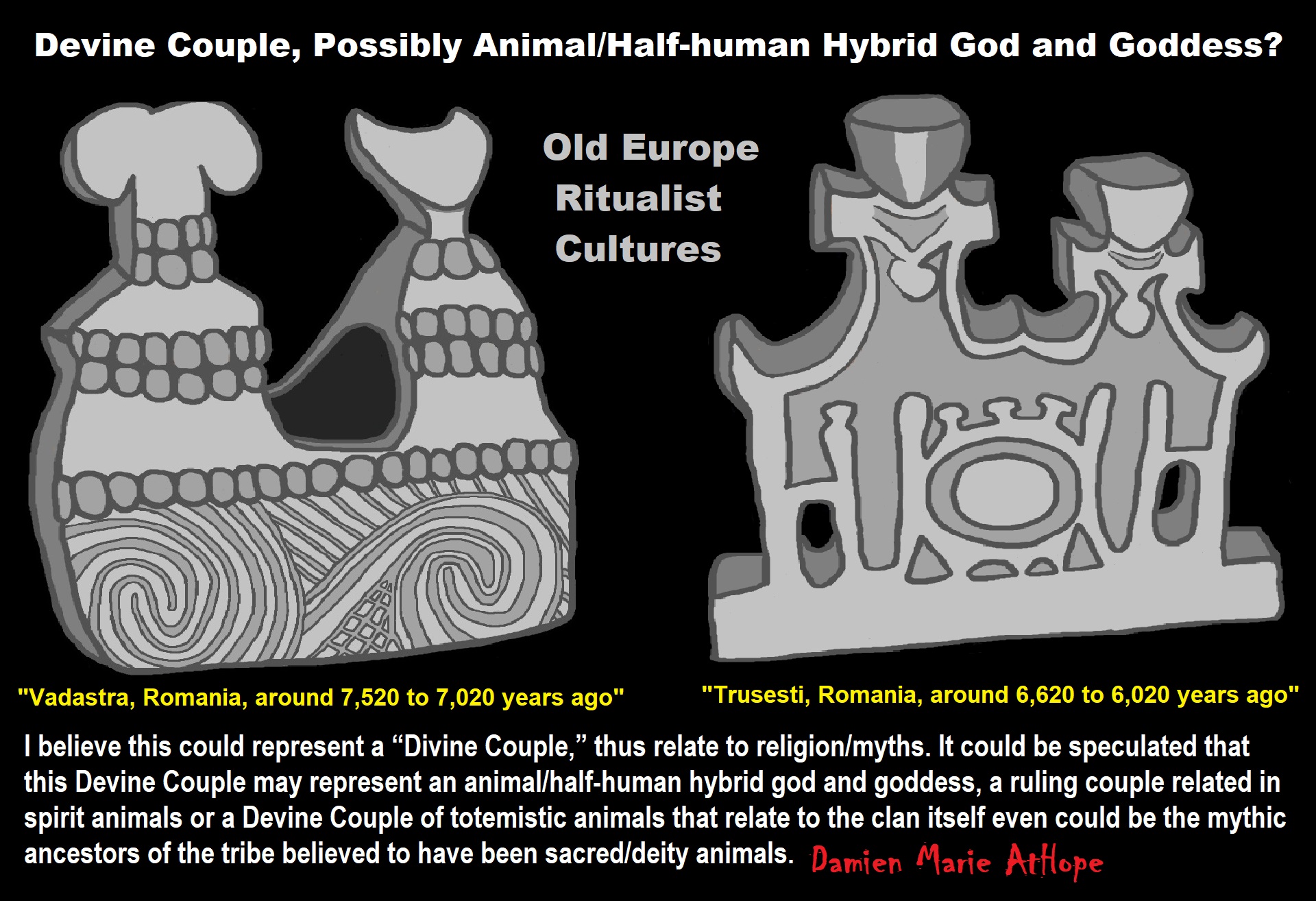
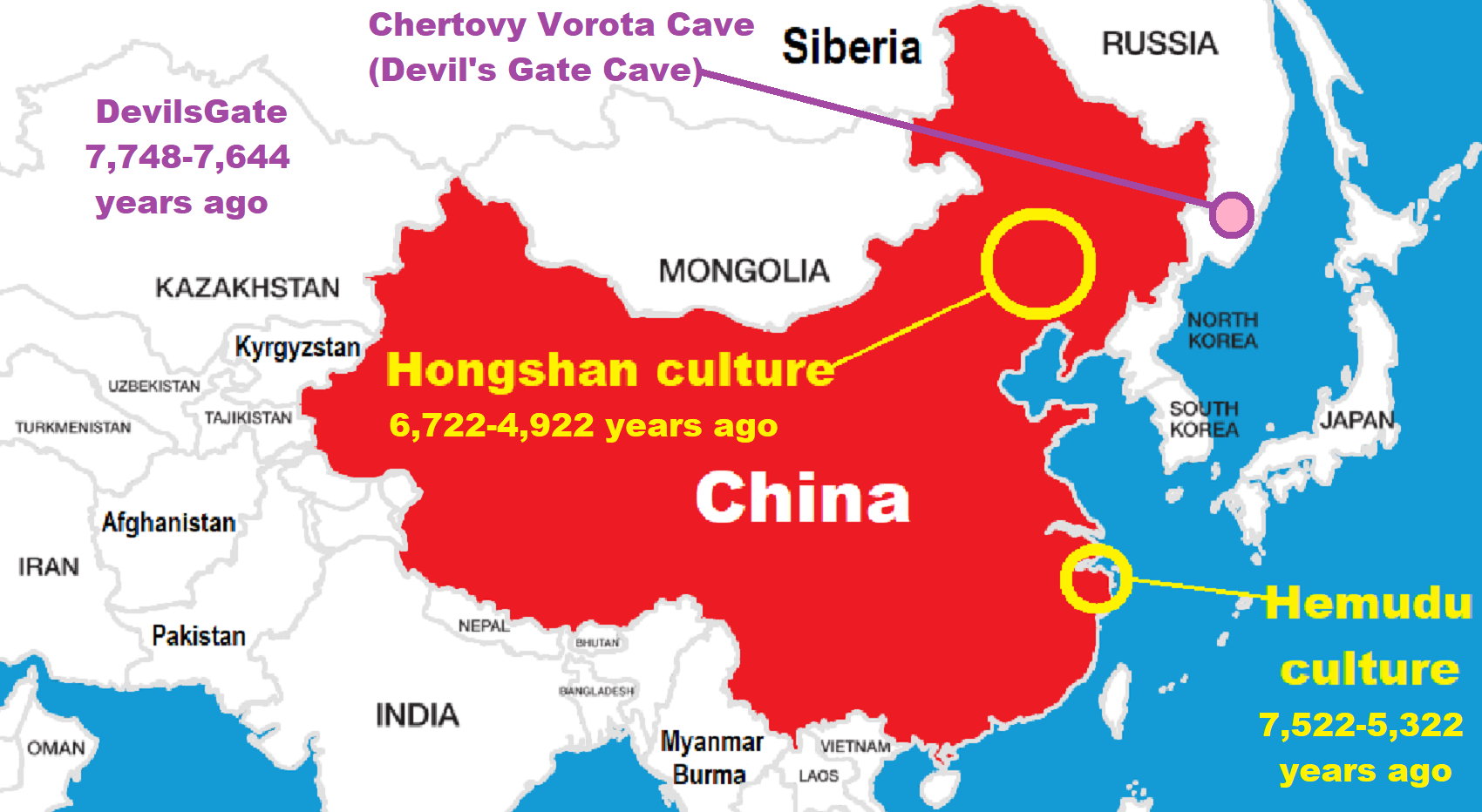
Origins of ‘Transeurasian’ languages traced to Neolithic millet farmers in north-eastern China about 9,000 years ago
“A study combining linguistic, genetic, and archaeological evidence has traced the origins of a family of languages including modern Japanese, Korean, Turkish and Mongolian and the people who speak them to millet farmers who inhabited a region in north-eastern China about 9,000 years ago. The findings outlined on Wednesday document a shared genetic ancestry for the hundreds of millions of people who speak what the researchers call Transeurasian languages across an area stretching more than 5,000 miles (8,000km).” ref
“Millet was an important early crop as hunter-gatherers transitioned to an agricultural lifestyle. There are 98 Transeurasian languages, including Korean, Japanese, and various Turkic languages in parts of Europe, Anatolia, Central Asia, and Siberia, various Mongolic languages, and various Tungusic languages in Manchuria and Siberia. This language family’s beginnings were traced to Neolithic millet farmers in the Liao River valley, an area encompassing parts of the Chinese provinces of Liaoning and Jilin and the region of Inner Mongolia. As these farmers moved across north-eastern Asia over thousands of years, the descendant languages spread north and west into Siberia and the steppes and east into the Korean peninsula and over the sea to the Japanese archipelago.” ref
“Eurasiatic is a proposed language with many language families historically spoken in northern, western, and southern Eurasia; which typically include Altaic (Mongolic, Tungusic, and Turkic), Chukchi-Kamchatkan, Eskimo–Aleut, Indo-European, and Uralic.” ref
“Voiced stops such as /d/ occur in the Indo-European, Yeniseian, Turkic, Mongolian, Tungusic, Japonic and Sino-Tibetan languages. They have also later arisen in several branches of Uralic.” ref
“Uralo-Siberian is a hypothetical language family of Uralic, Yukaghir, Eskimo–Aleut and besides linguistic evidence, several genetic studies, support a common origin in Northeast Asia.” ref
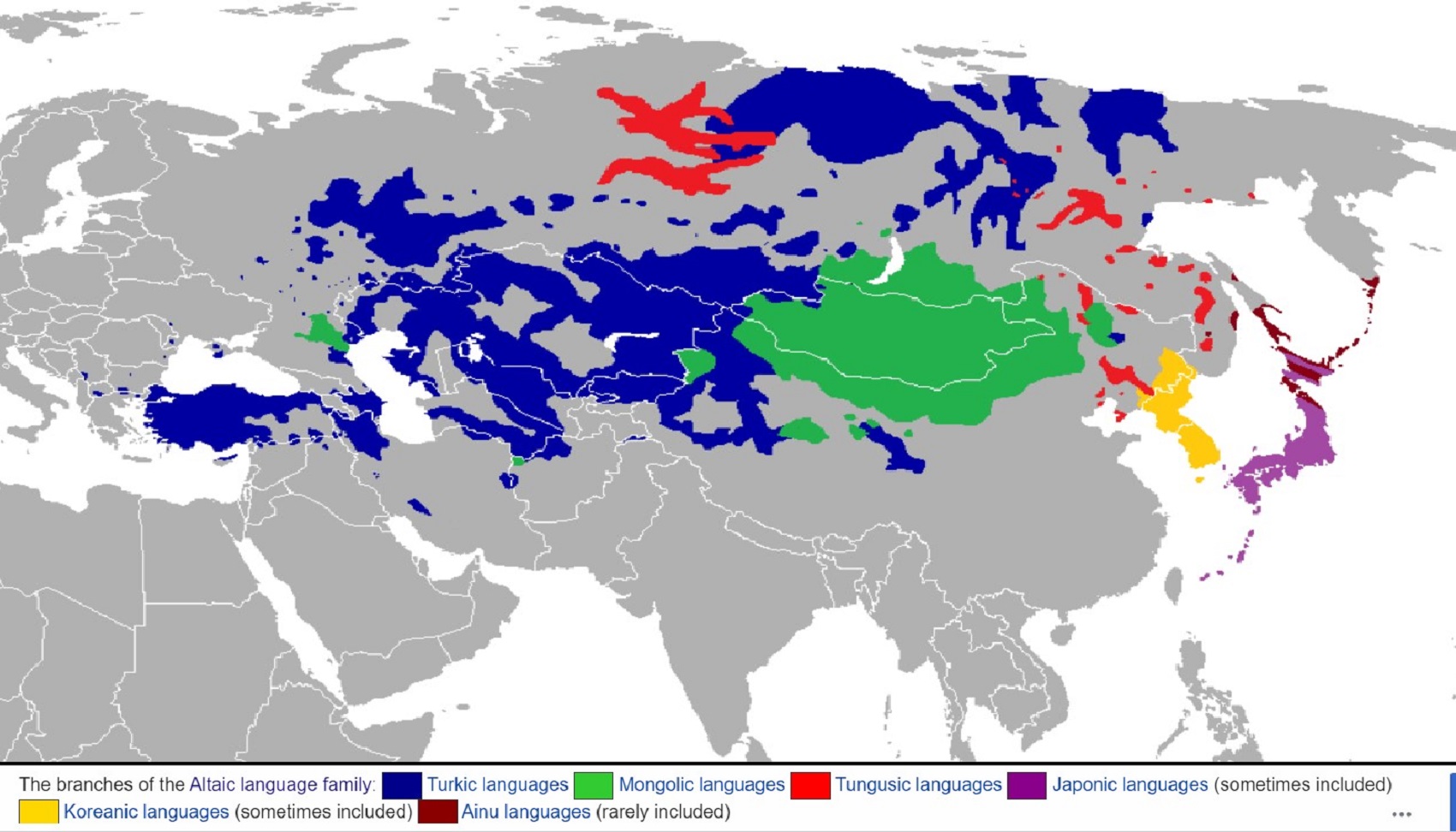
“Altaic (also called Transeurasian) is a proposed language family that would include the Turkic, Mongolic, and Tungusic language families and possibly also the Japonic and Koreanic languages. Speakers of these languages are currently scattered over most of Asia north of 35 °N and in some eastern parts of Europe, extending in longitude from Turkey to Japan. The group is named after the Altai mountain range in the center of Asia.” ref
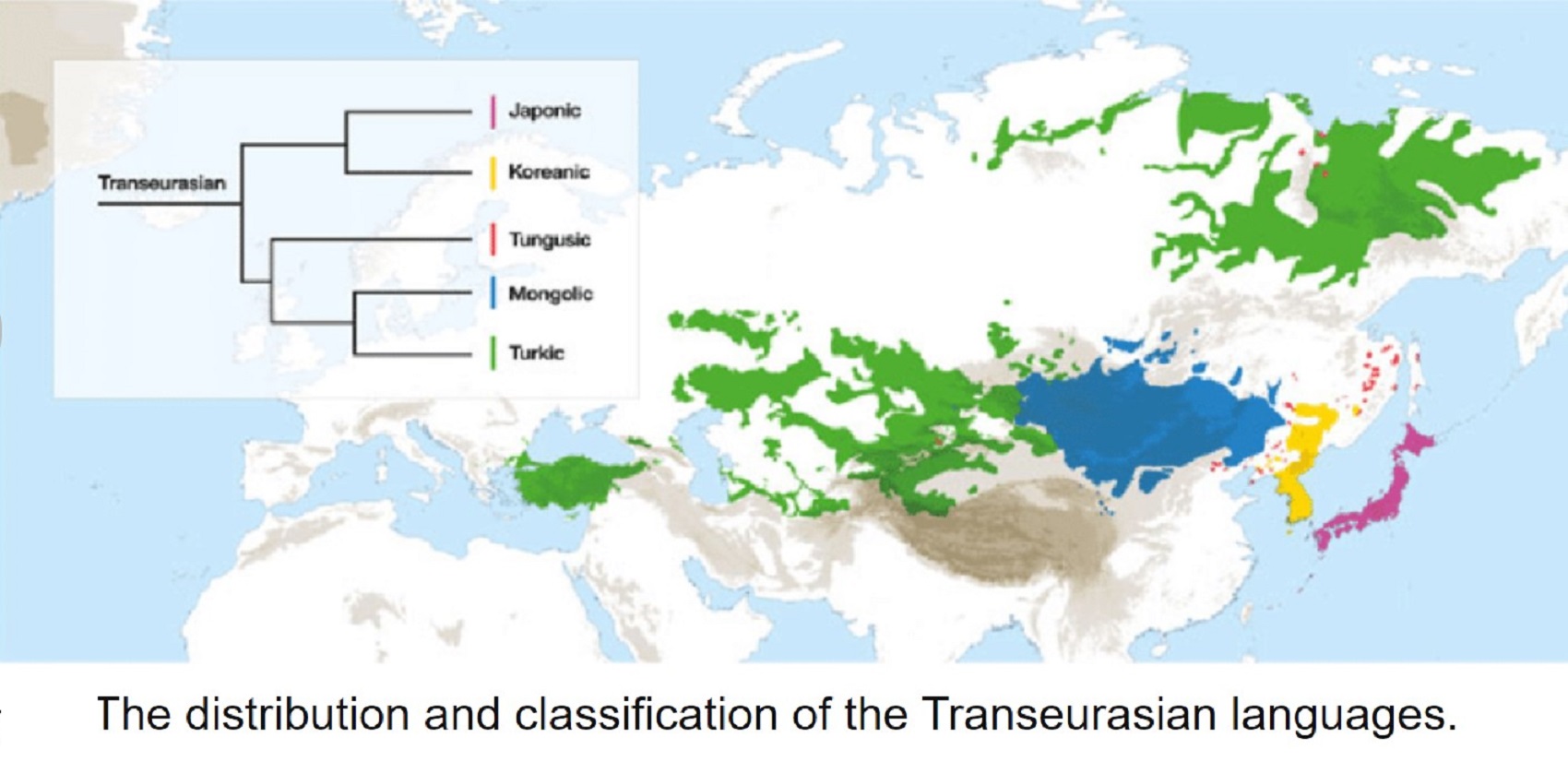
Tracing population movements in ancient East Asia through the linguistics and archaeology of textile production – 2020
Abstract
“Archaeolinguistics, a field which combines language reconstruction and archaeology as a source of information on human prehistory, has much to offer to deepen our understanding of the Neolithic and Bronze Age in Northeast Asia. So far, integrated comparative analyses of words and tools for textile production are completely lacking for the Northeast Asian Neolithic and Bronze Age. To remedy this situation, here we integrate linguistic and archaeological evidence of textile production, with the aim of shedding light on ancient population movements in Northeast China, the Russian Far East, Korea, and Japan. We show that the transition to more sophisticated textile technology in these regions can be associated not only with the adoption of millet agriculture but also with the spread of the languages of the so-called ‘Transeurasian’ family. In this way, our research provides indirect support for the Language/Farming Dispersal Hypothesis, which posits that language expansion from the Neolithic onwards was often associated with agricultural colonization.” ref
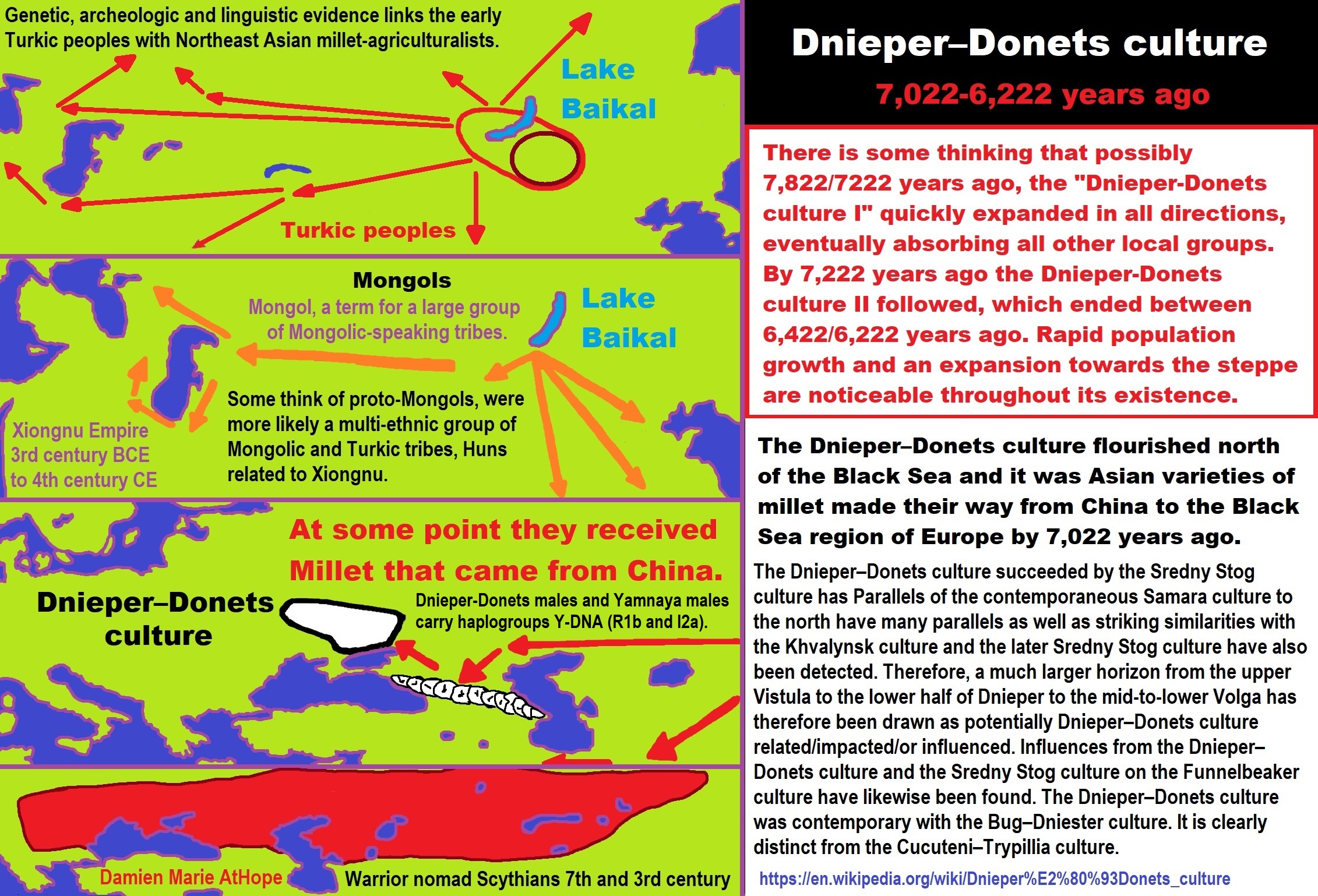
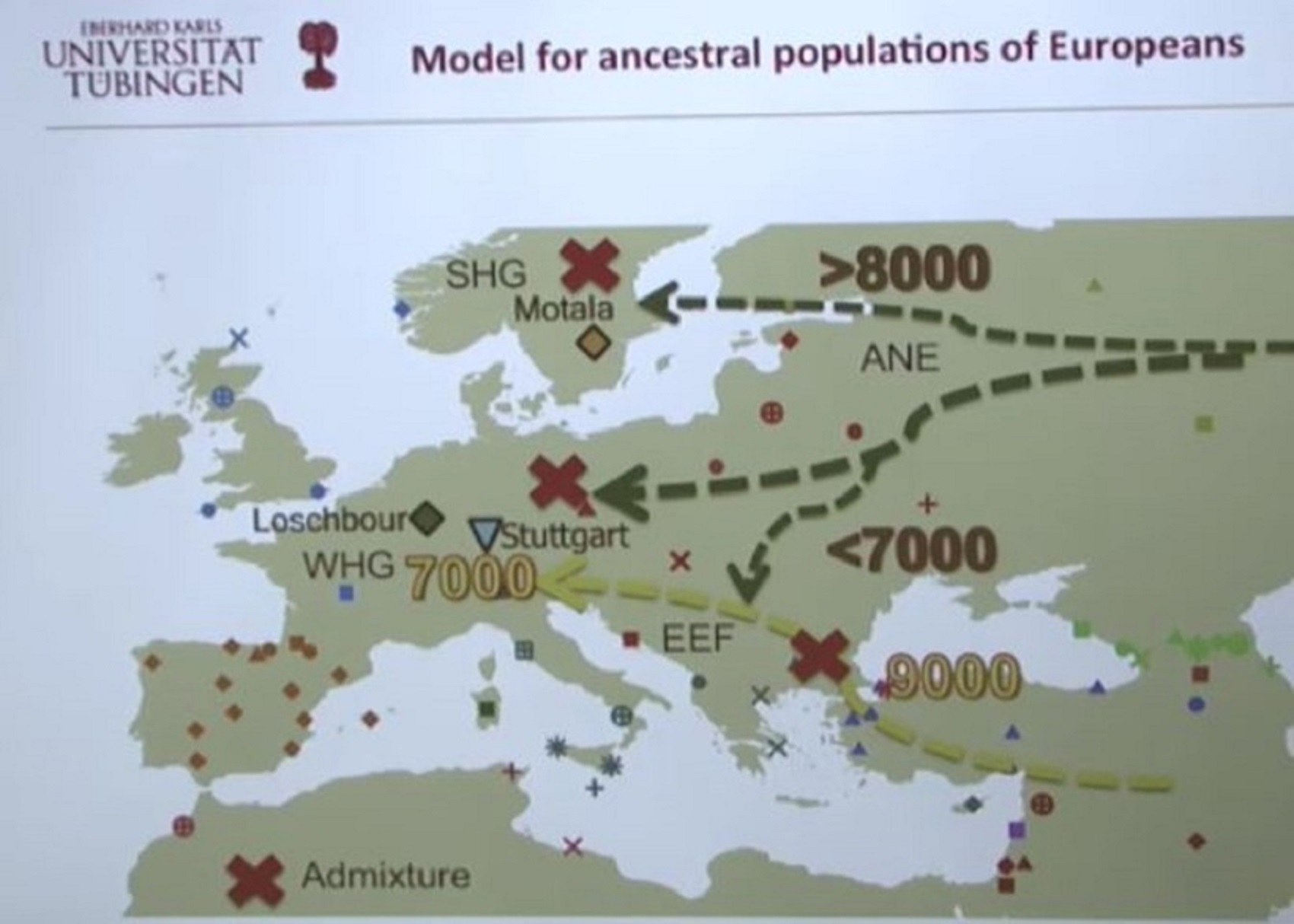
Pic ref
Ancient Human Genomes…Present-Day Europeans – Johannes Krause (Video)
Ancient North Eurasian (ANE)
Eastern Hunter-Gatherer (EHG)
Western Hunter-Gatherers (WHG)
Scandinavian Hunter-Gatherer (SHG)
Early European Farmers (EEF)
A quick look at the Genetic history of Europe
“The most significant recent dispersal of modern humans from Africa gave rise to an undifferentiated “non-African” lineage by some 70,000-50,000 years ago. By about 50–40 ka a basal West Eurasian lineage had emerged, as had a separate East Asian lineage. Both basal East and West Eurasians acquired Neanderthal admixture in Europe and Asia. European early modern humans (EEMH) lineages between 40,000-26,000 years ago (Aurignacian) were still part of a large Western Eurasian “meta-population”, related to Central and Western Asian populations. Divergence into genetically distinct sub-populations within Western Eurasia is a result of increased selection pressure and founder effects during the Last Glacial Maximum (LGM, Gravettian). By the end of the LGM, after 20,000 years ago, A Western European lineage, dubbed West European Hunter-Gatherer (WHG) emerges from the Solutrean refugium during the European Mesolithic. These Mesolithic hunter-gatherer cultures are substantially replaced in the Neolithic Revolution by the arrival of Early European Farmers (EEF) lineages derived from Mesolithic populations of West Asia (Anatolia and the Caucasus). In the European Bronze Age, there were again substantial population replacements in parts of Europe by the intrusion of Ancient North Eurasian (ANE) lineages from the Pontic–Caspian steppes. These Bronze Age population replacements are associated with the Beaker culture archaeologically and with the Indo-European expansion linguistically.” ref
“As a result of the population movements during the Mesolithic to Bronze Age, modern European populations are distinguished by differences in WHG, EEF, and ANE ancestry. Admixture rates varied geographically; in the late Neolithic, WHG ancestry in farmers in Hungary was at around 10%, in Germany around 25%, and in Iberia as high as 50%. The contribution of EEF is more significant in Mediterranean Europe, and declines towards northern and northeastern Europe, where WHG ancestry is stronger; the Sardinians are considered to be the closest European group to the population of the EEF. ANE ancestry is found throughout Europe, with a maximum of about 20% found in Baltic people and Finns. Ethnogenesis of the modern ethnic groups of Europe in the historical period is associated with numerous admixture events, primarily those associated with the Roman, Germanic, Norse, Slavic, Berber, Arab and Turkish expansions. Research into the genetic history of Europe became possible in the second half of the 20th century, but did not yield results with a high resolution before the 1990s. In the 1990s, preliminary results became possible, but they remained mostly limited to studies of mitochondrial and Y-chromosomal lineages. Autosomal DNA became more easily accessible in the 2000s, and since the mid-2010s, results of previously unattainable resolution, many of them based on full-genome analysis of ancient DNA, have been published at an accelerated pace.” ref
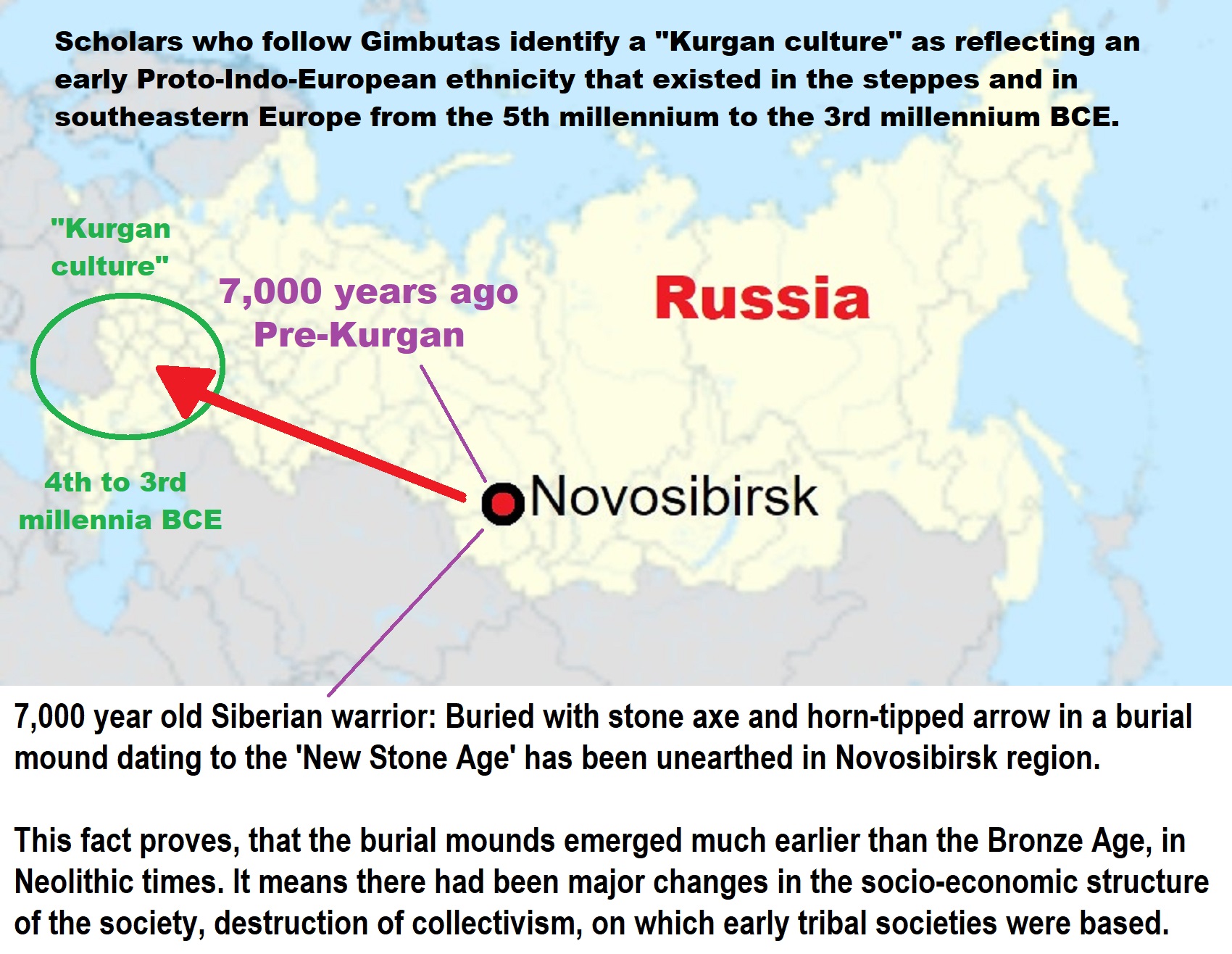
Kurgan Hypothesis
“The Kurgan hypothesis (also known as the Kurgan theory or Kurgan model) or Steppe theory is the most widely accepted proposal to identify the Proto-Indo-European homeland from which the Indo-European languages spread out throughout Europe and parts of Asia. It postulates that the people of a Kurgan culture in the Pontic steppe north of the Black Sea were the most likely speakers of the Proto-Indo-European language (PIE). The term is derived from the Russian kurgan (курга́н), meaning tumulus or burial mound. The Steppe theory was first formulated by Otto Schrader (1883) and V. Gordon Childe (1926), then systematized in the 1950s by Marija Gimbutas, who used the term to group various prehistoric cultures, including the Yamnaya (or Pit Grave) culture and its predecessors. In the 2000s, David Anthony instead used the core Yamnaya culture and its relationship with other cultures as a point of reference.” ref
“Gimbutas defined the Kurgan culture as composed of four successive periods, with the earliest (Kurgan I) including the Samara and Seroglazovo cultures of the Dnieper–Volga region in the Copper Age (early 4th millennium BCE). The people of these cultures were nomadic pastoralists, who, according to the model, by the early 3rd millennium BCE had expanded throughout the Pontic–Caspian steppe and into Eastern Europe. Recent genetics studies have demonstrated that populations bearing specific Y-DNA haplogroups and a distinct genetic signature expanded into Europe and South Asia from the Pontic-Caspian steppe during the third and second millennia BCE. These migrations provide a plausible explanation for the spread of at least some of the Indo-European languages, and suggest that the alternative Anatolian hypothesis, which places the Proto-Indo-European homeland in Neolithic Anatolia, is less likely to be correct.” ref
“Cultures that Gimbutas considered as part of the “Kurgan culture”:
- Bug–Dniester (6th millennium)
- Samara (5th millennium)
- Khvalynsk (5th millennium)
- Dnieper–Donets (5th to 4th millennia)
- Sredny Stog (mid-5th to mid-4th millennia)
- Maikop–Dereivka (mid-4th to mid-3rd millennia)
- Yamnaya (Pit Grave): This is itself a varied cultural horizon, spanning the entire Pontic–Caspian steppe from the mid-4th to the 3rd millennium.
- Usatovo culture (late 4th millennium)” ref
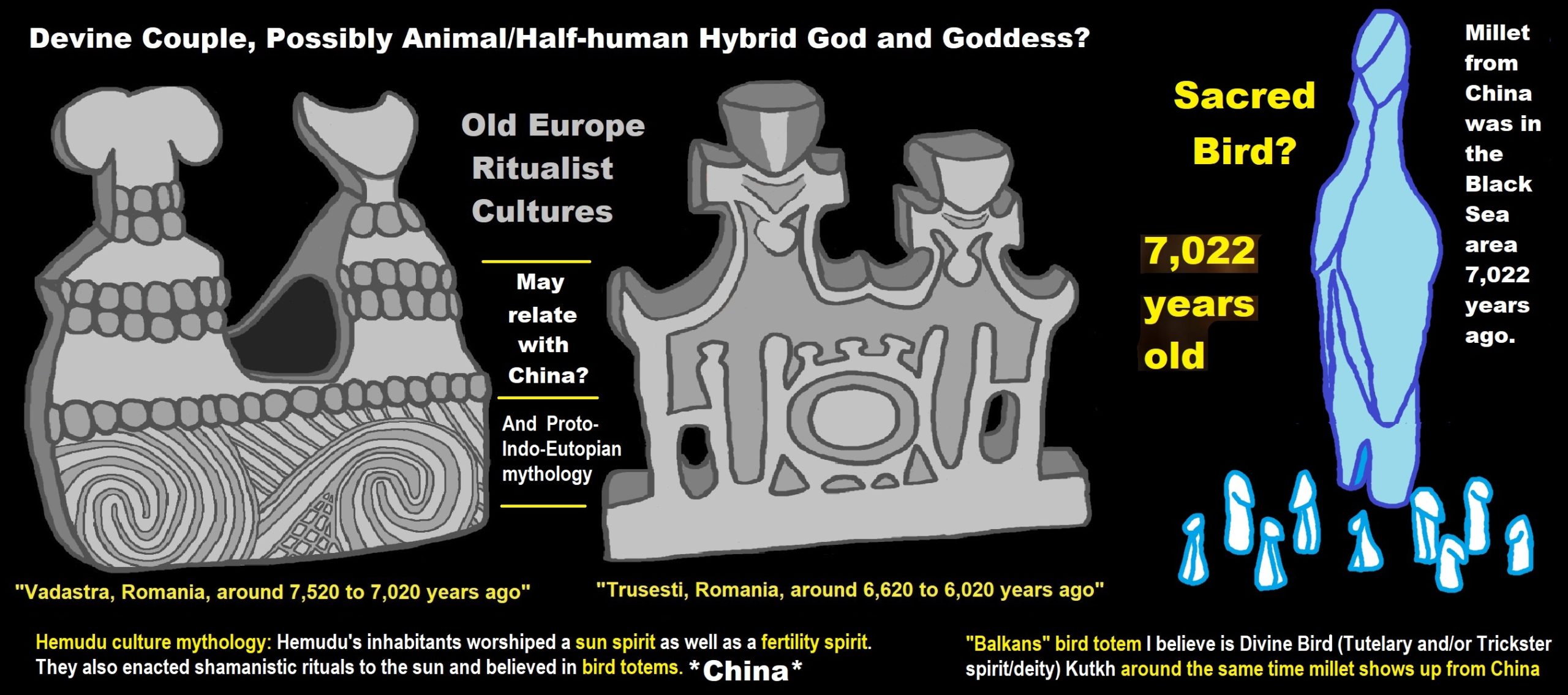
Cucuteni–Trypillia Culture
“The Cucuteni–Trypillia culture (Romanian: Cultura Cucuteni and Ukrainian: Трипільська культура), also known as the Tripolye culture (Russian: Трипольская культура), is a Neolithic–Eneolithic archaeological culture (c. 5500 to 2750 BCE) of Eastern Europe. It extended from the Carpathian Mountains to the Dniester and Dnieper regions, centered on modern-day Moldova and covering substantial parts of western Ukraine and northeastern Romania, encompassing an area of 350,000 km2 (140,000 sq mi), with a diameter of 500 km (300 mi; roughly from Kyiv in the northeast to Brașov in the southwest).” ref
“The majority of Cucuteni–Trypillia settlements consisted of high-density, small settlements (spaced 3 to 4 kilometers apart), concentrated mainly in the Siret, Prut, and Dniester river valleys. During the Middle Trypillia phase (c. 4000 to 3500 BCE), populations belonging to the Cucuteni–Trypillia culture built the largest settlements in Neolithic Europe, some of which contained as many as three thousand structures and were possibly inhabited by 20,000 to 46,000 people.” ref
“One of the most notable aspects of this culture was the periodic destruction of settlements, with each single-habitation site having a lifetime of roughly 60 to 80 years.[7] The purpose of burning these settlements is a subject of debate among scholars; some of the settlements were reconstructed several times on top of earlier habitational levels, preserving the shape and the orientation of the older buildings. One particular location; the Poduri site in Romania, revealed thirteen habitation levels that were constructed on top of each other over many years.” ref
“The Cucuteni–Trypillia culture flourished in the territory of what is now Moldova, northeastern Romania, and parts of Western, Central, and Southern Ukraine. The culture thus extended northeast from the Danube river basin around the Iron Gates to the Black Sea and the Dnieper. It encompassed the central Carpathian Mountains as well as the plains, steppe, and forest steppe on either side of the range. Its historical core lay around the middle to upper Dniester (the Podolian Upland). During the Atlantic and Subboreal climatic periods in which the culture flourished, Europe was at its warmest and moistest since the end of the last Ice Age, creating favorable conditions for agriculture in this region. As of 2003, about 3,000 cultural sites have been identified, ranging from small villages to “vast settlements consisting of hundreds of dwellings surrounded by multiple ditches”.” ref
Periodization
“Traditionally separate schemes of periodization have been used for the Ukrainian Trypillia and Romanian Cucuteni variants of the culture. The Cucuteni scheme, proposed by the German archaeologist Hubert Schmidt in 1932, distinguished three cultures: Pre-Cucuteni, Cucuteni, and Horodiştea–Folteşti; which were further divided into phases (Pre-Cucuteni I–III and Cucuteni A and B). The Ukrainian scheme was first developed by Tatiana Sergeyevna Passek in 1949 and divided the Trypillia culture into three main phases (A, B, and C) with further sub-phases (BI–II and CI–II). Initially based on informal ceramic seriation, both schemes have been extended and revised since first proposed, incorporating new data and formalized mathematical techniques for artifact seriation.” ref
“The Cucuteni–Trypillia culture is commonly divided into an Early, Middle, Late period, with varying smaller sub-divisions marked by changes in settlement and material culture. A key point of contention lies in how these phases correspond to radiocarbon data. The following chart represents this most current interpretation: • Early (Pre-Cucuteni I–III to Cucuteni A–B, Trypillia A to Trypillia BI–II):5800 to 5000 BCE• Middle (Cucuteni B, Trypillia BII to CI–II): 5000 to 3500 BCE• Late (Horodiştea–Folteşti, Trypillia CII): 3500 to 3000 BCE.” ref
Exchange of People, Ideas and Things between Cucuteni-Trypillian Complex and Areas of South-Eastern Poland
Abstract and Figures
“Influences of Cucuteni-Tripolye culture complex on the cultures in Lesser Poland were not intensive. At the turn of 5th and 4th millennia BCE, communities of Lublin-Volhynia culture adopted the laminar oblique retouch to form the long blades made of flint. Later, i.e. in the mid of the 4th millennium BCE, communities of Funnel Beaker culture imitated the production of Tripolyan big rectangular flint axes and the way of ornamentation of ceramic cups using figurines of rams’ heads. At the end of 4th and at the turn of 4th and 3rd millennia BCE Funnel Beaker culture communities in Lesser Poland (Gródek Nadbużny, Zimne, Kamień Łukawski) used to import some painted pottery from Cucuteni-Tripolyan partners.” ref
“A little later ornamentation of some pottery wares with cord imprints was recorded on some settlements of Funnel Beaker culture (Zimne, Majdan Nowy, Tominy) in the way characteristic for Kasperivtsy and Gorodsk groups of the late Tripolye culture. Transfer of Cucuteni-Tripolye ideas into Lesser Poland, what is confirmed by the presence of mentioned above elements of material culture: Tripolyan retouched blades and axes made of flint, imports of painted pottery and ornamentation of pottery with cord imprints, slightly imposed on mentioned cultures in the south-eastern part of Poland, but did not changed their character. Lublin-Volhynia culture communities remained still as a Polgarlike one, and Funnel Beaker culture communities did not change their megalithic face. In the reacher’s opinion, the modern theory of the network society (of Maffesoli and Castells) better explains the presence of Cucuteni-Tripolyan imitations and artifacts in the south-eastern part of Poland in the 4th millennium BCE than some traditional models like diffusion, ethnic migrations, or simply so-called „influences”.” ref
Introduction
“In the forming period of the Trypillia culture, the most important cultural influences came from the area on the lower Danube, the eastern Balkans, and the western coast of the Black Sea. From the BII phase, however, the culture increasingly influenced the Pontic steppe, especially the area between the mouth of the Danube and the Dnieper. Trypillian contacts with the Polgár cultures of the Carpathian Basin and the younger Danubian cultures from Małopolska have frequently been discussed. Polish and Ukrainian archaeology takes much interest in Trypillian relationships with the Funnel Beaker and the Globular Amphorae cultures in the CII phase. Researchers also point out the oldest transmission of cord impressions as a decorative motif on ceramics and of elements of funeral rites, as well as the borrowing of the Thuringian amphora form, crucial for the genesis of the Corded Ware culture, from the environment of late Trypillian groups.” ref
“Contacts between Cucuteni-Trypillian complex and areas of South-Eastern Poland one can consider in frames of five chronological horizons:
1. Malice culture, phase IIa – Trypillia culture, phase BI-BII – 4400/4200-4000 BCE.
2. Malice culture, phase IIb, and Lublin-Volhynia culture, phase II – Trypillia culture, phase BII – 4000-3800 BCE.
3. Lublin-Volhynia culture, phase III and Funnel Beaker culture, phase Gródek I,
Bronocice II – Trypillia culture, phase CI – 3800-3550 BCE (Bilcze Złote, phase Werteba I).
4. Funnel Beaker culture, phase Gródek I, Bronocice III – Trypillia culture, phase CII (early) – 3550-3100 BC (Bilcze Złote, phase Werteba II).
5. Funnel Beaker culture, phase Gródek II, Bronocice IV-V, Baden and Globular Amphorae culture – Trypillia culture, phase CII (late) – 3100-2700 BC (Bilcze Złote, phase Werteba III).” ref
Horizon 1
“The earliest pottery imports from South-Eastern Poland are concentrated in the area of the upper and northern part of the middle Dniester basin, at sites belonging to the Zaleshchiki group of Trypillia culture (Bilshivtsy 1, Viktoriv, Korzhova, Bilcze Złote -Ogród site. They originated in the Malice culture and can be dated mainly to its phase IIa, probably also to the very beginnings of the Lublin-Volhynia culture. The „cooking” ceramics from Bilcze Złote (some of them show Malice culture influences) are predominantly made of well-mixed mass of clay tempered with a large or quite large admixture of crushed mollusk shells. This type of admixture points to a continuation of Eastern European traditions. The ceramics tempered with crushed mollusk.” ref
“Introduction In the forming period of the Trypillia culture, the most important cultural influences came from the area on the lower Danube, the eastern Balkans, and the western coast of the Black Sea. From the BII phase, however, the culture increasingly influenced the Pontic steppe, especially the area between the mouth of the Danube and the Dnieper. Trypillian contacts with the Polgár cultures of the Carpathian Basin and the younger Danubian cultures from Małopolska have frequently been discussed. Polish and Ukrainian archaeology takes much interest and the Globular Amphorae cultures in the CII phase. Researchers also point out the oldest transmission of cord impressions as a decorative motif on ceramics and of elements of funeral rites, as well as the borrowing of the Thuringian amphora form, crucial for the genesis of the Corded Ware culture, from the environment of late Trypillian groups.” ref
“Contacts between Cucuteni-Trypillian complex and areas of South-Eastern Poland one can consider in frames of five chronological horizons. 1. Malice culture, phase IIa – Trypillia culture, phase BI-BII – 4400/4200-4000 BCE. 2. Malice culture, phase IIb, and Lublin-Volhynia culture, phase II – Trypillia culture, phase BII – 4000-3800 BCE. 3. Lublin-Volhynia culture, phase III and Funnel Beaker culture, phase Gródek I, Bronocice II – Trypillia culture, phase CI – 3800-3550 BCE (Bilcze Złote, phase Werteba I). 4. Funnel Beaker culture, phase Gródek I, Bronocice III – Trypillia culture, phase CII (early) – 3550-3100 BCE (Bilcze Złote, phase Werteba II) . 5. Funnel Beaker culture, phase Gródek II, Bronocice IV-V, Baden and Globular Amphorae culture – Trypillia culture, phase CII (late) – 3100-2700 BCE (Bilcze Złote, phase Werteba III). Horizon 1: The earliest pottery imports from South-Eastern Poland are concentrated in the area of the upper and northern part of the middle Dniester basin, at sites belonging to the Zaleshchiki group of Trypillia culture (Bilshivtsy 1, Viktoriv, Korzhova, Bilcze Złote – Ogród site.” ref
“They originated in the Malice culture and can be dated mainly to its phase IIa, probably also to the very beginnings of the Lublin-Volhynia culture. The „cooking” ceramics from Bilcze Złote (some of them show Malice culture influences) are predominantly made of well-mixed mass of clay tempered with a large or quite large admixture of crushed mollusk shells. This type of admixture points to a continuation of Eastern European traditions. The ceramics tempered with crushed mollusk shells make up over 70% of the entire assemblage of the „cooking” ceramics. Interestingly, the „cooking” ceramics tempered with an admixture of crushed pottery and fine sand, but without crushed mollusk shells, predominate distinctly in the modest material recovered from the Ogród site at Bilcze Złote, linked with three oldest settlement horizons (from the BI / BII phases to the early CI phase of Trypillia culture). Afterwards, the ceramics with crushed shells become prevalent. Relationships between formal traits, ornamentation, chronology, and local or – more broadly – Eastern European traditions of preparing the mass of clay at Bilcze Złote are very interesting.” ref
“Among 119 bowls, as many as 63 items (almost 53% of the group) do not contain any admixture of crushed mollusk shells. This refers particularly to three- or two-part bowls, sometimes having a slightly sharper profile. These forms, dated to the oldest horizon of settlement at the Ogród site, are linked with the Ogród I ceramic assemblage at Bilcze Złote, attributed to the Zaleshchiki group from the turn of the BI and BII phases of the Trypillia culture. In earlier interpretations, this group of vessels had its models in assemblages attributed to the II phase of the Malice culture). At present, it seems that the inspiration came from the environment of the Kodžadermen-Gumelniţa-Karanovo VI cultural complex and from cultures around the Danube Delta. Influences from the Malice culture, however, cannot be ruled out completely. In its late (II) phase, the culture spread also to Volhynia; its single sites have been found in the upper Dniester basin, as well. Perhaps some of these vessels, difficult to point out, should be treated as western „imports” in the Trypillian environment.” ref
“The presence of similar bowls in successive horizons of settlement at the Ogród and the Werteba sites in Bilcze Złote, thus at an increasing temporal distance from the Malice culture, may mean that the period of „imports” and imitations was followed by the period of adaptations and creative development of that group of ceramics in the Trypillian environment. This seems to be confirmed by the wealth of bowl forms and by the accepted mode of their production based on technology typical of the Trypillia culture, i.e. with shells tempering the mass of clay. This local development should undoubtedly be linked with the horizon defined by the chronology of the Ogród III assemblage, i.e. the early CI phase of the Trypillia culture at the latest.
Horizon 2
Later Danubian imports from South-Eastern Poland (within stages BI-BII of the Trypillia culture) are connected with some influences of phase II of the Lublin-Volhynia-culture. They are present both at the settlements of the Western basin of the Boh river (Sokiltsy-Polizhok V, Klishchiv), as well as on the territory between the Boh and the Dnieper rivers (Krasnostavka, Veseliy Kut). M. Videiko recorded a lot of Polgár elements on many areas of Trypillia culture, including the Dniester, Southern Bug, Middle Dnieper regions.” ref
“Some of these influences penetrated into mentioned territories through the Lublin-Volhynia culture. To real imports from the Lublin-Volhynia culture at Bilcze Złote belongs a cup ornamented with white paint. It should probably be linked with the Ogród II ceramic assemblage (Mereshovka group of Trypillia culture). Among „serving vessels” in the Werteba I ceramic assemblage at Bilcze Złote, one may distinguish a group of thin-walled vessels made of adobe clay, often tempered with crushed pottery (nearly a hundred items, i.e. almost 4% of the whole assemblage). The vessels are usually undecorated, sometimes with small handles pierced horizontally. Most fragments of large and medium forms have the proportions of half-barrel-shaped vessels or vases. Since there are few handles preserved in this class, most of the vessels probably had no handles. Semispherical bowls come second as regards their number in the group; fragments of vessels with high, smooth cylindrical necks are even less frequent. Fragments of egg-shaped vessels have handles below the rim. Bowls shaped like three-fourths of a sphere and semispherical bowls also belong to the group of handled forms. On two items, handles are arranged in a chequered pattern: on a semispherical bowl, in two zones; on a half-barrel-shaped vessel, in three zones. Fragments of other vessels with handles below the rim are ornamented with monochromatic or bicolored diagonal stripes and a bicolored arc.” ref
“These forms may be viewed as „imports” or rather, as imitations of vessels produced in the late phase of the Lublin-Volhynia culture (numerous half-barrel-shaped vessels) and the Bodrogkeresztúr culture (handled vessels). „Imports” and influences of the Bodrogkeresztúr culture and other cultural centers point to the development of contacts with the Carpathian Basin and loess uplands of Małopolska and Volhynia in the late phase of the Shipentsy group of the Trypillia culture. The great number of those „imports” and influences shows that the contacts were intensive and multidirectional. The half-barrel-shaped vessel at Bilcze Złote is definitely a form of Central European origin. Each of the six preserved items of that type was made without the shell admixture in the mass of clay. Those vessels were mainly related to the Lublin-Volhynia culture as its most important group of ceramics, with variants produced in all its phases. In the Lublin-Volhynia culture flint industry was exclusively oriented towards the production of blade blanks (including microlithic ones).” ref
“In this culture, an interregional role of Volhynian raw materials is evident, particularly for fulfilling non-utilitarian functions arising from developing social relations. One of the basic techniques of tool production was oblique covering parallel retouching. It was used to shape basically all retouched blades and triangular points, but also a large part of truncated pieces, scrapers, and even some perforators. This kind of retouch was borrowed from the North-Western groups of the Trypillia culture. Probably the tendency to produce the longest possible flint blades was also influenced by this culture.” ref
Horizon 3
The interaction between the Lublin-Volhynia in its late (III) phase of and Trypillia cultures in its CI phase was continued. Late Danubian pottery features were absorbed by Trypillian communities. On the other hand, some Trypillian flint industry features were adopted by Lublin-Volhynia culture groups. At the same time, contacts between the oldest (pre-classic) phase of the Funnel Beaker and Trypillia culture are confirmed. Groups of the Funnel Beaker population colonized for the first time a borderland between two cultures (Korytyny, Grodzisko III site on the upper Dniester river). On the other hand, pottery features of the Funnel Beaker culture are recorded in assemblages of Chapaevka, Kolomishchina, and Lukashi groups in the Middle Dnieper Region of Trypillia culture.
Horizon 4
“In the 2nd part of IV millennium BCE populations of Funnel Beaker culture expanded into the East and settled areas to the Gniła Lipa and Bystrzyca Sołotwińska rivers, tributaries of the Upper Dniester. The Funnel Beaker culture settlers meet East of these rivers groups of Trypillia culture inhabitants (Koshilivtsy group) from the older stage of its CII phase. As a result of it, a mixed settlement zone was created in the Upper Dniester basin. In Volhynia compact settlement zone of Funnel Beaker culture reached Styr river. However, single settlement points of this culture were found also more to the East, i.e. in the neighborhood of Ostrog town. On Novomalin-Podobanka site materials of classic Funnel Beaker culture together with Trypillian ones (from the beginnings of phase CII) were recorded. Close contacts with Trypillian world was mirrored in numerous Funnel Beaker-like pottery elements on the vast territories between the upper Dniester, Volhynia ad Dnieper. At the same time, communities of Trypillia culture settled more intensely middle and eastern part of Volhynia.” ref
“Imports of painted Trypillian (Koshilivtsy and Bryndzeny groups) pottery were discovered on the Polish-Ukrainian borderland in Gródek Nadbużny, Zimno and Male Gribovichi and even more to the West of Vistula river at Kamień Łukawski, Bronocice, and even in Kuyavia. The appearance of ram’s heads, so characteristic ornament of some pottery vessels in the South-Eastern group of the Funnel Beaker culture, might be an effect of Trypillian culture influences. However the most dominant were Trypillian influences on the Funnel Beaker culture flint industry. Long blades and large axes were produced due to their symbolic meanings rather than functional requirements. Probably they served as prestige objects.” ref
“This production involved a multi-level system of specialization, apparent on various levels (of regions, settlements, and individual homes). A leading supra-regional role was played by Świeciechów and striped raw materials, which deposits are located in the Holy Cross Mountains. Different tools were made of these flints. Large tetrahedral axes from Świeciechów flint were produced imitating Trypillian patterns. There were also differences in access to their deposits and processing organization. The same one can say about their distribution systems. In Volhynia, imported assemblages of Świeciechów and striped tools differ in quantities of imported artifacts and regards to the kinds of implements and raw materials used to make them. Only finished tools were being distributed from the Holy Cross Mountains production centers. They circulated as a part of an exchange system of prestige goods.” ref
“The flint industry of the Funnel Beaker culture communities in Małopolska (fig. 9, 10), especially production of blades, axes and triangular arrowheads was more related to the Trypillia culture than to the other Funnel Beaker culture groups. The key to understanding the evolution of flint processing in Małopolska leading up to the emergence of the industry of south-eastern Funnel Beaker culture group is the evolution of the flint industry of the Trypillia culture. Strong Trypillian influences on Funnel Beaker culture flint industry are also visible on Polish Lowlands.” ref
Horizon 5
“The turn of 4th and 3rd and beginnings of 3rd millennium BCE was the scene of a particular intensification of contacts between different cultures in Europe. This period was defined as the crisis of Neolithic societies. There are several indications of possible direct contacts of Baden communities from Slovakia with the area between the Prut and Dnieper rivers, which was inhabited by local groups of the Tripolye culture of phase CII. Many traditions and imports of the Baden Culture can be observed at Horodiștea-Erbiceni sites. This culture group transmitted directly Baden traditions to the East of the Carpathians.” ref
“Gordinești (closely connected with Horodiștea-Erbiceni group) and Kasperivtsy groups display features of the Baden Culture in its pottery stylistics too. Elements of Gordinești group are present on many sites of Troyaniv-Gorodsk group. The Sofievka group evolved under the direct influence of the Gordinești and Troyaniv-Gorodsk groups and indirectly of the Baden-Kostolac-Coţofeni and Cernavoda II culture. The lower and middle Danube was one of the most important axes of intense contacts, transfer of things and ideas, and human migration. From the West to the East moved cultural elements of the Baden culture and its related cultural units. In the opposite direction moved groups of Yamna culture. Baden elements, especially in form of Funnel Beaker-badenized assemblages, reached at the same time the central part of Volhynia. They moved to the East directly from Małopolska Uplands. The whole settlement agglomeration of such assemblages was lately discovered in the upper Styr river basin in the neighborhood of Ostrog town.” ref
“Similar pottery materials were discovered also at Korytyny, Grodzisko III site, located on the bank of the upper Dniester river. In addition to migrations from the East to the West and from the West to the East it took place the transmission of people, things, and ideas from the South to the North and vice versa. In addition to the late Funnel Beaker culture assemblages with Baden elements in South-Eastern Poland there are also sites of this culture with cord decorated pottery. On two sites: Majdan Nowy and Tominy, site 12 cord ornamentation was accompanied by vessls with their rims obliquely cut off inwards. Similar elements are recorded in the Kasperivtsy and Gorodsk group of the Trypillia culture. They can be dated to the first centuries of the 3rd millennium BCE. As regards direct sources of inspiration for the use of ‘cord’ ornamentation, they are to be found in the late groups of the Trypillia culture, chiefly Kasperivtsy and Gorodsk groups. Jointly occurring in them, specifically, in the former, lips with their rims obliquely cut off inwards and cord ornamentation are recorded in Majdan Nowy and Tominy, site 12.” ref
“The origin of the former trait have their roots in Anatolia and the eastern Balkans (culture complexes Sitagroi Va – Radomir I-II – Yunacite XIII-IX traditions), while the latter trait – cord ornaments – comes from Pontic steppes. The two traits may have merged in the late groups of the Trypillia culture at the mouth of the Danube. The best example of the move from the north (eastern part of Poland) to the south (the Danube Delta) was great migration of Globular Amphorae culture communities. There are numerous Globular Amphorae culture traits in the assemblages of the late Trypillia culture pottery. Groups of people of Globular Amaphorae culture, returning from the south on Sandomierz Upland in south-eastern Poland, brought with them a new form of pottery, so-called Thuringian amphora, borrowed from the Usatovo group. The time of it could be dated to the period between 2900-2700 BCE. This resulted in the origins of the Złota culture. Złota Culture can be interpreted as a stylistically distinct, intermediate stage between the Globular Amphorae culture and Corded Ware culture, which was not occurring on the other territories.” ref
“This local phenomenon was a part of the broader processes which took place mainly in south-eastern Europe (the eastern Balkans, Ukraine and Moldova), resulting in a profound civilizational change, i.e. the creation of the great cultural complex of Corded Ware culture. Conclusions In the second half of the 5th millennium BCE (horizon 1), communities of the Tripolye culture, phases BI-BII, had contacts with the population of the late (IIa) phase of the Malice culture. The areas settled by both cultural complexes were located at a great distance from each other. The communities of the Tripolye culture adopted selected features of Malice ceramic production. This seems to have resulted from marital exchange: on a moderate scale, Tripolye men sought out their wives in the area of the Malice culture and, according to patrilocal marriage customs, the women then moved to the Tripolye settlements, sporadically transferring ready-made ceramic products, so-called imports, to the Tripolye culture. Thus, the wives were responsible for the considerably more numerous imitations of the Malice ceramics and the long-lasting, though selective, traditions of Malice pottery passed down in their new environment.” ref
“The patrilocal marriage customs involving the Malice women and the Tripolye men (never the other way round), and the fact that pottery was women’s domain, led to the unidirectional transfer of vessels, technology, and norms of ceramic production from the Malice culture to the Tripolye culture. The turn of the 5th and the 4th millennia and the early 4th millennium BC (horizon 2) witnessed the deepening interaction between the populations of the youngest (IIb) phase of the Malice culture and the classic (II) phase of the Lublin-Volhynia culture on the one hand and the communities of phase BII of the Tripolye culture on the other. The Danube and the Tripolye settlement complexes came into contact on the upper Dniester and between the Styr and the Horyn rivers in Volhynia. This helped to continue the previous forms of marital exchange, which resulted in the further popularisation of the ceramics and the traditions of ceramic production typical of the Danube cultures, i.e. the Malice and the Lublin-Volhynia cultures, and also the Polgár culture, in the areas settled by the Tripolye cultural complex. As the civilizational norms of the Eneolithic (Copper) Age became widespread in that period, the forms of interaction described above acquired new elements.” ref
“The deepening internal diversification of the early Eneolithic communities of the Lublin-Volhynia culture led to a growing demand for prestige objects, which was met with import or imitation of copper artifacts, mainly those from the Carpathian Basin, and with flint tools produced from long blades. That type of flint production depended largely on new technologies derived from the Tripolye culture, as proven by such borrowings as trough-like retouch or the very idea and technology for the production of long flint blades in the Lublin-Volhynia culture. It seems that the influx of Tripolye settlers into flint-bearing areas in Volhynia and on the upper Dniester, adjacent to the settlement centers of the late phase of the Malice culture and the Lublin-Volhynia culture, created sufficient conditions for the expanding influence of the Tripolye flint working on the communities of the Eneolithic Lublin-Volhynia culture. In the mid-4th millennium BCE (horizon 3), those forms of interaction between the Danube communities (the late phase of the Lublin-Volhynian culture) and the Tripolye communities (phase CI) (fig. 3) were continued.” ref
“Elements of the Danube pottery still grew in popularity in the Tripolye population, while selected features of the Tripolye flint working were adopted by the Lublin-Volhynia culture. In that period, the population of the Funnel Beaker culture of the pre-classic and early classic phases (the beginnings of Gródek 1 and Bronocice III), until then absent from those areas, quite quickly drove out and replaced the Danube population in western Volhynia and the upper Dniester basin. This caused significant changes in the forms and intensity of the intercultural interaction, which became fully apparent already in the 2nd half of the 4th millennium BC. In the following period (horizon 4), the population of the classic phase of the Funnel Beaker culture (Gródek 1, Bronocice III) settled more and more intensively the upper Dniester basin, up to the Hnyla Lypa river, and western Volhynia, up to the Styr river.” ref
“East of those rivers, the Funnel Beaker settlers created considerable areas where they mixed with settlers from early phase CII of the Tripolye culture. Their coexistence, lasting there for many generations, resulted in deepening the interactions between members of both cultural complexes and in developing entirely new forms of relationships. This is shown by imports and imitations of the Tripolye painted ceramics at Funnel Beaker sites located not only at the eastern edge of that culture (e.g. Gródek Nadbużny, Zimno), but also in the Sandomierz-Opatów Upland (e.g. Kamień Łukawski), the Western Małopolska Upland (e.g. Bronocice) and Kuyavia, and by contemporaneous imitations of the Funnel Beaker ceramics documented in large areas of the Tripolye culture. The higher level of the interaction resulted e.g. in specialized workshops near Sandomierz which produced prestige flint axes modeled on the Tripolye tools, meeting the demand of communities inhabiting vast areas of present-day Poland.” ref
“It seems that the production was possible only with the participation of specialists from the Tripolye culture, and that complying with the high technological standards needed in that work required long apprenticeship with a master; mere observation of the technological process or attempted imitation based only on the analysis of ready-made axes would not have been sufficient. The strong influence of the Tripolye culture on the flint working in the Funnel Beaker culture in Małopolska and western Ukraine, together with the maximization of the length of the produced blades, indicate that the flint working had more in common with the Tripolye traditions than with the standards of production of flint tools in the other areas of the Funnel Beaker culture. The intensifying interaction between the communities of the Funnel Beaker culture and the Tripolye culture, early phase CII, in the 2nd half of the 4th millennium BC (horizon 4) was an introduction to, and perhaps a condition for, even more frequent contacts in the next period, the first centuries of the 3rd millennium BC (horizon 5).” ref
“In that case, the interaction was mainly triggered by multidirectional migrations of larger human groups, involving a significant part of the population of all cultures from the areas discussed here. The Tripolye communities of younger phase CII settled Volhynia, its eastern areas in particular, from the south and the south-east, while groups representing the younger phases of the Funnel Beaker culture (Gródek 2), often with Baden features (Bronocice IV and V), moved increasingly into the western part of that region. The Yamna communities expanded along the lower and central Danube to the west, whereas the populations of the late phase of the Baden culture took the opposite direction, reaching as far as Kiev in the north-east, and contributed to the cultural character of the Sofievka group.” ref
“The communities of the Globular Amphora culture migrated from the north-west, from eastern Poland, towards the Danube Delta and as far as the Dnieper in the east, while the multicultural population from the areas around the mouth of the Danube moved in the opposite direction, carrying with them cultural elements from Thrace, or even from Anatolia. Some of them returned to the starting point (to south-eastern Poland), bringing with them a new form of pottery, so-called Thuringian amphora, borrowed from the late Trypillian Usatovo group. This resulted in origins of the Złota culture, a cultural phenomenon that gave beginnings to the oldest Corded Ware culture. Inventories of both cultures contained the already mentioned Thuringian amphorae.” ref
“The events described above-formed part of the broader processes which took place mainly in south-eastern Europe (the eastern Balkans, Ukraine and Moldova), resulting in the so-called crisis of the early farming communities and in a profound civilizational change. The cultures that had developed there until then were superseded by the mobile communities of three large cultural complexes: the Yamnaya, the Corded Ware, and the Bell Beaker cultures.” ref
Comprehensive Site Chronology and Ancient Mitochondrial DNAAnalysis from Verteba Cave – a Trypillian Culture Site of Eneolithic Ukraine
ABSTRACT
“This manuscript presents a study of a ritual site of the Trypillian culture complex (TC) in western Ukraine where material artifacts are found side-by-side with human and animal remains. The organic content in pottery sherds made it possible to carbon date the ceramics found with bone remains, thus allowing a reference point for carbon dating bone collagen. This allowed us to develop a comprehensive chronology of the usage of the cave. Mitochondrial DNA (mtDNA) extracted from human remains shed additional light on the history of the site’s occupation by early agrarians on the territory of Ukraine.” ref
Introduction
“Farming in Europe spread from western Anatolia after 7000 BCE. The European Neolithic initially developed in Greece, from where it expanded northward into the Balkans, and westward along the Mediterranean coast. After 6000 BCE Neolithic cultures of the Danube basin, such as Starčevo-Körös-Kriş and the Linear Pottery culture (Linearbandkeramik or LBK) began to appear east of the Carpathian Mountains. On the foundations laid by these and other Neolithic groups, a new archaeological culture began to form in the pre-Carpathian region around 5400 BCE. This culture became known as Precucuteni, and later as Cucuteni in Romania and Moldova, and Trypillia A (formally spelled “Trypolie” or “Tripolye”) followed by Trypillia B and C, in Ukraine. The Trypillian cultural complex (TC) existed from 5400 to 2700 BCE on a vast area extending from the Carpathian piedmont, east to the Dnipro River, and south to the shores of the Black Sea.” ref
“As an archaeological culture, TC was discovered in 1896 by V. Khvoika near the village Trypillia, Ukraine. TC is characterized by advanced agriculture, developed metallurgy, pottery-making, sophisticated architecture, and social organization, including the first proto-cities on European soil. TC occupies a prominent place in Eastern European archaeology but still remains largely unknown to the Western science. The new TC chronology identifies the following brackets for each TC phase: AII-III-3 from 5400–4300 BCE, BI from 4300–4100 BCE, BII from 4100–3600 BCE, CI from 3600–3200 BCE, and CII from 3400–2750 BCE. More than 40 local archaeological groups are recognized within the TC complex, with the region- and group-specific variations in the styles of pottery and plastics, in many cases infuenced by contemporaneous neighboring cultures. At the material culture level, TC is known for a variety of painted pottery as well as anthropomorphic and zoomorphic clay figurines. While the material culture of TC has been well studied and documented, human remains are scarce. In fact, they are virtually non-existent until the CII phase, when burials of TC begin to appear on a regular basis. This creates a gap in our understanding of the biological origins of TC and in their cultural traditions, such as rituals for the dead.” ref
Trypillia Megasites in Context: Independent Urban Development in Chalcolithic Eastern Europe
Abstract
“The Trypillia megasites of the Ukrainian forest steppe formed the largest fourth-millennium bc sites in Eurasia and possibly the world. Discovered in the 1960s, the megasites have so far resisted all attempts at an understanding of their social structure and dynamics. Multi-disciplinary investigations of the Nebelivka megasite by an Anglo-Ukrainian research project brought a focus on three research questions: (1) what was the essence of megasite lifeways? (2) can we call the megasites early cities? and (3) what were their origins? The first question is approached through a summary of Project findings on Nebelivka and the subsequent modelling of three different scenarios for what transpired to be a different kind of site from our expectations. The second question uses a relational approach to urbanism to show that megasites were so different from other coeval settlements that they could justifiably be termed ‘cities’. The third question turns to the origins of sites that were indeed larger and earlier than the supposed first cities of Mesopotamia and whose development indicates that there were at least two pathways to early urbanism in Eurasia.” ref
Introduction
‘The concept of “city” is notoriously hard to define.‘ This is the opening statement of Childe’s seminal article ‘The urban revolution’. Almost 70 years later, this task has become even harder, with urbanism attested in a far wider range of environments, cultural trajectories, and material forms than were known to Childe. Yet in western Asia and Europe, the traditional supremacy of Uruk urbanism—earlier than the first European city by two millennia—has remained intact and untroubled by global difference. While Minoan statehood may be dated to 2400 BCE, the Late Minoan city of Knossos—at 100 ha the largest settlement on Crete—dates to the mid-second millennium bc, showing that states may have developed without cities. Later still, classic examples of European cities co-emerged with states in the first millennium BCE in Greece, Etruria, and Rome, while large, low-density, temperate European Iron Age oppida have an ambiguous relationship to urbanism. This narrative enshrines the powerful tradition of equating urbanism with political and economic centralization, which this reacher disputes.” ref
“The second, empirical problem with this narrative is its exclusion of the largest sites in fourth-millennium bc Eurasia, if not the world—the Trypillia Chalcolithic megasites of the Ukrainian forest-steppe—and this despite a vigorous discussion of urban and non-urban status conducted largely in Russian and Ukrainian since the 1970s (Korvin-Piotrovskiy 2003; Masson 1990; Shmaglij 2001; summarized in Supplementary Materials 1, online). Ignoring Fletcher’s (1995) recognition of megasites as the only exception to his global rule of settlement constraints, most authors even today consider megasites as ‘large villages’ (see chapters in Müller et al. 2016b), with none of the core traits of Childean urbanism and no urban legacy (for an exception, see Wengrow 2015). However, advancing a relational approach rather than a Childean check-list compilation provides a new perspective on the urban debate.” ref
“In this article, we use the results of an AHRC-funded research project to investigate the question of European urbanism on the North Pontic forest-steppe through the multi-disciplinary study of a single Trypillia megasite—Nebelivka (Novoarhangelsk region, Kirovograd County)—in its wider landscape and cultural context. The Trypillia–Cucuteni network (Russian Tripolye; hereafter ‘CT’) covers over two millennia and three modern states—Romania, Moldova, and Ukraine. Unlike the Cucuteni part of the CT network, found in eastern Romania and Moldova, and which displayed a strong tendency to settlement dispersion in the late fifth millennium BCE, the Trypillia part contained megasites defined as settlements of 100 ha or larger from 4100 to 3400 BCE.” ref
“There are three research questions which are of primary concern: origins, megasite lifeways, and urban status. We address these questions in a different order,2 since consideration of both urban status and megasite origins must be grounded in an interpretation of megasite lifeways that is radically different from the standard view of megasites as long-term permanently occupied settlements with tens of thousands of residents living in thousands of coevally used houses at the same time.” ref
“The first question focuses on megasite lifeways—the essence of what a megasite was and how it came to function in a large-scale landscape. It is here that the most dramatic changes in interpretation have emerged in the last decade. The traditional narrative has relied on the planned layout of megasites and the large number of solid, permanent houses, which in most accounts were coevally occupied, as proxies for long-term all-year-round occupation for thousands of people. Our research has managed to deconstruct this approach, leading to the modeling of three different scenarios for Nebelivka. While the social underpinning of two of the models rests on the seasonal patterning of social life, the third model relies on a broadly heterarchical social pact supporting permanent dwelling.” ref
“The second question confronts the urban status of Trypillia megasites, using a relational approach in which lifeways on a typical, small Trypillia site are compared and contrasted with what would have happened on a megasite. The results show that there is a strong case for calling Trypillia megasites ‘cities’ in their forest steppe context. The origins of the Trypillia megasites have been regularly discussed over the last 30 years, with the military/strategic response to internal and/or external threat generally being considered adequate to explain this settlement hyper-nucleation. Our approach takes a different starting-point of how Trypillia communities used to living in settlements of 20–40 ha could have imagined the possibility of creating a site 10 to 20 times as large. But before we turn to the research questions, it is important to gain some perspectives on how we conceptualized megasites and developed a feel for the contexts in which megasite archaeology has developed.” ref
Conceptualizing/contextualizing megasites
“Studying megasites and Balkan Neolithic tells may be mapped onto the difference between the Orient Express and a commuter train from Bushey to Euston: it is hard to comprehend the vastness of the former, while not denying the intrinsic interest of the latter. It is not only the megasites that are vast—it is also their landscapes and the time-space dimensions of the CT network. The rolling forest steppe-covered loess landscapes carry on for thousands of kilometers, while, at a local level, a single Soviet-era field in central Ukraine can be larger than an entire English parish. Moreover, the CT network lasted longer and covered a wider area than any other central and eastern European network—from 5000 to 2800 BCE and more than 250,000 sq. km. By comparison, the Vădastra network in modern Romania lasted 200 years and covered 6000 sq. km, while the Veselinovo network in Bulgaria lasted 300 years and covered 60,000 sq. km. Ukrainian specialists have claimed the existence of more than 60 local ‘groups’ within the Trypillia network alone. The scale of these phenomena is not only theoretically challenging but also poses many methodological problems of how to investigate such sites/landscapes/cultural groups (Table 1).” ref
“The first question of scale concerns the way that clearly similar though the varying material culture was replicated over such distances and reproduced over 80+ generations. Reachers found the concept of the ‘Big Other’ stimulating in this respect. Alongside and ‘above’ the daily household practices which characterized the habitus—what Bloch has termed ‘transactional social practice’— the Big Other played an overarching, integrative role as a virtual symbolic order (in Bloch’s terms, a ‘transcendental entity’) that existed only through its subjects believing in it—something which was sufficiently general and significant to attract the support of most members of society but, at the same time, sufficiently ambiguous to allow the kinds of localized alternative interpretations (‘transactional practices’, according to Bloch) that avoid constant schismatic behavior.” ref
“These localized interpretations became materialized in three principal forms which were all central to CT cultural identity: different types of painted pottery, different kinds of figurines and houses of different shapes and sizes. All three forms were concentrated in the domestic domain, where the mortuary domain and hoarding practices were virtually invisible.4 While for typological ‘splitters’, the variability in these three forms permitted the etic differentiation of over 60 local groups, a CT person would have emically recognized a vessel as ‘theirs’ in a pottery assemblage from a settlement 800 km away from their home. Diachronic studies of CT figurine usage shows continuity in discard practices over the entire CT timespan. The Big Other was fundamental in the growth and expansion of the CT network, transcending face-to-face contact and local social networks to enable continuities of practice and identities across vast distances. But the Big Other leads us to an important question concerning the role of imagination in the CT network.” ref
“In Imagined Communities, Anderson’s influential study of the anomaly of modern nationalism, the author reminds us that all communities larger than a single village were ‘imagined communities’, because separate communities have, by definition, never lived together with a second group. Bloch has recently expanded the use of the term ‘imagined communities’ to beyond the political framework, suggesting that the transcendental social consists of essentialized groups that exist because they are ‘imagined’, whether as descent groups or religious groupings. There are therefore three different levels at which imagined communities have taken root in the CT network: at the level of the megasite, at the level of the descent group whose members spanned two or more settlements, and at the far larger scale of the ‘Big Other’ itself. The Big Other can be conceived in Bloch’s terms as ‘a totalising transcendental representation without its political foundation’.” ref
“For the imagined community of megasites, we suggest that the first step of the integration of people beyond their normal, face-to-face groups had been taken through the evolution of the Big Other as much as the development of transcendent local and regional descent groups. But local Trypillia settlement groups still required a vision of how diverse communities could live together to derive benefits from the new settlement form that were considered greater than the difficulties this linkage may have brought. After all, there is a long tradition, supported by Childe, of actualizing the advantages of autarky—living in independent, face-to-face communities—which put a long-term brake on the scale of settlement nucleation in prehistoric Europe.” ref
“It is easy to forget the unprecedented nature of Trypillia megasites, which have created immense problems of explanation and understanding, but first of all, problems of imagination. On the Eurasian continent of the fifth–fourth millennia bc, the Trypillia megasites were unique in size and scale. There was nothing anywhere else on the planet, at 4200 BCE, to compare with the Phase BI megasite of Vesely Kut, covering an area of 150 ha—no analogies from which to derive this extraordinary place. In our discussion of how the earliest megasites were imagined, we shall return to the issues of their cultural background, the changes which stimulated their growth and their advantages and disadvantages.” ref
“In the theoretically divided terrain of the last three decades, one of the areas in which post-processualists, interpretative archaeologists, and those of the ontological turn have made least impact has been urbanism. With a handful of exceptions, research into urban developments has been the domain of the processualists, who have focused on wide-ranging processes of change and often grand narratives to account for what was clearly a critical step in the human past. One of the problems that interpretative archaeologists have faced is the scale of the processes, which tend to be beyond their comfort zone. As previously discussed, the similarities of the scale of CT settlement and those of early urban networks make the interpretation of CT just as problematic as other early cities. This means that conceptualizing CT in terms of the Big Other and ‘imagined communities’ does not make for ready linkages to urban origins. The route that we have taken remains, however, true to post-1980s contextual and relational approaches.” ref
“The term ‘urban’ is a modern analytical construct, largely used as an essentialist concept, but more recently used to encompass very different phenomena worldwide. This contradictory usage stems from the tension between the desirability of a single definition and the diversity of cases that make this impossible. Historical, anthropological, and epigraphic sources informing us about the emic views of cities reveal not only linguistic differences but, more significantly, very different understandings of the phenomenon. Thus, the introduction of an etic category such as ‘urban’ seems reasonable to reconcile these cross-cultural differences, allowing comparisons of human development. It is easy to overlook this feature of the term ‘urban’ due to its Latin origin, its implied Eurocentrism, and the unfortunate interchangeability of the terms ‘urban’ and ‘city’.” ref
“Defining ‘urban’ might be helpful in distinguishing between ‘urban’ and ‘non-urban’ lifeways, were it not for the static and descriptive aspects of any definition, especially in a constantly expanding field. By contrast, analytical constructs are more flexible and can be regularly updated. In this paper, we have chosen not to produce a definition of ‘urban’ since we believe that such an operation has, in the past, done more harm than good through the essentialization of selected criteria. Instead, we rely on ‘urban’ as an analytical construct whose constitutive points are relational rather than fixed. In this sense, the term ‘megasite’ resembles the Chinese character for ‘city’ or the Greek word ‘polis’.” ref
“Looking for cities in context rather than as examples of essentialized universalities is not a novel concept, but it has been continuously undermined by what has become the traditional view of urbanism. As early as his 1938 discussion of the number and density of urban communities, the prominent sociologist Louis Wirth noted: ‘But these criteria must be seen as relative to the general cultural context in which cities arise and exist and are sociologically relevant only so far as they operate as conditioning factors in social life’. However, another quotation from his seminal work has largely eclipsed his contextual insight in urban research, namely the definition of the city as a ‘relatively large, dense and permanent settlement of socially heterogeneous individuals’. More than 60 years later, it was the American archaeologist George Cowgill who advocated a more flexible approach that looks for ‘a city’, rather than ‘the city’, and approaches urban ‘variables’ in a novel manner. His suggestion is ‘it is useful to think of urbanism as a cluster of variables that can be measured (if only roughly) on ordinal or interval scales, rather than as a discrete category’. Building on this study, yet a third influential figure, the American archaeologist Michael Smith, has developed an approach to measuring ‘citi-ness’ in a non-constraining way. Yet these approaches have as yet had little effect on the mainstream notion of what is ‘urban’. What we have attempted is a fully worked-out example of a relational comparison between a megasite and a small Trypillia site.” ref
“In summary, the major and complex issue for any project seeking to confront Trypillia megasites is the issue of scale. Just as Trypillia megasites posed a problem of how fifth-millennium communities could imagine a site 10—20 times the size of what they habitually built and occupied, the question of scale confronts each project with logistical, methodological, and sampling issues of how to investigate such massive sites, such huge landscapes. A further question of scale also applies to one of the key Project research questions. One distinctive trend in post-1980s archaeology has been the focus on ever more detailed questions, based on ever more localized data sets—a trend that has prevented many interpretative archaeologists from making a creative contribution to research into urban origins and development. Just as transcending the limitations of face-to-face contacts and local networks was essential to the development of megasites, so our research project has sought to transcend issues of scale in our theoretical approach, relying on a relational and contextual approach to early cities which remains true to post-processual and interpretative principles. With these scalar issues in mind, it is time to turn to the three principal research questions which the Project addressed, beginning with our re-interpretation of Trypillia megasite lifeways.” ref
Megasite lifeways
“One of the most salient questions in megasite archaeology concerns what was happening on these massive sites—not just in very general terms (cattle husbandry, pit-digging, house-burning), but in integrated detail. Here, we turn to some of the key Project findings which, in our view, provide an alternative view of megasite functions to those found in most recent accounts.” ref
“The introduction of modern geophysical techniques of investigation has had a dramatic impact on Trypillia research, with pedestrian fluxgate gradiometry utilized at Nebelivka and vehicular cesium magnetometry at Taljanki, Majdanetske, Dobrovody, and Apolianka. The Project has produced the only complete megasite plan so far, with a site area of 238 ha inside a shallow perimeter ditch. All of the principal planning elements recognized in the first stage of megasite research have been confirmed in this second stage: the multiple concentric house circuits separated by large spaces, the inner radial streets leading to an open inner space, and the high frequencies of burnt houses and lower totals of unburnt/poorly burnt structures. In addition, recent geophysical research has identified several new classes of anomalies: (unburnt/poorly burnt houses, pits of differing sizes, large structures interpreted as public buildings, industrial features—kilns or cooking facilities, perimeter ditches, garden areas, palaeochannels, and pathways), as well as new combinations of elements (Neighbourhoods, Squares and pit lines/groups). These new elements and combinations enabled the production of a much more dynamic narrative of megasites than was previously possible.” ref
“The total of 86 AMS dates would, in most circumstances, have enabled the Bayesian modeling of a robust internal chronology for the megasite, informing us on the relative start and end dates of the inner and outer circuits, the Squares, and the inner radial streets. Unfortunately, the coincidence of dates with a wiggle in the calibration curve prevents an adequate internal sequencing, leaving us with the most probable dating for the overall occupation of 200 years (3970–3770 BCE). This dating provides a secure chronology for part of Phase BII of the Trypillia group. Modeling of the number of houses and the length of occupation suggests that between a third and a sixth of all houses were occupied simultaneously (Supplementary Materials 7, online). The center of the megasite plan comprises a 65 ha open area with no evidence for building or deposition—an area that could have contained almost any previous Trypillia site. It has been demonstrated how open areas were active participants in the social space of complex sites, carefully managed and often with seasonal changes in function. The significance of the inner open area for major megasite ceremonials and regional-scale meetings has been overlooked in previous research.” ref
“At first sight, the regularity of the megasite plan suggests a hierarchical social order, with the power to impose a site-wide plan and control house-building in a regular layout. But the new geophysical investigations show that this regularity is deceptive, with 18 different forms of variability in plan detail. This heterogeneity was seen in major plan elements, such as the distance between the outer and inner house circuits or the length of uninterrupted perimeter ditch sections, as well as minor planning elements, such as the presence and alignment of kinks in house circuits or the presence/absence of blocking streets cutting off radial streets from the inner open area. This high level of variability is a strong indicator that the Nebelivka plan was created from the bottom up rather than imposed hierarchically from the top down; indeed, there was so much planning heterogeneity that the opposite problem of social integration may have been more important to megasite survival.” ref
Households, Neighbourhoods and Quarters
“The improved resolution of Nebelivka’s geophysical plan enabled a more structured interpretation of social space, with two additional nested levels between the levels of the house and the entire site—the Neighbourhood and the Quarter. At the smallest scale, houses made a statement about the whole Trypillia landscape, with construction materials collected from all parts of the landscape. Using information from our experimental house-building program, the average 15×5 m house, mostly two-storeyed, would have taken 10–12 people one month to construct, with the largest houses taking twice as many person-days. Two-thirds of Nebelivka houses had been deliberately burnt to a high temperature, with the remainder weakly burnt or unburnt. The experimental finding that five to ten times more timber was required to burn a house as to build it confirms the notion of deliberate burning and has major implications for landscape impact. The burnt remains of about 10 % of the houses formed a low mound, visible on the surface, unlike the burnt houses on a Balkan tell, which were usually leveled for the next building phase. Steady accumulations of these ‘memory mounds’ across the site turned Nebelivka from a dwelling site to a mixture of settlement and ‘burnt house cemetery’.” ref
“The grouping of houses into Neighbourhoods provided a local context of living in neighborly proximity, with most households no more than 30 m from each other. Neighborhoods are defined by a minimum of three houses separated at each end of the group from the next house. While up to 27 houses were found in the total of 153 Neighbourhoods, over half comprised three to seven houses. Larger Neighbourhoods suggested longer durations or greater demographic growth. The experimental program estimates show that seven houses of average size could have been built by 50 people in 40 days—perhaps by visitors to/residents at Nebelivka from a single home community.” ref
“Local dynamism was evident in most Neighbourhoods in two ways—the wide range of house sizes and the variety of house-burning treatments—some completely burnt, others weakly fired. Neighborhoods provided a focus for multiple local identities which contrasted with, and may have posed a threat to, an overall Nebelivka identity which was central to the long-term success of the megasite. These local Neighbourhood identities dampened inter-household scalar tensions without necessarily decreasing scalar stress between neighborhoods. Such higher-level disputes may have been solved at the next level up—the Quarter.” ref
“The 14 Nebelivka Quarters have been defined using multiple criteria. Covering an areal range of 5–20 ha, Quarters represented a scalar change in size, perhaps five or ten times the size of Neighbourhoods, and were larger than the average small Trypillia site. Each Quarter differed from other Quarters in size, number, and size of houses and Neighbourhoods, suggesting origins from a variety of outside communities from whom visitors to Nebelivka had been drawn.” ref
“The moderate differences between Quarters revealed through GINI coefficient analysis (see Supplementary Materials 4, online, for details) may be compared with the findings of greater house size variability by Quarter (see Supplementary Materials 5, online, for details); only two Quarters showed high scores in both analyses, underlining the modest social differentiation at this level. Both Neighbourhoods and Quarters helped to mitigate scalar stress by a combination of living conditions at a local community scale and unprecedented opportunities for social interaction at a vast scale. However, despite variability in size and layout, a pioneering application of Visibility Graph Analysis using the software package Depthmap (see Supplementary Materials 3, online, for details) showed similar structuring of visibility and movement through space in all of the analyzed Quarters. This was particularly evident in the location of the public buildings termed ‘Assembly Houses’ in the most visually integrated and public zones of each Quarter. This finding indicates the tensions between an overall Nebelivka identity and the variability within Quarters highlighting a series of local identities.” ref
Artifact studies
“The Nebelivka excavations showed an archaeology of selective fragmentation and practices of episodic discard and deposition, as revealed through the taphonomic filter of the finds in structures and pits. While the discard of food refuse and lithic knapping debris indicated in situ practices, the majority of discarded and deposited remains do not provide a direct reflection of daily lives (a ‘living assemblage’), but rather constitute a series of interventions that brought together a range of people in deliberate depositional practices, such as the unusual but not rare event of a house-burning performance. This means that the deposited finds cannot be conceived as a direct reflection of, for example, household social differentiation, but rather in terms of contributions by different households to the ‘house death assemblage’, as a way of materializing inter-household relations.” ref
“Those maintenance activities which the Nebelivkans chose to exclude almost completely from their performances were food storage, plant-food preparation, cooking, the making of clothes, and tool-making from bone, stone, and metal. Special finds such as fired clay tokens and ornaments were also rarely deposited, although the overall density of figurine deposition matched that of small Trypillia sites. A startling absence from burnt house assemblages was the functionally coherent pottery group indicating a ‘living assemblage’. While specialized production can be related to the construction of Assembly Houses and widespread painted pottery production, we can also identify skilled production by what Timothy Taylor called ‘limited interest groups’ of builders, potters, flint-knappers, bone tool-makers, and figurine-makers.” ref
“The scale of depositional practices at Nebelivka ranged from the single event, such as an episode of placing fragments of two vessels in a pit fill, to the massive communal ceremony of the burning of the megastructure—the largest Assembly House at Nebelivka and, at 60.5×18.3 m, the largest Trypillia structure yet found. The megastructure deposition involved the placement of over 60 kg of pottery derived from at least 332 vessels—the majority for communal consumption—with variability in vessel fabric suggesting contributions from many households and Neighbourhoods. The most striking collective find was the group of 21 miniature vessels, with six vessels showing the first examples of graphite-painted decoration and a graphite wash ever found in the Trypillia group. One graphite-painted vessel was most probably an import from the Gumelniţa group in the Lower Danube valley. The Trypillia mega-sites of the Ukrainian forest-steppe formed the largest fourth-millennium BCE/6,000-5,000 years ago sites in Eurasia. The Trypillia mega-sites of the Ukrainian forest-steppe formed the largest fourth-millennium bc sites in Eurasia and possibly the world.” ref
“Small numbers of objects hint at ancestral relations with pre-megasite groups, such as the flint rhomboid point, lunate and rare incised fine ware vessels. Others still hint at individual production, such as the six flint projectile points all made in different ways, and personal identity, such as the two figurines with realistic portrait heads. But, for the most part, the producers and the people using the objects engaged with a broadly similar range of statements about how an object should be in relation to the Trypillia Big Other—thereby forming a stable, ‘Trypillia’ material world. The clear preference for graded differences rather than presence/absence variation in pottery deposition indicates that a relational strategy of identity-construction was preferred, with the slow build-up of the remains of depositional events creating and maintaining the identities that related persons to all of their nested social contexts.” ref
Nebelivka foodways and landscape
“The megasite faunal sample showed the typical Middle Trypillia dominance of 90 % domesticates, with preferences for beef in some houses and a balanced mix of beef and mutton/lamb in other contexts. The deposition of large quantities of animal bone in some pits suggested the prevalence of feasting in combination with artifact deposition. Despite the extensive use of flotation, the recovery rate of cereal grains and chaff was very low (six cereal grains in four excavation seasons!), with plant impressions on daub showing the common use of emmer and einkorn wheat, barley, and pulses, as well as a neglect of the higher-yielding bread wheats and hexaploid barleys. The combination of the absence of manuring scatters in the field-walking program of the 5 km hinterland of the megasite and the emphasis on hulled cereals from the botanical data suggests a relatively inefficient, traditional ‘Neolithic’ form of agriculture not at all consistent with mega-populations, with no sign of arable intensification on the chernozem soils. The intriguing paucity of coeval small sites within a 15 km radius showed that the hinterland of Trypillia megasites contrasted strongly with that of early Near Eastern cities such as Uruk, with its dense network of supporting settlements.” ref
“A 6 m sediment core from a valley 250 m from the edge of the megasite has provided a dated sequence of local vegetation and megasite human impacts. An unexpected finding was the traces of cereal pollen and a charcoal peak indicating intensive landscape burning, which both pre-dated the megasite occupation. But the greatest surprise in the Nebelivka 1B proxy records was the modest human impact on the landscape of a megasite for which others had estimated a population of 6420–8560 people. None of the five proxy records—deforestation, cereal pollen, micro-charcoal counts, soil erosion and water quality—showed more impact during the megasite occupation than before or after it.” ref
“There is, thus, a paradox at the heart of the Trypillia megasites. On the one hand, the megasites constituted the largest settlements in fourth-millennium bc Europe, with site sizes up to 320 ha and estimated numbers of houses of almost 3000 on one site. Their size, distinctive concentric settlement planning, and signs of social complexity have reinforced the notion of massive, permanent, long-term dwelling. On the other hand, there is little evidence for the material or social differentiation one might have expected from such remarkable settlements. The houses fell within a narrow size range and there is a remarkable paucity of prestige goods, especially copper metallurgy, Spondylus ornaments, and finely polished stonework. While specialists such as Diachenko have used gravity models to identify size-based settlement hierarchies, Nebbia’s spatial analyses challenge this finding. Moreover, there is no evidence for a strong human impact on the local forest-steppe environment which would have followed from such postulated intensive dwelling. In short, there is a mismatch between the interpretation of a massive, permanent, long-term urban settlement and the settlement, environmental and material cultural evidence for a very different form of dwelling—smaller, less permanent, and perhaps seasonal. The lack of a fine-grained internal chronology prevented the creation of a nuanced sequence of megasite development, instead of prompting us to develop three alternative models for a smaller-scale form of megasite.” ref
Alternative models for Nebelivka
“The models were tested against, and met, four basic criteria: the total number of houses; the number of burnt houses; the low level of human impact as shown in the Nebelivka 1B core; and the number of coeval houses modeled by Millard. Two of the models are based upon the seasonal pattering of social life, while the third relies on smaller-scale permanent settlement. Each model presents a variant on the Nebelivka site biography, which began with a well-established settlement network in the Southern Bug catchment, some of whose site clusters included megasites of up to 150 ha, and a local settlement near the Nebelivka promontory, as attested in the Nebelivka 1B pollen core.” ref
The Distributed Governance Model
“The Distributed Governance Model envisages Nebelivka as a smaller but still permanent settlement with up to 400 contemporary houses, organized through a regional alliance of 10 descent groups that emerged from the existing settlement network. Multiple small settlements dispersed within a 100 km catchment area were affiliated to one of the 10 extended social groups. Each descent group drew on its wider network to complement megasite subsistence with food, salt, timber, and other resources for one year before passing on the leadership role to another group. The responsibility of the smooth, heterarchical running of the megasite came with the power to take daily decisions on behalf of the people living in the settlement, but also their friends and relatives in the wider landscape. The descent groups built a single house circuit over the first five years, with expansion into a second circuit and the inner radial streets over the following decades. Seven to ten houses were built and burnt every year, keeping the number of contemporary houses around 400, while still accounting for the low environmental impact and the final footprint of 1445 houses.” ref
“Decision-making at Nebelivka was taken through a council consisting of descent group representatives, with the leading descent group in any year organizing major festivals, such as the annual ‘Change of Descent Group’ ceremony and minor periodic ceremonies. But political power was distributed, with each descent group in control for one year in ten. The reason behind the emergence of this settlement form is the formalization of the experience gained during previous seasonal episodes of aggregation. The benefits of the increased potential for interaction, trade, and later specialized production inspired the initial experiment of a larger permanent co-habitation of heterogeneous groups. Once the sustainability of such a settlement was established via an off-site supply network, the vitality of this form of aggregation is witnessed by 600–800 years of continuity. The greatest strength of this model is that it fits well with the traditional view of permanent long-term occupation, but with greatly reduced population estimates. This model also best conforms to the construction of the solid timber-framed houses typical of all megasites.” ref
The Assembly Model
“The Assembly Model interprets Nebelivka as a regional center for large-scale assembly over one month per annum, with a small group of ‘Guardians’ living year-round as an agro-pastoral community and maintaining the center outside assembly times. In comparison with the Pilgrimage Model’s emphasis on religious practices and a much longer visiting season (see below), the Assembly Model exploited the shorter period for more concentrated interactions which brought a wide variety of benefits to participants, principally the opportunity to meet a far wider group of visitors than was ever possible elsewhere.” ref
“The Assembly place developed out of the central settlements in previous (Phase BI) local settlement clusters. The site would have developed through the formation of Quarters, with five founded in each of the first and second generations and four more in the third generation—a slow development of the overall plan that was perhaps a weakness in this model. These Quarters had the dual purpose of materializing the local identities of the home communities through bottom-up planning, while at the same time providing an overall framework for the creation of a ‘central’ or ‘Nebelivka’ identity. These two identities were in tension throughout the use of the assembly site, with the Nebelivka identity supported by house-building and -burning activities, pit- and ditch-digging, and communal feasting. But the ‘Nebelivka’ identity was dominant only at the time of the assembly, sustaining the seasonal re-structuring of society to form a regional political unit to create and run the assembly. The creation of a major assembly as the key event in the annual regional calendar would have been a big attraction to people over a wide area.” ref
The Pilgrimage Model
“The Pilgrimage Model is an extended version of the Assembly Model, but with a much longer, eight-month season and a more focused motivation based upon the Trypillia Big Other. This model is based upon extensive pre-existing social networks linking sites across regions, supported by the ubiquitous shared symbolic order of the Big Other. Following on from the assemblies of the earliest megasites in Phase BI, pilgrimage centers were selected for a range of different reasons by ritual leaders who became ‘site guardians’. It was these guardians who prepared the ground, organized the large-scale woodland management necessary for initial house-building and negotiated with other settlements for major contributions to the construction of the site.” ref
“The key feature of the model is the massive labor input required of ‘Pilgrim-Builders’ to construct an entire house circuit and dig the entire perimeter ditch in the first two seasons. The advantage for this effort was the creation of a spectacularly large pilgrimage center which would have become famous across the whole Trypillia world. Thereafter, building rates became more tightly controlled, with home communities living in the same houses for a succession of one-month visits. In addition to the religious experience, healing, exchange, and meeting with a diversity of people were all important parts of pilgrimage. This model provides the most cogent explanations for many of the planning elements of the megasite—not only the location and multiplicity of Assembly Houses, but also the concentric ditch and house circles and the radial streets, which are all interpreted as framing devices for processions from the outside of the site into the sacred open inner area.” ref
“Given that each model has its advantages and disadvantages, we have so far found it impossible to decide on any single model, leaving an element of ambiguity to the future interpretation of the Nebelivka megasite. Each model can best explain a key feature of the megasite plan—the Distributed Governance Model relates well to the multiplicity of timber-framed houses, the Assembly Model requires an inner open area for its principal meeting space, while the form of the concentric house circuits and inner radial streets would have created ideal processional spaces for the Pilgrimage Model. The Distributed Governance Model was inspired by K. Hirth’s views on the modus operandi of the Mesoamerican altepetl and Hahn’s work on segmentary societies in Africa, while pilgrimages have recently been discussed in comparable terms in British prehistory and the Near East. Equally, the importance of assembly sites has been widely discussed for Stonehenge, Angkor Wat, Cahokia, and in a special issue of World Archaeology. The failure of any model to explain all of the megasite planning elements is an indicator that we cannot yet reject any model for the growth of the Nebelivka megasite. This conclusion inevitably complicates the debate over the urban status of megasites, to which we now turn.” ref
Independent European urbanism
“The initial impetus for pursuing an urban agenda in the interpretation of Nebelivka, and the megasites more generally, was the large settlement size. Very soon, however, it became obvious that such a path of box-ticking (e.g. large size being one of the few traits most urban commentators agree on) will relegate these sites to what they were before the Project—an exception that proves the rule (Liverani 2013). Since the accumulation of many strands of evidence proved the exceptional nature of Nebelivka, it was imperative that the exceptions now formed an alternative rule.” ref
Building on Cowgill’s insights, a proposition for measurement of ‘urban-ness’ was put forward that followed Cartwright and Runhardt’s approach to measurement in the social sciences (Gaydarska 2016). Such an approach has been called ‘relational’, as its core premise is that various categories of sites, including urban, emerge in relation to each other rather than absolutely. Thus, for example, what constitutes a city (or a town) in the second-millennium BCE China could not and should not be a mold applied to ad eleventh-century North America. Such a mold usually comes in either one of three definitions—Childe’s check-list, Wirth’s sociological definition, and Michael Smith’s functional definition—or a variant on one of these three definitions or a combination of two or three of the definitions. For all the advantages such definitions have, they ‘flatten’ emerging phenomena, developed cities, and sites with a long urban legacy into one single ‘idealized’ view of what should be considered as urban. The relational approach avoids such an amalgamation of individual and collective agencies, historical and landscape contexts, and rapidly or slowly changing local circumstances by looking for emerging and recurring categories of sites in relation to preceding and contemporary settlement patterns. The difference, then, is not measured by presence/absence, absolute numbers, or on a gradient scale, as suggested by Michael Smith, but by identifying meaningful local markers in what Cartwright and Runhardt call the characterization of those social phenomena to be measured.” ref
“Any characterization should meet the following conditions: it should be useful for its purpose, it is socially constructed, it should be not too general but it should also not create boundaries. The characterization of the category ‘urban’ in the Trypillian context in general, and Nebelivka in particular, has nine constituents—the territory to which a site is central, site size, population numbers, population heterogeneity, the concentration of skilled labor and management, the built environment and formalized spaces with special functions, the scale of subsistence, the potential to be a node and re-distribution center in a wide-reaching exchange network and the overall social structure. The small (4.5 ha) Trypillia settlement of Grebeni was then selected as a well-documented comparandum for the 238 ha Nebelivka along these nine lines, not just to point out obvious contrasts in scale, but to demonstrate the profound difference in lived experience and a wide range of social and technological potential.” ref
“As an example, we select only two—probably the most contentious—of the nine elements—the size of the sites and their population. The density of building on the smaller settlement was nine houses per hectare, providing enough space for small gardens and/or pens in the vicinity of each house. With a maximum population of c. 300 people (38 dwellings × 8 inhabitants), additional agricultural plots were needed to complement the plant-based component of their diet. Even the more distant of these fields would not have been more than half-an-hour’s walk from the settlement. With just 38 houses, members from each neighborhood would have seen each other daily, while inter-neighborhood encounters were, if not a daily, then a weekly event. The residential density at Nebelivka was broadly similar or even lower (6 houses/ha) and although allotments and pens may have been nearby, the complementary arable plots and pastures to sustain a population in its thousands would have been located at a serious distance from the megasite—probably hours away.” ref
“More people meant not only more food, water, and waste, but also a more complex use of space not just for habitation, subsistence, and rituals but requiring planning, logistics, and management. And since the regular scale of face-to-face contacts on settlements rarely exceeded 450–500 people, the daily and weekly habitus of any occupant of Nebelivka may, at first sight, be like that in any small site; however, this number is 1/8 to 1/10 of the population of Nebelivka. While everyone could potentially have seen or met everyone else, people’s interactions were probably channeled so that there were some more regular and other less regular meetings, introducing heterogeneity into social interactions and a diversity of household locations with differing degrees of connectivity.” ref
“The social, economic, and personal implications of living on a small 4.5 ha and the rare >150 ha sites are so different that we argue that there was no possibility that the Nebelivka megasite was simply a very large example of a typical small rural settlement. Such an equation would be a categorical mistake, of the kind which suggests that aircraft carriers are simply very large examples of yachts. We argue that megasites were perceived, experienced, and functioned in a very different way from any smaller previous and contemporary site. We do not know the emic name for megasites, but we call them ‘urban’ since Trypillia megasites exhibited the same order of qualitative and quantitative differences from the typical small Trypillia settlement as the city of Uruk did from small tells in the Fertile Crescent, or Roman London from the villas of southeast England. The fact that this class of megasites can be dated to the earliest part of the fourth-millennium bc—several centuries earlier than urban Uruk—offers further ground for considering their significance in world prehistory in a new light.” ref
“It is not just Trypillia megasites that have suffered an oversight in global urban debates. It is only in the last 10 years that the significance of a certain class of sites has finally been recognized. Low-density urbanism is now an acknowledged alternative trajectory of urban development in several regions in the world, such as Southeast Asia and Central America, with continuous expansion to include more anomalously large sites from across the globe. The Trypillia megasites share all of the principal characteristics of the low-density urban sites, such as the short time taken from the origins of agriculture to the formation of urban communities, the transformation from higher-density to lower-density large sites, the importance of major building projects, kinship-based, house-oriented planning practices, seasonal settlement, the relative insignificance of the mortuary domain and the rarity of an urban legacy. This means that the Trypillia megasites were not only the earliest known urban sites in the world, but also the earliest known low-density urban sites in the world. But, whatever the label we attribute to the megasites, there remains the question of the origins of such remarkable sites.” ref
The origins of Trypillia megasites
“The North Pontic forest-steppe zone constituted a mosaic of deciduous woodland of lime, elm, oak, and hazel interspersed with open parkland in rolling loess plateaux rarely exceeding 250 masl, where some of the most fertile soils in Europe—the chernozems—had developed from the Mid-Holocene onwards. The Trypillia group were pioneering agro-pastoral communities that introduced domesticated crops and animals, large timber-framed houses, and a wide range of novel material culture to the forest-steppe zone. A key area for a concentration of megasites, including the earliest examples, was the south Bug–Dnieper interfluve. The absence of significant environmental differences between this zone and other forest-steppe areas with few or no megasites suggests that social rather than environmental factors were responsible for this concentration of megasites. So what was the cultural background from which they emerged? What were the changes in the Trypillia world to which megasites were a possible response? And what (dis)advantages did Trypillia megasites bring to their world?” ref
“Reachers can summarize the picture of Trypillia settlement at Phase BI/II (c. 4200–4000 BCE), before the emergence of the first planned megasites, in the following way. The three key material traits of the Big Other—the house, the pottery, and the figurines were all demonstrably part of the initial agro-pastoral expansion east of the Dniester valley, proving to be the most attractive elements of Trypillia communities to the Forest Neolithic groups, who produced a limited range of fine wares but lacked figurines and rectangular houses. The BI/II network brought modest amounts of copper and Volhynian flint from the Western CT area. While some elements of what would become central elements of Phase BII megasite planning had already developed by Phase BI/II, they were not apparent on the largest sites and no Phase BI/II site showed more than a single ‘advanced’ planning element.” ref
“The emergence of large CT settlements by 4000 BCE is part of two long-term settlement trends—landscape infilling northwards from the southern Bug valley and increased site clustering into small groups of sites, occasionally with more than one large site in the cluster. As the first farmers in the North Pontic steppe, the CT network came into regular contact with local foragers (the so-called ‘Forest Neolithic’), who lived in small, possibly seasonal settlements. While the details of interactions between local foragers and incoming farmers remain unclear, the varied mix of site types and lifeways would have broadened the CT awareness of temporalities different from their own. The dramatic 15-fold increase in site sizes in a period of a few centuries depended on support from other, smaller settlements in a local buffering network and further exposed the CT network to the reality of inter-settlement differences. In these ways, it became possible to imagine massive sites with a temporality which differed from that of the usual settlement.” ref
“Three key innovations affecting the growth of CT settlements concerned the creation of coherent settlement plans, the introduction of painted pottery, and changes in the importance of animal husbandry. Changes in settlement planning led to the novel combination of planning elements such as concentric house circles, inner radial streets, and an inner open area into a single coherent megasite plan. The creation of two new types of large vessel widened the scope of household grain storage and communal consumption and feasting. Decoration of fine wares in black paint required an expansion of exchange networks to obtain exotic manganese pigments. The combination of these changes led to a new class of fine painted wares more common than the rare prestige goods, leading in turn to new opportunities for domestic and public deposition. The preference for more domestic animals (over 90 % at Nebelivka) gave households a greater control over animal keeping and opportunities for feasting. It was the integration of all three sets of practices at megasites that enabled scalar transformations in the quantity of people involved, the quantity of material involved and the quantity of house-building and -burning involved.” ref
“There is still a residual concern that these structural changes were necessary but insufficient factors in the emergence of these extraordinary sites. It is hard to envisage the scale of social interaction at an early megasite, with visitors meeting people from 30–50 home communities in contrast to the previously limited face-to-face engagements. In return for a commitment to corporate projects (ditch- and pit-digging, the gathering of materials, and house-building), early residents participated in an unprecedented range of special events, from ‘local’ Neighbourhood pit deposition and feasting to annual ‘global’ celebrations of the megasite itself. There was an element of success feeding success, with tales of the events, their scale, and magnificence, spreading through the Trypillia network and attracting more and more visitors to the megasite. The stimulus of the megasite community for the creation of alliances made Nebelivka and other early megasites particularly special centres. It was this upward trend in alliance-formation and the richness of interactions that were the sparks leading to the emergence of megasites.” ref
“Given these important developments at early megasites, can we identify the key advantages to participating in megasite practices? The decision to develop a megasite into a more permanent arrangement was an agreement made by the whole network, as mediated by representatives of the many home communities whose members would settle at the megasite. This decision had several implications. The first was to consolidate alliances between those clans participating in the megasite dwelling, bringing those groups closer to each other than to other neighbouring clans. Secondly, the permanent arrangement led to a more formalized site plan which, in turn, supported the idea of a community identity. Thirdly, the increased place-value accruing to a megasite led to the general growth in importance of places where large gatherings were held.” ref
“And, fourthly, the unprecedented scale of exchange occurring on such early megasites led to cumulative social advantages for those dwelling on such sites. The sum total of these advantages led to the attraction of megasite lifeways to a wider pool of people living in the extended Nebelivka network of 100 km radius. Problems of scalar stress would undoubtedly have caused more disputes than on a typical small Trypillia settlement. In the case of the two seasonally based models, the options of leaving early or simply moving to another part of a huge site were always open; disputes may well have been harder to manage or resolve in the third, permanent settlement model (see above).” ref
“In summary, the diversity of pre-megasite settlement experience in the southern Bug–Dnieper interfluve provided settlers with the possibility of imagining different kinds of site—small settlements and large, seasonal, or permanent centers of assembly—which enabled the emergence of the megasites. Major changes in settlement planning and painted pottery production, as well as changes in animal keeping, can be closely related to the origins of megasites. But the key innovation which co-emerged with megasites was the potential for an unprecedented scale of interaction—whether personal (exchange, feasting) or institutional (alliance formation).” ref
Conclusions
“Our principal finding is that, in a relational sense, Trypillia megasites are currently the earliest known examples anywhere on earth of urban settlements and, indeed, low-density urban settlements. While there were many small Trypillia sites that accorded well with Gabriel Cooney & Eoin Grogan’s characterization of the Neolithic as ‘local worlds linked by exotic elements’, this description does not fit the Trypillia megasites. What is perhaps surprising for most archaeologists is that there were at least two routes to urbanism before the state in the fourth-millennium BCE—the Mesopotamian route, with centralized management, a massive exchange network (the Uruk Expansion), and a highly visible urban legacy, and the Trypillia megasites low-density route with more limited exchange networks and far less materialization of social difference.” ref
“Whichever of the three alternative models for Nebelivka is accepted, each model shares the same characteristics of a much smaller population estimate than had previously been accepted, a social model which is heterarchical and with no obvious signs of centralized management, a constant but low-intensity reliance of exotic materials in a wide-ranging exchange network and the total absence of any urban legacy for three millennia. While one model favors smaller-scale permanent settlement, the other two models rely on a seasonal mode of settlement, in which the great mass of Nebelivkans were present for only one month per year—whether a month in an eight-month pilgrimage season or a one-month period of Assembly. Each model acknowledges the key roles of bottom-up settlement planning, local depositional practices, house-burning, and the creation of memory mounds. Our thinking about complex societies will henceforth need to include both of these fourth-millennium bc pathways to urbanism into account. It is important to underline that neither route involved a high degree of political or economic centralization.” ref
“At the end of this article, we return to the origins of the megasites. At c. 4500 BCE, a settlement covering 150 ha had never been experienced anywhere in the world. However much we improve the quality of our data for the mid fifth-millennium bc, what we still need to do is to understand how Trypillia people could imagine the possibility of these early megasites, in the same way as Benedict Anderson discusses imagined political communities in the Early Modern period or Maurice Bloch discusses the centrality of human imagination to the development of transcendent religious groups. For to experience an utterly unprecedented settlement form is to make a giant leap into the dark—to risk, to improvise, and to generate novel social forms. In many ways, the challenge to imagine unprecedented settlement forms was greater than the challenges of megasite sustainability. For during a period of 800 years, megasites continued to be the key aggregation sites in the Ukrainian forest-steppe. This major cultural achievement has only recently been recognized and merits wider exposure.” ref
Analysis of ancient human mitochondrial DNA from Verteba Cave, Ukraine: insights into the Late Neolithic-Chalcolithic Cucuteni–Tripolye culture
Abstract
“Verteba Cave (VC) in western Ukraine dates to the Eneolithic period (c. 5500 YBP), and contains the largest collection yet found of human skeletal remains associated with the Cucuteni–Tripolye culture. The subsistence economy of this people was based on agropastoralism, and included some of the largest and densest Middle Neolithic settlement sites in all of Europe. To understand further the evolutionary history of the Tripolye people, we examined population genetics patterns in mitochondrial DNA from ancient human remains excavated from VC chambers. From five commingled and secondary burial sites within the cave, we obtained 368 bp mtDNA HVR1 sequences from 22 individuals assignable to eight haplogroups: H (three haplotypes), HV (two haplotypes), W, K, and T. Overall nucleotide diversity is low (π = 0.00621). The two largest samples, from Chamber G3 and Site 7, were significantly differentiated with respect to haplotype composition: G3 (n = 8) is dominated by haplotype W (π = 0), whereas Site 7 (n = 15) is dominated by H haplotypes (π = 0.00439). Tajima’s D as an indication of population expansion was not significantly negative for the complete sample (D = −1.37) or for sites G3 (D = −0.973) and 7 (D = −1.35), which were analyzed separately. Individuals from the Tripolye culture buried at VC c. 5500 YBP had predominantly haplogroup H and related haplotypes. This contrasts with predominantly haplogroup U individuals in preEneolithic peoples from the same area, which suggests lack of genetic continuity in a site that has been dated to the Mesolithic. The peoples of the Tripolye culture are more closely related to other early European farmers than to Mesolithic hunter-gatherers and/or pre-Eneolithic cultures.” ref
Introduction
“Profound cultural transitions accompanied the Neolithic and Bronze Age in Europe. A continuing question of debate among researchers is how migrations from West Asia or the Pontic-Caspian steppe affected the genetic composition of modern-day Europe. A key question in this debate posits whether these cultural changes were the results of movements of people (demic diffusion model), or the movement of ideas and artifacts (cultural diffusion model) (Ammerman and Cavalli-Sforza, 1984). That is, were these large-scale migrations a process of cultural diffusion, with little or no genetic admixture among early Neolithic farmers and Mesolithic hunter-gatherers? Or, is a model of demic diffusion more appropriate, whereby different regions of Europe were more or less affected by admixture with early farmers, and later steppe herders during the Bronze Age?” ref
“The transition to farming from a foraging lifestyle first appeared in the Near East c. 10500 years before present (YBP) in modern-day southeastern Anatolia and Syria. Archaeologists have described two major and contemporaneous routes of expansion, namely the Continental (Danubian) and Mediterranean routes. By 9500 YBP, farming spread into parts of Central Europe through the migration of peoples associated with the Linear Pottery culture (or Linear-bandkeramik, LBK). These LBK cultures originated in Hungary and Slovakia (the Carpathian Basin) and then spread rapidly as far as the Paris Basin and Ukraine. A lingering question among archaeologists has always been whether these first farmers were descendants of local hunter-gatherers or whether they migrated from the Near East. Paleogenetic studies have generally suggested these early farmers were migrants, though in some places peoples continued to admix after the adoption of agriculture.” ref
“Southeastern Europe (SE Europe) has not been as extensively investigated as southwestern Europe, Central Europe, or southern Scandinavia, in terms of their ancient DNA variation. In contrast to Central Europe, the area of what is modern Ukraine saw the adoption of agriculture late. Although features of the Neolithic package are visible in Ukraine as early as 8500–7500 YBP, agriculture was not adopted as a primary subsistence economy until the Eneolithic or Chalcolithic period (c. 6500 YBP). Whereas Central Europe saw mostly demic diffusion, SE Europe seems to have adopted agriculture through innovative subsistence strategies as a result of the transfer of ideas, with little genetic influence and genetic continuity from the Mesolithic to the Neolithic. Therefore, the Neolithic transition occurred at a slower pace, thus perhaps shaping the genetic composition of this region differently than in other parts of Europe.” ref
“Following the establishment of farming communities in the Balkan Peninsula, a series of complex societies formed, culminating in large settlements. By 6500 YBP, agriculture had reached Eastern Europe, in the form of the Cucuteni–Trypillian (C-T) complex in the area of present-day Moldova, Romania, and Ukraine. This culture spanned close to 2000 years and influenced much of SE Europe and the Baltic regions. It is known for elaborate anthropomorphic and animal figurines, as well as distinct, elegantly painted pottery. Around 5000 YBP, these societies began to change, with the large settlements being abandoned, and archaeological evidence suggesting contact with nomadic steppe populations from the East.” ref
“The complex process of Neolithisation in SE Europe by examining an Eneotlithic (Chalcolithic) Cucuteni–Tripolye site from Ukraine. For brevity, we will use the term Tripolye, as it is known in Ukraine. Tripolye culture (7100–5000 cal-BP) is defined as Eneolithic based on the presence of copper artifacts and the onset of metallurgy, and ends at the beginning of the Bronze Age. The Tripolye culture occupied a large area from the Carpathian Mountains in the west to the Dnieper River in the east, and extended as far south as the Black Sea and north to Kiev. Relative and absolute chronologies divide the Tripolye culture into several phases, which normally accompany changes in pottery manufacture and decoration. The people associated with this culture are known as Trypillians.” ref
“In the present study, we investigate human remains found at a single Tripolye site known as Verteba Cave (VC), with human and faunal remains dating to the Eneolithic. VC has been excavated as an archaeological site since the 1820s, though more intensive excavation has been ongoing since 1996 under the direction of coauthor M. Sokhatsky (Borschiv Regional Museum of the Ukrainian Ministry of Culture and Arts). Verteba is a gypsum cave located in western Ukraine, in the boreal forest-steppe zone of the East European Plain. It is one of many vast underground cave systems in the region.” ref
“Interpretations surrounding the use of the cave during these periods vary. Some believe the cave was used as a temporary shelter, while increasing archaeological evidence suggests use as a ritual site or a mortuary function. There is also evidence to support the idea that individuals buried in the cave, which are largely secondary in nature, are victims of warfare or sacrifice, due to the high frequency of blunt force trauma. The cave contains the largest accumulation of human remains associated with the Tripolye culture found to date. Very few Tripolye culture human remains exist, making the cave one of the most important sites for the investigation of the diet, health, pathology, and population history of Trypillian peoples.” ref
“Using data obtained from the mitochondrial HVR-I region, we ask several interrelated questions about individuals buried at VC. First, is there evidence for a maternal genetic continuity, and thus a degree of cultural diffusion, with local Mesolithic hunter-gatherers, as suggested in several recent studies? If there is no evidence for this, how are these individuals related to earlier farmer groups from SE or Central Europe? Is there any indication of a steppe influence for the Trypillian peoples? And lastly, can we infer something about the collapse of the Trypillian people from maternal lineages? Several studies have briefly addressed two of these three questions, indicating a link to early Neolithic farmers with some possibility of a link with Mesolithic hunter-gatherers. However, in those studies, the sample sizes tended to be smaller and the human remains used came from only a single chamber. Here, we analyze mitochondrial (mt) DNA data from several chambers in different locations found throughout the cave in an attempt to answer these questions.” ref
Samples
“Human remains for DNA analyses come from several excavation sites located within VC. VC is a mortuary site located outside the modern village of Bilche Zolote, Ternopil Oblast, Ukraine. Most samples date to the Tripolye CII period (c. 5500 YBP) based exclusively on associated pottery found in the same cultural layer as the human remains. Nikitin et al. (2010, 2017) and Ledogar et al. radiocarbon dated human and animal remains, as well as pottery sherds from Verteba, and found that the dates correspond to transitional phases in pottery decoration, with peak activity placed c. 5500 calBP, although some remains date to before or after this date. All skeletal samples excavated within VC are commingled and individual burials are difficult to identify. ” ref
“The remains were initially kept at the University of Wisconsin-Oshkosh, and later transferred to Kitasato University for processing. R.W.S. then collected bone and teeth samples on site and in situ using sterile sampling methods (wearing coveralls, gloves, and facemask) from four additional chambers (20, G1, G2, G3). We attempted to collect samples from these other chambers that did not overlap elements from a single individual and we are confident this is the case for sites 20, G1, and G2 as samples were collected from different levels and from different parts of the site; however, site G3 had several skeletal elements within a small chamber and thus these samples could derive from a single individual or only a few individuals—though they may likely be members of the same family. Samples from sites 20, G1, G2, and G3 were deposited into sterile bags on site and are now stored at the University of Vienna, Vienna, Austria under the curation of R. Pinhasi. A total of 63 skeletal elements were analyzed for this study.” ref
Results
“63 specimens (53 bones and 10 teeth) from VC, from which we made 156 DNA extractions. Of these, we were successful in PCR amplification of 38 specimens with three overlapping primer sets each. We sequenced all 114 amplicons using the Sanger method on an ABI 3130 Genetic Analyzer, and obtained contigs based on all three amplicon sequences from 34 of the 38 specimens. We removed 6 specimens where the amplicon sequences were mutually incompatible, so as to produce a final set of 28 specimens with consensus sequences over a 368 bp region of HVR-1.” ref
“Eight distinct HVR-1 sequences were found in the 28 specimens. We also include the sequence types for two who worked on DNA extraction. K.W. and R.S. sequence types were not identical to the eight sequence types, except for Seq type II from one bone specimen that was identical to the sequence type of R.S. This sequence type corresponds to mitochondrial haplogroup HV12b, which is common in modern European populations. We could not eliminate the possibility that it is contamination and so did not include it in subsequent population genetic analyses. In addition to Seq type II, sequence type VI was assignable to be haplogroup HV. Sequence types I, III, and IV were assignable to be haplogroup H, while sequence types V, VII, and VIII were assignable to be haplogroups W, K, and T, respectively. Thus, all the haplotypes found in the VC specimens are also found in modern European populations, as expected.” ref
“The distribution of haplotypes varies among spatially distinct areas of the cave (Table 3). Most notably, Site 7 had five different haplotypes [I, II (similar to R.S. and thus removed from further population genetic analyses), III, IV, and VIII] among 15 individuals, whereas Chamber G3 was almost exclusively type V (7 out of 8). The other two sequences were confined to sites G2 and Site 20 (VI and VII). We were unable to produce any sequence data from site G1. Although we have a total of 28 samples represented in our sequence assemblage, the possibility exists that only 22 individuals are present in our dataset. This reasoning is based on the following: we know that all of the samples from Site 7 are different individuals (each is represented by a single right second metacarpal bone, n = 15); the samples from the ‘undefined chamber’ were also two right metacarpal bones (n = 2); samples from sites G2 and 20 derive from different layers and are not in close approximation to each other, i.e. sites are spatially separated (n = 3); and site G3 contains different skeletal elements that may come from a single individual, though we observe two different haplotypes, so it is possible that n = 2 rather than n = 8. This gives us a minimum of 22 individuals in our dataset for population genetic analyses.” ref
“They tested for nucleotide diversity (π) and Tajima’s D (Table 4). A significantly negative Tajima’s D would suggest that a population has experienced a demographic expansion; otherwise, there is no evidence of departure from constant population size. Tajima’s D values of VC specimens were negative (−1.36690) but not significantly different from zero (P = 0.078). Several values for nucleotide diversity were inferred for the different Seq types (apart from Seq Type II) and show relatively low diversity, although the sample sizes for each are small.” ref
Discussion
“In this study, they have attempted to answer a number of related questions surrounding Trypillian population history using data gleaned from maternal ancestry. They include a minimum of 22 individuals buried at VC, an Eneolithic site associated with the Tripolye culture. Although the data are limited, our findings may offer some insight into aspects of Trypillian people’s genetic affiliation with other Neolithic groups.” ref
“To address the complexities associated with the transition to farming (or the process of Neolithisation), a wealth of ancient mtDNA data has been amassed from the Late Mesolithic to the Late Bronze Age. To explain these genetic changes in various regions of Europe, it is important to fully understand the genetic substratum spanning the Mesolithic–Neolithic transition. Studies have suggested that the maternal signature of local hunter-gatherer groups in many parts of Europe is homogeneous, with a relatively small population size and haplogroups dominated by lineage haplogroup U, such as U2, U4, U5a, U5b, and U8. In contrast, Neolithic mtDNA arrived in Central Europe c. 8000 years BP along with cultures associated with LBK farmers, comprising largely haplogroups N1a, T2, K, J, HV, V, W, and H. These lineages replaced local signatures of haplogroup U from peoples associated with Mesolithic cultures, over large areas of Central Europe.” ref
“Reachers first explored whether individuals buried at VC are more closely related to earlier Neolithic farmers from Central Europe, or perhaps have some connection with local hunter-gatherers, thus emphasizing the role of cultural diffusion in the adoption of agriculture. mtDNA haplogroup data for modern and ancient populations in Europe and West Asia have shown there was a discontinuity between late hunter-gatherers and early farmers, and later extant European populations, in most locations throughout Europe. An exception has been in SE Europe and the Baltic where cultural diffusion may have played a larger role.” ref
“The VC haplotype distribution indicates common haplotypes among Eurasian populations. These include haplogroups H, T, K, and W. The majority of haplotypes occur in haplogroup H, which is the most common haplogroup among modern-day Europeans and peoples of the West Asia, accounting for around 40% in Europeans, including approximately 44% of modern Ukrainians. This suggests a possible continuity between the Tripolye and modern Ukrainians. The VC haplotypes included one T2b individual, which is a possible marker of Anatolian expansion that has also been found at high frequency in the Carpathian Mountains. In Nikitin et al., an individual from Bilche Zolote was found to have haplogroup T2b. Bilche Zolote is only 3 km from the VC site, indicating some degree of local continuity with the Trypillian people.” ref
“Previous ancient DNA studies showed that hunter-gatherers before 6500 YBP in Europe commonly had haplogroups U, U4, U5, and H, whereas hunter-gatherers after 6500 YBP in Europe had a lower frequency of haplogroup H than before. Haplogroups T and K appeared in hunter-gatherers only after 6500 YBP, indicating a degree of admixture in some places between farmers and hunter-gatherers. Farmers before and after 6500 YBP in Europe had haplogroups W, HV*, H, T, K, and these are also found in individuals buried at VC. Therefore, our data point to a common ancestry with early European farmers.” ref
“Our data may suggest a degree of population replacement from the Mesolithic to the Neolithic. Mathieson et al., analyzed a number of Neolithic Ukrainian samples (petrous bone) from several sites in southern, northern, and western Ukraine, dating to c. 8500–6000 YBP, and found exclusively U (U4 and U5) mtDNA lineages. It should be noted that ‘Neolithic’ in this context does not mean the adoption of agriculture, but is simply coincident with a change in material culture. They also analyzed several Trypillian individuals from VC (different samples than those included in this study), among whom they found a wider diversity of mtDNA lineages, including H5a, HV, and T2b. “One individual (I3151) had haplotype U8b1b. This finding is similar to an earlier study by Nikitin et al., who analyzed the same samples for only mtDNA variation.” ref
“Although found as early as the Paleolithic, haplotype U8b1 has also been discovered in Neolithic Anatolian farmers. In the analysis by Mathieson et al., the individual with U8b1b showed little evidence that their genome-wide variation was more similar to earlier Neolithic or Mesolithic groups, displaying a mixture of mostly Balkans Neolithic with some contribution from western hunter-gatherers, Ukraine Neolithic, and steppe Yamnaya. In fact, the Trypillians in Mathieson et al. had up to 80% Neolithic Anatolian ancestry. Based on these data, combined with our preliminary results, it appears the Trypillians were very much a distinct people with ancestral roots tied to early Neolithic groups from Anatolia.” ref
“Haplogroup W was also observed in several specimens deriving from Site G3. Although we are unsure if all of these haplogroups come from a single or multiple individuals, this observation is interesting in that it is relatively rare and isolated among Neolithic samples. It has, however, been found in samples dating to the Bronze Age. Wilde et al. found haplogroup W present in two samples from the Early Bronze Age associated with the Yamnaya and Usatovo cultures. The Usatovo culture (c. 3500–2500 BCE) was found in Romania, Moldova, and southern Ukraine. It was a conglomeration of Tripolye and North Pontic steppe cultures. Therefore, this individual could link the Trypillian peoples to the Usatovo peoples and perhaps to the greater Yamnaya steppe migrations during the Bronze Age that lead to the Corded Ware culture.” ref
“VC contains archaeological evidence for the Tripolye cultural complex, including implements for agrarian cultivation, including grain processing. Based on the material culture, the immensity of certain settlements (some housing up to 10000 people), as well as the deterioration in biological health resulting from grain consumption, it is clear the subsistence economy of the Trypillians was based on agriculture. Previous studies report that modern hunter-gatherers do not indicate a signal of demographic expansion in mismatch distribution and/or Tajima’s D test, but farmers tend to show expansion based on increasing numbers of individuals living in sedentary conditions.” ref
“An explanation for our observed population size stability as seen in Tajima’s D might be due to sampling strategy and the temporal component of ancient DNA sites. If a population migrates in low numbers into a new environment, such as the case with early migrating farmers from Anatolia, we would slowly see an increase in the population as they become increasingly sedentary over time. If we were to sample from this site and test for demographic expansion, we would most likely see that reflected in a statistic such as Tajima’s D. As the population increases and resources reach an upper limit, groups would begin to split and settle into new locations in close geographic proximity. Sampling individuals from each of these new sites, we would expect to see the maintenance of population stability since the groups, though genetically related, are spread out and thus would maintain population equilibrium with bidirectional migration.” ref
“If, at some point in time, these sites again become aggregated because of increased population size, and we were to sample from this new, larger archaeological site, we would again witness demographic expansion simply because the overall population size has increased. Therefore, farmer populations as a whole (over the course of the Neolithic) generally see a trend for increased population expansion as local villages turn into larger settlements (as could be the case for peak occupation at VC, where nearby settlements tended to be large). However, if we sample from each of those localities over time, as perhaps we are seeing with our results when we include samples from all sites (chambers), then we do not see demographic expansion, but rather the maintenance of population size over time.” ref
“Archaeologically, it has been documented that Tripolye settlements began to disappear at the beginning of the Bronze Age. The reasons for this vary, but could be influenced by their interaction with steppe groups from the east. One of the possibilities for settlement abandonment is warfare. It has been well documented at VC that interpersonal violence was a common phenomena. Madden et al. found a high degree of trauma-related cranial injuries among Trypillian burials. It is believed these individuals were killed by an outside raiding group and were later buried by members of the Tripolye culture.” ref
“The Trypillians were one of the last of the ‘Old Europe’ cultures that lived along the shores of the Danube River. By 5800 calBP, many of these Neolithic Danubian cultures were wiped out after the arrival of pastoralists from the steppe. It is believed that by 5300 calBP, the Trypillians were in conflict with members of the Usatovo culture to the south, no longer benefiting from trade relationships across the forest–steppe boundaries.” ref
“Another explanation for the sudden collapse of Tripolye culture may be an early form of plague, recently documented, that was widespread from Siberia to the Baltic at c. 5000 YBP. Neolithic communities contracting this early form of the plague would have devastated Tripolye mega-sites, thus creating a demographic collapse that we are only glimpsing in our population genetic analyses. To get a better understanding of the demographic collapse in Tripolye society, we will need to obtain genome-wide data to further explore how these early agropastoralists eventually declined or were replaced by steppe nomads from the east.” ref
Conclusions
“In this study, we have shown that mtDNA diversity during the Eneolithic at the VC site is closely related to early European farmers and that the represented haplogroups are qualitatively different from the mtDNA haplotypes found during the Mesolithic and Early Neolithic at other Ukrainian sites. Although based on a single locus, this may suggest some population transition by newly migrating farmers who replaced or, in some cases, admixed with local groups during the Mesolithic or Early Neolithic. Archaeologically, we also know that the Trypillians seemed to have disappeared at the beginning of the Bronze Age. Although we do not know the exact cause of the abandonment of Trypillian sites, several scenarios could account for this, including conflict with steppe groups to the south and east, or the spread of disease in the form of plague. Additional material will be needed to understand genome-wide variation of the Trypillians and how nuclear diversity changed during the rise and fall of the Cucuteni–Tripolye culture.” ref
Mitochondrial DNA analysis of Eneolithic Trypillians from Ukraine reveals neolithic farming genetic roots
Abstract
“The agricultural revolution in Eastern Europe began in the Eneolithic with the Cucuteni-Trypillia culture complex. In Ukraine, the Trypillian culture (TC) existed for over two millennia (ca. 5,400–2,700 BCE) and left a wealth of artifacts. Yet, their burial rituals remain a mystery and to date, almost nothing is known about the genetic composition of the TC population. One of the very few TC sites where human remains can be found is a cave called Verteba in western Ukraine. This report presents four partial and four complete mitochondrial genomes from nine TC individuals uncovered in the cave. The results of this analysis, combined with the data from previous reports, indicate that the Trypillian population at Verteba carried, for the most part, a typical Neolithic farmer package of mitochondrial DNA (mtDNA) lineages traced to Anatolian farmers and Neolithic farming groups of central Europe. At the same time, the find of two specimens belonging to haplogroup U8b1 at Verteba can be viewed as a connection of TC with the Upper Paleolithic European populations. At the level of mtDNA haplogroup frequencies, the TC population from Verteba demonstrates a close genetic relationship with population groups of the Funnel Beaker/ Trichterbecker cultural complex from central and northern Europe (ca. 3,950–2,500 BCE).” ref
Introduction
“The Cucuteni-Trypillia culture complex dominated the cultural landscape of the Carpathian foothills in eastern Romania, Moldova, and the territory of modern-day Ukraine west of the Dnieper River during the Eneolithic (Copper Age) period in eastern Europe, ca. 5,400–2,700 BCE. It is known as the Cucuteni culture in its western ranges, while in its eastern part it is known as the Trypillian culture (TC) after the village of Trypillia in what is now central Ukraine where it was first identified by Vikentij Khvoika in the late 19th century.” ref
“Spanning more than 2,000 years, TC influenced the course of human population and cultural history in eastern Europe. Some of the best-known TC accomplishments are its proto-urban mega-sites dated to 4,100–3,600 BCE. These are architectural phenomena of communal living with each site stretching over 150 hectares with a carefully planned layout and hundreds of buildings that could house more than 10,000 people. The fact that Trypillian groups carried out active trade and interactions with their neighbors is well documented in the archeological record. Trypillian neighbors to the north and northwest were the Lengyel and Funnel Beaker (FBC, also Trichterbecker or TRB) culture groups. In the south, TC interacted with the North Pontic Region (NPR) steppe populations with which TC formed a steppe-agrarian conglomerate called Usatovo ca. 3,300 BCE, which left a lasting impression on the region and beyond. Apart from the impressive burial mounds (kurgans) the Usatovo people left behind, Usatovo also likely mediated the spread of Indo-European languages across Europe, in particular helping to forge a link between the steppe and TRB groups from southeast Poland thus facilitating the establishment of Pre-Germanic dialects.” ref
“The material culture of TC, including exquisitely painted pottery, an extensive array of anthropomorphic and zoomorphic clay figurines, as well as a variety of implements for land cultivating and grain processing provides strong evidence for the agrarian basis of the TC economy. While the origin of the economic subsistence and cultural attributes of Trypillia have been traced to European Neolithic farmers, the extent of biological relatedness of the people of TC to the Neolithic European farming groups remains unclear. The major impediment in the study of the genetic origins of the carriers of TC is that while leaving behind great volumes of material culture evidence, very little trace of TC inhabitants themselves remains. In fact, human burials are virtually unknown until the final part of TC chronology. The only TC site discovered to date that contains a continuous record of human osteological deposits is a gypsum cave called Verteba located in the Podillya region of western Ukraine.” ref
“Verteba Cave (Lat: 48.47/Long: 25.53) is situated in the southwestern boreal forest-steppe zone of the East European Plain. Verteba contains the earliest human remains belonging to TC. The reconstructed site chronology suggests several phases of human remains deposition, covering a substantial span of Trypillian cultural existence, ca. 3,950–2,700 BCE. Human remains dated to the Late Bronze Age (ca. 1,015–420 BCE) were also uncovered in the cave. Thus, Verteba provides a unique record of human ritual activity spanning over 1,000 years for TC and continuing for at least another 1,500 years. The availability of human remains provides an opportunity to study the population dynamics in the area through genetic and anthropological analyses, particularly with respect to the understanding of the biological origins of TC.” ref
“An earlier archeogenetic study conducted on ancient mitochondrial DNA (mtDNA) has revealed lineages characterizing European Neolithic farmers in TC remains from Verteba. No lineages identifiable as belonging to autochthonous hunter-gatherer groups were found at Verteba until the Bronze Age. Anthropological studies of TC remains concurred with mtDNA data and characterized the TC population as belonging predominantly to the gracile Mediterranean type prevalent in the Neolithic farming communities of Europe and Anatolia. At the same time, the more robust craniological type characteristic of European populations of late Pleistocene as well as steppe populations of the NPR was also identified among the TC remains. These findings established the overall conclusion about the relatedness of TC to the descendants of the Anatolian farmers and the culture itself became considered an expansion of European Neolithic farming communities eastward.” ref
“The presence of a robust craniological type was considered to be evidence of an admixture with local Mesolithic populations as well as populations from the North Pontic steppe, but the nature and extent of this admixture remained unclear. The small sample size and a low-resolution coverage of the early ancient DNA (aDNA) study did not allow a comparable quantification of Trypillian mtDNA lineages against other prehistoric groups. In this report, seven new specimens from Verteba are presented and two previously reported samples are re-evaluated to expand our knowledge of maternal genetic determinants of TC thus making it possible to put mtDNA TC heritage in the continent-wide context of mtDNA haplogroup frequencies of prehistoric populations of Eurasia.” ref
Origin of the specimens
“The specimens reported in this study were recovered during excavations at Verteba Cave undertaken at the direction of the Borschiv Museum of Regional History and Ethnography in Borschiv, Ukraine (Mykhailo Sokhatsky, Museum and excavations Director). See for a detailed description of the site excavations. The excavation finds, including human osteological material, have been deposited in a permanent repository at the Borschiv Museum of Regional History and Ethnography in Borschiv, Ukraine, and are publically accessible. Samples for DNA (teeth and cranial fragments) were taken from specimens V1.1.1, V1.2, V3.13.1, V3.14.1, V3.15.1, V3.16.1, and V3.17.1. In addition, two previously reported specimens, A22 and M5, were re-typed in the current study. A22 consistently produced no aDNA data in previous attempts and M5 was the better-performing specimen for aDNA in previous analyses. Based on radiocarbon dates of human remains and associated pottery sherds, specimen A22 dates to 4,000–3,400 BCE]. The M5 specimen was dated to 3,600–2,900 BCE. The chronological age for the rest of the specimens used in the current study was placed within the range of 3,700–3,500 BCE based on radiocarbon dating of specimen V1.2). Site #7 where specimens V1.1.1-V3.17.1 have been discovered has been extensively dated using potsherds as well as human and animal remains to the range of 3,700–2,700 BCE, with the peak activity at the site around 3,500 BCE.” ref
Results
“At GVSU, all eight Verteba specimens subjected to mtDNA analysis produced ancient mtDNA sequence data. Specimen V1.2 failed to amplify at HMS due to inhibition. Specimen A22 was initially typed to haplogroup H5b and produced a 17-fold mtDNA coverage at HMS, but its mtDNA contamination estimate using the contamMix software suggests only 90% of sequences matching to the consensus, which is a substantial contamination rate. Specimen V1.1.1 produced 2-fold coverage at HMS with no haplogroup determination. At GVSU, specimens V3.17.1, V1.2 and A22 produced no nucleotide deviation from rCRS in the HVR-1 and the examined coding region segments. Thus, these three specimens were designated as belonging to haplogroup H. All three exhibited reduced amplification efficiency. At the same time, all three displayed deamination patterns consistent with post-mortem damage. However, based on the amplification results from A22 at HMS, and further considering that A22 failed to amplify in previous attempts at GVSU, the haplotyping results for A22 may not represent endogenous aDNA. Therefore, specimen A22 was excluded from further analysis.” ref
“The HMS analysis revealed a diagnostic polymorphism in V3.17.1 for haplogroup H5a. Specimen M5, previously identified to belong to haplogroup H, GenBank accession #JN098425) produced polymorphisms in both the GVSU and HMS labs that are characteristic to the H1b haplogroup. Specimen V3.13.1 was typed to haplogroup HV at HMS. Specimen V3.14.1 was typed to haplogroup T2b by both labs. Specimen V3.16.1 carried coding region and HVS-1 polymorphisms diagnostic for haplogroup HV0. The remaining two specimens, V1.1.1, and V3.15.1 have been identified as members of the U clade at GVSU. Specimen V1.1.1 failed to produce sufficient amplification at HMS (S1 Table). Specimen V3.15.1 was typed to haplogroup U8b1. Specimen V1.1.1 produced polymorphic sites consistent with its placement in haplogroup U8b1a2, due to the presence of transitions at nucleotide positions 16172 and 16259, although the diagnostic for U8b1 transitions at nucleotide positions 16189 and 16234 were not identified in V1.1.1.” ref
“When the Trypillian mitochondrial haplogroup frequencies from Verteba from the current study were combined with the data, along with 36 other prehistoric Eurasian populations from the Upper Paleolithic to the Bronze Age, were visualized in the space of principal components, component 1 explained 37.75% of the variance and component 2 accounted for 18.2% of the variance. On the PCA graph, the Trypillian population was placed in a cluster represented by European and West Asian/Anatolian Neo-Eneolithic farming populations, including Asia Minor Neolithic (AMN), Anatolian Neolithic (ANA), Neolithic from the south Paris Basin (GLN), Kriș-Starčevo from Croatia and Hungary (STA), Early Neolithic and Eneolithic Spain (ENS, EES), Linear Pottery from central Europe and Hungary (LBK, LBKT), Rossen and Schöningen from Germany (RC, SCG), as well as Funnel Beakers/TRB from Scandinavia (FBC) and Germany (Baalberge (BAC) and Salzmünde (SMC)). The Salzmünde group of German Funnel Beakers (3,400–3,025 cal BCE appeared to be the most proximate population to TC on the PCA graph.” ref
Discussion
“The mtDNA haplogroup diversity found in the TC remains at Verteba is, overall, typical of a group of European Neolithic farmers tracing their maternal genetic roots from Anatolia with little or no admixture with indigenous hunter-gatherers. In our study, we have not identified mtDNA lineages in TC that typically characterize European Mesolithic hunter-gatherers or their Paleolithic predecessors, with a potential exception of the two U8-carrying specimens. These findings are consistent with the notion that maternal genetic contribution from Mesolithic Europeans was minimal in the TC. Thus, any robust features of craniology, if they are genetic in origin, are more likely to be explained by paternal contribution, which should be visible at the whole genome level of analysis.” ref
“The mtDNA frequency analysis presented in this report revealed close genetic association, at the mtDNA level, between TC and European Neo-Eneolithic farming groups, particularly those from central and northern Europe, including representatives of the Funnel Beaker/TRB complex such as Funnel Beakers from Scandinavia (FBC) as well as the Baalberge (BAC) and Salzmünde (SMC) Funnel Beaker groups from central Germany. Like TC, the FBC group lacked representatives of hunter-gatherer lineages of haplogroup U such as U5, while the U5 component in the BAC and SMC populations comprised less than 5% of the mtDNA haplogroup variety.” ref
“All three abovementioned European Funnel Beaker groups featured representatives of haplogroup H at or over 25% frequency, as well as having representatives of haplogroups J and T2b. The BAC and SMC populations also contained individuals belonging to haplogroup HV. The similarity in mtDNA lineage composition between TC and the Funnel Beaker/TRB culture complex may be a result of inter-group contacts due to the proximity of the TRB populations to the TC territory. An overlap of TC and TRB settlements has been documented to the northwest of the Verteba site, in the upper parts of the Dniester River basin and adjacent areas, and evidence of contacts between the two cultures exists in the archeological record. Certain artifacts found in Verteba (clay buttons, perforated bone plates, a massive megalith inside the cave across from the cave entrance, some of these discussed can be viewed as the influence of the Beaker cultural horizon on the Verteba cultural complex.” ref
“The geographic proximity might have promoted cultural and biological contacts between TRB and Trypillian groups throughout the entire extent of the TC distribution along the Carpathian arc and reaching the western part of the NPR, thus providing the Beakers with an access to the North Pontic steppe. A recent study revealed close genetic proximity of the Eneolithic NPR as well as western NPR Yamna groups of the Early Bronze Age to the Funnel Beaker Bernburg population (3,100–2,650 BCE) from Germany. There is also evidence that the contacts involving Beakers and the Pontic steppe and forest-steppe populations potentially extended further eastward into the Ponto-Caspian region during the Early Bronze Age (EBA). An mtDNA analysis of the Novosvobodnaya and Maikop cultures (3,700–3,000 BCE) from the northern foothills of the Caucasus mountain range produced mtDNA lineages of T2b and U8b1a2, although displaying different polymorphism patterns compared to the T2b and U8b1a2 lineages reported for TC (this report) and ancient farming groups from central Europe. At the same time, Novosvobodnanya culture artifacts suggest a Funnel Beaker influence]. Additional mtDNA sampling from Novosvobodnaya, Maikop, Trypillia, and the North Pontic steppe should clarify the relationship between the EBA cultures from the northern Caucasus and Trypillia and their genetic connection with the Beaker cultural horizon, as well as the extent of the Beaker influence on the genetic landscape of prehistoric Ponto-Caspian region.” ref
“Among the uncovered mtDNA lineages in the TC population at Verteba, haplogroup T2b is considered to be one of the genetic markers of the Anatolian demic expansion into Europe in the early Neolithic. At the same time, ancestors of T2b may have been present in Europe since the late Pleistocene, although evidence from the studies of modern and ancient mtDNA genomes suggests that its dispersion within Europe has likely taken place in the early Neolithic period. The T2b lineage is also frequent in modern populations of the Carpathian Basin. In the study of mDNA lineages of the Carpathian highlanders one of the individuals coming from Bilche Zolote, three kilometers away from Verteba, carried an identical polymorphism pattern at HVS-1 to V3.14.1. Another individual from Bilche Zolote in the same study carried the H5a mtDNA lineage, thus testifying to the persistence of mitochondrial lineages derived from the European Neolithic farmers in local populations of the Verteba Cave area. At the same time, the lineage match of three of the specimens in this study (HV0 (16298), H1b, and H5a) to three of the researchers is most likely coincidental, at least in the latter two cases. The researcher carrying the H1b lineage did not have contact with the M5 specimen at any point in the study and the H5a lineage was determined at HMS while failing to produce an H5a-diagnostic polymorphism at GVSU.” ref
“The presence of the members of a rare in Europe U8b1 mitochondrial lineage can be viewed as further support for the link between the Eneolithic population of Verteba and Anatolian farmers. U8b1 is one of the two subclades of haplogroup U8. The other U8 subclade is haplogroup K, the dominant mitochondrial lineage in early Neolithic farmers from the Levant, Anatolia, and Europe. The U8b1b lineage identified in specimen V3.15.1 shares the HVS-1 polymorphism pattern with the Anatolian Neolithic Barcın [I0745/M11-363] specimen. In Neolithic Europe, members of the U8b1 subclade have been identified in a proto-Lengyel individual from Hungary and a representative of the Schöningen group from Germany. At the same time, haplogroup U8 has been reported in the Upper Paleolithic specimens from Europe. Based on mtDNA data alone and further considering the incompleteness of the mtDNA sequence data for the U8-bearing TC specimens in this report, we cannot distinguish between the Anatolian and Paleolithic European origin of U8 lineages in TC at the present time.” ref
“Considering the data, representatives of the H clade comprise 28.6% (4 out of 14 specimens) of the mitochondrial lineage composition at Verteba, which is at comparable levels with other Neo-Eneolithic European farming groups, but particularly close to the Funnel Beaker populations of Europe. The SMC Funnel Beaker group featured 30% of its lineages being members of the H clade, over half of those belonging to haplogroup H5, while the proportion of H in the BAC group was at 25%. Despite the small sample size (n = 9) of available mtDNA lineages of the Scandinavian FBC group, five out of nine (55.5%) of the group’s mitochondrial lineages were represented by members of haplogroup H. FBC and BAC also featured members of the H1 haplogroup.” ref
“Analyses of modern mtDNA genomes tied the origin of the main divisions of the H clade (H1, H3) to the Franco-Cantabrian region in the pre-glacial period, and their subsequent extension across Europe during the Holocene from the Iberian glacial refugium, although modifications of this scenario involving east European glacial refugia have also been proposed. Some of the earliest finds of the members of the H clade in Europe, including representatives of H1 and H3, have been made in the early Neolithic sites in northeastern Spain and southern France]. Archeogenetic evidence points towards the expansion of the major sub-branches of haplogroup H such as the H1 mtDNA lineage from western Europe during the second half of the Neolithic, thus not being directly associated with the initial spread of farming in Europe, but, instead, being connected to the spread of the Beaker groups across the subcontinent.” ref
“The frequency of haplogroup H and the presence of H1 in mtDNA lineages found in TC population at Verteba further strengthen the genetic connection between TC and populations of the Beaker cultural complex. Taken together, the maternal genetic lineages presented in this study strongly argue that the Trypillian population from Verteba derives most of its maternal genetic ancestry from the population groups that brought farming to Europe in the Neolithic. Whole-genome data should further clarify the position of Trypillia on the genetic map of Eurasian prehistory.” ref
Religion and ritual of the Cucuteni–Trypillia culture
“The study of religion and ritual of the Cucuteni-Trypillia culture has provided important insights into the early history of Europe. The Cucuteni-Trypillia culture, which existed in the present-day southeastern European nations of Moldova, Romania, and Ukraine during the Neolithic Age and Copper Age, from approximately 5500 to 2750 BCE, left behind thousands of settlement ruins containing a wealth of archaeological artifacts attesting to their cultural and technological characteristics. Refer to the main article for a general description of this culture; this article deals with its religious and ritualistic aspects.” ref
“Some Cucuteni-Trypillia communities have been found that contain a special building located in the center of the settlement, which archaeologists have identified as sacred sanctuaries. Artifacts have been found inside these sanctuaries, some of them having been intentionally buried in the ground within the structure, that are clearly of a religious nature, and have provided insights into some of the beliefs, and perhaps some of the rituals and structure, of the members of this society. Additionally, artifacts of an apparent religious nature have also been found within many domestic Cucuteni-Trypillia homes.” ref
“Many of these artifacts are clay figurines or statues. Archaeologists have identified many of these as fetishes or totems, which are believed to be imbued with powers that can help and protect the people who look after them. These Cucuteni-Trypillia figurines have become known popularly as Goddesses, however, this is actually a misnomer from a scientific point of view. There have been so many of these so-called clay Goddesses discovered in Cucuteni-Trypillia sites that many museums in eastern Europe have a sizeable collection of them, and as a result, they have come to represent one of the more readily-identifiable visual markers of this culture to many people.” ref
“As mentioned above, beginning in the Precucuteni III period (circa 4800-4600 BCE), special communal sanctuary buildings began to appear in Cucuteni-Trypillia settlements. They continued to exist during the Cucuteni A and Cucuteni A/B (corresponding to Trypillia B) periods (circa 4600-3800 BCE), but then for some reason these sanctuaries began to disappear, until in the Cucuteni B (Trypillia C) period (circa 3800-3500 BCE) only a few examples have been discovered from archaeological exploration. These sanctuaries were constructed in a monumental style architecture, and included stelae, statues, shrines, and numerous other ceremonial and religious artifacts, sometimes packed in straw inside pottery.” ref
“Some of these artifacts originally seemed to represent themes that are Chthonic (of the Underworld), and Celestial/Heavenly, or of the sky. During an excavation in 1973 at the Cucuteni-Trypillia site at Ghelăiești, near the city of Neamț, Romania, archaeologist Ștefan Cucoș discovered a house in the center of the settlement that was the community sanctuary. The following account written by Croatian archeologist Marina Hoti describes the findings within this sanctuary: In the southeast corner of the house, a vase surrounded by six vases was found under the floor. The central vase was turned upside down, covering another vessel with a lid, in which four anthropomorphic figurines were found, arranged in a cross and looking to the four sides of the world. Two figurines were decorated with lines and had completely black heads and legs; the other two were not colored, but they had traces of ocher red.” ref
“Refer to the two accompanying images for a visual depiction of the four figurines within the upturned pot buried in the sanctuary at the Ghelăiești site. Subsequent analysis of this discovery has led to a number of interpretations by various scholars over the years. Ștefan Cucoș, who discovered the artifact, included other symbols discovered at Ghelăiești, including snake-like depictions, the cross-shape of altars, and swastika designs, concluded that it was associated with a ritual of fertility dedicated to the Goddess, associating the black-painted figurines with chthonic themes, and the red ocher-painted figurines with celestial or heavenly themes. Hungarian archaeologist János Makkay also supported a fertility ritual interpretation. Marija Gimbutas, Lithuanian archaeologist and author of “The Civilization of the Goddess”, interpreted this discovery as a dualistic interpretation of summer and winter, representing the cycle of life and death in nature.” ref
“However, later analysis of this discovery incorporated the entire setting in which these painted figurines were found: specifically, that they were buried under an upturned ceramic vessel. Comparing this find with other similar discoveries from contemporary cultures in Isaiia and Poduri, scholars developed a theory that the tableau taken in its setting, being buried beneath the floor of the sanctuary, and with the four figurines facing outward to the four cardinal directions, represented a means to protect the sanctuary and settlement from evil. The black heads of the figurines were associated with death, and the red ocher was painted on the figurines on the precise body parts that the Cucuteni-Trypillia culture painted on the body parts of their dead before burial. These figurines, therefore, most likely represented departed souls, or beings from the underworld (land of the dead). By enclosing them in an overturned vessel, and burying this entire arrangement under the floor of the sanctuary, they were protecting the settlement from the evil influences these figurines represented by creating a magical sigil of protection.” ref
Mother Goddess figurines
“As evidence from archaeology, thousands of artifacts from Neolithic Europe have been discovered, mostly in the form of female figurines. As a result, a goddess theory has occurred. The leading historian was Marija Gimbutas, still, this interpretation is a subject of great controversy in archaeology due to her many inferences about the symbols on artifacts. Some researchers consider that the symbols used for representing the feminity are the rhombus for fertility and the triangle as a symbol for fecundity. The cross, symbolizing nature’s power of fertility and renewal, was sometimes used to represent masculinity, as well as the phases of the moon.” ref
“Circle of Goddesses” figurines
“This ritual assemblies lay in a vase that had a very anomalous shape to the Precucuteni style and were full of soil and straw. The cultic objects were put on display and worshiped during magic-religious ceremonies. The repeated use of them is proven by the presence of some chipping from wear. When not in motion, they were probably stored in this special container. The presence of soil under some statuettes kept in the vase, and the evidence of cariossids on the surface of two figurines and four stools, led some researchers to hypothesize that the pieces had been deposited in soil and straw for magical purposes: they had been left to bud. all the statues were distinct. Some of them bear geometrical decorations. There were observed mature statuettes (that have already given birth), young statuettes (that have not yet given birth), and a babies. Only the mature figurines may sit by right on clay stools.” ref
Bird goddess figurines
“According to some researchers as Gimbutas, Lazarocici, for the Precucuteni communities, mythic birds possibly embodied a solar principle and the revival of the life, serving as a symbol of prosperity and protection.” ref
Funerary rites
“One of the unanswered questions regarding the Cucuteni-Trypillia culture is the small number of artifacts associated with funerary rites. Although very large settlements have been explored by archaeologists, the evidence for mortuary activity is almost invisible. Making a distinction between the eastern Tripolye and the western Cucuteni regions of the Cucuteni-Trypillia geographical area, American archaeologist Douglass W. Bailey writes: There are no Cucuteni cemeteries and the Tripolye ones that have been discovered are very late. The discovery of skulls is more frequent than other parts of the body, however, because there has not yet been a comprehensive statistical survey done of all of the skeletal remains discovered at Cucuteni-Trypillia sites, precise post-excavation analysis of these discoveries cannot be accurately determined at this time.” ref
“Some historians have contrasted the funerary practices of the Cucuteni-Trypillia culture with the neighboring Linear Pottery culture, which existed from 5500-4500 BCE in the region of present-day Hungary and extending westward into central Europe, making it coincide with the Precucuteni to Cucuteni A Phases. Archaeological evidence from the Linear Pottery sites have shown that they practiced cremation, as well as inhumation (or burial). However, there appears to have been a distinction made in the Linear-Pottery culture on where the bodies were interred, based on gender and social dominance. Women and children were found to be buried beneath the floor of the house, while men were missing, indicating some other practice was associated with how they dealt with the dead bodies of males. One of the conclusions drawn from this evidence was espoused by Marija Gimbutas, author of The Civilization of the Goddess: The world of Old Europe, in which she theorizes that women and children were associated with hearth and home, and so they would be buried beneath it as an act of connecting their bodies to the home.” ref
“Collectively taking these characteristics of the neighboring Linear Pottery culture into consideration, scholars have theorized that additional Cucuteni-Tryilian sites may be found, including locations that may be detached from the main settlements, where there may be evidence of the practice of cremation. Archaeologists have discussed broadening the search areas around known Cucuteni-Trypillia settlements to cover a much wider area, and to employ modern techniques to help try to find evidence of outlying sites where evidence of funerary activities could be found.” ref
Cucuteni—Trypillia (CT) Archaeology Understanding
“It seems like a counterfactual proposition that any collection of papers addressing global prehistoric and historic urbanism would be well-advised to heed the forest steppe zone North of the Black Sea in the fifth and fourth millennia BC. For it is in these times in the territory of modern Ukraine and Moldova that you would find examples of the earliest urbanism in the world. In this article, we outline the cultural and social context of what are known as “Trypillia megasites” and discuss the contrasting explanations for their origins.” ref
“The Lithuanian prehistorian Marija Gimbutas (1974) coined a phrase for this part of Europe known variously as “Central and Eastern Europe,” “South-East Europe,”and the “Balkans.” Her preferred term was “Old Europe”—that part of Europe with the oldest farming communities and with the closest links to even earlier agro-pastoral groups in the Near East and Anatolia. Gimbutas’ most positive connotation of Old Europe was of a zone connected culturally by shared rich material culture, common ritual beliefs, and a network of matriarchal, matrifocal societies. Although “Old Europe” was ideologically created in opposition to the patriarchal Bronze Age, the term is a vivid shorthand for an assemblage of societies which were indeed materially very different from those in Austria, Poland, and points North and West. One of the leading constituents of “Old Europe” was the Cucuteni—Trypillia1 group (or CT), recognised as being the “last great Chalcolithic society of Europe.” ref
“One of the most striking characteristics of the CT group was its immense size and chronological depth. The sites of this group covered 225,000–250,000 km2, stretching from the Eastern Carpathians in the West to the Dnieper valley in the East, avoiding the North Pontic steppe zone and the East European temperate forest zone to remain within the forest-steppe parkland. Although AMS dating remains patchy, the best estimates for its duration is from 5000 to 2800 BCE—how much longer than two millennia remains unclear. No other group in Old Europe reveals such a long tradition, based upon three aspects of material culture—pottery, figurines, and houses. The immense size and the material tradition lasting 65–70 human generations are related insofar as the adoption and millennial continuation of the same material forms in such basic elements of prehistoric lifeways indicates a strong social network that would have attracted the support of communities on the margins, providing a mechanism for continuous spatial growth. We propose that it was the depth and strength of this network that provided the basis for the growth of highly nucleated communities in part of the CT network.” ref
“An important result of the spread of CT pottery over such a vast area was the introduction of mixed farming into large parts of the forest-steppe previously settled by hunter-gatherers who made pottery but consumed little domesticated foodstuf. Agro-pastoral communities had been established as far East as the Dniester valley by the 6th millennium BCE or between 8,020-7,020 years ago and, although LBK pottery has recently been found on sites near Odessa, further discoveries of Trypillia pottery East of the Dniester are assumed to be evidence for the spread of the farming way of life, although whether by movement of people or by assimilation of local hunter-gatherer groups remains unclear. The notion of Trypillia communities as “first farmers” is rarely considered in these debates.” ref
“Two related characteristics were shared by both of the CT groups (Cucuteni in Romania and Moldova; Trypillia in Ukraine): the dominance of the domestic, or settlement, domain over the mortuary domain, and the dominance of ceramic over all other forms (metal, stone) of finely made goods. The vast proportion of CT sites are settlements, with no cemeteries known until the very latest phase of the Trypillia group (Phase CII), occasional examples of cave deposition (e.g., the Verteba Cave) and very few instances of intra-mural burial.” ref
“The absence of funerary contexts in which to deposit prestige metal or polished stone items may be one reason for the rarity of metal objects and finely crafted stonework in the CT group. Another reason is what Taylor has termed “lateral cycling”—the melting and re-shaping of copper into “new” objects. Taylor also argues that ornament hoards constituted a strategy for the defence of valuable copper, as in Karbuna and Horodnitsa hoard II. Early CT metalwork was small-scale, regionally specific as to type and rare, often showing signs of repairs. Production of larger-scale copper items occurred only from the Middle Phase (BI/II) onwards. By contrast, CT groups produced large quantities of fine pottery which manifested its own special intrinsic value. Painted pottery comprised up to 50% of some Cucuteni Phase A assemblages (e.g., Drăguşeni).” ref
“The third characteristic of the CT group was, in fact, limited to the Trypillia group and concentrated in the Southern Bug—Dnieper interfluve—the growth of the so-called megasites. Megasites were exceptionally large sites of more than 100 ha, with specific planning features such as concentric circuits of houses and a large, open inner space. From the late 5th millennium BCE onwards, a divergence trajectory in settlement size and nucleation separated Cucuteni from Trypillia.” ref
“In the Cucuteni A phase, settlement numbers increased as size fell to a mean of 1 ha, with a resultant dispersion of settlement across the landscape. A good example consists of the Cucuteni settlements in Bacău County, North-East Romania, in which small sites spread from the main valleys into third- and even fourth-order stream catchments. The opposite development occurred in the Trypillia A phase, with 1-ha sites still found but occasional nucleated sites such as Mogylna III reaching 10 ha in size. Increased nucleation is seen against a background of the continuing dominance of small sites in the Phase A-BI transition (Stepanivka: 15 ha), Phase BI (Chyzhivka: 20 ha) and the BI-BII transition, with several sites larger than 100-ha. (e.g., Vesely Kut, Kharkivka) and even sites of up to 200 ha claimed (e.g., the eponymous site of Trypillia). The strong trend toward settlement dispersion in the Cucuteni area is a very good reason for the absence of mega-sites in Moldavia—but why did the opposite occur in the Trypillia zone?” ref
“The “second methodological revolution” led to a new generation of much more accurate geophysical plans which revealed a wide range of new plan features and combinations of features at megasites such as Nebelivka, Majdanetske, Taljanki, and Dobrovody. The Nebelivka project focussed on the integration of a wide range of data lines to provide a challenge to the traditional account of megasites as permanent settlements with thousands of people (the “maximalist” view) The combination of nine different lines of evidence produced a “tipping point” in megasite interpretations, which led to three alternative models of smaller-scale, sometimes seasonal settlement models—the Distributed Governance Model, the Assembly Model and the Pilgrimage Model. While each of the three models is informed by contrasting decisions about seasonality and building strategies, they share many communalities in the reasons for megasite origins.” ref
Traditional “Maximalist” Accounts of the Origins of Megasites
“The principal source of complexity in the Trypillia group is the unique incorporation of elements of two of Gordon Childe’s “Revolutions” in the same group. While the spread of CT documents the spread of the Neolithic Revolution, the development of Trypillia megasites illuminates aspects of the Urban Revolution. Unlike most other regions in the world, these developments are separated by only one millennium. It will be important to distinguish the effects of the two Revolutions in any discussion of megasite origins.” ref
“In a paper entitled “Two studies in defence of migration concept,” Dergachev documents the spread of the use of CT pottery—read as people—across the forest steppe zone, showing in a series of maps the 5-fold sequence of core settlement zones and expansions into hunter-gatherer lands. Waterbolk notion of the huge reservoir of Holocene soil fertility available for the LBK first farmers in Central Europe applies just as effectively to the chernozems of the Ukraine—some of the richest soils in Europe and surely offering huge land-use potential to Trypillian first farmers. However, the intriguing fact is that Dergachev never once mentions the impact of these migrations on the formation of megasites. Rather, population movement was a response to the widespread availability of free land, which continued into the Late Trypillia phase in significant areas, as well as to military threats (see below).” ref
“More recently, Diachenko has invoked population pressure in the form of a population boom in the BI phase to account for the formation of early megasites. He relies on exactly the same site data as Dergachev—population migration into the Southern Bug—Dnieper Interfluve from the Dniester valley—but with the introduction of site population estimates. Diachenko and Menotti) have used the gravity model to trace “genetic ties” between pairs of sites in the Bug—Dnieper Interfluve through time, based upon Ryzhov’s typo-chronological method.” ref
“However, Diachenko & Menotti fail to explain why such migrations led to the creation of megasites rather than just village clusters in areas of high arable potential. One well-known advantage of settlement nucleation is the protection it affords residents in crises of internal or external aggression and warfare. Could the positive feedback cycle of increased settlement nucleation—greater threat from larger armed groups—even more nucleated defence have led to the trajectory of increased Trypillia site size discussed above?” ref
“Echoing Chernysh and Gimbutas, as well as Kruts argues that the principal threat to Trypillia communities came from the Sredni Stog groups in the steppe zone to the South and East, which is why the greatest concentration of megasites was located near the forest-steppe—steppe border on the Southern side of the distribution. However, to the extent that even 10–20-ha Trypillia sites would have been large enough to deter armed Sredni Stog raiders, there was no military reasons for much larger agglomerations—and certainly not for sites of over 100 ha.” ref
“Dergachev supports the view of a steppe invasion with his finding of a higher ratio of fortified to non-fortified sites, and higher numbers of arrowheads per site, in Phase BI than in Phase BII. He suggests that Phase BI was a “society…literally under siege”, in a “state of war owing to outside threat” from the steppe), contrasting Phase BII as a period of relative peace, with the removal of siege and military threat). While this view can be used to support the appearance of early (BI) megasites, it offers no support for the military explanation for the largest megasites of Phases BII and CI.” ref
“By contrast, Videiko proposed an internal social conflict for the origins of megasites, describing Trypillia chiefdoms as “in a state of perpetual internecine war” (cf. Dergachev’s view but for a later Phase) because of the expansive nature of Trypillia agriculture, with each site exhausting their local soil potential every 40–70 years and needing to move on to capture more arable land. Even if the maximalist assumption of massive megasite populations was not met, Videiko ignores the large unsettled areas in the Southern Bug—Dnieper Interfluve, even in Phase BII. There is also little evidence for warfare, with two exceptions. At Drutsi I, in Moldova, lithic distributions showed an archery attack on a small site. More compelling evidence derives from the Verteba Cave, where 11 out of 25 buried crania have clear indications of trauma. However, none of these crania has been directly dated and the site is far from any megasite, thus jeopardizing any potential link between the two phenomena.” ref
“It is clear that migrations can provide a method for moving people across the landscape but not a reason for any particular settlement form—say, megasites rather than village clusters. This leaves internally-driven or externally-imposed warfare as the principal traditional explanation for the rise of megasites—not the outcome predicted by Gimbutas peaceful matriarchal CT society!” ref
“Many of the problems with these traditional explanations are tied to basic maximalist assumptions about the megasites themselves. Once the population estimates of tens of thousands of people on a megasite are accepted, large-scale processes are required to conjure up the masses. This usually involves grade-inflation: bigger-than-usual migrations, sustained baby booms or mega-battles3. The fundamental underpinning of these explanations—especially the modelling—is Videiko claim for the coeval dwelling of as many as 78.4% of houses on a megasite. Once this claim is challenged, new possibilities open up for the debate on megasite origins. In the first part, we discuss alternative readings of the settlement and subsistence evidence, before turning to tradition and innovation in Trypillia material culture.” ref
Alternative Explanations I—Settlement and Subsistence
“There are two basic issues with discussing Trypillia settlement—a paucity of intensive, systematic fieldwalking programmes and the lack of a critical appraisal of existing settlement data. Nebbia’s filtering of the settlements listed in the “Encyclopaedia of Trypillia Civilization” reduced the number of sites with clear location, size, and Phase information from over 2,500 to just under 500. Equally, the fieldwalking programme for the Nebelivka Project led to the discovery of two new Trypillia sites in a surveyed area of 15 km2. Since the Bug—Dnieper Interfluve—an area of c. 50,000 km2–has received hardly any detailed fieldwalking coverage, the trends discussed here can be little more than preliminary suggestions.” ref
“The spatial distribution of sites in the Dniester-Dnieper interfluve suggests different levels of clustering/nucleation from the Forest Neolithic phase onwards, and therefore a consideration of second-order effects of the site distribution will help in clarifying social relations between sites. A Ripley’s K-function was used in order to explore the clustering at different scales across the four phases. In Figure 3, plots representing K-functions are shown for the four point patterns (Forest Neolithic, Phase A, Phase BI, Phase BII). These plots display the expected values of complete spatial randomness (CSR) (Ktheo(r)) and the observed values (Kobs(r)) where r represents distances between points.” ref
“If the K (r) is higher than the top of the Monte Carlo envelope, it means that, at that distance, the points are clustering and the hypothesis of spatial randomness can be rejected. The progressive diachronic increase in the scale at which sites are clustering, even at short distances (5–10 km) in Phase BII. For the earlier phase of hunter-gatherer settlement, the hypothesis of complete spatial randomness cannot be rejected as the observed values remain within the simulated envelope. In the Trypillia period, there is a significant increase in spatial interaction at short distances for sites in the Southern Bug—Dnieper interfluve, meaning an underlying process of site clustering. The identification of these clusters was facilitated by a Kernel Density Estimation (KDE) for the four point patterns. Although the K-function suggested that a complete spatial randomness could not be rejected for the Forest Neolithic groups, the plot shows how around 20 km the K (r) values are higher than the simulated envelope, and therefore a minimal spatial interaction is occurring. For the Trypillia phases, it is clear that increasing numbers of cluster were co-emerging with the mega-sites themselves. Moreover, the KDE plot shows how the clusters themselves show an overall aggregation within the wider area, thus suggesting an even higher degree of interaction at a larger scale between different site clusters.” ref
“The basis for a discussion of Trypillia settlement is the trajectory toward nucleation at selected sites from Phase A onwards in the Southern Bug—G. Tikych river system. It is important to note that Phase A site clusters were located along the Southern Bug in areas of traditional hunter-gatherer site groupings (viz., Forest Neolithic sites: Gaskevych), indicating long-term continuity in favourable settlement locations. Phase A settlements were strung along the Southern Bug like beads in groups of up to five sites, including the largest sites—Mogylna III and Stepanivka—both already large sites and in different site clusters. One site in the G. Tikych valley was settled in Phase A. As with the hunter-gatherer groups, the network of smaller streams was generally avoided.” ref
“Settlement in Phase BI showed a combination of continuity and expansion. The same three site clusters were occupied along the Southern Bug but there was a major expansion along the network of small streams. However, all three large sites in the Phase BI and BI-II transition (Chyzhivka,Vesely Kut, and Kharkivka) were located in the same site cluster in a main tributary—the upper part of the G. Tikych valley. The discovery of traces of casting and production waste alongside earlier production methods indicates extractive metallurgy at the largest early megasite—Vesely Kut.” ref
“A major expansion along small stream networks was the defining characteristic of Phase BII, with its many new settlement clusters and growth in megasite size. Despite the continuation of settlement in one site cluster upstream on the Southern Bug, settlement changes can be seen in the abandonment of the longest-lasting site cluster on the Southern Bug and the opening up of new site clusters both along the upper parts of the G. Tikych and along many small streams. The location of the first megasites adjacent to smaller streams can be dated to this Phase.” ref
“What this long-term settlement pattern indicates is the establishment of solo settlements before the emergence of a new site cluster in the succeeding Phase—a well-known pioneer colonising strategy. An important development is the inclusion of sites much larger than the usual in two of the clusters. This dwelling strategy led to a growing number of site clusters in the Southern Bug—G. Tikych system, some of them including early (BI and BI-II transition) megasites. What can account for the emergence of site clusters?” ref
“The process of farming groups dwelling in a relatively unfamiliar terrain populated by hunter-gatherer populations in main valley site clusters would have required two contrasting settlement choices—proximity to hunter-gatherers for peaceful interaction and distance from hunter-gatherers for security. One way to achieve both goals was the creation of small site clusters near to the hunter-gatherer locations. The emergence of a single large site in such agro-pastoral clusters would have intensified interaction over several farming clusters as well as being attractive to hunter-gatherers.” ref
“Another benefit of site clusters was the buffering opportunities offered by kin-related communities in case of crop failures or poor harvests. The argument is that long-term exchange networks between nearby communities would provide security through additional food exchanged for desirable goods such as fine pottery, high-quality flint, copper, or polished stone axes. However, such buffering may not have been so important in Phase A owing to three factors: (1) the small size of settlements, which (2) put little pressure on local chernozem resources, whose (3) Holocene fertility reserves had scarcely been touched.” ref
“It was only with increases in settlement nucleation in Phase BI that the opportunities for buffering may have become significant, when the sharing and exchange of resources without the need for a structured socio-economical organisation to regulate the network would have stimulated looser inter-kin interactions, with less resultant social pressure. Shukurov et al. have modelled the agro-pastoral potential of Trypillia landscapes, reaching the conclusion that the local soil and forest resources were capable of supporting settlements up to the size of 35 ha. However, site clusters in the same areas may have begun to put pressure on even the legendary fertility of chernozems.” ref
“Moreover, BI and BI-II settlements were growing to a size well beyond 35 ha—indeed to 100 ha and over. Apart from the solution of using only a part of the houses at such large sites at any one time, a more complex intra-cluster practice may have involved the provisioning of the largest sites from smaller settlements in exchange for ritual services and exchange items. The site clusters could thus have opened up a space for inter-site functional differentiation involving ritual leadership and the transfer of food and drink to such centres. It is suggested that this scenario may have kick-started a long-term role of assembly places in Trypillia site clusters, at least partly based upon the strong social networks connecting local and more distant settlements. However, it is still a long way from Phase BI assembly places to BII megasites such as Nebelivka and CI megasites such as Taljanki and Majdanetske. How did this trajectory take root and progress?” ref
“The size of the overall Trypillia group is such that we have to assume the development of inter-site interactions over a much greater distance than in other groups (e.g., the Csőszhalom group). A significant change would have been the foundation of an assembly place which attracted people from more than one site cluster. What was the scale of attraction of early megasites? An additional analysis of second-order effects was conducted on the spatial behaviour of values of site size within the whole Trypillia period, thus including Phase CI and CII data, for a total number of 499 sites with good-quality information.” ref
“An incremental Global Moran’s I on site size values has been calculated for 30 iterations of five site distributions (one for each Trypillia phase), starting from an initial distance band based on the 2nd nearest neighbour count in order to test the scale of site size clustering. Using the chronological phases as time blocks, the results showed how the onset of clustering during phases BI, BII, and CI at 84 km – 93 BI sites, 112 km – 176 BII sites, and 100 km – 236 CI sites. The scale of ~ 100 km becomes meaningful when it is constant for the duration of mega-sites occupation of approximately 1,000 years. A LISA (Local Indicators of Spatial Association) test supported the hypothesis that mega-sites are outliers and provided further confirmation at 95% confidence4 that these are outliers of high values within a 100 km neighbourhood of low values. An interesting result is that megasites from the Southern Bug – Dnieper Interfluve had overlapping catchments of 100 km, which might suggest the competitive nature of megasite interaction in that area.” ref
“In fact, the 100-km scale of interaction meant that there was no reason why an assembly place of sufficient reputation could not have attracted participants from another site cluster in Phase BI. In Phase BII, the close proximity of site clusters across the Southern Bug—Dnieper interfluve reflexively created the opportunities for visits between site clusters, with all the attendant social potential for significant growth. But we are still far from the typical megasite planning elements that have defined megasites since their discovery and even further from an account of the cultural foundation of Trypillia social networks. A background narrative for settlement history is a necessary but insufficient story to provide a convincing explanation of megasite origins.” ref
Alternative Explanations II—Tradition vs. Innovation
The Possibility of a Megasite
“Before further discussion of alternative trajectories toward megasites, we should step back and consider one fundamental issue. In his influential study of Imagined Communities concerning the anomaly of modern nationalism5, Anderson reminds us that all communities larger than a single village are “imagined communities.” By implication, we suggest that integration of people beyond their normal, face-to-face groups required a vision of how those diverse communities could live together to derive benefits from the new settlement form that were considered greater than the difficulties this linkage may have brought. After all, there is a long tradition, beginning with Childe, of praising the advantages of autarky—living in independent, face-to-face communities—a strategy which has, by and large, limited the scale of settlement nucleation in prehistoric Europe. Nonetheless, the existence of the Trypillia megasites is an obvious negation of small-scale communities; their scale and size engenders an equally sizeable problem of how such communities were imagined in the first place.” ref
“For let us be under no illusions: on the Eurasian continent of the 5th−4th millennia BCE or between 7,020-5,020 years ago, the Trypillia megasites were unique in size and scale. There was nothing anywhere else on the planet to compare with the Phase BI megasite of Vesely Kut, covering an area of 150 ha—no analogies from which to derive this extraordinary place. We should never forget the unprecedented nature of Trypillia megasites, which have created immense problems of explanation and understanding but, first of all, problems of imagination. A better understanding of this issue comes from defining what social relations were in place before the imagining and the form of these relations’ materialisation—whether objects or site plans. In this section, we consider how existing elements known to Trypillia communities were juxtaposed and combined in a process known as “bricolage.” This anthropological term signifies the construction or creation of a work from a diverse range of things that happen to be available. Used by Levi-Strauss to refer to the process of myth-making, bricolage was extended by Derrida to refer to any form of discourse. We consider the Trypillia Big Other, inter-regional exchange networks and the development of settlement planning as three critical bricolage-led contributions to the emergence of megasites.” ref
The Trypillia Big Other
“The massive size and great temporal depth of the CT group was founded upon a strong social network connecting communities at both the local and the regional level. We have previously discussed the importance of what we term the “Trypillia Big Other” for integrating the vast number of Trypillia settlements and their residents. We think of the Big Other as a suite of beliefs which was materialised in practices involving the three key Trypillia traits—houses, pottery and figurines. The term “Big Other” was developed by Lacan and elaborated on by Žižek to convey the sense not of an ideology nor a religion but an effective symbolic fiction playing a significant role in everyday life. Kohring has discussed the Big Other in terms of its impact on the Bell Beaker assemblage, acting as “a material/symbolic mediator for a whole network of shared conceptual structuring principles.” ref
“One of the greatest attractions of the Big Other for us is that it is “something which is sufficiently general and significant to attract the support of most members of society but, at the same time, sufficiently ambiguous to allow the kinds of localized alternative interpretations that avoid constant schismatic behaviour“. Thus, the Big Other has allowed myriad regional and local variations in house-building, pottery, and figurine production yet, all the while, retaining an overall attachment to Trypillia identity. Bricolage was involved through the selective permutation of different elements of the Big Other to produce local forms, with their attendant practices, best suited to the local community without straying too far from overall principles.” ref
“However, major changes occurred at the transition from Phase BI to BII in the ceramic aspect of the Big Other. Although painted pottery was the predominant fine ware in North-East Romania and Moldova in Cucuteni Phase A, it was rare in comparison with incised wares in Phase BI in the Southern Bug—Dniester Interfluve. The spread of trichrome painted wares, with red motifs outlined in black on a light background, characterised Phase BII in this area, providing a novel medium for household identity and linking settlements in a developed version of the Big Other. The assessment of the importance of this ceramic innovation to megasite origins remains an urgent task.” ref
“It is therefore hardly credible to us that megasites could have emerged without the mediating, integrative potential of the Big Other to provide the basis for everyday social practices on all Trypillia settlements, viz. the habitus. In the context of megasite origins, shared participation in the Big Other and its quotidian materialisation created pre-existing bonds between communities in different sites living in different site clusters, often quite remote from each other. It was the Big Other that reduced the social difference between communities separated by much physical space, providing common grounds for meeting strangers as well as brothers on assembly places. But the bricolage of the many varied elements of the Big Other also enabled communities to create difference without threatening either inter-site relations or local community identities.” ref
Trypillia Exchange Networks
“The second part of the ancestral past which Phase BI and II communities relied upon to create megasites consisted of the pre-existing exchange networks. Most Balkan Neolithic and especially Chalcolithic communities played important roles in often long-distance exchange networks featuring copper, gold, obsidian, and flint, polished stone of many kinds, marine shells such as Spondylus and finished objects such as pottery, ornaments and other prestige goods. There have been many CT sites with the deposition of objects or materials exotic to the CT distribution.” ref
“A degree of network continuity is demonstrated by the exchange of the lithics essential to many maintenance activities on any Trypillia site. However, the large fall from thousands of items deposited in Phase A and BI sites to hundreds on Phase BII sites was a major and as yet unexplained change. All of the BII and CI megasite lithic assemblages so far analysed have included a sizeable proportion of high-quality flint (often up to 50%) from the Prut—Dniester valleys, indicating exchange over 200–300 km.” ref
“The major changes in exchange networks concerned manganese and copper. The black pigment manganese was essential for Trypillia painted vessels in Phases BII—CI—a high-value, low-bulk material with sources in the East Carpathians, the Lower Dnieper valley, and the Crimea. The most recent characterisation studies confirm Ellis identification of the main sources in the Eastern Carpathians, indicating low-bulk, high-value exchange over 300–500 km. This aspect of Trypillia exchange hardly touched Phase BI sites but was vital for BII settlements. There was also a major re-orientation of copper exchange networks at the start of transitional Phase BI-BII, with sources in Transylvania preferred to the hitherto dominant Bulgarian sources). The question of high-bulk, long-distance salt transportation from either the Eastern Carpathian sources or the North Pontic limans remains under discussion).” ref
“However, when we turn to prestige goods, there is something of a “white hole” for exotic copper or polished stone items in the Southern Bug—Dnieper interfluve. A very rare Spondylus bracelet in Lysaya Gora, in the Lower Dnieper valley, has good stylistic parallels with the West Pontic Chalcolithic cemeteries at Varna and Durankulak but no such marine shell finds are known from the megasites. Equally, the serpentine bracelet from the pre-Caucasus range deposited at Novi Ruşeşti in Moldova has no parallels in megasite deposition. There has been no analysis yet of the only gold ornament yet found on megasites—the gold spiral at Nebelivka.” ref
“To summarise this complex data set, all Trypillia settlements in the Southern Bug—Dnieper Interfluve would have required lithic raw materials for basic tool-making—whether from local quarries or exotic sources in the Prut—Dniester valleys. Local sources would also have supplied stones for grinders and mortars. While there were widespread local sources for red, white, and orange pigments, black pigments from Phase BII onwards was an exotic for the Interfluve, probably from the Eastern Carpathians. Transylvanian copper would also have been transported across the Eastern Carpathians.” ref
“Thus, exchange of exotic flint, copper, and pigment alone would have been predicated upon an inter-regional network connecting dozens if not hundreds of sites—a network which would have been instrumental in the consolidation of the Trypillia Big Other as well as maintaining contacts between neighbouring and distant communities. An inter-regional network for exotic lithics would have been operational in Phase A, with an expansion in Phase BII to transport manganese for pot-painting and Transylvanian copper. The paradox of Trypillia exchange dates to Phases BII and CI—the peak of the megasites—when the expected social differentiation consequent upon the development of such massive sites fails to find materialisation in exotic prestige goods on the megasites themselves. This is all the more surprising when we recall that exotic prestige goods exchange was one of the foundations of the Balkan Climax Copper Age. Is it possible that we have grossly over-estimated the significance of Trypillia exchange? Or does lateral cycling hide the multiple re-working of copper objects—the first such recyclable material in prehistory?” ref
Trypillia Settlement Planning
“If the Trypillia Big Other provided the necessary material constancy in a cultural tradition and inter-regional exchange networks maintained links between communities through the transmission of ideas, materials and marriage partners, the evolution of planning on Trypillia settlements provided the spatial context for megasite living. The megasites were not only about size, although this was key to their significance—they were also concerned with spatial order and the provision of structure for such huge settlements. Trypillia megasites were based upon the principle of concentricity—unlike the Balkan tell principle of grid-plan rectangularity.” ref
“Videiko has claimed that all of the four key planning elements which typified a developed megasite such as Taljanki—concentric house circuits, inner radial streets, sectoral growth (e.g., in Quarters), and an inner open space—were already present in earlier sites such as Mogylna III, Stepanivka, and Vesely Kut. Recent geophysical plans from BI sites such as Singerei, Moldova, show only weak tendencies to house concentricity and no inner radial streets or open inner space.” ref
“However, a careful re-examination of the plans of Phase A, BI, and BI-BII transition megasites shows that not one single early megasite contained all of the four key planning principles of the developed megasites—rather, they rarely contained more than one element. Instead, many of the early megasites contained house nests and concentric house nests that typified Cucuteni settlements as a “hang-over” from pre-megasite planning (e.g., Truşeşti and Hăbăşeşti). This crucial finding underlines the variability which one may expect in megasite plans of the BI and BI-II Phases. It also shows that, rather than inheriting the blueprint of a complete megasite plan, planner-builders of BII megasites such as Nebelivka improvised a complete plan with all four planning elements as they built the site. This form of bricolage is typical of cultural creation based upon improvisation rather than faithful copying of a pre-existing design.” ref
“It was not that the planner-builders of Phase BII megasites had nothing to use in formulating a site plan—rather that decisions taken in the process of creating a site were taken based upon a combination of cultural memory and direct witness. This result emphasises the creative bricolage of the BII megasite planner-builders in forming a fresh, previously unknown megasite plan from elements selected from the ancestral past. The result was the spatial formalisation of an assembly place in terms of the two principal spaces—the outer space for dwelling and the open, inner space for assembly. It is suggested that the formalisation of megasite planning in Phase BII was a vital advance toward megasite development, which allowed the evolution of Phase CI sites of even greater size and complexity. Moreover, this advance also influenced the new formalisation of the layout of smaller settlements. An example shows how the CI site of Apolianka (7 km West of Nebelivka) reproduced on a much smaller scale two of the four key elements of megasite planning: a house circuit defining a central open space.” ref
“Gatherings of different group sizes must have taken place well before the emergence of megasites so as to underpin the cultural uniformity of CT. While small and medium-size settlements would have comfortably accommodated a local gathering of settlements within a 30–40 km catchment, intra-regional or inter-regional assemblies of 100 km would have required a much larger space. The accumulated experience of the benefits of such gatherings—a substantial increase of opportunities for social interaction, access to “exotic” goods, scaled-up rituals, feasts, and ceremonies, etc., together with the efforts to “set up” and manage such massive aggregations, may have led to the realization that they need not be always temporary or that organization of such events should always start from scratch.” ref
“The formalization of the best of both worlds—the space for large gatherings and the everyday habitus—reinforced the accumulation of place-value through the incorporation of two very important social principles in CT lifeways. These novel aspects of settlement planning are part of a new knowledge that developed within the experience of the making of megasites and which broadened the shared material practices that constituted the Trypillia Big Other. The changes in a dynamic social milieu which allowed for megasites in the first place also could have led to disputes and breaks in former alliances, stimulating the founding of alternative assembly places, which would have led to competition between emergent megasites, even in the same site cluster.” ref
Discussion
“The possibility of a Trypillia megasite was not an on / off possibility but a contextually rooted concept always in statu nascendi, depending upon the potential of the forms of settlement plan, exchange networks and Big Other known at the time. Far from seeing it as in martial crisis under a state of siege, we think of Phase BI in the Bug—Dnieper Interfluve as a time of both settlement consolidation in the main valley site clusters of Phase A and settlement expansion into the network of smaller streams which defined plateaux and promontories for dwelling. The emergence of settlements larger than the 35-ha. threshold of local sustainability was limited to one site per cluster in the main valley site clusters in the G. Tikych valley, with smaller sites in the smaller valleys. These earliest megasites had begun to create concentric house circuits and inner open spaces in their plans, alongside the traditional house nests of Trypillia Phase A and indeed much of Cucuteni settlement planning. Phase BI site plans had by no means coalesced into a settled planning system—a development not seen until BII megasites such as Nebelivka—but were creating dwellings with an unprecedented scale and number of inhabitants.” ref
“It is hard to conceive of successful attempts to integrate so many people at megasites without an early version of the Trypillia Big Other—the Phase A version, accepted by most people in most former and existing settlements. Nevertheless, we should not forget the fundamental changes to the Big Other, notably the innovations of painted pottery and figurine styles, that were occurring during Phase BI—at the same time as major changes in settlement form. Both types of objects offered new resources for identity-formation in times of immense change except in one key area—dwelling houses.” ref
“There is remarkable continuity over the whole CT distribution in house-design, the context for family living which underpinned the dwelling process of Trypillia settlements. The mutual reinforcement of the Big Other by inter-regional, regional, and local exchanges of stone, pigments and metals strengthened inter-community ties in ways that were particularly important at the local dwelling level. Supplying each site with basic local stones for grinding grain and making cutting and scraping tools tied communities into a landscape routine and a set of social relationships for sharing the stone between houses. The use of exotic flint from the Prut—Dniester valleys not only linked the people in the Bug—Dnieper Interfluve to their Western roots but provided the means for differential acquisition of high-quality flint. It seems that lithics formed the basis for regular, repeated inter-site exchange, with the movement of finely-crafted stonework and marine shell ornaments a far more occasional practice probably “piggy-backing” on pre-existing lithic, copper, and pigment exchange networks.” ref
“Back to those Phase BI settlements which transgressed the 35-ha. threshold of local sustainability. We submit that no-one has yet provided a well-documented case of the coeval use of 80%, or indeed 100%, of a megasite’s houses9. One solution to the problem of sustainability is the acceptance of a small fraction of houses in coeval use—in the case of Vesely Kut, perhaps a quarter of its houses, whereas a third of its houses at the smaller Kharkivka.” ref
“Another solution—by no means incompatible with the first—concerns the stimulus of new social relations between the largest and the smaller sites in the site cluster. These relations provided a form of buffering which was hardly necessary in Phase A. The co-emergence of the growing size of a megasite with its reputation as a ritual and exchange centre led to a synergy between locals and other residents in the site cluster. The provision of food, drink and possibly other resources (such as salt or copper) increased the sustainability of the megasite, which, in exchange, provided a key context for inter-community ritual and exchange, as well as all of the other benefits arising in assembly places. It is suggested that the pre-existing links between the settlements of a site cluster, whether based upon the Big Other or exchange networks, would have been fundamental in the possibility of the emergence of a larger site serving all others in the site cluster and probably beyond—the region’s earliest megasites. This dynamic settlement system allowed the emergence of more than one megasite in a single cluster, indicating variations in the success of alliance-formation and an element of competition between these sites10.” ref
“Clearly, the Trypillia megasites did not stop in the BI Phase but continued for a further 600 years (4000–3400 BCE or 6.020-5,420 years ago). We shall content ourselves here with a summary of the major changes that took place in megasites in Phase BII11, using Nebelivka as an example. Although on the global CT level, Phase BII was marked by a fall in the number of sites, this was anything but the case in the Southern Bug—Dnieper Interfluve, where the number of site clusters grew to cover large parts of the network of smaller streams. In this Phase, we can detect the emergence of the first megasites based in the smaller stream networks—sites such as Nebelivka. It is interesting to confirm that, despite the local increase in both settlement numbers and site sizes, the 100-km. interaction zone continued to operate for megasites such as Nebelivka.” ref
“However, with the increase of settlement numbers, not only the size of megasites grew, but Phase CI sees the emergence of “isolated” megasites, such as Yaltushkiv I, Stina, Bilohorodka, and Obukhiv, that developed outside the Southern Bug—Dnieper interfluve, but that maintained the 100-km scale of interaction. This could have important implications on the meaning of the Southern Bug—Dnieper Interfluve as the area of megasite emergence that progressively loses its place-value, during a time of Trypillia centrifugal expansion into new territories. This movement maintained the practice of megasite building and large-scale interaction for 200–300 years until their demise in Phase CII.” ref
“The most obvious differences between Nebelivka and the BI megasites concerns site planning and the appearance of a series of public buildings we have termed “Assembly Houses.” A greater degree of formalisation of planning is inherent in the integration of all four main planning principles in the Nebelivka plan. However, at the same time as the major planning elements have been strengthened as a consequence of bricolage, the size of the building project enabled local diversity in building design and location at all scales of the plan, from individual houses to Neighbourhoods (groups of houses), Quarters (groups of Neighbourhoods) and major planning elements (e.g., the variations in the width of the space between the Outer and Inner house circuits). We have argued that local architectural diversity probably marks not only the contribution of many communities in the Nebelivka interaction zone to dwelling on the megasite but also the passage of social time in the creation of different built ensembles.” ref
“The apparently novel aspect of BII megasites concerns the creation of public buildings (“Assembly Houses”) to participate, if not take a lead, in local and trans-megasite ceremonies, including processions. Geophysical investigations at Nebelivka have produced the first and currently only complete megasite plan with modern geophysical instruments. These investigations have revealed the existence of 23 Assembly Houses, unevenly dispersed across the megasite but mostly outside the two house circuits. The location of the Assembly Houses was one of the criteria used to divide the megasite into Quarters, producing a sense of a special local relationship between Neighbourhoods and “their” Assembly House. It is intriguing to note that the Assembly Houses were burnt in a quite different way from usual dwelling houses, reinforcing the difference between the two architectural forms. It is apparent that the building of Assembly Houses was one response to the much greater social and architectural complexity found in the BII megasites in comparison to their BI predecessors, contributing the increased formalisation seen in the larger BII sites.” ref
“The principal material culture changes from Phase BI to Phase BII concerned the decline in the quantity of lithic deposition, the increased deposition of painted pottery and the production of heavy copper tools. Greater reliance on local sources was probably one of the factors involved in the change in lithic deposition but changes in the operational chain were also involved. Two of the most significant effects of the innovation of Phase BII painted ware were the constant new demand for black, manganese-based pigment for potters in each community and the re-orientation of copper exchange toward Transylvanian sources. These changes led to a major expansion in inter-regional exchange, with high-quality lithics, copper and manganese pigment all brought from the Western part of the CT distribution to the Southern Bug—Dnieper interfluve. We are currently unaware of the linkage of the lithic, copper and pigment networks but they may have been closely integrated, with the same traders moving all three materials, at least East from the Prut valley.” ref
“How can these considerations be “translated” into an answer to the question of why the megasites emerged when they did, in Trypillia Phases BI and BII? There is no straightforward answer to this question, since we are dealing with a multivariate issue with many relevant data sets. The growth of settlement clusters in Phase BI led to increased interaction between the neighbouring settlements, which further increased in intensity with the need for buffering for the largest site in each cluster—the early megasites. The differential attraction of copper, lithics, and pigments of these early megasites helped to maintain their position as central assembly places in the face of their weakness—the absence of social mechanisms, perhaps principally planning mechanisms, to integrate visitors from large numbers of smaller settlements.” ref
“This weakness in social controls would have led to either megasite abandonment or, as happened later, in Phase BII, to the emergence of planning practices which helped megasites to live more cohesively in even larger sites. Another key aspect of Phase BII settlement in the Southern Bug—Dnieper interfluve was the increasing interaction between as well as within settlement clusters, which increased the value of co-ordinating assembly sites. The expansion of exchange to bring three critical resources—exotic flint, pigments for painted pottery and copper—from the same regions to the West further consolidated the BII megasites as assembly places for in turn larger settlement clusters. It should not, however, be forgotten that a megasite could fail at any time—there were many possible pathways to disintegration and decline. It is a mark of the stability of the social practice at the BII megasites such as Nebelivka that they continued for five or six generations before their ultimate demise.” ref
But Were the Trypillia Megasites “Cities”?
“In the etymological dictionary Origins, the term city is defined as an “aggregation of citizens”. As clearly elucidated by Emberling, this highlights three “basic” elements of the city, (1) a community of people with forms of social and political organization which are different from pre-urban and non-urban communities; (2) the aggregation happens in a specific location, the city, which is a physical space and a conceptual map of urban residents and their neighbours; (3) the inhabitants—citizens—identify themselves with the physical space, thus creating an urban identity. But what kind of urban identity?” ref
“Reachers have already made a case that Trypillia megasites would not fit what we broadly call the “traditional” view of urbanism and would be more at home with massive global phenomena still awaiting their name (“Big Anomalous” sites, “Big Weird” sites). Some of these sites (e.g., Angkor) are the first to be recognized as low-density urban settlements, while Trypillia megasites are currently the earliest example of low-density occupation in well-defined large sites. We have also posited a relational approach whereby the meaning and function of given sites is only definable in relation to other sites, instead of in fixed and absolute terms. In the CT context, that would replace the unhelpful site hierarchies based on size (Ellis, Videiko, Diachenko) and identify to what extent significant social practices differed from site to site.” ref
“Ideally, such a comparison would involve settlement planning, depositional practices, subsistence practices, and the consumption of exotic and local objects made of clay, metal, and stone. Holistic inter-site evaluations are limited by more than 100 years of CT investigations, mostly based upon small-scale excavations and heavily biased toward pottery comparisons and classification. Still, there is some patchy evidence allowing the differentiation of sites and forms of human occupation. First, there is a tendency toward increasing settlement size, peaking in the 100 ha site of Kharkivka and the 150 ha site of Vesely Kut. Such social experiments would have accumulated practical experience of ways of mitigating the social tensions arising from scaled-up habitation. However, we know very little about the spatial arrangements at these early large sites. By contrast, other sites, such as Mogylna III, evince evolving principles of house concentricity among the more general pattern of a lack of formal planning but their size is very small (10 ha). The pattern in the Early Trypillia period (Phases A and BI) shows a contrast between some small sites with developed planning elements and other large sites with no evidence for evolved planning features.” ref
“The proposed conclusion is that these two aspects of site development did not come together until Phase BII, at sites such as Nebelivka. There are strong environmental indicators for human presence at the site of Nebelivka well before the establishment of the BII megasite but no material trace of such occupation has been found as yet. The implication is that short, probably temporary, but intensive and perhaps massive aggregations must have taken place that would account for both the strong human impact on the landscape and the lack of material evidence.” ref
“Thus, although the “norm” for a Trypillian BI settlement was a small site with few distinctive planning elements and variable consumption of material culture, there were formalized and non-formalized forms of human occupation that deviated from that norm: settlements constituted the former, assembly places, and gathering places the latter. Taken individually and spread over some distance and in time, these differences may have not been perceived as “too different” and therefore threatening to the social order but remaining as part of the Big Other. But when ancestral memory and intensified human interaction in the BII period brought various practices together, this resulted in the creation of a very different kind of place—the 238 ha megasite of Nebelivka, with its intricate combination of formal layout and local diversity. In relational terms and according to the currently published data, the BII Nebelivka megasite stood out among its contemporary and preceding settlements. This was an emergent settlement form rooted in previous forms of dwelling and aggregation, whose novel combination marked a significant difference in relation to other sites. It was perceived, experienced and functioned as a very different kind of place that fulfilled a dual purpose of dwelling and assembly. It is in this sense that we see the megasites as what, in hindsight, modern scholars call “cities.” ref
Conclusions
The Trypillia megasites of the Southern Bug—Dnieper Interfluve in central Ukraine are the largest, and earliest, settlements in 4th millennium BCE Eurasia and potentially the world; we claim that they are the earliest known cities. The megasites were not permanent, long-term settlements but have been modelled as different forms of low-density city, whether permanent with a much smaller population or as seasonal forms of assembly or pilgrimage places.” ref
“In this article, we propose a model for the origins of Trypillia megasites more consonant with this alternative view of smaller-scale settlements. Pre-existing exchange networks moving exotic flint, copper and salt across the forest steppe helped to consolidate the Trypillia Big Other as an ideological framework for building material traditions. Out of the mix of large, amorphous settlements and small sites with developed planning elements, but not both on any single site, emerged the BII megasites—an unprecedented settlement form where bricolage of earlier plan elements produced formalised sites which combined an inner assembly space with an outer dwelling space. Settlement modelling showed the scale of megasite interaction to remain stable at c.100 km for many centuries, integrating increasing numbers of small sites to megasite assembly places.” ref
“Because of their size and seasonality, Trypillia megasites benefited from the increasing connectivity of their 100-km networks and the specialised building of public buildings and production of painted pottery without suffering from the disadvantages of inequality, severe human impacts on the local landscape and lower standards of living. These developments enabled the reproduction of megasite lifeways for over 600 years, even though the lack of hierarchical structure prevented the appearance of successor settlements on the forest steppe.” ref
“To recap: both the Balkan Neolithic and especially Copper Age communities played important roles in often long-distance exchange networks featuring copper, gold, obsidian, and flint, polished stone of many kinds, marine shells as well as other finished objects such as pottery, ornaments, along with other prestige goods.” ref
“No other group in Old Europe than the Trypillia-Cucuteni cultural complex has such a long tradition, based upon three aspects of material culture, such as pottery, figurines, and houses.” ref
The ‘disappearance’ of Trypillia culture
Abstract and Figures
“The Trypillia-Cucuteni cultural complex over a period of almost 2000 years was an outstanding phenomenon east of the Carpathians, but it fell into decay. The Late period of Trypillia culture dates back to 3200-2700 BCE and is represented by a few local types or so-called ‘post-Trypillia cultures’, all located in regions with different natural conditions and resources, from forest to steppe zones. Local features displayed different trends of change in the economy and material culture and also in social structures. The most conservative were groups with the highest development of the social organization and an economy based on a division of labor, with proto-cities, as ‘points of rest’. On the borders of Trypillia culture, intercultural relations took on a special significance and led to changes in material culture and economy that materialized as a process of ‘disappearance. It seems that these changes had a common point of departure – changes in the environment since 3200 BCE.” ref
Linear Pottery culture
“The Linear Pottery culture is a major archaeological horizon of the European Neolithic, flourishing c. 5500–4500 BCE or 7,520-6,520 years ago. It is abbreviated as LBK (from German: Linearbandkeramik), and is also known as the Linear Band Ware, Linear Ware, Linear Ceramics, or Incised Ware culture, and falls within the Danubian I culture of V. Gordon Childe. The densest evidence for the culture is on the middle Danube, the upper and middle Elbe, and the upper and middle Rhine. It represents a major event in the initial spread of agriculture in Europe. The pottery after which it was named consists of simple cups, bowls, vases, and jugs, without handles, but in a later phase with lugs or pierced lugs, bases, and necks.” ref
“Important sites include Nitra in Slovakia; Bylany in the Czech Republic; Langweiler and Zwenkau in Germany; Brunn am Gebirge in Austria; Elsloo, Sittard, Köln-Lindenthal, Aldenhoven, Flomborn, and Rixheim on the Rhine; Lautereck and Hienheim on the upper Danube; and Rössen and Sonderhausen on the middle Elbe. In 2019, two large Rondel complexes were discovered east of the Vistula River near Toruń in Poland.” ref
“Two variants of the early Linear Pottery culture are recognized:
1· The Early or Western Linear Pottery Culture developed on the middle Danube, including western Hungary, and was carried down the Rhine, Elbe, Oder, and Vistula.
2· The Eastern Linear Pottery Culture flourished in eastern Hungary.” ref
“Middle and late phases are also defined. In the middle phase, the Early Linear Pottery culture intruded upon the Bug-Dniester culture and began to manufacture musical note pottery. In the late phase, the Stroked Pottery culture moved down the Vistula and Elbe. A number of cultures ultimately replaced the Linear Pottery culture over its range, but without a one-to-one correspondence between its variants and the replacing cultures. The culture map, instead, is complex. Some of the successor cultures are the Hinkelstein, Großgartach, Rössen, Lengyel, Cucuteni-Trypillian, and Boian-Maritza cultures.” ref
“The term “Linear Band Ware” derives from the pottery’s decorative technique. The “Band Ware” or Bandkeramik part of it began as an innovation of the German archaeologist, Friedrich Klopfleisch. The earliest generally accepted name in English was the Danubian of V. Gordon Childe. Most names in English are attempts to translate Linearbandkeramik. Since Starčevo-Körös pottery was earlier than the LBK and was located in a contiguous food-producing region, the early investigators looked for precedents there. Much of the Starčevo-Körös pottery features decorative patterns composed of convolute bands of paint: spirals, converging bands, vertical bands, and so on. The LBK appears to imitate and often improve these convolutions with incised lines; hence the term, linear, to distinguish painted band ware from incised band ware.” ref
“The LBK did not begin with this range and only reached it toward the end of its time. It began in regions of densest occupation on the middle Danube (Bohemia, Moravia, Hungary) and spread over about 1,500 km (930 mi) along the rivers in 360 years. The rate of expansion was therefore about 4 km (2.5 mi) per year, which can hardly be called an invasion or a wave by the standard of current events, but over archaeological time seems especially rapid.” ref
“The LBK was concentrated somewhat inland from the coastal areas; i.e., it is not evidenced in Denmark or the northern coastal strips of Germany and Poland, or the coast of the Black Sea in Romania. The northern coastal regions remained occupied by Mesolithic cultures exploiting the then rich Atlantic salmon runs. There are lighter concentrations of LBK in the Netherlands, such as at Elsloo, Netherlands, with the sites of Darion, Remicourt, Fexhe, or Waremme-Longchamps and at the mouths of the Oder and Vistula. Evidently, the Neolithics and Mesolithics were not excluding each other.” ref
“The LBK at maximum extent ranged from about the line of the Seine–Oise (Paris Basin) eastward to the line of the Dnieper, and southward to the line of the upper Danube down to the big bend. An extension ran through the Southern Bug valley, leaped to the valley of the Dniester, and swerved southward from the middle Dniester to the lower Danube in eastern Romania, east of the Carpathians.” ref
Periodization
“A good many C-14 dates have been acquired on the LBK, making possible statistical analyses, which have been performed on different sample groups. One such analysis by Stadler and Lennais sets 68.2% confidence limits at about 5430–5040 BCE; that is, 68.2% of possible dates allowed by variation of the major factors that influence measurement, calculation, and calibration fall within that range. The 95.4% confidence interval is 5600–4750 BCE.” ref
“Data continue to be acquired and therefore any “one” analysis should be taken as a rough guideline only. Overall, it is probably safe to say that the Linear Pottery culture spanned several hundred years of continental European prehistory in the late sixth and early fifth millennia BC, with local variations. Data from Belgium indicate a late survival of LBK there, as late as 4100 BCE. The Linear Pottery culture is not the only food-producing player on the stage of prehistoric Europe. It has been necessary, therefore, to distinguish between it and the Neolithic, which was most easily done by dividing the Neolithic of Europe into chronological phases.” ref
“These have varied a great deal. An approximation is:
· Early Neolithic, 6000–5500 BCE. The first appearance of food-producing cultures in the south of the future Linear Pottery culture range: the Körös of southern Hungary and the Dniester culture in Ukraine.
· Middle Neolithic, 5500–5000 BCE. Early and Middle Linear Pottery culture.
· Late Neolithic, 5000–4500 BCE. Late Linear Pottery and legacy cultures.” ref
“The last phase is no longer the end of the Neolithic. A “Final Neolithic” has been added to the transition between the Neolithic and the Bronze Age. All numbers depend to some extent on the geographic region. The pottery styles of the LBK allow some division of its window in time. Conceptual schemes have varied somewhat.” ref
“One is:
· Early: The Eastern and Western LBK cultures, originating on the middle Danube.
· Middle: Musical Note pottery – the incised lines of the decoration are broken or terminated by punctures, or “strokes”, giving the appearance of musical notes. The culture expanded to its maximum extent, and regional variants appeared. One variant is the late Bug-Dniester culture.
· Late: Stroked pottery – lines of punctures are substituted for the incised lines.” ref
Early or Western
“The early or earliest Western Linear Pottery culture began conventionally at 5500 BCE, possibly as early as 5700 BCE, in western Hungary, southern Germany, Austria, and the Czech Republic. It is sometimes called the Central European Linear Pottery (CELP) to distinguish it from the ALP phase of the Eastern Linear Pottery culture. In Hungarian it tends to be called DVK, Dunántúl Vonaldiszes Kerámia, translated as “Transdanubian Linear Pottery”. A number of local styles and phases of ware are defined. The end of the early phase can be dated to its arrival in the Netherlands at about 5200 BCE. The population there was already food-producing to some extent. The early phase went on there, but meanwhile, the Music Note Pottery (Notenkopfkeramik) phase of the Middle Linear Band Pottery culture appeared in Austria at about 5200 BCE and moved eastward into Romania and Ukraine. The late phase, or Stroked Pottery culture (Stichbandkeramik or SBK, 5000–4500 BCE) evolved in central Europe and went eastward.” ref
Eastern
“The Eastern Linear Pottery culture developed in eastern Hungary and Transylvania roughly contemporaneously with, perhaps a few hundred years after, the Transdanubian. The great plain there (Hungarian Alföld) had been occupied by the Starčevo-Körös-Criş culture of “gracile Mediterraneans” from the Balkans as early as 6100 BCE. Hertelendi and others give a reevaluated date range of 5860–5330 BCE for the Early Neolithic, 5950–5400 BCE for the Körös. The Körös Culture went as far north as the edge of the upper Tisza and stopped. North of it the Alföld plain and the Bükk Mountains were intensively occupied by Mesolithics thriving on the flint tool trade.” ref
“At around 5330 BCE, the classical Alföld culture of the LBK appeared to the north of the Körös culture and flourished until about 4940 BCE. This time also is the Middle Neolithic. The Alföld culture has been abbreviated ALV from its Hungarian name, Alföldi Vonaldíszes Kerámia, or ALP for Alföld Linear Pottery culture, the earliest variant of the Eastern Linear Pottery culture. In one view, the AVK came “directly out of” the Körös. The brief, short-ranged Szatmár group on the northern edge of the Körös culture seems transitional. Some place it with the Körös, some with the AVK. The latter’s pottery is decorated with white painted bands with incised edges. Körös pottery was painted.” ref
“As is presented above, however, no major population movements occurred across the border. The Körös went on into a late phase in its accustomed place, 5770–5230 BCE. The late Körös is also called the Proto-Vinča, which was succeeded by the Vinča-Tordo, 5390–4960 BCE. There is no necessity to view the Körös and the AVK as closely connected. The AVK economy is somewhat different: it used cattle and swine, both of which occur wild in the region, instead of the sheep of the Balkans and Mediterranean. The percentage of wild animal bones is greater. Barley, millet, and lentils were added.” ref
“Around 5100 BCE 7,120 years ago or so, towards the end of the Middle Neolithic, the classical AVK descended into a complex of pronounced local groups called the Szakálhát-Esztár-Bükk, which flourished about 5260–4880 BCE:
· The Szakálhát group was located on the lower and middle Tisza and the Körös Rivers, taking the place of the previous Körös culture. Its pottery went on with the painted white bands and incised edge.
· The Esztár group to the north featured pottery with bands painted in dark paint.
· The Szilmeg group was located in the foothills of the Bükk Mountains.
· The Tiszadob group was located in the Sajó Valley.
· The Bükk group was located in the mountains.” ref
“These are all characterized by finely crafted and decorated ware. The entire group is considered by the majority of the sources listed in this article to have been in the LBK. Before the chronology and many of the sites were known, the Bükk was thought to be a major variant; in fact, Gimbutas at one point believed it to be identical with the Eastern Linear Pottery culture. Since 1991, the predominance of the Alföld has come to light. The end of the Eastern Linear Pottery culture and the LBK is less certain. The Szakálhát-Esztár-Bükk descended into another Late Neolithic legacy complex, the Tisza-Hérpály-Csöszhalom, which is either not LBK or is transitional from the LBK to the Tiszapolgar, a successor culture.” ref
“The earliest theory of Linear Pottery culture origin is that it came from the Starčevo-Körös culture of Serbia and Hungary. Supporting this view is the fact that the LBK appeared earliest about 5600–5400 BCE or 7,620-7,420 years ago on the middle Danube in the Starčevo range. Presumably, the expansion northwards of early Starčevo-Körös produced a local variant reaching the upper Tisza that may have well been created by contact with native epi-Paleolithic people. This small group began a new tradition of pottery, substituting engravings for the paintings of the Balkanic cultures. A site at Brunn am Gebirge just south of Vienna seems to document the transition to LBK. The site was densely settled in a longhouse pattern around 5550–5200 BCE. The lower layers feature Starčevo-type plain pottery, with large number of stone tools made of material from near Lake Balaton, Hungary. Over the time frame, LBK pottery and animal husbandry increased, while the use of stone tools decreased.” ref
“A second theory proposes an autochthonous development out of the local Mesolithic cultures. Although the Starčevo-Körös entered southern Hungary about 6000 BCE or 8,020 years ago and the LBK spread very rapidly, there appears to be a hiatus of up to 500 years in which a barrier seems to have been in effect. Moreover, the cultivated species of the near and middle eastern Neolithic do not do well over the Linear Pottery culture range. And finally, the Mesolithics in the region prior to the LBK used some domestic species, such as wheat and flax. The La Hoguette culture on the northwest of the LBK range developed their own food production from native plants and animals.” ref
“A third theory attributes the start of Linear Pottery to an influence from the Mesolithic cultures of the east European plain. The pottery was used in intensive food gathering. The rate at which it spread was no faster than the spread of the Neolithic in general. Accordingly, Dolukhanov and others postulate that an impulse from the steppe to the southeast of the barrier stimulated the Mesolithics north of it to innovate their own pottery. This view only accounts for the pottery; presumably, the Mesolithics combined it de novo with local food production, which began to spread very rapidly throughout a range that was already producing some food.” ref
LBK Population
“The initial LBK population theory hypothesized that the culture was spread by farmers moving up the Danube practicing slash-and-burn methods. The presence of the Mediterranean sea shell, Spondylus gaederopus, and the similarity of the pottery to gourds, which did not grow in the north, seemed to be evidence of the immigration, as does the genetic evidence cited below. The lands into which they moved were believed untenanted or too sparsely populated by hunter-gatherers to be a significant factor. The barrier causing the hiatus mentioned above does not have an immediate geographical cause. The Körös culture ended in the middle of the Hungarian plain, and although the climate to the north is colder, the gradient is not so sharp as to form a barrier there.” ref
Copper Age or Chalcolithic/Eneolithic
“The Chalcolithic, a name derived from the Greek: χαλκός khalkós, “copper” and from λίθος líthos, “stone” or Copper Age, also known as the Eneolithic or Aeneolithic (from Latin aeneus “of copper”) is an archaeological period which researchers now regard as part of the broader Neolithic. Earlier scholars defined it as a transitional period between the Neolithic and the Bronze Age. In the context of Eastern Europe, archaeologists often prefer the term “Eneolithic” to “Chalcolithic” or other alternatives.” ref
“In the Chalcolithic period, copper predominated in metalworking technology. Hence it was the period before it was discovered that by adding tin to copper one could create bronze, a metal alloy harder and stronger than either component. The archaeological site of Belovode, on Rudnik mountain in Serbia, has the worldwide oldest securely-dated evidence of copper smelting at high temperature, from c. 5000 BCE (7,020 years ago). The transition from Copper Age to Bronze Age in Europe occurs between the late 5th and the late 3rd millennia BCE. In the Ancient Near East the Copper Age covered about the same period, beginning in the late 5th millennium BCE and lasting for about a millennium before it gave rise to the Early Bronze Age.” ref
Carpathian Mountains
“The Carpathian Mountains or the Carpathians are a range of mountains forming an arc throughout Central and Eastern Europe. Roughly 1,500 km (932 mi) long, it is the third-longest European mountain range after the Urals at 2,500 km (1,553 mi) and the Scandinavian Mountains at 1,700 km (1,056 mi). The range stretches from the far eastern Czech Republic (3%) in the northwest through Slovakia (17%), Poland (10%), Hungary (4%), Ukraine (10%), Romania (50%) to Serbia (5%) in the south. The highest range within the Carpathians is known as the Tatra mountains in Slovakia and Poland, where the highest peaks exceed 2,600 m (8,530 ft). The second-highest range is the Southern Carpathians in Romania, where the highest peaks range between 2,500 m (8,202 ft) and 2,550 m (8,366 ft).” ref
“The divisions of the Carpathians are usually in three major sections:
· Western Carpathians: Austria, Czech Republic, Poland, Slovakia and Hungary
· Eastern Carpathians: southeastern Poland, eastern Slovakia, Ukraine, and Romania
· Southern Carpathians: Romania and eastern Serbia” ref
“The term Outer Carpathians is frequently used to describe the northern rim of the Western and Eastern Carpathians. The Carpathians provide habitat for the largest European populations of brown bears, wolves, chamois, and lynxes, with the highest concentration in Romania,] as well as over one-third of all European plant species. The mountains and their foothills also have many thermal and mineral waters, with Romania having one-third of the European total. Romania is likewise home to the second-largest surface of virgin forests in Europe after Russia, totaling 250,000 hectares (65%), most of them in the Carpathians, with the Southern Carpathians constituting Europe’s largest unfragmented forest area. Deforestation rates due to illegal logging in the Carpathians are high.” ref

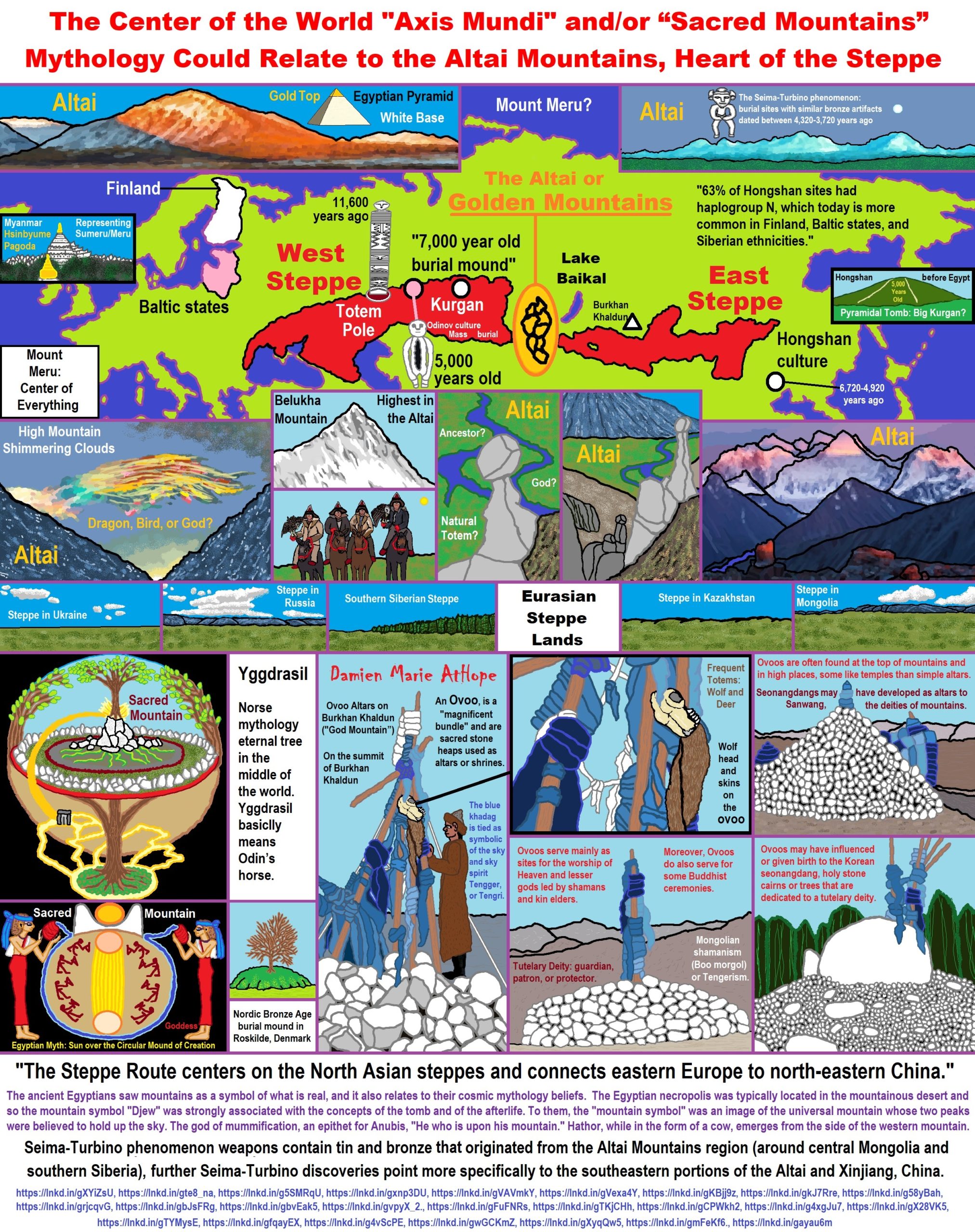
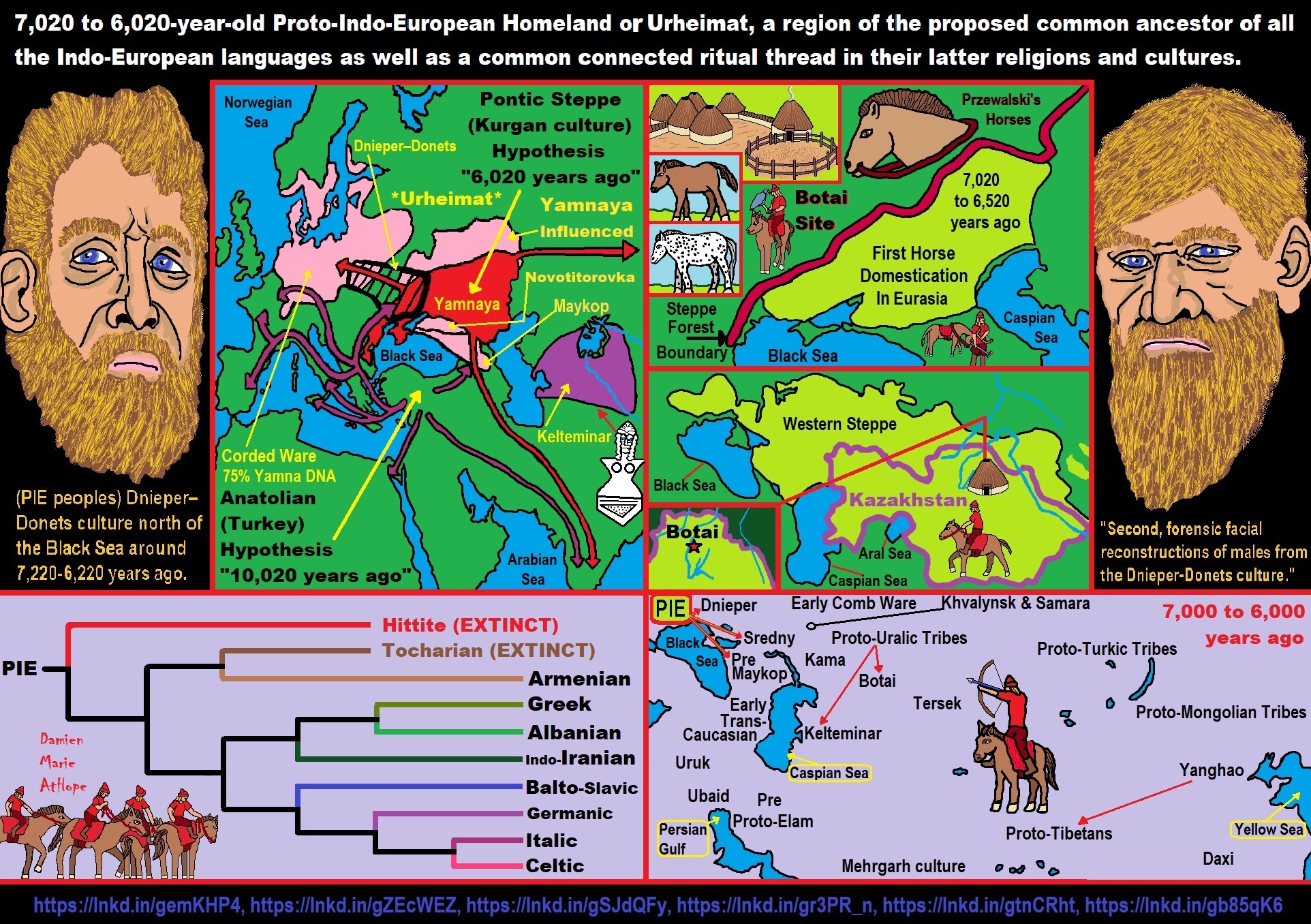

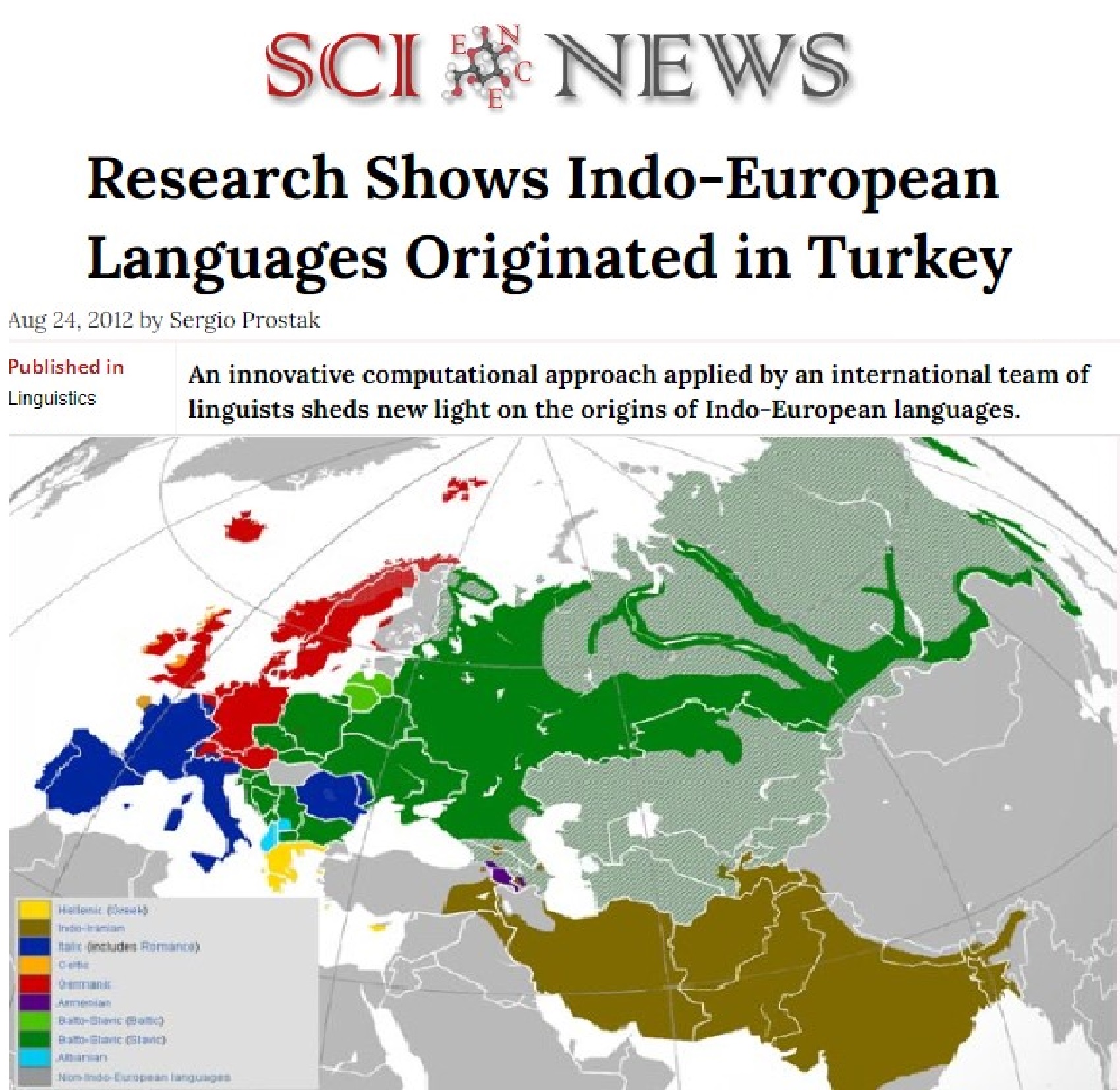
Research Shows Indo-European Languages Originated in Turkey (2012)
“The Indo-European languages belong to one of the widest spread language families of the world. For the last two millennia, many of these languages have been written, and their history is relatively clear. But controversy remains about the time and place of the origins of the family. The majority view in historical linguistics is that the homeland of Indo-European is located in the Pontic steppes – present-day Ukraine – around 6,000 years ago. The evidence for this comes from linguistic paleontology: in particular, certain words to do with the technology of wheeled vehicles are arguably present across all the branches of the Indo-European family; and archaeology tells us that wheeled vehicles arose no earlier than this date. The minority view links the origins of Indo-European with the spread of farming from Anatolia 8,000-9,500 years ago. The team’s innovative Bayesian phylogeographic analysis of Indo-European linguistic and spatial data, including basic vocabulary data from 103 ancient and contemporary Indo-European languages, decisively supports this theory. The linguists report their results in a paper in the journal Science.” ref

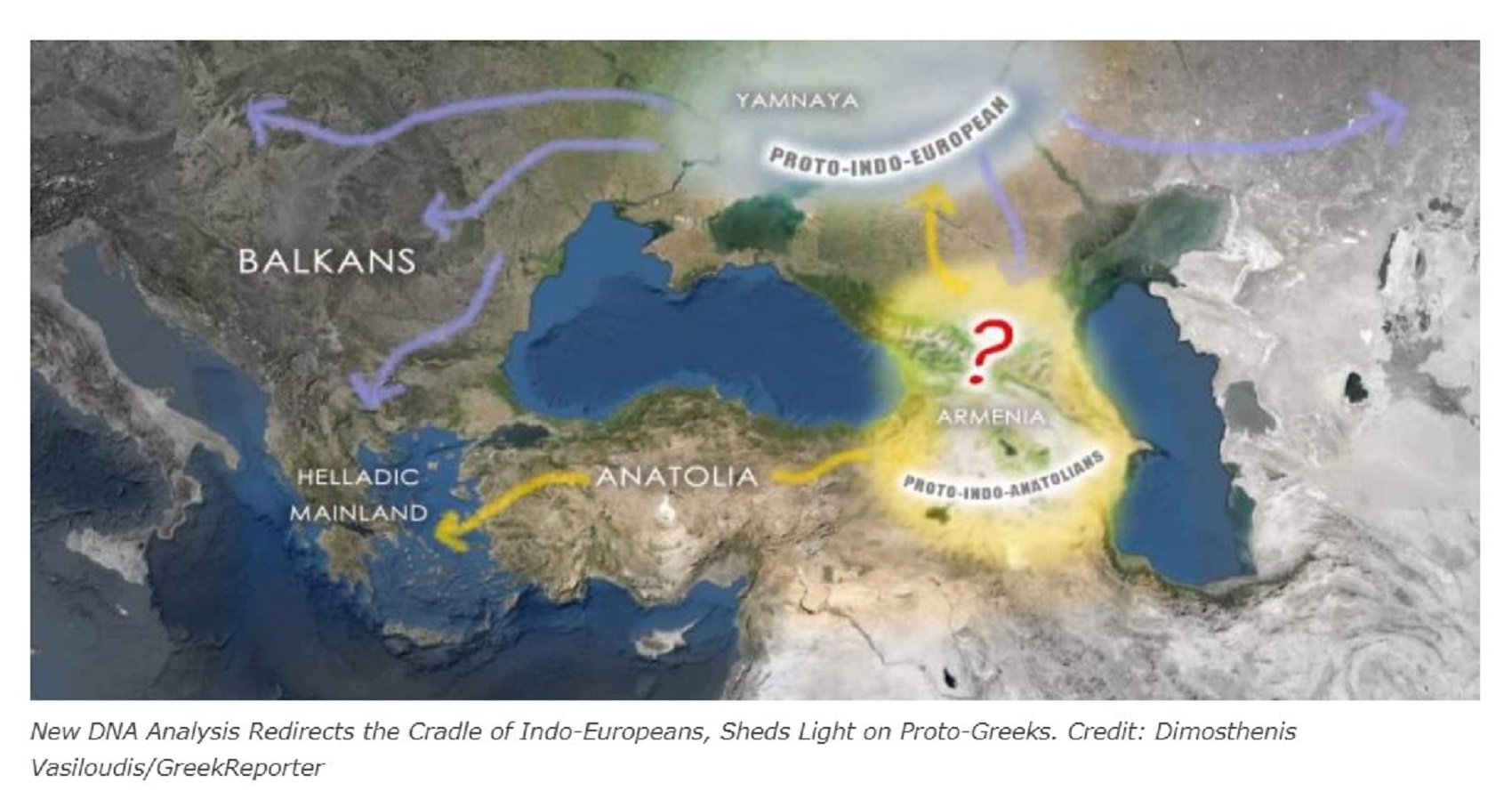
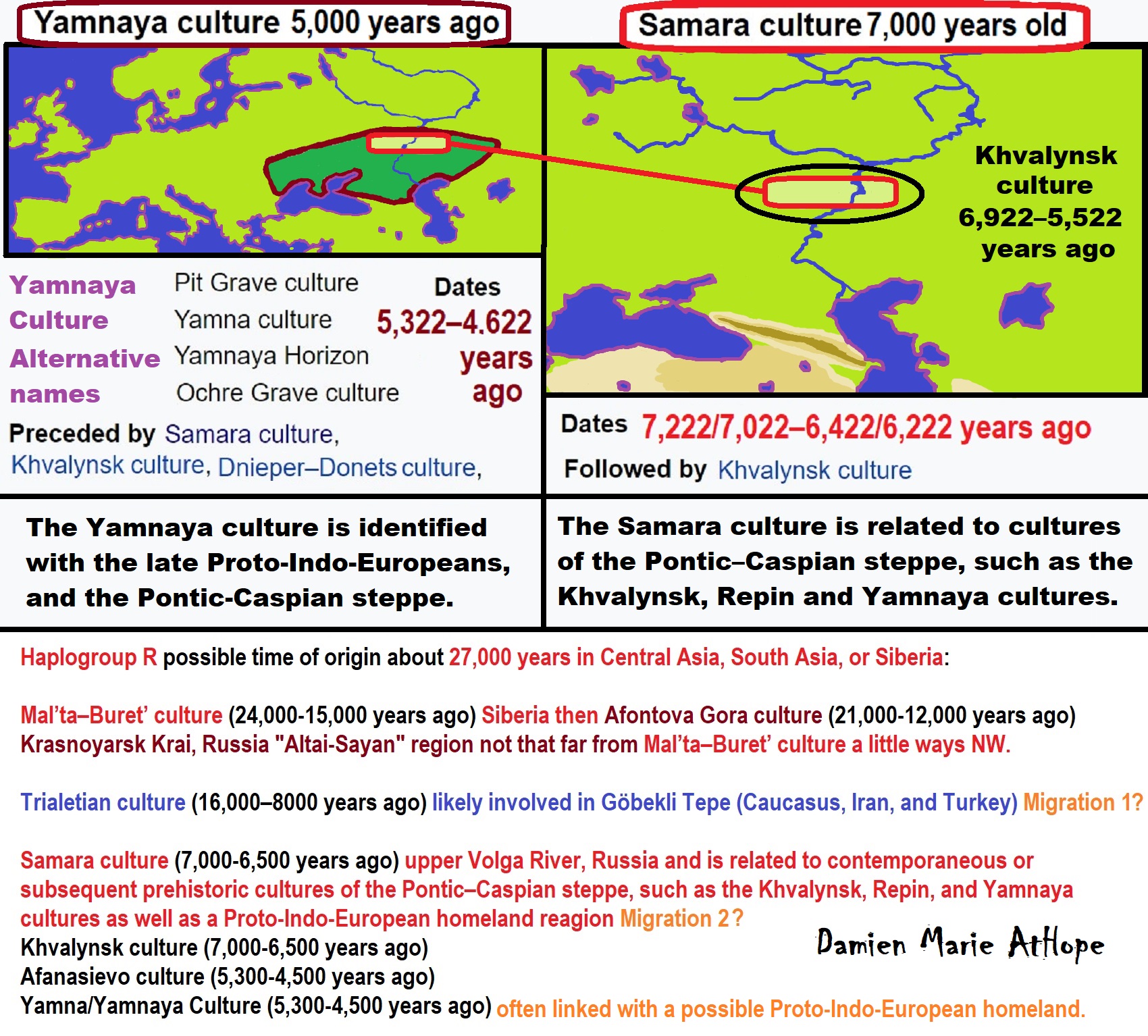



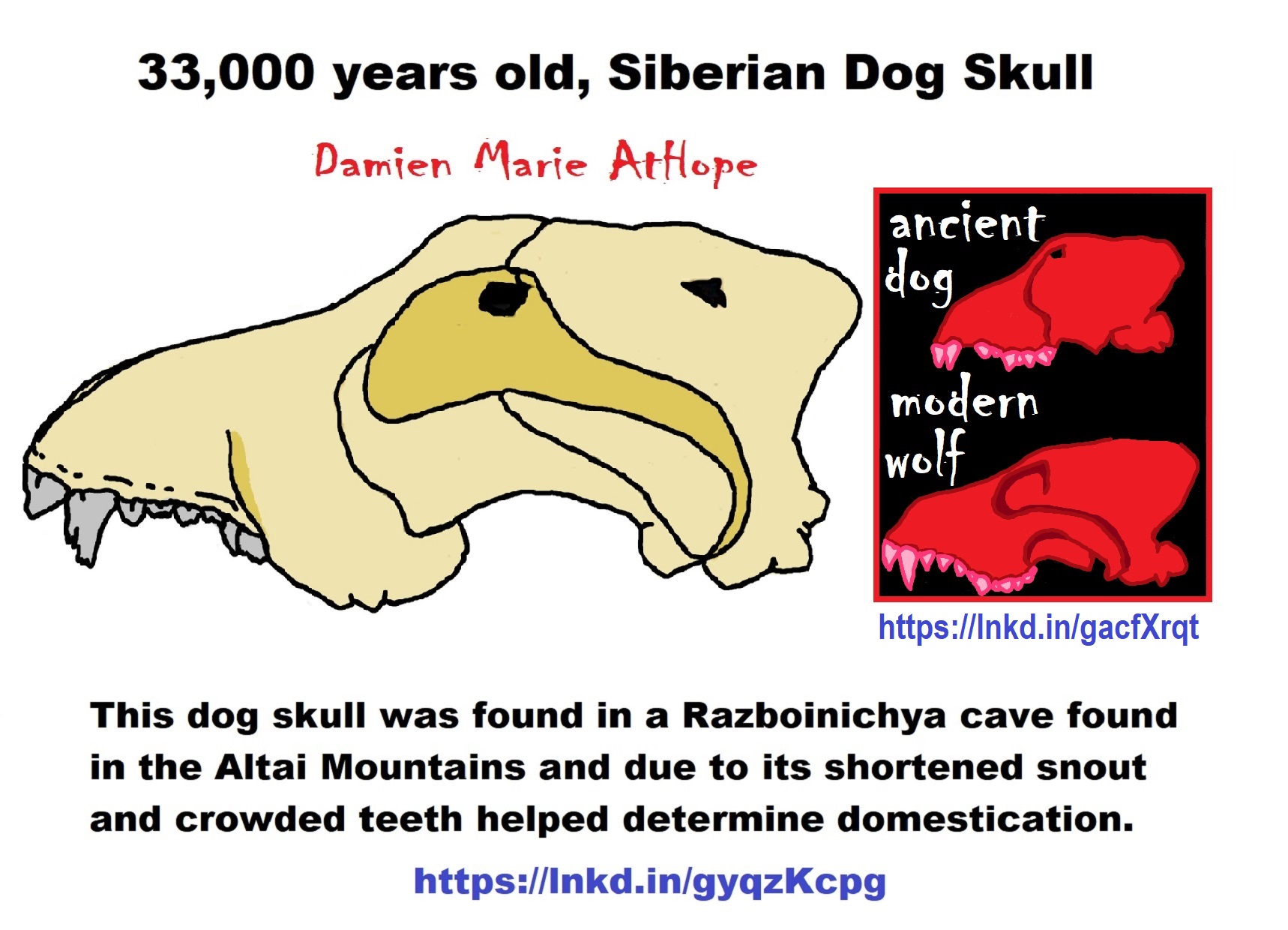
“The ANE lineage is defined by association with the MA-1, or “Mal’ta boy“, the remains of an individual who lived during the Last Glacial Maximum, 24,000 years ago in central Siberia. Populations genetically similar to MA-1 were an important genetic contributor to Native Americans, Europeans, Ancient Central Asians, South Asians, and some East Asian groups (such as the Ainu people), in order of significance.” ref
“Groups partially derived from the Ancient North Eurasians: Eastern Hunter-Gatherer (R1a-M417, around 8,400 years ago), Scandinavian Hunter-Gatherer (around 8,000 years ago), Ancient Beringian/Ancestral Native American (around 11,500 years ago), West Siberian Hunter-Gatherer, Western Steppe Herders (closely related to the Yamnaya culture), Late Upper Paeolithic Lake Baikal (14,050-13,770 years ago), Lake Baikal Holocene (around 11,650 years ago to the present), Jōmon people, pre-Neolithic population of Japan (and present-day Ainu people).” ref
“Since the term ‘Ancient North Eurasian’ refers to a genetic bridge of connected mating networks, scholars of comparative mythology have argued that they probably shared myths and beliefs that could be reconstructed via the comparison of stories attested within cultures that were not in contact for millennia and stretched from the Pontic–Caspian steppe to the American continent.” ref
“For instance, the mytheme of the dog guarding the Otherworld possibly stems from an older Ancient North Eurasian belief, as suggested by similar motifs found in Indo-European, Native American, and Siberian mythology. In Siouan, Algonquian, Iroquoian, and in Central and South American beliefs, a fierce guard dog was located in the Milky Way, perceived as the path of souls in the afterlife, and getting past it was a test. The Siberian Chukchi and Tungus believed in a guardian-of-the-afterlife dog and a spirit dog that would absorb the dead man’s soul and act as a guide in the afterlife. In Indo-European myths, the figure of the dog is embodied by Cerberus, Sarvarā, and Garmr. Anthony and Brown note that it might be one of the oldest mythemes recoverable through comparative mythology.” ref
“A second canid-related series of beliefs, myths, and rituals connected dogs with healing rather than death. For instance, Ancient Near Eastern and Turkic–Kipchaq myths are prone to associate dogs with healing and generally categorized dogs as impure. A similar myth-pattern is assumed for the Eneolithic site of Botai in Kazakhstan, dated to 3500 BC, which might represent the dog as absorber of illness and guardian of the household against disease and evil. In Mesopotamia, the goddess Nintinugga, associated with healing, was accompanied or symbolized by dogs. Similar absorbent-puppy healing and sacrifice rituals were practiced in Greece and Italy, among the Hittites, again possibly influenced by Near Eastern traditions.” ref
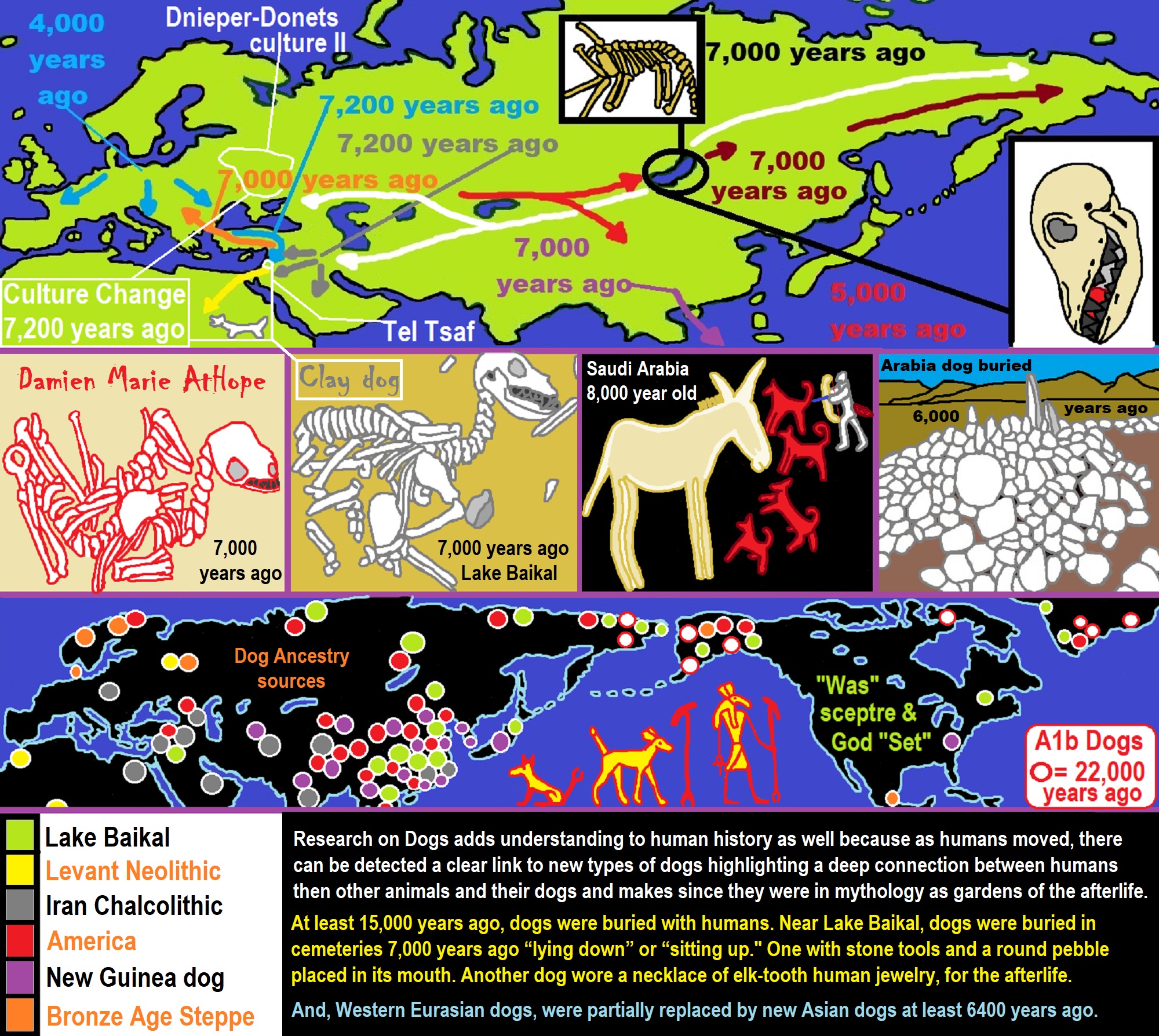
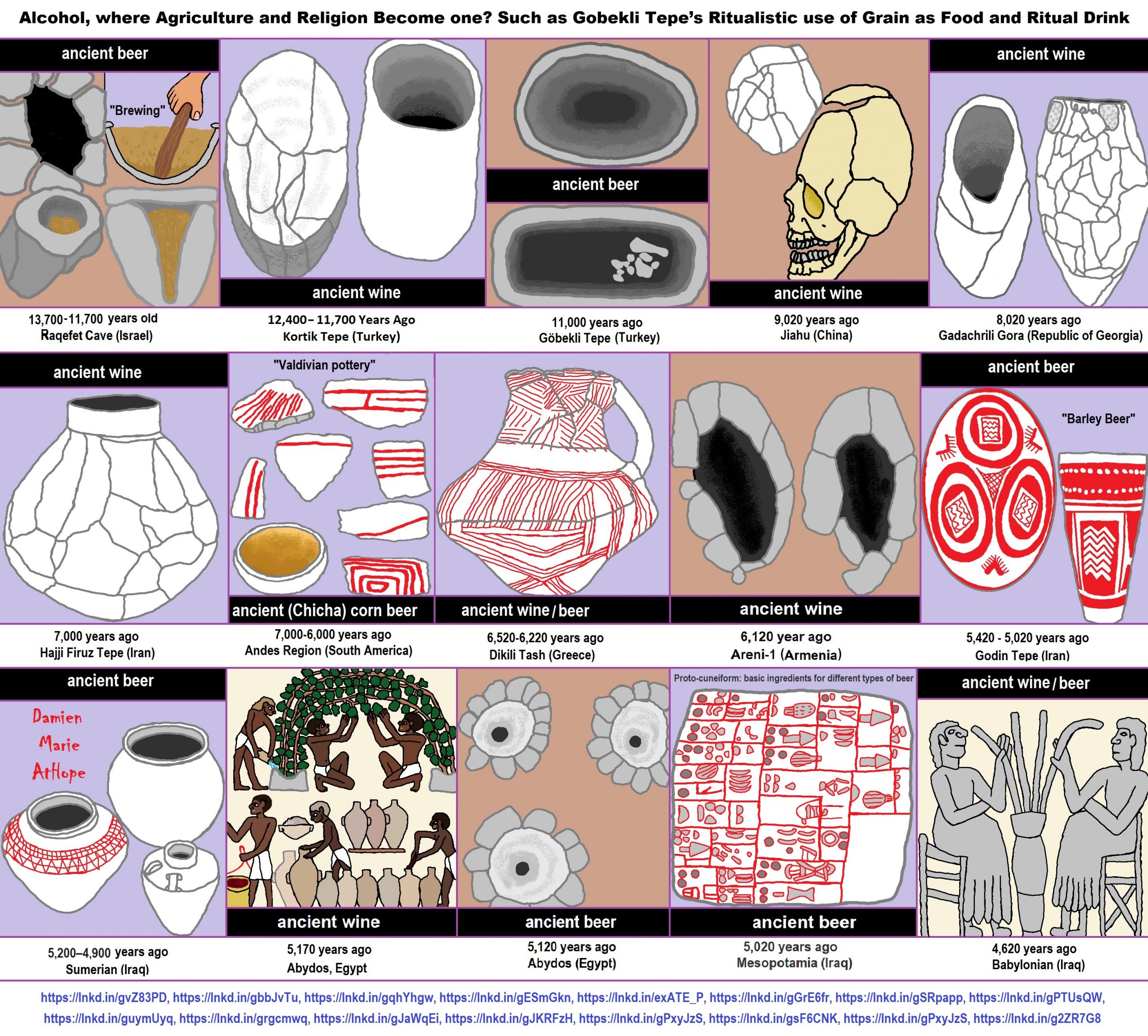
ref, ref, ref, ref, ref, ref, ref, ref, ref, ref, ref, ref, ref, ref, ref
Raqefet Cave
13,000-year-old stone mortars offers the earliest known physical evidence of an extensive ancient beer-brewing operation.
“The find comes on the heels of a July report that archaeologists working in northeastern Jordan discovered the charred remains of bread baked by Natufians some 11,600 to 14,600 years ago. According to the Stanford scientists, the ancient beer residue comes from 11,700 to 13,700 years old. Through laboratory analysis, other archaeological evidence found in the cave, and the wear of the stones, the team discovered that the ancient Natufians used species from seven plant families, “including wheat or barley, oat, legumes and bast fibers (including flax),” according to the article. “They packed plant-foods, including malted wheat/barley, in fiber-made containers and stored them in boulder mortars. They used bedrock mortars for pounding and cooking plant-foods, including brewing wheat/barley-based beer likely served in ritual feasts ca. 13,000 years ago,” the scientists write. “It has long been speculated that the thirst for beer may have been the stimulus behind cereal domestication, which led to a major social-technological change in human history; but this hypothesis has been highly controversial,” the Stanford authors say. “We report here of the earliest archaeological evidence for cereal-based beer brewing by a semi-sedentary, foraging people.” ref
“Beer making was an integral part of rituals and feasting, a social regulatory mechanism in hierarchical societies,” said Stanford’s Wang. The Raqefet Cave discovery of the first man-made alcohol production, the cave also provides one of the earliest pieces of evidence of the use of flower beds on gravesites, discovered under human skeletons. “The Natufian remains in Raqefet Cave never stop surprising us,” co-author Prof. Dani Nadel, of the University of Haifa’s Zinman Institute of Archaeology, said in a press release. “We exposed a Natufian burial area with about 30 individuals, a wealth of small finds such as flint tools, animal bones and ground stone implements, and about 100 stone mortars and cupmarks. Some of the skeletons are well-preserved and provided direct dates and even human DNA, and we have evidence for flower burials and wakes by the graves.” ref
“And now, with the production of beer, the Raqefet Cave remains provide a very vivid and colorful picture of Natufian lifeways, their technological capabilities, and inventions,” he said. Stanford’s Liu posited that the beer production was of a religious nature because its production was found near a graveyard. “This discovery indicates that making alcohol was not necessarily a result of agricultural surplus production, but it was developed for ritual purposes and spiritual needs, at least to some extent, prior to agriculture,” she said. “Alcohol making and food storage were among the major technological innovations that eventually led to the development of civilizations in the world, and archaeological science is a powerful means to help reveal their origins and decode their contents,” said Liu. “We are excited to have the opportunity to present our findings, which shed new light on a deeper history of human society.” ref

“In ancient Ukraine, stone mace heads were first used nearly eight millennia ago or almost 8,000 years ago.” ref
“Eneolithic (Eneol_ROMANIA) (4500–3800 cal BCE or around 6,500-5,800 years ago or so): This period is represented by Decea Mureşului site (Alba county), dated in the end of the 5th millennium BCE. Samples for mtDNA analysis were taken from two of the discovered graves. Exceptional grave goods and the use of ocher and stone mace-head, represent the first contact (migration) between Transylvania and North-Pontic steppes.” ref
“The settlement systems of the Trypillia culture interacted with both Central European and the steppe populations. Archaeological evidence for steppe interaction is found in shell-tempered pottery, which are similar to steppe-style wares. Some of these look nearly identical to pottery found at steppe sites, while others combine shell tempering with CTCC decorative motifs. Symbolic objects influenced by—or directly imported from—steppe communities, such as stone mace heads, are found at some Middle-to-Late Trypillia sites, and exchanges of pottery are evident as early as Trypillia BII. There was undoubtedly some degree of interaction between Trypillian populations and the Dnieper-Donets culture, while any synchrony between the Trypillia culture and the following Yamnaya horizon was likely very brief. Regardless, however, some Trypillian populations were likely in permanent contact with steppe populations.” ref
“The analyzed individuals that are generally thought to come from the Eneolithic Period have maternal haplogroups T2b, H, HV, K1, N1, J1, U5 and T2c.” ref
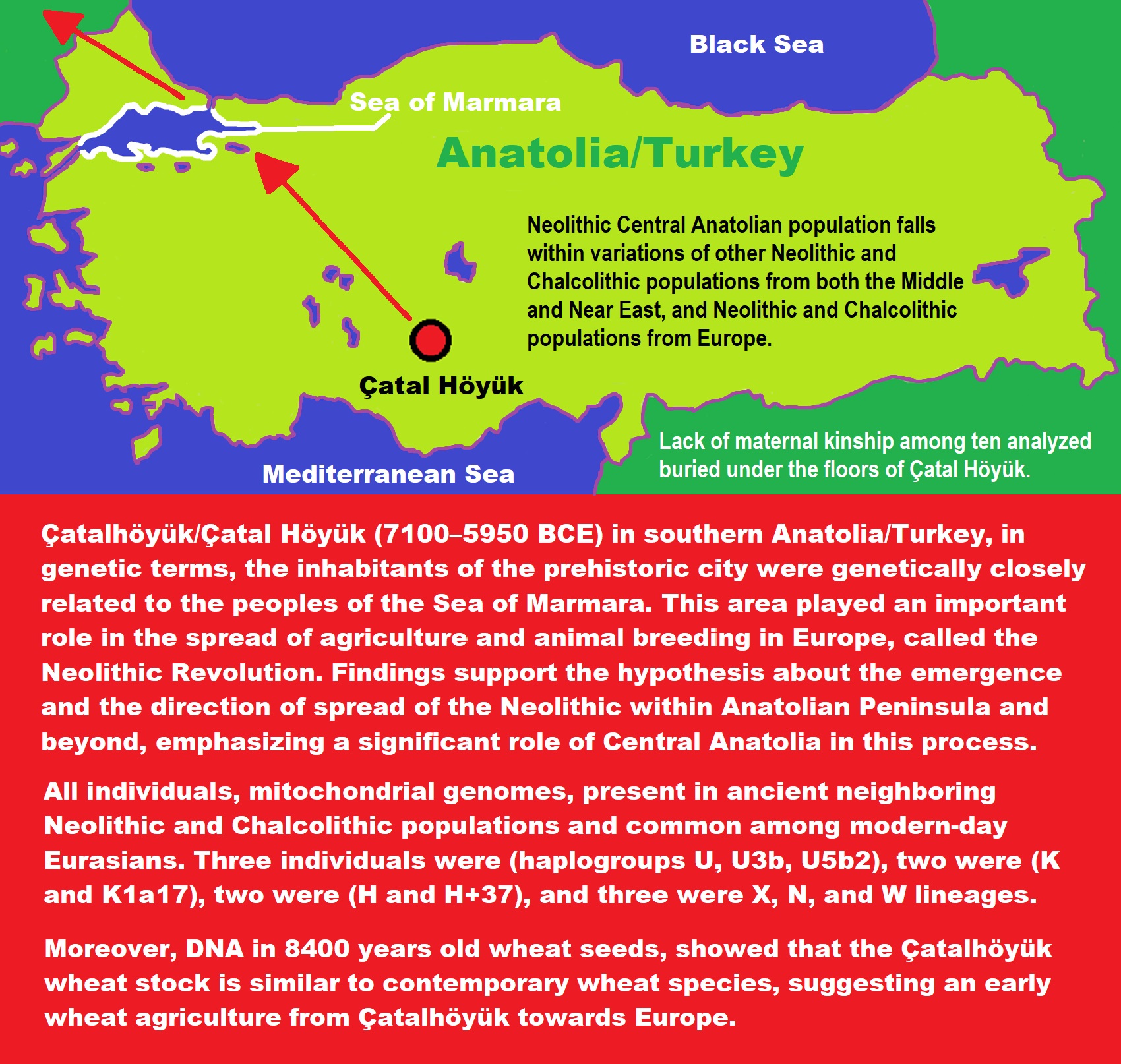
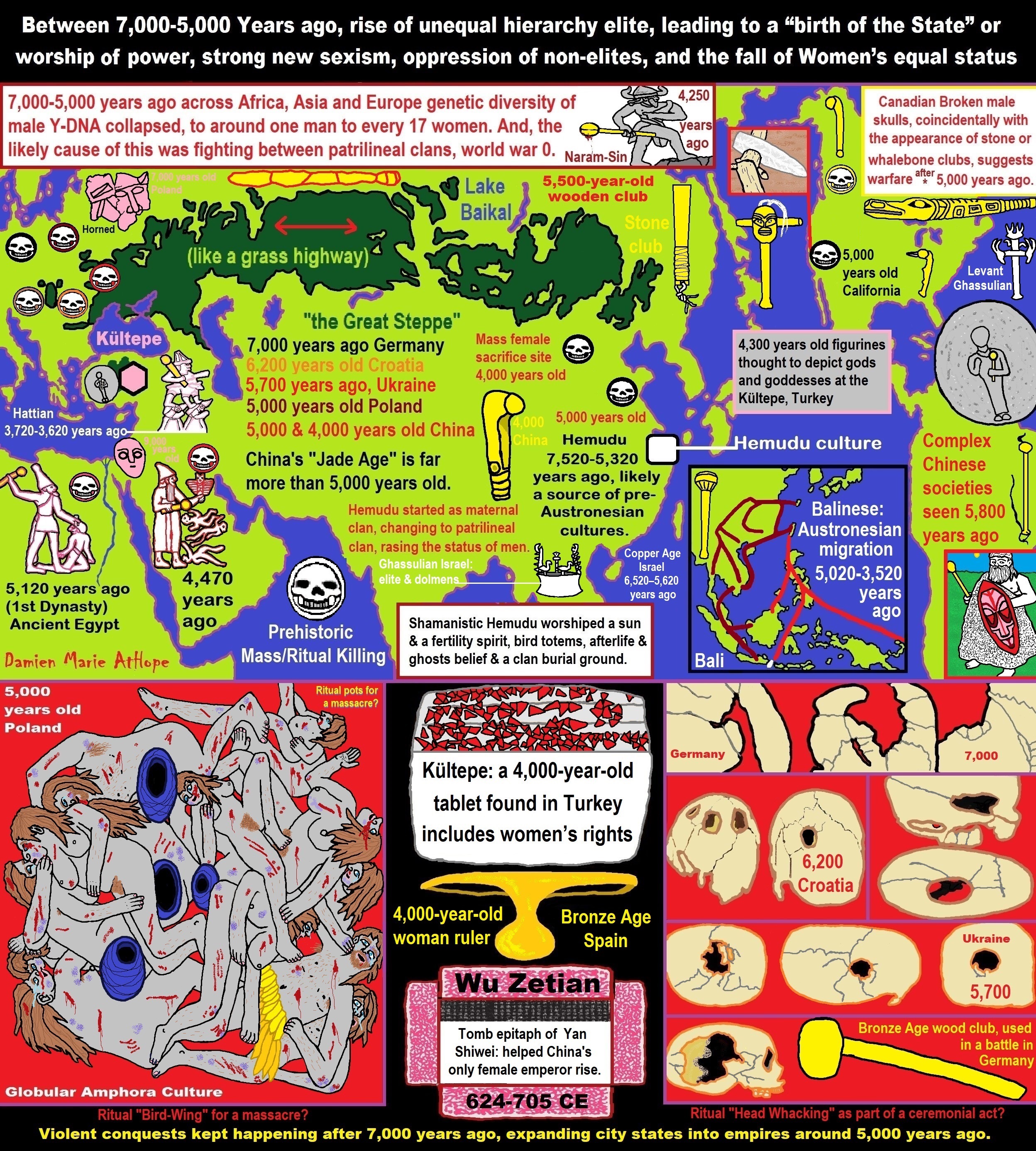
ref, ref, ref, ref, ref, ref, ref, ref, ref, ref, ref, ref, ref, ref, ref, ref, ref, ref, ref, ref, ref, ref, ref, ref, ref, ref, ref, ref, ref, ref, ref, ref, ref, ref, ref, ref, ref, ref, ref, ref, ref, ref, ref, ref, ref, ref, ref, ref, ref, ref, ref, ref, ref, ref, ref, ref, ref, ref, ref, ref, ref, ref, ref, ref, ref, ref, ref, ref, ref, ref, ref, ref, ref, ref, ref, ref, ref, ref, ref, ref, ref, ref, ref, ref, ref, ref, ref, ref, ref, ref
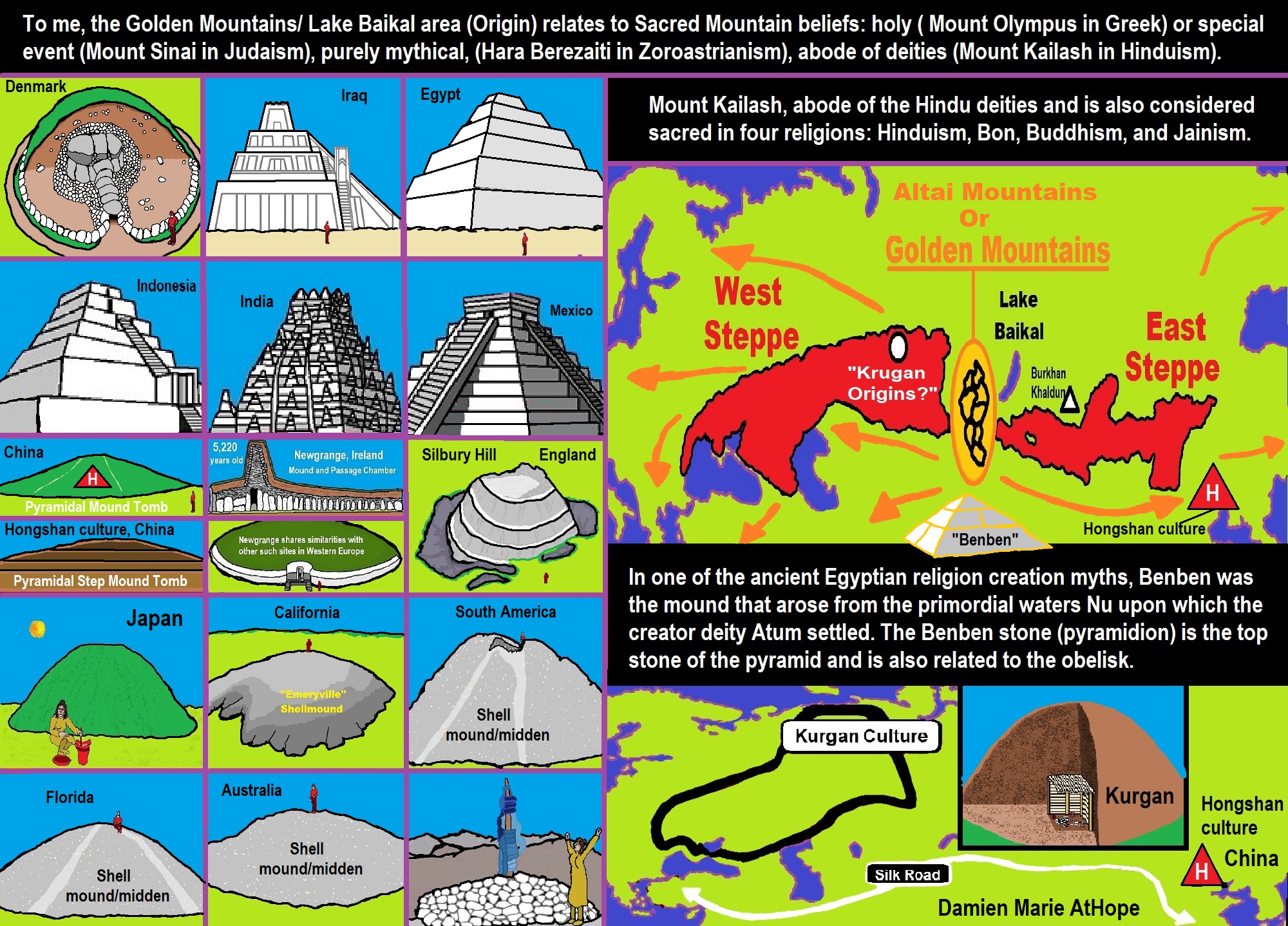
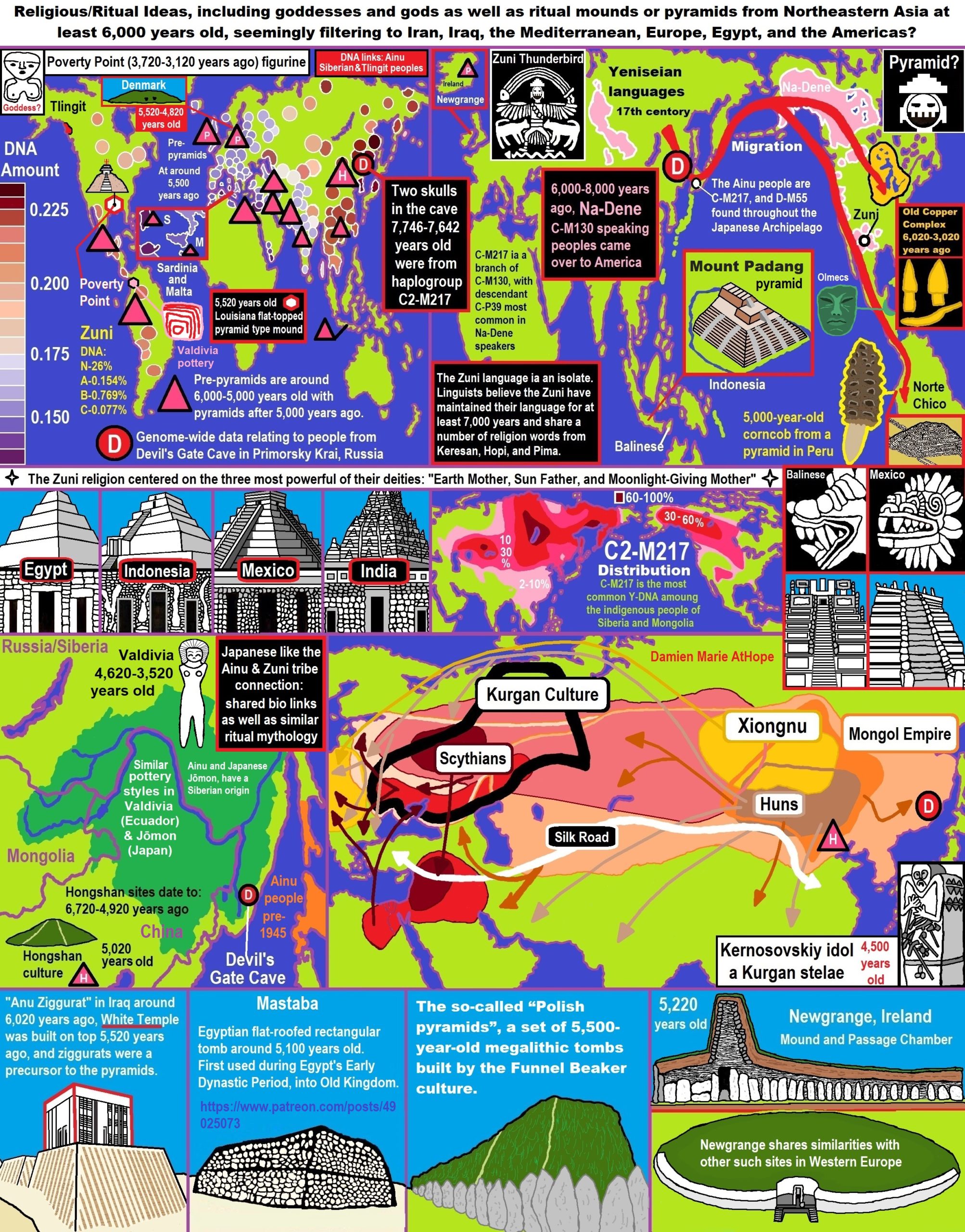
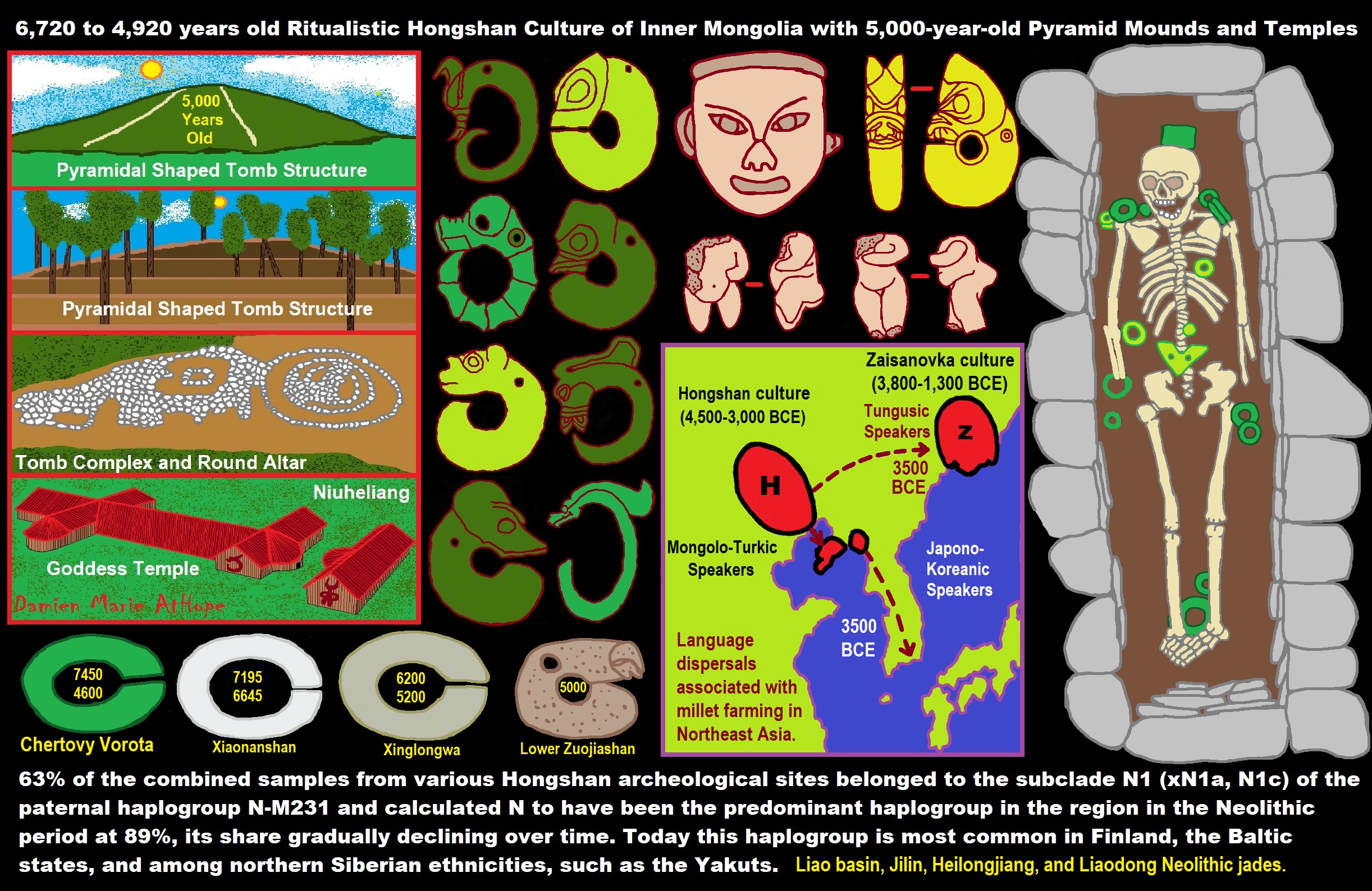
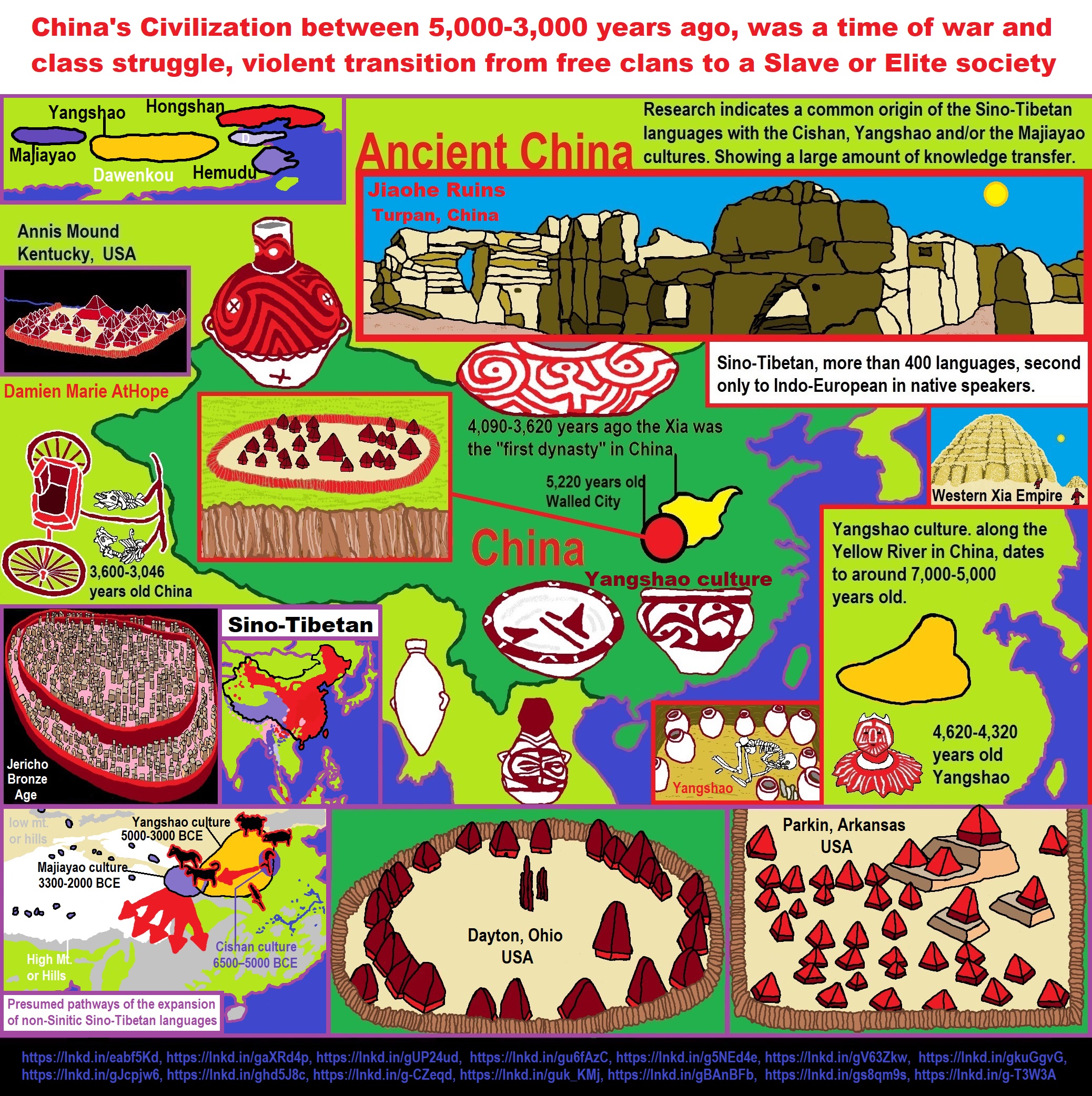
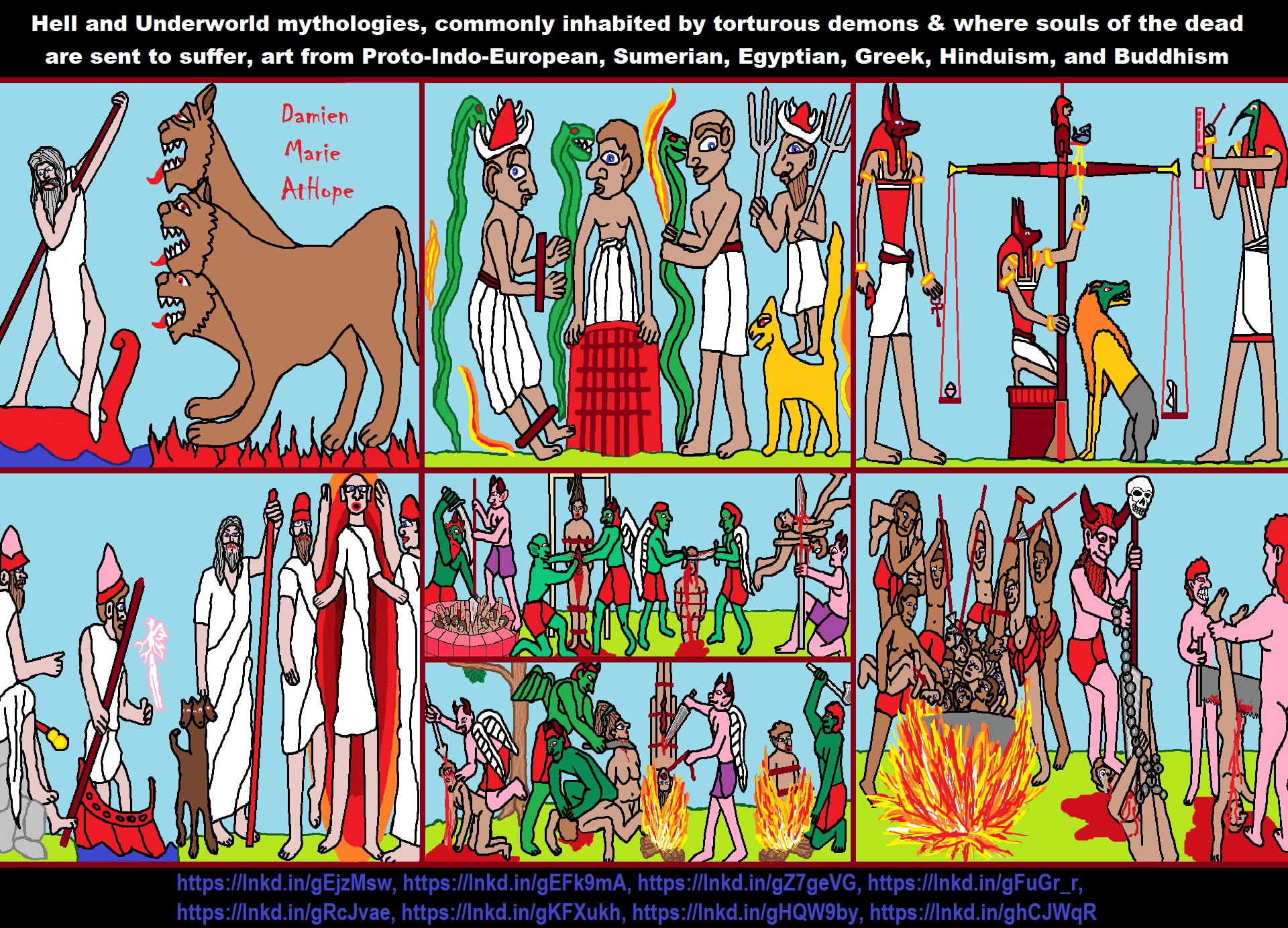
ref, ref, ref, ref, ref, ref, ref, ref, ref, ref, ref
Sumerian religion/ Mesopotamian mythology
“The Proto-Indo-Europeans were a hypothetical prehistoric ethnolinguistic group of Eurasia who spoke Proto-Indo-European (PIE), the ancestor of the Indo-European languages according to linguistic reconstruction. Knowledge of them comes chiefly from that linguistic reconstruction, along with material evidence from archaeology and archaeogenetics. The Proto-Indo-Europeans likely lived during the late Neolithic, or roughly the 4th millennium BCE or between 6,020-5,020 years ago. Mainstream scholarship places them in the Pontic–Caspian steppe zone in Eastern Europe (present-day Ukraine and southern Russia). Some archaeologists would extend the time depth of PIE to the middle Neolithic (5500 to 4500 BCE or 7,520-6,520 years ago) or even the early Neolithic (7500 to 5500 BCE or 9,520-7,520 years ago), and suggest alternative location hypotheses. By the early second millennium BC, descendants of the Proto-Indo-Europeans had reached far and wide across Eurasia, including Anatolia (Hittites), the Aegean (the ancestors of Mycenaean Greece), the north of Europe (Corded Ware culture), the edges of Central Asia (Yamnaya culture), and southern Siberia (Afanasievo culture).” ref
“:Using linguistic reconstruction from old Indo-European languages such as Latin and Sanskrit, hypothetical features of the Proto-Indo-European language are deduced. Assuming that these linguistic features reflect the culture and environment of the Proto-Indo-Europeans, the following cultural and environmental traits are widely proposed:
- pastoralism, including domesticated cattle, horses, and dogs
- agriculture and cereal cultivation, including technology commonly ascribed to late-Neolithic farming communities, e.g., the plow
- transportation by or across water
- the solid wheel, used for wagons, but not yet chariots with spoked wheels
- worship of a sky god, *Dyḗus Ph2tḗr (lit. “sky father”; > Vedic Sanskrit Dyáuṣ Pitṛ́, Ancient Greek Ζεύς (πατήρ) / Zeus (dyeus)), vocative *dyeu ph2ter (> Latin Iūpiter, Illyrian Deipaturos)
- oral heroic poetry or song lyrics that used stock phrases such as imperishable fame (*ḱléwos ń̥dʰgʷʰitom) and the wheel of the sun (*sh₂uens kʷekʷlos).
- a patrilineal kinship-system based on relationships between men” ref
“Researchers have made many attempts to identify particular prehistoric cultures with the Proto-Indo-European-speaking peoples, but all such theories remain speculative. The scholars of the 19th century who first tackled the question of the Indo-Europeans’ original homeland (also called Urheimat, from German), had essentially only linguistic evidence. They attempted a rough localization by reconstructing the names of plants and animals (importantly the beech and the salmon) as well as the culture and technology (a Bronze Age culture centered on animal husbandry and having domesticated the horse). The scholarly opinions became basically divided between a European hypothesis, positing migration from Europe to Asia, and an Asian hypothesis, holding that the migration took place in the opposite direction.” ref
“In the early 20th century, the question became associated with the expansion of a supposed “Aryan race“, a now-discredited theory promoted during the expansion of European empires and the rise of “scientific racism“. The question remains contentious within some flavors of ethnic nationalism (see also Indigenous Aryans). A series of major advances occurred in the 1970s due to the convergence of several factors. First, the radiocarbon dating method (invented in 1949) had become sufficiently inexpensive to be applied on a mass scale. Through dendrochronology (tree-ring dating), pre-historians could calibrate radiocarbon dates to a much higher degree of accuracy. And finally, before the 1970s, parts of Eastern Europe and Central Asia had been off limits to Western scholars, while non-Western archaeologists did not have access to publication in Western peer-reviewed journals. The pioneering work of Marija Gimbutas, assisted by Colin Renfrew, at least partly addressed this problem by organizing expeditions and arranging for more academic collaboration between Western and non-Western scholars.” ref
“The Kurgan hypothesis, as of 2017 the most widely held theory, depends on linguistic and archaeological evidence, but is not universally accepted. It suggests PIE origin in the Pontic-Caspian steppe during the Chalcolithic. A minority of scholars prefer the Anatolian hypothesis, suggesting an origin in Anatolia during the Neolithic. Other theories (Armenian hypothesis, Out of India theory, Paleolithic Continuity Theory, Balkan hypothesis) have only marginal scholarly support.” ref
“In regard to terminology, in the 19th and early 20th centuries, the term Aryan was used to refer to the Proto-Indo-Europeans and their descendants. However, Aryan more properly applies to the Indo-Iranians, the Indo-European branch that settled parts of the Middle East and South Asia, as only Indic and Iranian languages explicitly affirm the term as a self-designation referring to the entirety of their people, whereas the same Proto-Indo-European root (*aryo-) is the basis for Greek and Germanic word forms which seem only to denote the ruling elite of Proto-Indo-European (PIE) society. In fact, the most accessible evidence available confirms only the existence of a common, but vague, socio-cultural designation of “nobility” associated with PIE society, such that Greek socio-cultural lexicon and Germanic proper names derived from this root remain insufficient to determine whether the concept was limited to the designation of an exclusive, socio-political elite, or whether it could possibly have been applied in the most inclusive sense to an inherent and ancestral “noble” quality which allegedly characterized all ethnic members of PIE society. Only the latter could have served as a true and universal self-designation for the Proto-Indo-European people.” ref
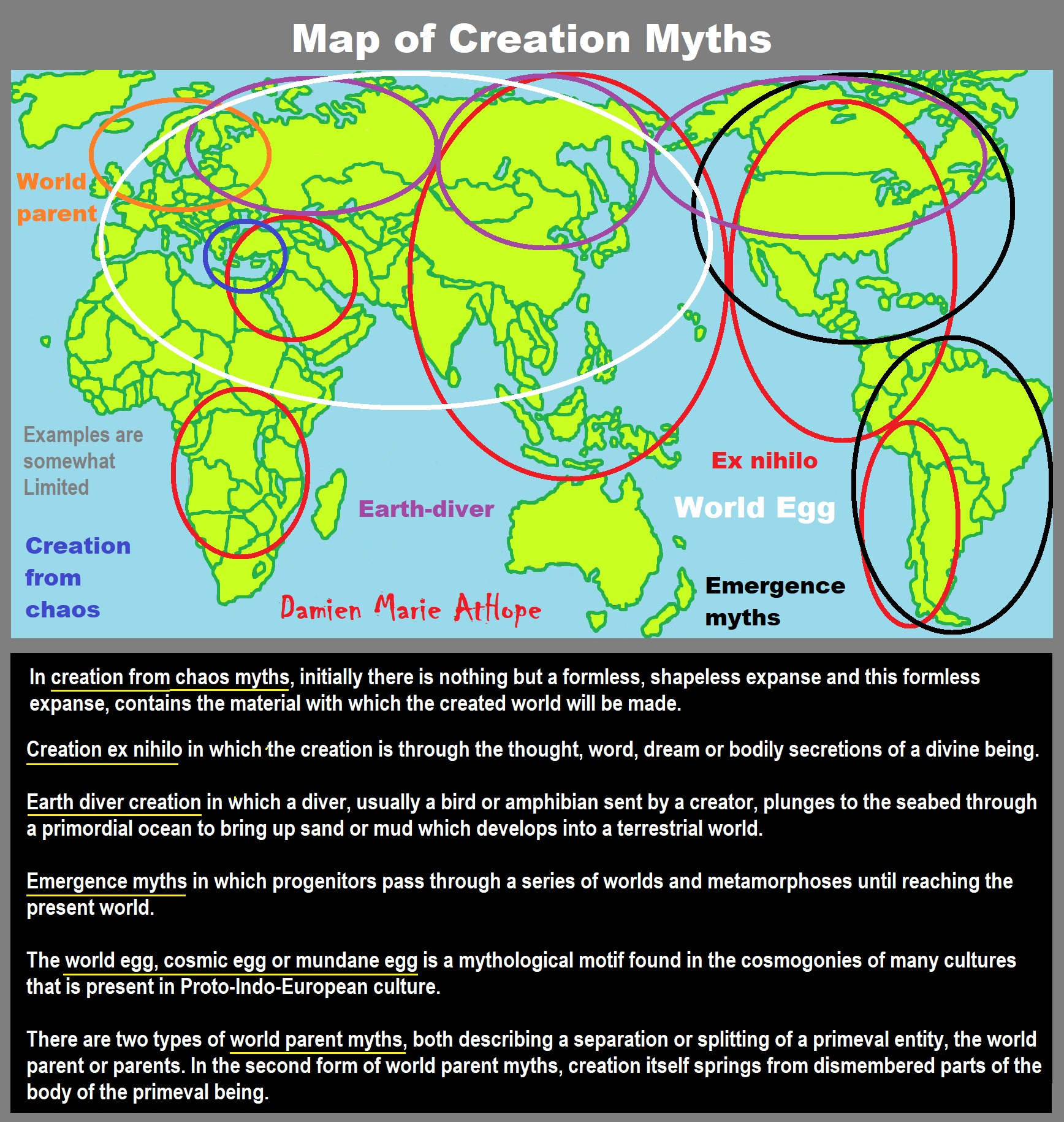
Creation myths: From chaos, Ex nihilo, Earth-diver, Emergence, World egg, and World parent
“A creation myth (or cosmogonic myth) is a symbolic narrative of how the world began and how people first came to inhabit it. While in popular usage the term myth often refers to false or fanciful stories, members of cultures often ascribe varying degrees of truth to their creation myths. In the society in which it is told, a creation myth is usually regarded as conveying profound truths – metaphorically, symbolically, historically, or literally. They are commonly, although not always, considered cosmogonical myths – that is, they describe the ordering of the cosmos from a state of chaos or amorphousness.” ref
“Creation myths often share a number of features. They often are considered sacred accounts and can be found in nearly all known religious traditions. They are all stories with a plot and characters who are either deities, human-like figures, or animals, who often speak and transform easily. They are often set in a dim and nonspecific past that historian of religion Mircea Eliade termed in illo tempore (‘at that time’). Creation myths address questions deeply meaningful to the society that shares them, revealing their central worldview and the framework for the self-identity of the culture and individual in a universal context. Creation myths develop in oral traditions and therefore typically have multiple versions; found throughout human culture, they are the most common form of myth.” ref
Creation myth definitions from modern references:
- “A “symbolic narrative of the beginning of the world as understood in a particular tradition and community. Creation myths are of central importance for the valuation of the world, for the orientation of humans in the universe, and for the basic patterns of life and culture.”
- “Creation myths tell us how things began. All cultures have creation myths; they are our primary myths, the first stage in what might be called the psychic life of the species. As cultures, we identify ourselves through the collective dreams we call creation myths, or cosmogonies. … Creation myths explain in metaphorical terms our sense of who we are in the context of the world, and in so doing they reveal our real priorities, as well as our real prejudices. Our images of creation say a great deal about who we are.”
- A “philosophical and theological elaboration of the primal myth of creation within a religious community. The term myth here refers to the imaginative expression in narrative form of what is experienced or apprehended as basic reality … The term creation refers to the beginning of things, whether by the will and act of a transcendent being, by emanation from some ultimate source, or in any other way.” ref
Religion professor Mircea Eliade defined the word myth in terms of creation:
“Myth narrates a sacred history; it relates an event that took place in primordial Time, the fabled time of the “beginnings.” In other words, myth tells how, through the deeds of Supernatural Beings, a reality came into existence, be it the whole of reality, the Cosmos, or only a fragment of reality – an island, a species of plant, a particular kind of human behavior, an institution.” ref
“All creation myths are in one sense etiological because they attempt to explain how the world formed and where humanity came from. Myths attempt to explain the unknown and sometimes teach a lesson.” ref
“Some Ethnologists and anthropologists who study origin myths say that in the modern context theologians try to discern humanity’s meaning from revealed truths and scientists investigate cosmology with the tools of empiricism and rationality, but creation myths define human reality in very different terms. In the past, historians of religion and other students of myth thought of such stories as forms of primitive or early-stage science or religion and analyzed them in a literal or logical sense. Today, however, they are seen as symbolic narratives which must be understood in terms of their own cultural context. Charles Long writes: “The beings referred to in the myth – gods, animals, plants – are forms of power grasped existentially. The myths should not be understood as attempts to work out a rational explanation of deity.” ref
“While creation myths are not literal explications, they do serve to define an orientation of humanity in the world in terms of a birth story. They provide the basis of a worldview that reaffirms and guides how people relate to the natural world, to any assumed spiritual world, and to each other. A creation myth acts as a cornerstone for distinguishing primary reality from relative reality, the origin and nature of being from non-being. In this sense, cosmogonic myths serve as a philosophy of life – but one expressed and conveyed through symbol rather than through systematic reason. And in this sense, they go beyond etiological myths (which explain specific features in religious rites, natural phenomena, or cultural life). Creation myths also help to orient human beings in the world, giving them a sense of their place in the world and the regard that they must have for humans and nature.” ref
Historian David Christian has summarised issues common to multiple creation myths:
“Each beginning seems to presuppose an earlier beginning. … Instead of meeting a single starting point, we encounter an infinity of them, each of which poses the same problem. … There are no entirely satisfactory solutions to this dilemma. What we have to find is not a solution but some way of dealing with the mystery …. And we have to do so using words. The words we reach for, from God to gravity, are inadequate to the task. So we have to use language poetically or symbolically; and such language, whether used by a scientist, a poet, or a shaman, can easily be misunderstood.” ref
“Mythologists have applied various schemes to classify creation myths found throughout human cultures. Eliade and his colleague Charles Long developed a classification based on some common motifs that reappear in stories the world over. The classification identifies five basic types: Brahmā, the Hindu deva of creation, emerges from a lotus risen from the navel of Viṣņu, who lies with Lakshmi on the serpent Ananta Shesha.” ref
- “Creation ex nihilo in which the creation is through the thought, word, dream, or bodily secretions of a divine being.
- Earth diver creation in which a diver, usually a bird or amphibian sent by a creator, plunges to the seabed through a primordial ocean to bring up sand or mud which develops into a terrestrial world.
- Emergence myths in which progenitors pass through a series of worlds and metamorphoses until reaching the present world.
- Creation by the dismemberment of a primordial being.
- Creation by the splitting or ordering of a primordial unity such as the cracking of a cosmic egg or a bringing order from chaos.” ref
“Marta Weigle further developed and refined this typology to highlight nine themes, adding elements such as deus faber, a creation crafted by a deity, creation from the work of two creators working together or against each other, creation from sacrifice, and creation from division/conjugation, accretion/conjunction, or secretion.” ref
An alternative system based on six recurring narrative themes was designed by Raymond Van Over:
- “Primeval abyss, an infinite expanse of waters or space.
- Originator deity which is awakened or an eternal entity within the abyss.
- Originator deity poised above the abyss.
- Cosmic egg or embryo.
- Originator deity creating life through sound or word.
- Life generating from the corpse or dismembered parts of an originator deity.” ref

Proto-Indo-European Mythology
“Proto-Indo-European mythology is the body of myths and deities associated with the Proto-Indo-Europeans, the hypothetical speakers of the reconstructed Proto-Indo-European language. Although the mythological motifs are not directly attested – since Proto-Indo-European speakers lived in prehistoric societies – scholars of comparative mythology have reconstructed details from inherited similarities found among Indo-European languages, based on the assumption that parts of the Proto-Indo-Europeans’ original belief systems survived in the daughter traditions.” ref
“The Proto-Indo-European pantheon includes a number of securely reconstructed deities such as *Dyḗws Ph₂tḗr, the daylight-sky god; his consort *Dʰéǵʰōm, the earth mother; his daughter *H₂éwsōs, the dawn goddess; his sons the Divine Twins; and *Seh₂ul, a solar goddess. Some deities, like the weather god *Perkʷunos or the herding-god *Péh₂usōn, are only attested in a limited number of traditions – Western (European) and Graeco-Aryan, respectively – and could therefore represent late additions that did not spread throughout the various Indo-European dialects.” ref
“Some myths are also securely dated to Proto-Indo-European times, since they feature both linguistic and thematic evidence of an inherited motif: a story portraying a mythical figure associated with thunder and slaying a multi-headed serpent to release torrents of water that had previously been pent up; a creation myth involving two brothers, one of whom sacrifices the other in order to create the world; and probably the belief that the Otherworld was guarded by a watchdog and could only be reached by crossing a river.” ref
“Various schools of thought exist regarding possible interpretations of the reconstructed Proto-Indo-European mythology. The main mythologies used in comparative reconstruction are Indo-Iranian, Baltic, Roman, and Norse, often supported with evidence from the Celtic, Greek, Slavic, Hittite, Armenian, Illyrian, and Albanian traditions as well.” ref
“One of the earliest attested and thus one of the most important of all Indo-European mythologies is Vedic mythology, especially the mythology of the Rigveda, the oldest of the Vedas. Early scholars of comparative mythology such as Friedrich Max Müller stressed the importance of Vedic mythology to such an extent that they practically equated it with Proto-Indo-European myths. Modern researchers have been much more cautious, recognizing that, although Vedic mythology is still central, other mythologies must also be taken into account.” ref
“Another of the most important source mythologies for comparative research is Roman mythology. Contrary to the frequent erroneous statement made by some authors that “Rome has no myth”, the Romans possessed a very complex mythological system, parts of which have been preserved through the characteristic Roman tendency to rationalize their myths into historical accounts. Despite its relatively late attestation, Norse mythology is still considered one of the three most important of the Indo-European mythologies for comparative research, due to the vast bulk of surviving Icelandic material.” ref
“Baltic mythology has also received a great deal of scholarly attention, as it is linguistically the most conservative and archaic of all surviving branches, but has so far remained frustrating to researchers because the sources are so comparatively late. Nonetheless, Latvian folk songs are seen as a major source of information in the process of reconstructing Proto-Indo-European myth. Despite the popularity of Greek mythology in western culture, Greek mythology is generally seen as having little importance in comparative mythology due to the heavy influence of Pre-Greek and Near Eastern cultures, which overwhelms what little Indo-European material can be extracted from it. Consequently, Greek mythology received minimal scholarly attention until the first decade of the 21st century.” ref
“Although Scythians are considered relatively conservative in regards to Proto-Indo-European cultures, retaining a similar lifestyle and culture, their mythology has very rarely been examined in an Indo-European context and infrequently discussed in regards to the nature of the ancestral Indo-European mythology. At least three deities, Tabiti, Papaios, and Api, are generally interpreted as having Indo-European origins, while the remaining have seen more disparate interpretations. Influence from Siberian, Turkic, and even Near Eastern beliefs, on the other hand, are more widely discussed in the literature.” ref
PIE Cosmology
“There was a fundamental opposition between the never-aging gods dwelling above in the skies, and the mortal humans living beneath on earth. The earth *dʰéǵʰōm was perceived as a vast, flat, and circular continent surrounded by waters (“the Ocean”). Although they may sometimes be identified with mythical figures or stories, the stars (*h₂stḗr) were not bound to any particular cosmic significance and were perceived as ornamental more than anything else. According to Martin L. West, the idea of the world-tree (axis mundi) is probably a later import from north Asiatic cosmologies: “The Greek myth might be derived from the Near East, and the Indic and Germanic ideas of a pillar from the shamanistic cosmologies of the Finno-Ugric and other peoples of central and northern Asia.” ref
PIE Reconstruction
“There is no scientific consensus which of the variants is the ‘true’ reconstruction of the Proto-Indo-European cosmogonic myth. Bruce Lincoln‘s reconstruction of the Proto-Indo-European cosmogonic myth (Twin and Man) is supported by a number of scholars like Jaan Puhvel, J. P. Mallory, Douglas Q. Adams, David W. Anthony, and in part by Martin L. West. Although some thematic parallels can be made with Ancient Near East (the twin Abel and Cain and their brother Seth), and even Polynesian or South American legends, Lincoln argues that the linguistic correspondences found in descendant cognates of *Manu and *Yemo make it very likely that the myth has a Proto-Indo-European origin. According to Edgar C. Polomé, “some elements of the [Scandinavian myth of Ymir] are distinctively Indo-Europeans”, but the reconstruction proposed by Lincoln “makes too unprovable assumptions to account for the fundamental changes implied by the Scandinavian version”. David A. Leeming also notes that the concept of the Cosmic Egg, symbolizing the primordial state from which the universe arises, is found in many Indo-European creation myths.” ref
PIE Creation myth
“Lincoln reconstructs a creation myth involving twin brothers, *Manu- (“Man”) and *Yemo- (“Twin”), as the progenitors of the world and mankind, and a hero named *Trito (“Third”) who ensured the continuity of the original sacrifice. Regarding that primordial state that may have preceded the creation process, West notes that the Vedic, Germanic, and, at least partially, the Greek traditions give evidence of an era when the cosmological elements were absent, with similar formula insisting on their non-existence: “neither non-being was nor being was at that time; there was not the air, nor the heaven beyond it…” (Rigveda), “…there was not sand nor sea nor the cool waves; earth was nowhere nor heaven above; Ginnunga Gap there was, but grass nowhere…” (Völuspá), “…there was Chasm and Night and dark Erebos at first, and broad Tartarus, but earth nor air nor heaven there was…” (The Birds).” ref
“The first man Manu and his giant twin Yemo are crossing the cosmos, accompanied by the primordial cow. To create the world, Manu sacrifices his brother and, with the help of heavenly deities (the Sky-Father, the Storm-God and the Divine Twins), forges both the natural elements and human beings from his remains. Manu thus becomes the first priest after initiating sacrifice as the primordial condition for the world order, and his deceased brother Yemo the first king as social classes emerge from his anatomy (priesthood from his head, the warrior class from his breast and arms, and the commoners from his sexual organs and legs). Although the European and Indo-Iranian versions differ on this matter, Lincoln argues that the primeval cow was most likely sacrificed in the original myth, giving birth to the other animals and vegetables, since the pastoral way of life of Proto-Indo-Iranian speakers was closer to that of Proto-Indo-European speakers according to the Kurgan hypothesis.” ref
“To the third man Trito, the celestial gods then offer cattle as a divine gift, which is stolen by a three-headed serpent named *Ngʷhi (“serpent”; and the Indo-European root for negation). Trito first suffers at his hands, but the hero eventually manages to overcome the monster, fortified by an intoxicating drink and aided by the Sky-Father. He eventually gives the recovered cattle back to a priest for it to be properly sacrificed. Trito is now the first warrior, maintaining through his heroic actions the cycle of mutual giving between gods and mortals.” ref
Interpretations
“According to Lincoln, Manu and Yemo seem to be the protagonists of “a myth of the sovereign function, establishing the model for later priests and kings”, while the legend of Trito should be interpreted as “a myth of the warrior function, establishing the model for all later men of arms”. The myth indeed recalls the Dumézilian tripartition of the cosmos between the priest (in both his magical and legal aspects), the warrior (the Third Man), and the herder (the cow). The story of Trito served as a model for later cattle raiding epic myths and most likely as a moral justification for the practice of raiding among Indo-European peoples. In the original legend, Trito is only taking back what rightfully belongs to his people, those who sacrifice properly to the gods. The myth has been interpreted either as a cosmic conflict between the heavenly hero and the earthly serpent, or as an Indo-European victory over non-Indo-European people, the monster symbolizing the aboriginal thief or usurper.” ref
“Some scholars have proposed that the primeval being Yemo was depicted as a two-folded hermaphrodite rather than a twin brother of Manu, both forming indeed a pair of complementary beings entwined together. The Germanic names Ymir and Tuisto were understood as twin, bisexual or hermaphrodite, and some myths give a sister to the Vedic Yama, also called Twin and with whom incest is discussed. In this interpretation, the primordial being may have self-sacrificed, or have been divided in two, a male half and a female half, embodying a prototypal separation of the sexes.” ref
“Cognates deriving from the Proto-Indo-European First Priest *Manu (“Man“, “ancestor of mankind”) include the Indic Manu, the legendary first man in Hinduism, and Manāvī, his sacrificed wife; the Germanic Mannus (from Germ. *Mannaz), the mythical ancestor of the West Germanic tribes; and the Persian Manūščihr (from Av. Manūš.čiθra), a Zoroastrian high priest of the 9th century CE. From the name of the sacrificed First King *Yemo (“Twin”) derive the Indic Yama, god of death and the underworld; the Avestan Yima, king of the golden age and guardian of hell; the Norse Ymir (from Germ. *Jumijaz), ancestor of the giants (jötnar); and most likely Remus (from Proto-Latin *Yemos or *Yemonos), killed in the Roman foundation myth by his twin brother Romulus. Cognates stemming from the First Warrior *Trito (“Third”) include the Vedic Trita, the Avestan Thrita, and the Norse þriði.” ref
“Many Indo-European beliefs explain aspects of human anatomy from the results of the original dismemberment of Yemo: his flesh usually becomes the earth, his hair grass, his bone yields stone, his blood water, his eyes the sun, his mind the moon, his brain the clouds, his breath the wind, and his head the heavens. The traditions of sacrificing an animal to disperse its parts according to socially established patterns, a custom found in Ancient Rome and India, has been interpreted as an attempt to restore the balance of the cosmos ruled by the original sacrifice. The motif of Manu and Yemo has been influential throughout Eurasia following the Indo-European migrations. The Greek, Old Russian (Poem on the Dove King), and Jewish versions depend on the Iranian, and a Chinese version of the myth has been introduced from Ancient India. The Armenian version of the myth of the First Warrior Trito depends on the Iranian, and the Roman reflexes were influenced by earlier Greek versions.” ref
PIE Cosmic order
“Linguistic evidence has led scholars to reconstruct the concept of *h₂értus, denoting ‘what is fitting, rightly ordered’, and ultimately deriving from the verbal root *h₂er-, ‘to fit’: Hittite āra (‘right, proper’); Sanskrit ṛta (‘divine/cosmic law, force of truth, or order’); Avestan arəta- (‘order’); Greek artús (‘arrangement’), possibly arete (‘excellence’) via the root *h₂erh₁ (‘please, satisfy’); Latin artus (‘joint’); Tocharian A ārtt- (‘to praise, be pleased with’); Armenian ard (‘ornament, shape’); Middle High German art (‘innate feature, nature, fashion’).” ref
“Interwoven with the root *h₂er- (‘to fit’) is the verbal root *dʰeh₁-, which means ‘to put, lay down, establish, but also ‘speak, say; bring back’. The Greek thémis and the Sanskrit dhāman both derive from the PIE root for the ‘Law’, *dʰeh₁-men-, literally ‘that which is established. This notion of ‘Law’ includes an active principle, denoting an activity in obedience to the cosmic order *h₂értus, which in a social context is interpreted as a lawful conduct: in the Greek daughter culture, the Titaness Themis personifies the cosmic order and the rules of lawful conduct which derived from it, and the Vedic code of lawful conduct, the Dharma, can also be traced back to the PIE root *dʰeh₁-.” ref
“According to Martin L. West, the root *dʰeh₁- also denotes a divine or cosmic creation, as attested by the Hittite expression nēbis dēgan dāir (“…established heaven (and) earth”), the Young Avestan formula kə huvāpå raocåscā dāt təmåscā? (“What skilful artificer made the regions of light and dark?”), the name of the Vedic creator god Dhātr, and possibly by the Greek nymph Thetis, presented as a demiurgical goddess in Alcman‘s poetry. Another root *yew(e)s- appears to be connected with ritualistic laws, as suggested by the Latin iūs (‘law, right, justice, duty’), Avestan yaož-dā- (‘make ritually pure’), and Sanskrit śáṃca yóśca (‘health and happiness’), with a derived adjective *yusi(iy)os seen in Old Irish uissse (‘just right, fitting’) and possibly Old Church Slavonic istǔ (‘actual, true’).” ref
PIE Otherworld
“The realm of death was generally depicted as the Lower Darkness and the land of no return. Many Indo-European myths relate a journey across a river, guided by an old man (*ǵerh₂ont-), in order to reach the Otherworld. The Greek tradition of the dead being ferried across the river Styx by Charon is probably a reflex of this belief, and the idea of crossing a river to reach the Underworld is also present throughout Celtic mythologies. Several Vedic texts contain references to crossing a river (river Vaitarna) in order to reach the land of the dead, and the Latin word tarentum (“tomb”) originally meant “crossing point”. In Norse mythology, Hermóðr must cross a bridge over the river Giöll in order to reach Hel and, in Latvian folk songs, the dead must cross a marsh rather than a river. Traditions of placing coins on the bodies of the deceased in order to pay the ferryman are attested in both ancient Greek and early modern Slavic funerary practices. In Slovene folk belief, “the world of the dead was situated beyond the waters”.” ref
The PIE canine guardian
“In a recurrent motif, the Otherworld contains a gate, generally guarded by a multi-headed (sometimes multi-eyed) dog who could also serve as a guide and ensured that the ones who entered could not get out. The Greek Cerberus and the Hindu Śárvara most likely derive from the common root *Ḱérberos (“spotted”). Bruce Lincoln has proposed a third cognate in the Norse Garmr, although this has been debated as linguistically untenable.” ref
“The motif of a canine guardian of the entrance to the Otherworld is also attested in Persian mythology, where two four-eyed dogs guard the Chinvat Bridge, a bridge that marks the threshold between the world of the living and the world of the dead. The Videvdat (Vendidad) 13,9 describes them as ‘spâna pəšu.pâna’ (“two bridge-guarding dogs”). A parallel imagery is found in Historical Vedic religion: Lord Yama, ruler of the underworld realm, is said to own two four-eyed dogs who also act as his messengers and fulfill the role of protectors of the soul in the path to heaven. These hounds, named Shyama (Śyāma) and Sabala, are described as the brood of Sarama, a divine female dog: one is black and the other spotted.” ref
“In Nordic mythology, a dog stands on the road to Hel; it is often assumed to be identical with Garmr, the howling hound bound at the entrance to Gnipahellir. In Albanian folklore, a never-sleeping three-headed dog is also said to live in the world of the dead. Another parallel may be found in the Cŵn Annwn (“Hounds of Annwn”), creatures of Welsh mythology said to live in Annwn, a name for the Welsh Otherworld. They are described as hell hounds or spectral dogs that take part in the Wild Hunt, chasing after the dead and pursuing the souls of men. Remains of dogs found in grave sites of the Iron Age Wielbark culture, and dog burials of Early Medieval North-Western Slavs (in Pomerania) would suggest the longevity of the belief. Another dog-burial in Góra Chełmska and a Pomeranian legend about a canine figure associated with the otherworld seem to indicate the existence of the motif in Slavic tradition.” ref
“In a legend from Lokev, a male creature named Vilež (“fairy man”), who dwells in Vilenica Cave, is guarded by two wolves and is said to take men into the underworld. Belarusian scholar Siarhiej Sanko suggests that characters in a Belarusian ethnogenetic myth, Prince Bai and his two dogs, Staury and Gaury (Haury), are related to Vedic Yama and his two dogs. To him, Gaury is connected to Lithuanian gaurai ‘mane, shaggy (of hair)’. The mytheme possibly stems from an older Ancient North Eurasian belief, as evidenced by similar motifs in Native American and Siberian mythology, in which case it might be one of the oldest mythemes recoverable through comparative mythology. The King of the Otherworld may have been Yemo, the sacrificed twin of the creation myth, as suggested by the Indo-Iranian and, to a lesser extent, by the Germanic, Greek and Celtic traditions.” ref
PIE Eschatology
“Several traditions reveal traces of a Proto-Indo-European eschatological myth that describes the end of the world following a cataclysmic battle. The story begins when an archdemon, usually coming from a different and inimical paternal line, assumes the position of authority among the community of the gods or heroes (Norse Surtr, Roman Tarquin, Irish Bres). The subjects are treated unjustly by the new ruler, forced to erect fortifications while the archdemon favours instead outsiders, on whom his support relies. After a particularly heinous act, the archdemon is exiled by his subjects and takes refuge among his foreign relatives. A new leader (Norse Víðarr, Roman Lucius Brutus, Irish Lug), known as the “silent” one and usually the nephew or grandson (*népōt) of the exiled archdemon, then springs up and the two forces come together to annihilate each other in a cataclysmic battle. The myth ends with the interruption of the cosmic order and the conclusion of a temporal cyclic era. In the Norse and Iranian traditions, a cataclysmic “cosmic winter” precedes the final battle.” ref
Other propositions
“In the cosmological model proposed by Jean Haudry, the Proto-Indo-European sky is composed of three “heavens” (diurnal, nocturnal, and liminal) rotating around an axis mundi, each having its own deities, social associations, and colors (white, dark, and red, respectively). Deities of the diurnal sky could not transgress the domain of the nocturnal sky, inhabited by its own sets of gods and by the spirits of the dead. For instance, Zeus cannot extend his power to the nightly sky in the Iliad. In this vision, the liminal or transitional sky embodies the gate or frontier (dawn and twilight) binding the two other heavens.” ref
“Proto-Indo-Europeans may have believed that the peripheral part of the earth was inhabited by a people exempt from the hardships and pains that affect us. The common motif is suggested by the legends of the Indic Śvetadvīpam (“White Island”), whose inhabitants shine white like the moon and need no food; the Greek Hyperborea (“Beyond the North Wind”), where the sun shines all the time and the men know “neither disease nor bitter old age”; the Irish Tír na nÓg (“Land of the Young”), a mythical region located in the western sea where “happiness lasts forever and there is no satiety”; or the Germanic Ódáinsakr (“Glittering Plains”), a land situated beyond the Ocean where “no one is permitted to die”.” ref
PIE Gods and Goddesses
“The archaic Proto-Indo-European language (4500–4000 BCE or 6,520-6,020 years ago) had a two-gender system which originally distinguished words between animate and inanimate, a system used to separate a common term from its deified synonym. For instance, fire as an active principle was *h₁n̥gʷnis (Latin ignis; Sanskrit Agní), while the inanimate, physical entity was *péh₂ur (Greek pyr ; English fire). During this period, Indo-European beliefs were still animistic and their language did not yet make formal distinctions between masculine and feminine, although it is likely that each deity was already conceived as either male or female. Most of the goddesses attested in later Indo-European mythologies come from pre-Indo-European deities eventually assimilated into the various pantheons following the migrations, like the Greek Athena, the Roman Juno, the Irish Medb, or the Iranian Anahita. Diversely personified, they were frequently seen as fulfilling multiple functions, while Proto-Indo-European goddesses shared a lack of personification and narrow functionalities as a general characteristic. The most well-attested female Indo-European deities include *H₂éwsōs, the Dawn, *Dʰéǵʰōm, the Earth, and *Seh₂ul, the Sun.” ref
“It is not probable that the Indo-Europeans had a fixed canon of deities or assigned a specific number to them. The term for “a god” was *deywós (“celestial”), derived from the root *dyew, which denoted the bright sky or the light of day. It has numerous reflexes in Latin deus, Old Norse Týr (< Germ. *tīwaz), Sanskrit devá, Avestan daeva, Irish día, or Lithuanian Dievas. In contrast, human beings were synonymous of “mortals” and associated with the “earthly” (*dʰéǵʰōm), likewise the source of words for “man, human being” in various languages. Proto-Indo-Europeans believed the gods to be exempt from death and disease because they were nourished by special aliments, usually not available to mortals: in the Chāndogya Upaniṣad, “the gods, of course, neither eat nor drink. They become sated by just looking at this nectar”, while the Edda tells us that “on wine alone the weapon-lord Odin ever lives … he needs no food; wine is to him both drink and meat”. Sometimes concepts could also be deified, such as the Avestan mazdā (“wisdom”), worshipped as Ahura Mazdā (“Lord Wisdom”); the Greek god of war Ares (connected with ἀρή, “ruin, destruction”); or the Vedic protector of treaties Mitráh (from mitrám, “contract”).” ref
PIE epithets and names
“Gods had several titles, typically “the celebrated”, “the highest”, “king”, or “shepherd”, with the notion that deities had their own idiom and true names which might be kept secret from mortals in some circumstances. In Indo-European traditions, gods were seen as the “dispensers” or the “givers of good things” (*déh₃tōr h₁uesuom). Although certain individual deities were charged with the supervision of justice or contracts, in general the Indo-European gods did not have an ethical character. Their immense power, which they could exercise at their pleasure, necessitated rituals, sacrifices, and praise songs from worshipers to ensure they would in return bestow prosperity to the community. The idea that gods were in control of the nature was translated in the suffix *-nos (feminine -nā), which signified “lord of”. According to West, it is attested in Greek Ouranos (“lord of rain”) and Helena (“mistress of sunlight”), Germanic *Wōðanaz (“lord of frenzy”), Gaulish Epona (“goddess of horses”), Lithuanian Perkūnas (“lord of oaks”), and in Roman Neptunus (“lord of waters”), Volcanus (“lord of fire-glare”) and Silvanus (“lord of woods”).” ref
PIE Pantheon
“Linguists have been able to reconstruct the names of some deities in the Proto-Indo-European language (PIE) from many types of sources. Some of the proposed deity names are more readily accepted among scholars than others. According to philologist Martin L. West, “the clearest cases are the cosmic and elemental deities: the Sky-god, his partner Earth, and his twin sons; the Sun, the Sun Maiden, and the Dawn; gods of storm, wind, water, fire; and terrestrial presences such as the Rivers, spring and forest nymphs, and a god of the wild who guards roads and herds”.” ref
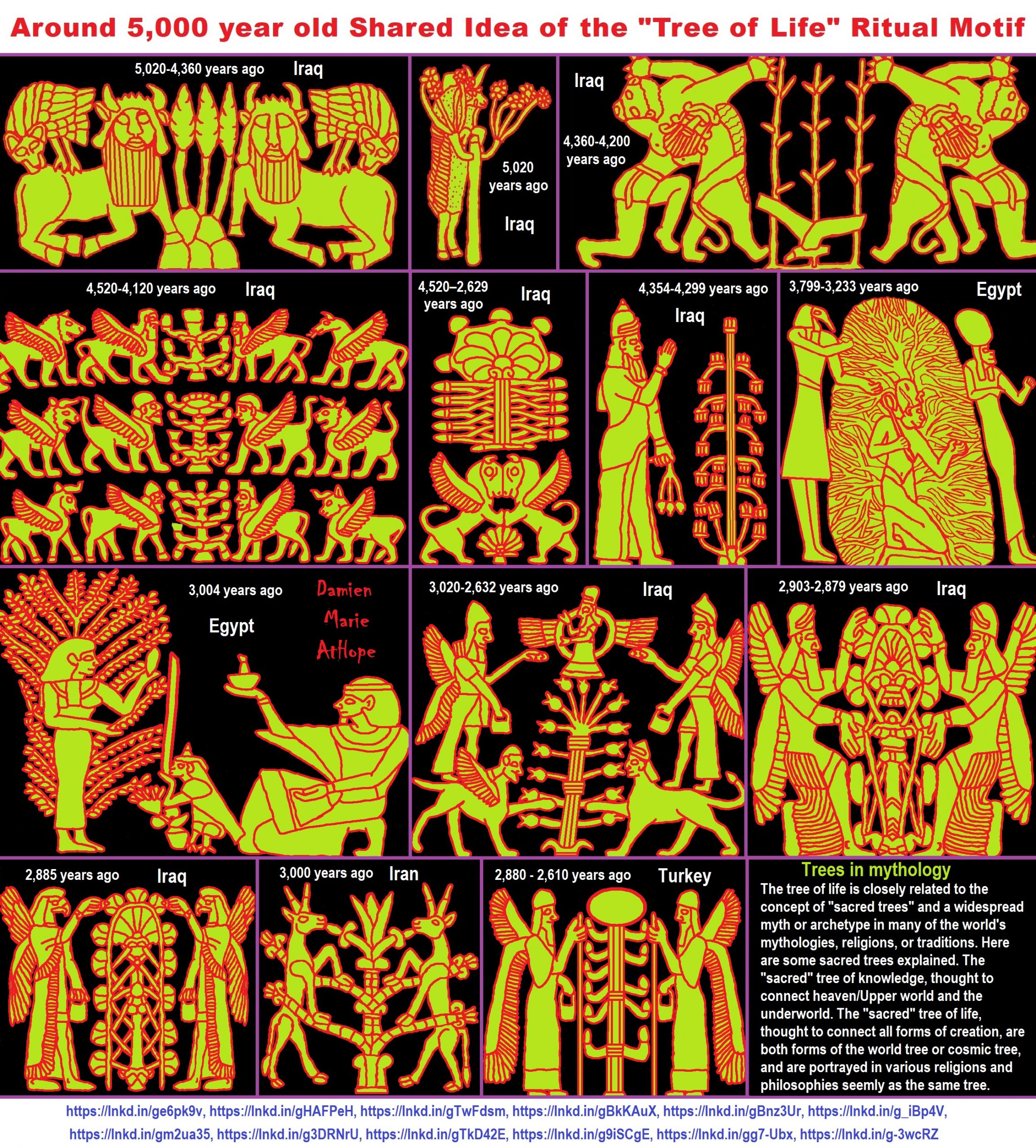


Animism: Respecting the Living World by Graham Harvey
“How have human cultures engaged with and thought about animals, plants, rocks, clouds, and other elements in their natural surroundings? Do animals and other natural objects have a spirit or soul? What is their relationship to humans? In this new study, Graham Harvey explores current and past animistic beliefs and practices of Native Americans, Maori, Aboriginal Australians, and eco-pagans. He considers the varieties of animism found in these cultures as well as their shared desire to live respectfully within larger natural communities. Drawing on his extensive casework, Harvey also considers the linguistic, performative, ecological, and activist implications of these different animisms.” ref

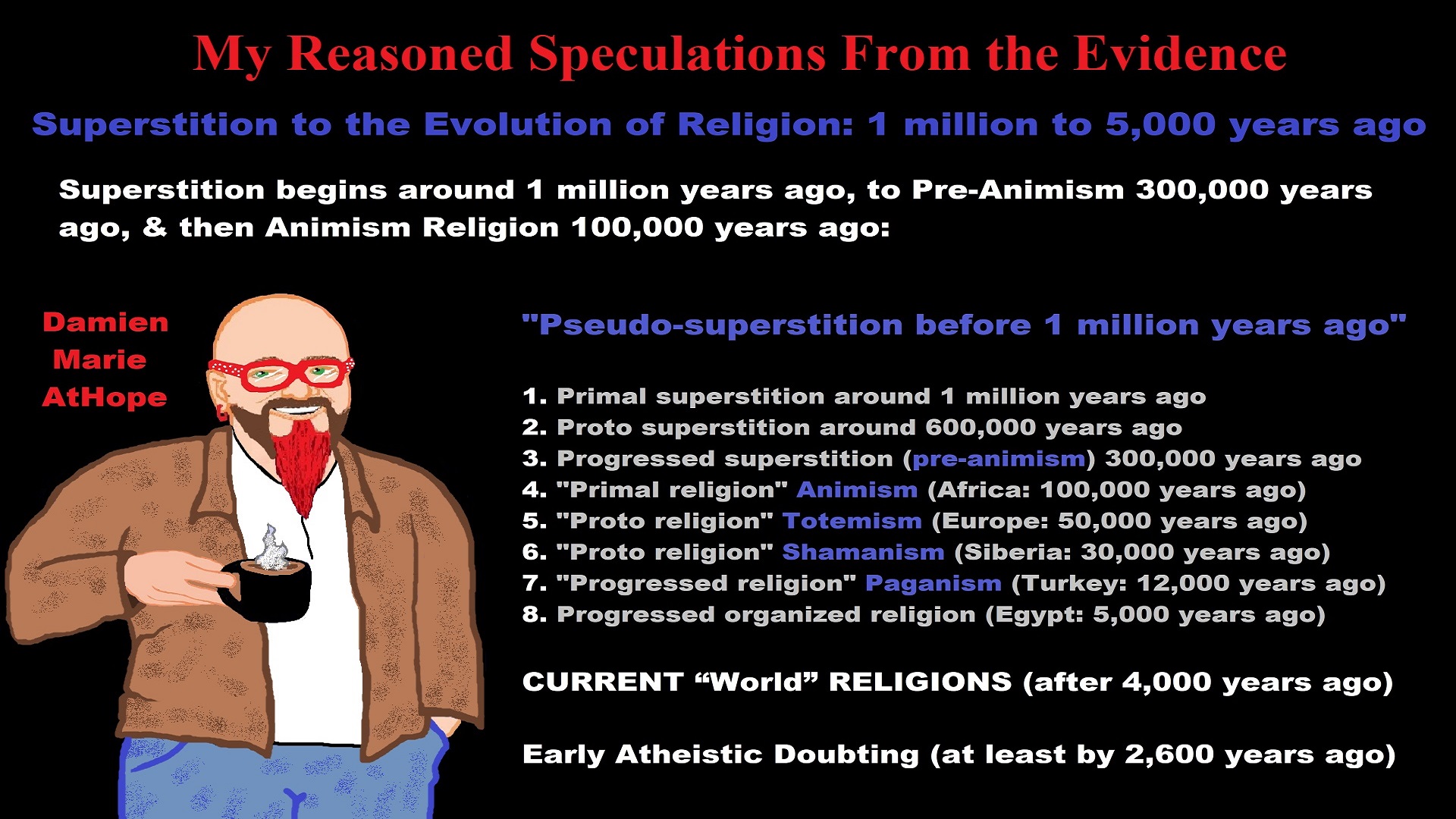
My thoughts on Religion Evolution with external links for more info:
- (Pre-Animism Africa mainly, but also Europe, and Asia at least 300,000 years ago), (Pre-Animism – Oxford Dictionaries)
- (Animism Africa around 100,000 years ago), (Animism – Britannica.com)
- (Totemism Europe around 50,000 years ago), (Totemism – Anthropology)
- (Shamanism Siberia around 30,000 years ago), (Shamanism – Britannica.com)
- (Paganism Turkey around 12,000 years ago), (Paganism – BBC Religion)
- (Progressed Organized Religion “Institutional Religion” Egypt around 5,000 years ago), (Ancient Egyptian Religion – Britannica.com)
- (CURRENT “World” RELIGIONS after 4,000 years ago) (Origin of Major Religions – Sacred Texts)
- (Early Atheistic Doubting at least by 2,600 years ago) (History of Atheism – Wikipedia)
“Religion is an Evolved Product” and Yes, Religion is Like Fear Given Wings…
Atheists talk about gods and religions for the same reason doctors talk about cancer, they are looking for a cure, or a firefighter talks about fires because they burn people and they care to stop them. We atheists too often feel a need to help the victims of mental slavery, held in the bondage that is the false beliefs of gods and the conspiracy theories of reality found in religions.
Understanding Religion Evolution:
- Pre-Animism (at least 300,000 years ago)
- Animism (Africa: 100,000 years ago)
- Totemism (Europe: 50,000 years ago)
- Shamanism (Siberia: 30,000 years ago)
- Paganism (Turkey: 12,000 years ago)
- Progressed organized religion (Egypt: 5,000 years ago), (Egypt, the First Dynasty 5,150 years ago)
- CURRENT “World” RELIGIONS (after 4,000 years ago)
- Early Atheistic Doubting (at least by 2,600 years ago)
“An Archaeological/Anthropological Understanding of Religion Evolution”
It seems ancient peoples had to survived amazing threats in a “dangerous universe (by superstition perceived as good and evil),” and human “immorality or imperfection of the soul” which was thought to affect the still living, leading to ancestor worship. This ancestor worship presumably led to the belief in supernatural beings, and then some of these were turned into the belief in gods. This feeble myth called gods were just a human conceived “made from nothing into something over and over, changing, again and again, taking on more as they evolve, all the while they are thought to be special,” but it is just supernatural animistic spirit-belief perceived as sacred.
Quick Evolution of Religion?
Pre-Animism (at least 300,000 years ago) pre-religion is a beginning that evolves into later Animism. So, Religion as we think of it, to me, all starts in a general way with Animism (Africa: 100,000 years ago) (theoretical belief in supernatural powers/spirits), then this is physically expressed in or with Totemism (Europe: 50,000 years ago) (theoretical belief in mythical relationship with powers/spirits through a totem item), which then enlists a full-time specific person to do this worship and believed interacting Shamanism (Siberia/Russia: 30,000 years ago) (theoretical belief in access and influence with spirits through ritual), and then there is the further employment of myths and gods added to all the above giving you Paganism (Turkey: 12,000 years ago) (often a lot more nature-based than most current top world religions, thus hinting to their close link to more ancient religious thinking it stems from). My hypothesis is expressed with an explanation of the building of a theatrical house (modern religions development). Progressed organized religion (Egypt: 5,000 years ago) with CURRENT “World” RELIGIONS (after 4,000 years ago).
Historically, in large city-state societies (such as Egypt or Iraq) starting around 5,000 years ago culminated to make religion something kind of new, a sociocultural-governmental-religious monarchy, where all or at least many of the people of such large city-state societies seem familiar with and committed to the existence of “religion” as the integrated life identity package of control dynamics with a fixed closed magical doctrine, but this juggernaut integrated religion identity package of Dogmatic-Propaganda certainly did not exist or if developed to an extent it was highly limited in most smaller prehistoric societies as they seem to lack most of the strong control dynamics with a fixed closed magical doctrine (magical beliefs could be at times be added or removed). Many people just want to see developed religious dynamics everywhere even if it is not. Instead, all that is found is largely fragments until the domestication of religion.
Religions, as we think of them today, are a new fad, even if they go back to around 6,000 years in the timeline of human existence, this amounts to almost nothing when seen in the long slow evolution of religion at least around 70,000 years ago with one of the oldest ritual worship. Stone Snake of South Africa: “first human worship” 70,000 years ago. This message of how religion and gods among them are clearly a man-made thing that was developed slowly as it was invented and then implemented peace by peace discrediting them all. Which seems to be a simple point some are just not grasping how devastating to any claims of truth when we can see the lie clearly in the archeological sites.
I wish people fought as hard for the actual values as they fight for the group/clan names political or otherwise they think support values. Every amount spent on war is theft to children in need of food or the homeless kept from shelter.
Here are several of my blog posts on history:
- To Find Truth You Must First Look
- (Magdalenian/Iberomaurusian) Connections to the First Paganists of the early Neolithic Near East Dating from around 17,000 to 12,000 Years Ago
- Natufians: an Ancient People at the Origins of Agriculture and Sedentary Life
- Possible Clan Leader/Special “MALE” Ancestor Totem Poles At Least 13,500 years ago?
- Jewish People with DNA at least 13,200 years old, Judaism, and the Origins of Some of its Ideas
- Baltic Reindeer Hunters: Swiderian, Lyngby, Ahrensburgian, and Krasnosillya cultures 12,020 to 11,020 years ago are evidence of powerful migratory waves during the last 13,000 years and a genetic link to Saami and the Finno-Ugric peoples.
- The Rise of Inequality: patriarchy and state hierarchy inequality
- Fertile Crescent 12,500 – 9,500 Years Ago: fertility and death cult belief system?
- 12,400 – 11,700 Years Ago – Kortik Tepe (Turkey) Pre/early-Agriculture Cultic Ritualism
- Ritualistic Bird Symbolism at Gobekli Tepe and its “Ancestor Cult”
- Male-Homosexual (female-like) / Trans-woman (female) Seated Figurine from Gobekli Tepe
- Could a 12,000-year-old Bull Geoglyph at Göbekli Tepe relate to older Bull and Female Art 25,000 years ago and Later Goddess and the Bull cults like Catal Huyuk?
- Sedentism and the Creation of goddesses around 12,000 years ago as well as male gods after 7,000 years ago.
- Alcohol, where Agriculture and Religion Become one? Such as Gobekli Tepe’s Ritualistic use of Grain as Food and Ritual Drink
- Neolithic Ritual Sites with T-Pillars and other Cultic Pillars
- Paganism: Goddesses around 12,000 years ago then Male Gods after 7,000 years ago
- First Patriarchy: Split of Women’s Status around 12,000 years ago & First Hierarchy: fall of Women’s Status around 5,000 years ago.
- Natufians: an Ancient People at the Origins of Agriculture and Sedentary Life
- J DNA and the Spread of Agricultural Religion (paganism)
- Paganism: an approximately 12,000-year-old belief system
- Paganism 12,000 years old: related to “Anarchism and Socialism” (Pre-Capitalism)
- Shaman burial in Israel 12,000 years ago and the Shamanism Phenomena
- Need to Mythicized: gods and goddesses
- 12,000 – 7,000 Years Ago – Paleo-Indian Culture (The Americas)
- 12,000 – 2,000 Years Ago – Indigenous-Scandinavians (Nordic)
- Norse did not wear helmets with horns?
- Pre-Pottery Neolithic Skull Cult around 11,500 to 8,400 Years Ago?
- 10,400 – 10,100 Years Ago, in Turkey the Nevail Cori Religious Settlement
- 9,000-6,500 Years Old Submerged Pre-Pottery/Pottery Neolithic Ritual Settlements off Israel’s Coast
- Catal Huyuk “first religious designed city” around 9,500 to 7,700 years ago (Turkey)
- Cultic Hunting at Catal Huyuk “first religious designed city”
- Special Items and Art as well as Special Elite Burials at Catal Huyuk
- New Rituals and Violence with the appearance of Pottery and People?
- Haplogroup N and its related Uralic Languages and Cultures
- Ainu people, Sámi people, Native Americans, the Ancient North Eurasians, and Paganistic-Shamanism with Totemism
- Ideas, Technology and People from Turkey, Europe, to China and Back again 9,000 to 5,000 years ago?
- First Pottery of Europe and the Related Cultures
- 9,000 years old Neolithic Artifacts Judean Desert and Hills Israel
- 9,000-7,000 years-old Sex and Death Rituals: Cult Sites in Israel, Jordan, and the Sinai
- 9,000-8500 year old Horned Female shaman Bad Dürrenberg Germany
- Neolithic Jewelry and the Spread of Farming in Europe Emerging out of West Turkey
- 8,600-year-old Tortoise Shells in Neolithic graves in central China have Early Writing and Shamanism
- Swing of the Mace: the rise of Elite, Forced Authority, and Inequality begin to Emerge 8,500 years ago?
- Migrations and Changing Europeans Beginning around 8,000 Years Ago
- My “Steppe-Anatolian-Kurgan hypothesis” 8,000/7,000 years ago
- Around 8,000-year-old Shared Idea of the Mistress of Animals, “Ritual” Motif
- Pre-Columbian Red-Paint (red ochre) Maritime Archaic Culture 8,000-3,000 years ago
- 7,522-6,522 years ago Linear Pottery culture which I think relates to Arcane Capitalism’s origins
- Arcane Capitalism: Primitive socialism, Primitive capital, Private ownership, Means of production, Market capitalism, Class discrimination, and Petite bourgeoisie (smaller capitalists)
- 7,500-4,750 years old Ritualistic Cucuteni-Trypillian culture of Moldova, Romania, and Ukraine
- Roots of a changing early society 7,200-6,700 years ago Jordan and Israel
- Agriculture religion (Paganism) with farming reached Britain between about 7,000 to 6,500 or so years ago and seemingly expressed in things like Western Europe’s Long Barrows
- My Thoughts on Possible Migrations of “R” DNA and Proto-Indo-European?
- “Millet” Spreading from China 7,022 years ago to Europe and related Language may have Spread with it leading to Proto-Indo-European
- Proto-Indo-European (PIE), ancestor of Indo-European languages: DNA, Society, Language, and Mythology
- The Dnieper–Donets culture and Asian varieties of Millet from China to the Black Sea region of Europe by 7,022 years ago
- Kurgan 6,000 years ago/dolmens 7,000 years ago: funeral, ritual, and other?
- 7,020 to 6,020-year-old Proto-Indo-European Homeland of Urheimat or proposed home of their Language and Religion
- Ancient Megaliths: Kurgan, Ziggurat, Pyramid, Menhir, Trilithon, Dolman, Kromlech, and Kromlech of Trilithons
- The Mytheme of Ancient North Eurasian Sacred-Dog belief and similar motifs are found in Indo-European, Native American, and Siberian comparative mythology
- Elite Power Accumulation: Ancient Trade, Tokens, Writing, Wealth, Merchants, and Priest-Kings
- Sacred Mounds, Mountains, Kurgans, and Pyramids may hold deep connections?
- Between 7,000-5,000 Years ago, rise of unequal hierarchy elite, leading to a “birth of the State” or worship of power, strong new sexism, oppression of non-elites, and the fall of Women’s equal status
- Paganism 7,000-5,000 years old: related to “Anarchism and Socialism” (Capitalism) (World War 0) Elite & their slaves
- Hell and Underworld mythologies starting maybe as far back as 7,000 to 5,000 years ago with the Proto-Indo-Europeans?
- The First Expression of the Male God around 7,000 years ago?
- White (light complexion skin) Bigotry and Sexism started 7,000 years ago?
- Around 7,000-year-old Shared Idea of the Divine Bird (Tutelary and/or Trickster spirit/deity), “Ritual” Motif
- Nekhbet an Ancient Egyptian Vulture Goddess and Tutelary Deity
- 6,720 to 4,920 years old Ritualistic Hongshan Culture of Inner Mongolia with 5,000-year-old Pyramid Mounds and Temples
- First proto-king in the Balkans, Varna culture around 6,500 years ago?
- 6,500–5,800 years ago in Israel Late Chalcolithic (Copper Age) Period in the Southern Levant Seems to Express Northern Levant Migrations, Cultural and Religious Transfer
- KING OF BEASTS: Master of Animals “Ritual” Motif, around 6,000 years old or older…
- Around 6000-year-old Shared Idea of the Solid Wheel & the Spoked Wheel-Shaped Ritual Motif
- “The Ghassulian Star,” a mysterious 6,000-year-old mural from Jordan; a Proto-Star of Ishtar, Star of Inanna or Star of Venus?
- Religious/Ritual Ideas, including goddesses and gods as well as ritual mounds or pyramids from Northeastern Asia at least 6,000 years old, seemingly filtering to Iran, Iraq, the Mediterranean, Europe, Egypt, and the Americas?
- Maykop (5,720–5,020 years ago) Caucasus region Bronze Age culture-related to Copper Age farmers from the south, influenced by the Ubaid period and Leyla-Tepe culture, as well as influencing the Kura-Araxes culture
- 5-600-year-old Tomb, Mummy, and First Bearded Male Figurine in a Grave
- Kura-Araxes Cultural 5,520 to 4,470 years old DNA traces to the Canaanites, Arabs, and Jews
- Minoan/Cretan (Keftiu) Civilization and Religion around 5,520 to 3,120 years ago
- Evolution Of Science at least by 5,500 years ago
- 5,500 Years old birth of the State, the rise of Hierarchy, and the fall of Women’s status
- “Jiroft culture” 5,100 – 4,200 years ago and the History of Iran
- Stonehenge: Paganistic Burial and Astrological Ritual Complex, England (5,100-3,600 years ago)
- Around 5,000-year-old Shared Idea of the “Tree of Life” Ritual Motif
- Complex rituals for elite, seen from China to Egypt, at least by 5,000 years ago
- Around 5,000 years ago: “Birth of the State” where Religion gets Military Power and Influence
- The Center of the World “Axis Mundi” and/or “Sacred Mountains” Mythology Could Relate to the Altai Mountains, Heart of the Steppe
- Progressed organized religion starts, an approximately 5,000-year-old belief system
- China’s Civilization between 5,000-3,000 years ago, was a time of war and class struggle, violent transition from free clans to a Slave or Elite society
- Origin of Logics is Naturalistic Observation at least by around 5,000 years ago.
- Paganism 5,000 years old: progressed organized religion and the state: related to “Anarchism and Socialism” (Kings and the Rise of the State)
- Ziggurats (multi-platform temples: 4,900 years old) to Pyramids (multi-platform tombs: 4,700 years old)
- Did a 4,520–4,420-year-old Volcano In Turkey Inspire the Bible God?
- Finland’s Horned Shaman and Pre-Horned-God at least 4,500 years ago?
- 4,000-year-Old Dolmens in Israel: A Connected Dolmen Religious Phenomenon?
- Creation myths: From chaos, Ex nihilo, Earth-diver, Emergence, World egg, and World parent
- Bronze Age “Ritual” connections of the Bell Beaker culture with the Corded Ware/Single Grave culture, which were related to the Yamnaya culture and Proto-Indo-European Languages/Religions
- Low Gods (Earth/ Tutelary deity), High Gods (Sky/Supreme deity), and Moralistic Gods (Deity enforcement/divine order)
- The exchange of people, ideas, and material-culture including, to me, the new god (Sky Father) and goddess (Earth Mother) religion between the Cucuteni-Trypillians and others which is then spread far and wide
- Koryaks: Indigenous People of the Russian Far East and Big Raven myths also found in Tlingit, Haida, Tsimshian, and other Indigenous People of North America
- 42 Principles Of Maat (Egyptian Goddess of the justice) around 4,400 years ago, 2000 Years Before Ten Commandments
- “Happy Easter” Well Happy Eostre/Ishter
- 4,320-3,820 years old “Shimao” (North China) site with Totemistic-Shamanistic Paganism and a Stepped Pyramid
- 4,250 to 3,400 Year old Stonehenge from Russia: Arkaim?
- 4,100-year-old beaker with medicinal & flowering plants in a grave of a woman in Scotland
- Early European Farmer ancestry, Kelif el Boroud people with the Cardial Ware culture, and the Bell Beaker culture Paganists too, spread into North Africa, then to the Canary Islands off West Africa
- Flood Accounts: Gilgamesh epic (4,100 years ago) Noah in Genesis (2,600 years ago)
- Paganism 4,000 years old: related to “Anarchism and Socialism” (First Moralistic gods, then the Origin time of Monotheism)
- When was the beginning: TIMELINE OF CURRENT RELIGIONS, which start around 4,000 years ago.
- Early Religions Thought to Express Proto-Monotheistic Systems around 4,000 years ago
- Kultepe? An archaeological site with a 4,000 years old women’s rights document.
- Single God Religions (Monotheism) = “Man-o-theism” started around 4,000 years ago with the Great Sky Spirit/God Tiān (天)?
- Confucianism’s Tiān (Shangdi god 4,000 years old): Supernaturalism, Pantheism or Theism?
- Yes, Your Male God is Ridiculous
- Mythology, a Lunar Deity is a Goddess or God of the Moon
- Sacred Land, Hills, and Mountains: Sami Mythology (Paganistic Shamanism)
- Horse Worship/Sacrifice: mythical union of Ruling Elite/Kingship and the Horse
- The Amorite/Amurru people’s God Amurru “Lord of the Steppe”, relates to the Origins of the Bible God?
- Bronze Age Exotic Trade Routes Spread Quite Far as well as Spread Religious Ideas with Them
- Sami and the Northern Indigenous Peoples Landscape, Language, and its Connection to Religion
- Prototype of Ancient Analemmatic Sundials around 3,900-3,150 years ago and a Possible Solar Connection to gods?
- Judaism is around 3,450 or 3,250 years old. (“Paleo-Hebrew” 3,000 years ago and Torah 2,500 years ago)
- The Weakening of Ancient Trade and the Strengthening of Religions around 3000 years ago?
- Are you aware that there are religions that worship women gods, explain now religion tears women down?
- Animistic, Totemistic, and Paganistic Superstition Origins of bible god and the bible’s Religion.
- Myths and Folklore: “Trickster gods and goddesses”
- Jews, Judaism, and the Origins of Some of its Ideas
- An Old Branch of Religion Still Giving Fruit: Sacred Trees
- Dating the BIBLE: naming names and telling times (written less than 3,000 years ago, provable to 2,200 years ago)
- Did a Volcano Inspire the bible god?
- The Amorite/Amurru people’s God Amurru “Lord of the Steppe”, relates to the Origins of the Bible God?
- Dené–Yeniseian language, Old Copper Complex, and Pre-Columbian Mound Builders?
- No “dinosaurs and humans didn’t exist together just because some think they are in the bible itself”
- Sacred Shit and Sacred Animals?
- Everyone Killed in the Bible Flood? “Nephilim” (giants)?
- Hey, Damien dude, I have a question for you regarding “the bible” Exodus.
- Archaeology Disproves the Bible
- Bible Battle, Just More, Bible Babble
- The Jericho Conquest lie?
- Canaanites and Israelites?
- Accurate Account on how did Christianity Began?
- Let’s talk about Christianity.
- So the 10 commandments isn’t anything to go by either right?
- Misinformed christian
- Debunking Jesus?
- Paulism vs Jesus
- Ok, you seem confused so let’s talk about Buddhism.
- Unacknowledged Buddhism: Gods, Savior, Demons, Rebirth, Heavens, Hells, and Terrorism
- His Foolishness The Dalai Lama
- Yin and Yang is sexist with an ORIGIN around 2,300 years ago?
- I Believe Archaeology, not Myths & Why Not, as the Religious Myths Already Violate Reason!
- Archaeological, Scientific, & Philosophic evidence shows the god myth is man-made nonsense.
- Aquatic Ape Theory/Hypothesis? As Always, Just Pseudoscience.
- Ancient Aliens Conspiracy Theorists are Pseudohistorians
- The Pseudohistoric and Pseudoscientific claims about “Bakoni Ruins” of South Africa
- Why do people think Religion is much more than supernaturalism and superstitionism?
- Religion is an Evolved Product
- Was the Value of Ancient Women Different?
- 1000 to 1100 CE, human sacrifice Cahokia Mounds a pre-Columbian Native American site
- Feminist atheists as far back as the 1800s?
- Promoting Religion as Real is Mentally Harmful to a Flourishing Humanity
- Screw All Religions and Their Toxic lies, they are all fraud
- Forget Religions’ Unfounded Myths, I Have Substantiated “Archaeology Facts.”
- Religion Dispersal throughout the World
- I Hate Religion Just as I Hate all Pseudoscience
- Exposing Scientology, Eckankar, Wicca and Other Nonsense?
- Main deity or religious belief systems
- Quit Trying to Invent Your God From the Scraps of Science.
- Archaeological, Scientific, & Philosophic evidence shows the god myth is man-made nonsense.
- Ancient Alien Conspiracy Theorists: Misunderstanding, Rhetoric, Misinformation, Fabrications, and Lies
- Misinformation, Distortion, and Pseudoscience in Talking with a Christian Creationist
- Judging the Lack of Goodness in Gods, Even the Norse God Odin
- Challenging the Belief in God-like Aliens and Gods in General
- A Challenge to Christian use of Torture Devices?
- Yes, Hinduism is a Religion
- Trump is One of the Most Reactionary Forces of Far-right Christian Extremism
- Was the Bull Head a Symbol of God? Yes!
- Primate Death Rituals
- Christian – “God and Christianity are objectively true”
- Australopithecus afarensis Death Ritual?
- You Claim Global Warming is a Hoax?
- Doubter of Science and Defamer of Atheists?
- I think that sounds like the Bible?
- History of the Antifa (“anti-fascist”) Movements
- Indianapolis Anti-Blasphemy Laws #Free Soheil Rally
- Damien, you repeat the golden rule in so many forms then you say religion is dogmatic?
- Science is a Trustable Methodology whereas Faith is not Trustable at all!
- Was I ever a believer, before I was an atheist?
- Atheists rise in reason
- Mistrust of science?
- Open to Talking About the Definition of ‘God’? But first, we address Faith.
- ‘United Monarchy’ full of splendor and power – Saul, David, and Solomon? Most likely not.
- Is there EXODUS ARCHAEOLOGY? The short answer is “no.”
- Lacking Proof of Bigfoots, Unicorns, and Gods is Just a Lack of Research?
- Religion and Politics: Faith Beliefs vs. Rational Thinking
- Hammer of Truth that lying pig RELIGION: challenged by an archaeologist
- “The Hammer of Truth” -ontology question- What do You Mean by That?
- Navigation of a bad argument: Ad Hominem vs. Attack
- Why is it Often Claimed that Gods have a Gender?
- Why are basically all monotheistic religions ones that have a male god?
- Shifting through the Claims in support of Faith
- Dear Mr. AtHope, The 20th Century is an Indictment of Secularism and a Failed Atheist Century
- An Understanding of the Worldwide Statistics and Dynamics of Terrorist Incidents and Suicide Attacks
- Intoxication and Evolution? Addressing and Assessing the “Stoned Ape” or “Drunken Monkey” Theories as Catalysts in Human Evolution
- Sacred Menstrual cloth? Inanna’s knot, Isis knot, and maybe Ma’at’s feather?
- Damien, why don’t the Hebrews accept the bible stories?
- Dealing with a Troll and Arguing Over Word Meaning
- Knowledge without Belief? Justified beliefs or disbeliefs worthy of Knowledge?
- Afrocentrism and African Religions
- Crecganford @crecganford offers history & stories of the people, places, gods, & culture
- Empiricism-Denier?
I am not an academic. I am a revolutionary that teaches in public, in places like social media, and in the streets. I am not a leader by some title given but from my commanding leadership style of simply to start teaching everywhere to everyone, all manner of positive education.




ref, ref, ref, ref, ref, ref, ref, ref, ref, ref, ref, ref, ref, ref, ref, ref, ref, ref, ref, ref, ref
Low Gods “Earth” or Tutelary deity and High Gods “Sky” or Supreme deity
“An Earth goddess is a deification of the Earth. Earth goddesses are often associated with the “chthonic” deities of the underworld. Ki and Ninhursag are Mesopotamian earth goddesses. In Greek mythology, the Earth is personified as Gaia, corresponding to Roman Terra, Indic Prithvi/Bhūmi, etc. traced to an “Earth Mother” complementary to the “Sky Father” in Proto-Indo-European religion. Egyptian mythology exceptionally has a sky goddess and an Earth god.” ref
“A mother goddess is a goddess who represents or is a personification of nature, motherhood, fertility, creation, destruction or who embodies the bounty of the Earth. When equated with the Earth or the natural world, such goddesses are sometimes referred to as Mother Earth or as the Earth Mother. In some religious traditions or movements, Heavenly Mother (also referred to as Mother in Heaven or Sky Mother) is the wife or feminine counterpart of the Sky father or God the Father.” ref
“Any masculine sky god is often also king of the gods, taking the position of patriarch within a pantheon. Such king gods are collectively categorized as “sky father” deities, with a polarity between sky and earth often being expressed by pairing a “sky father” god with an “earth mother” goddess (pairings of a sky mother with an earth father are less frequent). A main sky goddess is often the queen of the gods and may be an air/sky goddess in her own right, though she usually has other functions as well with “sky” not being her main. In antiquity, several sky goddesses in ancient Egypt, Mesopotamia, and the Near East were called Queen of Heaven. Neopagans often apply it with impunity to sky goddesses from other regions who were never associated with the term historically. The sky often has important religious significance. Many religions, both polytheistic and monotheistic, have deities associated with the sky.” ref
“In comparative mythology, sky father is a term for a recurring concept in polytheistic religions of a sky god who is addressed as a “father”, often the father of a pantheon and is often either a reigning or former King of the Gods. The concept of “sky father” may also be taken to include Sun gods with similar characteristics, such as Ra. The concept is complementary to an “earth mother“. “Sky Father” is a direct translation of the Vedic Dyaus Pita, etymologically descended from the same Proto-Indo-European deity name as the Greek Zeûs Pater and Roman Jupiter and Germanic Týr, Tir or Tiwaz, all of which are reflexes of the same Proto-Indo-European deity’s name, *Dyēus Ph₂tḗr. While there are numerous parallels adduced from outside of Indo-European mythology, there are exceptions (e.g. In Egyptian mythology, Nut is the sky mother and Geb is the earth father).” ref
Tutelary deity
“A tutelary (also tutelar) is a deity or spirit who is a guardian, patron, or protector of a particular place, geographic feature, person, lineage, nation, culture, or occupation. The etymology of “tutelary” expresses the concept of safety and thus of guardianship. In late Greek and Roman religion, one type of tutelary deity, the genius, functions as the personal deity or daimon of an individual from birth to death. Another form of personal tutelary spirit is the familiar spirit of European folklore.” ref
“A tutelary (also tutelar) in Korean shamanism, jangseung and sotdae were placed at the edge of villages to frighten off demons. They were also worshiped as deities. Seonangshin is the patron deity of the village in Korean tradition and was believed to embody the Seonangdang. In Philippine animism, Diwata or Lambana are deities or spirits that inhabit sacred places like mountains and mounds and serve as guardians. Such as: Maria Makiling is the deity who guards Mt. Makiling and Maria Cacao and Maria Sinukuan. In Shinto, the spirits, or kami, which give life to human bodies come from nature and return to it after death. Ancestors are therefore themselves tutelaries to be worshiped. And similarly, Native American beliefs such as Tonás, tutelary animal spirit among the Zapotec and Totems, familial or clan spirits among the Ojibwe, can be animals.” ref
“A tutelary (also tutelar) in Austronesian beliefs such as: Atua (gods and spirits of the Polynesian peoples such as the Māori or the Hawaiians), Hanitu (Bunun of Taiwan‘s term for spirit), Hyang (Kawi, Sundanese, Javanese, and Balinese Supreme Being, in ancient Java and Bali mythology and this spiritual entity, can be either divine or ancestral), Kaitiaki (New Zealand Māori term used for the concept of guardianship, for the sky, the sea, and the land), Kawas (mythology) (divided into 6 groups: gods, ancestors, souls of the living, spirits of living things, spirits of lifeless objects, and ghosts), Tiki (Māori mythology, Tiki is the first man created by either Tūmatauenga or Tāne and represents deified ancestors found in most Polynesian cultures). ” ref, ref, ref, ref, ref, ref, ref
Mesopotamian Tutelary Deities can be seen as ones related to City-States
“Historical city-states included Sumerian cities such as Uruk and Ur; Ancient Egyptian city-states, such as Thebes and Memphis; the Phoenician cities (such as Tyre and Sidon); the five Philistine city-states; the Berber city-states of the Garamantes; the city-states of ancient Greece (the poleis such as Athens, Sparta, Thebes, and Corinth); the Roman Republic (which grew from a city-state into a vast empire); the Italian city-states from the Middle Ages to the early modern period, such as Florence, Siena, Ferrara, Milan (which as they grew in power began to dominate neighboring cities) and Genoa and Venice, which became powerful thalassocracies; the Mayan and other cultures of pre-Columbian Mesoamerica (including cities such as Chichen Itza, Tikal, Copán and Monte Albán); the central Asian cities along the Silk Road; the city-states of the Swahili coast; Ragusa; states of the medieval Russian lands such as Novgorod and Pskov; and many others.” ref
“The Uruk period (ca. 4000 to 3100 BCE; also known as Protoliterate period) of Mesopotamia, named after the Sumerian city of Uruk, this period saw the emergence of urban life in Mesopotamia and the Sumerian civilization. City-States like Uruk and others had a patron tutelary City Deity along with a Priest-King.” ref
“Chinese folk religion, both past, and present, includes myriad tutelary deities. Exceptional individuals, highly cultivated sages, and prominent ancestors can be deified and honored after death. Lord Guan is the patron of military personnel and police, while Mazu is the patron of fishermen and sailors. Such as Tu Di Gong (Earth Deity) is the tutelary deity of a locality, and each individual locality has its own Earth Deity and Cheng Huang Gong (City God) is the guardian deity of an individual city, worshipped by local officials and locals since imperial times.” ref
“A tutelary (also tutelar) in Hinduism, personal tutelary deities are known as ishta-devata, while family tutelary deities are known as Kuladevata. Gramadevata are guardian deities of villages. Devas can also be seen as tutelary. Shiva is the patron of yogis and renunciants. City goddesses include: Mumbadevi (Mumbai), Sachchika (Osian); Kuladevis include: Ambika (Porwad), and Mahalakshmi. In NorthEast India Meitei mythology and religion (Sanamahism) of Manipur, there are various types of tutelary deities, among which Lam Lais are the most predominant ones. Tibetan Buddhism has Yidam as a tutelary deity. Dakini is the patron of those who seek knowledge.” ref
“A tutelary (also tutelar) The Greeks also thought deities guarded specific places: for instance, Athena was the patron goddess of the city of Athens. Socrates spoke of hearing the voice of his personal spirit or daimonion:
You have often heard me speak of an oracle or sign which comes to me … . This sign I have had ever since I was a child. The sign is a voice which comes to me and always forbids me to do something which I am going to do, but never commands me to do anything, and this is what stands in the way of my being a politician.” ref
“Tutelary deities who guard and preserve a place or a person are fundamental to ancient Roman religion. The tutelary deity of a man was his Genius, that of a woman her Juno. In the Imperial era, the Genius of the Emperor was a focus of Imperial cult. An emperor might also adopt a major deity as his personal patron or tutelary, as Augustus did Apollo. Precedents for claiming the personal protection of a deity were established in the Republican era, when for instance the Roman dictator Sulla advertised the goddess Victory as his tutelary by holding public games (ludi) in her honor.” ref
“Each town or city had one or more tutelary deities, whose protection was considered particularly vital in time of war and siege. Rome itself was protected by a goddess whose name was to be kept ritually secret on pain of death (for a supposed case, see Quintus Valerius Soranus). The Capitoline Triad of Juno, Jupiter, and Minerva were also tutelaries of Rome. The Italic towns had their own tutelary deities. Juno often had this function, as at the Latin town of Lanuvium and the Etruscan city of Veii, and was often housed in an especially grand temple on the arx (citadel) or other prominent or central location. The tutelary deity of Praeneste was Fortuna, whose oracle was renowned.” ref
“The Roman ritual of evocatio was premised on the belief that a town could be made vulnerable to military defeat if the power of its tutelary deity were diverted outside the city, perhaps by the offer of superior cult at Rome. The depiction of some goddesses such as the Magna Mater (Great Mother, or Cybele) as “tower-crowned” represents their capacity to preserve the city. A town in the provinces might adopt a deity from within the Roman religious sphere to serve as its guardian, or syncretize its own tutelary with such; for instance, a community within the civitas of the Remi in Gaul adopted Apollo as its tutelary, and at the capital of the Remi (present-day Rheims), the tutelary was Mars Camulus.” ref
Household deity (a kind of or related to a Tutelary deity)
“A household deity is a deity or spirit that protects the home, looking after the entire household or certain key members. It has been a common belief in paganism as well as in folklore across many parts of the world. Household deities fit into two types; firstly, a specific deity – typically a goddess – often referred to as a hearth goddess or domestic goddess who is associated with the home and hearth, such as the ancient Greek Hestia.” ref
“The second type of household deities are those that are not one singular deity, but a type, or species of animistic deity, who usually have lesser powers than major deities. This type was common in the religions of antiquity, such as the Lares of ancient Roman religion, the Gashin of Korean shamanism, and Cofgodas of Anglo-Saxon paganism. These survived Christianisation as fairy-like creatures existing in folklore, such as the Anglo-Scottish Brownie and Slavic Domovoy.” ref
“Household deities were usually worshipped not in temples but in the home, where they would be represented by small idols (such as the teraphim of the Bible, often translated as “household gods” in Genesis 31:19 for example), amulets, paintings, or reliefs. They could also be found on domestic objects, such as cosmetic articles in the case of Tawaret. The more prosperous houses might have a small shrine to the household god(s); the lararium served this purpose in the case of the Romans. The gods would be treated as members of the family and invited to join in meals, or be given offerings of food and drink.” ref
“In many religions, both ancient and modern, a god would preside over the home. Certain species, or types, of household deities, existed. An example of this was the Roman Lares. Many European cultures retained house spirits into the modern period. Some examples of these include:
- Brownie (Scotland and England) or Hob (England) / Kobold (Germany) / Goblin / Hobgoblin
- Domovoy (Slavic)
- Nisse (Norwegian or Danish) / Tomte (Swedish) / Tonttu (Finnish)
- Húsvættir (Norse)” ref
“Although the cosmic status of household deities was not as lofty as that of the Twelve Olympians or the Aesir, they were also jealous of their dignity and also had to be appeased with shrines and offerings, however humble. Because of their immediacy they had arguably more influence on the day-to-day affairs of men than the remote gods did. Vestiges of their worship persisted long after Christianity and other major religions extirpated nearly every trace of the major pagan pantheons. Elements of the practice can be seen even today, with Christian accretions, where statues to various saints (such as St. Francis) protect gardens and grottos. Even the gargoyles found on older churches, could be viewed as guardians partitioning a sacred space.” ref
“For centuries, Christianity fought a mop-up war against these lingering minor pagan deities, but they proved tenacious. For example, Martin Luther‘s Tischreden have numerous – quite serious – references to dealing with kobolds. Eventually, rationalism and the Industrial Revolution threatened to erase most of these minor deities, until the advent of romantic nationalism rehabilitated them and embellished them into objects of literary curiosity in the 19th century. Since the 20th century this literature has been mined for characters for role-playing games, video games, and other fantasy personae, not infrequently invested with invented traits and hierarchies somewhat different from their mythological and folkloric roots.” ref
“In contradistinction to both Herbert Spencer and Edward Burnett Tylor, who defended theories of animistic origins of ancestor worship, Émile Durkheim saw its origin in totemism. In reality, this distinction is somewhat academic, since totemism may be regarded as a particularized manifestation of animism, and something of a synthesis of the two positions was attempted by Sigmund Freud. In Freud’s Totem and Taboo, both totem and taboo are outward expressions or manifestations of the same psychological tendency, a concept which is complementary to, or which rather reconciles, the apparent conflict. Freud preferred to emphasize the psychoanalytic implications of the reification of metaphysical forces, but with particular emphasis on its familial nature. This emphasis underscores, rather than weakens, the ancestral component.” ref
“William Edward Hearn, a noted classicist, and jurist, traced the origin of domestic deities from the earliest stages as an expression of animism, a belief system thought to have existed also in the neolithic, and the forerunner of Indo-European religion. In his analysis of the Indo-European household, in Chapter II “The House Spirit”, Section 1, he states:
The belief which guided the conduct of our forefathers was … the spirit rule of dead ancestors.” ref
“In Section 2 he proceeds to elaborate:
It is thus certain that the worship of deceased ancestors is a vera causa, and not a mere hypothesis. …
In the other European nations, the Slavs, the Teutons, and the Kelts, the House Spirit appears with no less distinctness. … [T]he existence of that worship does not admit of doubt. … The House Spirits had a multitude of other names which it is needless here to enumerate, but all of which are more or less expressive of their friendly relations with man. … In [England] … [h]e is the Brownie. … In Scotland this same Brownie is well known. He is usually described as attached to particular families, with whom he has been known to reside for centuries, threshing the corn, cleaning the house, and performing similar household tasks. His favorite gratification was milk and honey.” ref

Hinduism around 3,700 to 3,500 years old. ref
Judaism around 3,450 or 3,250 years old. (The first writing in the bible was “Paleo-Hebrew” dated to around 3,000 years ago Khirbet Qeiyafa is the site of an ancient fortress city overlooking the Elah Valley. And many believe the religious Jewish texts were completed around 2,500) ref, ref
Judaism is around 3,450 or 3,250 years old. (“Paleo-Hebrew” 3,000 years ago and Torah 2,500 years ago)
“Judaism is an Abrahamic, its roots as an organized religion in the Middle East during the Bronze Age. Some scholars argue that modern Judaism evolved from Yahwism, the religion of ancient Israel and Judah, by the late 6th century BCE, and is thus considered to be one of the oldest monotheistic religions.” ref
“Yahwism is the name given by modern scholars to the religion of ancient Israel, essentially polytheistic, with a plethora of gods and goddesses. Heading the pantheon was Yahweh, the national god of the Israelite kingdoms of Israel and Judah, with his consort, the goddess Asherah; below them were second-tier gods and goddesses such as Baal, Shamash, Yarikh, Mot, and Astarte, all of whom had their own priests and prophets and numbered royalty among their devotees, and a third and fourth tier of minor divine beings, including the mal’ak, the messengers of the higher gods, who in later times became the angels of Judaism, Christianity and Islam. Yahweh, however, was not the ‘original’ god of Israel “Isra-El”; it is El, the head of the Canaanite pantheon, whose name forms the basis of the name “Israel”, and none of the Old Testament patriarchs, the tribes of Israel, the Judges, or the earliest monarchs, have a Yahwistic theophoric name (i.e., one incorporating the name of Yahweh).” ref
“El is a Northwest Semitic word meaning “god” or “deity“, or referring (as a proper name) to any one of multiple major ancient Near Eastern deities. A rarer form, ‘ila, represents the predicate form in Old Akkadian and in Amorite. The word is derived from the Proto-Semitic *ʔil-, meaning “god”. Specific deities known as ‘El or ‘Il include the supreme god of the ancient Canaanite religion and the supreme god of East Semitic speakers in Mesopotamia’s Early Dynastic Period. ʼĒl is listed at the head of many pantheons. In some Canaanite and Ugaritic sources, ʼĒl played a role as father of the gods, of creation, or both. For example, in the Ugaritic texts, ʾil mlk is understood to mean “ʼĒl the King” but ʾil hd as “the god Hadad“. The Semitic root ʾlh (Arabic ʾilāh, Aramaic ʾAlāh, ʾElāh, Hebrew ʾelōah) may be ʾl with a parasitic h, and ʾl may be an abbreviated form of ʾlh. In Ugaritic the plural form meaning “gods” is ʾilhm, equivalent to Hebrew ʾelōhîm “powers”. In the Hebrew texts this word is interpreted as being semantically singular for “god” by biblical commentators. However the documentary hypothesis for the Old Testament (corresponds to the Jewish Torah) developed originally in the 1870s, identifies these that different authors – the Jahwist, Elohist, Deuteronomist, and the Priestly source – were responsible for editing stories from a polytheistic religion into those of a monotheistic religion. Inconsistencies that arise between monotheism and polytheism in the texts are reflective of this hypothesis.” ref
Jainism around 2,599 – 2,527 years old. ref
Confucianism around 2,600 – 2,551 years old. ref
Buddhism around 2,563/2,480 – 2,483/2,400 years old. ref
Christianity around 2,o00 years old. ref
Shinto around 1,305 years old. ref
Islam around 1407–1385 years old. ref

Knowledge to Ponder:
Stars/Astrology:
- Possibly, around 30,000 years ago (in simpler form) to 6,000 years ago, Stars/Astrology are connected to Ancestors, Spirit Animals, and Deities.
- The star also seems to be a possible proto-star for Star of Ishtar, Star of Inanna, or Star of Venus.
- Around 7,000 to 6,000 years ago, Star Constellations/Astrology have connections to the “Kurgan phenomenon” of below-ground “mound” stone/wood burial structures and “Dolmen phenomenon” of above-ground stone burial structures.
- Around 6,500–5,800 years ago, The Northern Levant migrations into Jordon and Israel in the Southern Levant brought new cultural and religious transfer from Turkey and Iran.
- “The Ghassulian Star,” a mysterious 6,000-year-old mural from Jordan may have connections to the European paganstic kurgan/dolmens phenomenon.
“Astrology is a range of divinatory practices, recognized as pseudoscientific since the 18th century, that claim to discern information about human affairs and terrestrial events by studying the apparent positions of celestial objects. Different cultures have employed forms of astrology since at least the 2nd millennium BCE, these practices having originated in calendrical systems used to predict seasonal shifts and to interpret celestial cycles as signs of divine communications. Most, if not all, cultures have attached importance to what they observed in the sky, and some—such as the Hindus, Chinese, and the Maya—developed elaborate systems for predicting terrestrial events from celestial observations. Western astrology, one of the oldest astrological systems still in use, can trace its roots to 19th–17th century BCE Mesopotamia, from where it spread to Ancient Greece, Rome, the Islamicate world and eventually Central and Western Europe. Contemporary Western astrology is often associated with systems of horoscopes that purport to explain aspects of a person’s personality and predict significant events in their lives based on the positions of celestial objects; the majority of professional astrologers rely on such systems.” ref
Around 5,500 years ago, Science evolves, The first evidence of science was 5,500 years ago and was demonstrated by a body of empirical, theoretical, and practical knowledge about the natural world. ref
Around 5,000 years ago, Origin of Logics is a Naturalistic Observation (principles of valid reasoning, inference, & demonstration) ref
Around 4,150 to 4,000 years ago: The earliest surviving versions of the Sumerian Epic of Gilgamesh, which was originally titled “He who Saw the Deep” (Sha naqba īmuru) or “Surpassing All Other Kings” (Shūtur eli sharrī) were written. ref
Hinduism:
- 3,700 years ago or so, the oldest of the Hindu Vedas (scriptures), the Rig Veda was composed.
- 3,500 years ago or so, the Vedic Age began in India after the collapse of the Indus Valley Civilization.
Judaism:
- around 3,000 years ago, the first writing in the bible was “Paleo-Hebrew”
- around 2,500 years ago, many believe the religious Jewish texts were completed
Myths: The bible inspired religion is not just one religion or one myth but a grouping of several religions and myths
- Around 3,450 or 3,250 years ago, according to legend, is the traditionally accepted period in which the Israelite lawgiver, Moses, provided the Ten Commandments.
- Around 2,500 to 2,400 years ago, a collection of ancient religious writings by the Israelites based primarily upon the Hebrew Bible, Tanakh, or Old Testament is the first part of Christianity’s bible.
- Around 2,400 years ago, the most accepted hypothesis is that the canon was formed in stages, first the Pentateuch (Torah).
- Around 2,140 to 2,116 years ago, the Prophets was written during the Hasmonean dynasty, and finally the remaining books.
- Christians traditionally divide the Old Testament into four sections:
- The first five books or Pentateuch (Torah).
- The proposed history books telling the history of the Israelites from their conquest of Canaan to their defeat and exile in Babylon.
- The poetic and proposed “Wisdom books” dealing, in various forms, with questions of good and evil in the world.
- The books of the biblical prophets, warning of the consequences of turning away from God:
- Henotheism:
- Exodus 20:23 “You shall not make other gods besides Me (not saying there are no other gods just not to worship them); gods of silver or gods of gold, you shall not make for yourselves.”
- Polytheism:
- Judges 10:6 “Then the sons of Israel again did evil in the sight of the LORD, served the Baals and the Ashtaroth, the gods of Aram, the gods of Sidon, the gods of Moab, the gods of the sons of Ammon, and the gods of the Philistines; thus they forsook the LORD and did not serve Him.”
- 1 Corinthians 8:5 “For even if there are so-called gods whether in heaven or on earth, as indeed there are many gods and many lords.”
- Monotheism:
- Isaiah 43:10 “You are my witnesses,” declares the LORD, “and my servant whom I have chosen, so that you may know and believe me and understand that I am he. Before me no god was formed, nor will there be one after me.
Around 2,570 to 2,270 Years Ago, there is a confirmation of atheistic doubting as well as atheistic thinking, mainly by Greek philosophers. However, doubting gods is likely as old as the invention of gods and should destroy the thinking that belief in god(s) is the “default belief”. The Greek word is apistos (a “not” and pistos “faithful,”), thus not faithful or faithless because one is unpersuaded and unconvinced by a god(s) claim. Short Definition: unbelieving, unbeliever, or unbelief.

Expressions of Atheistic Thinking:
- Around 2,600 years ago, Ajita Kesakambali, ancient Indian philosopher, who is the first known proponent of Indian materialism. ref
- Around 2,535 to 2,475 years ago, Heraclitus, Greek pre-Socratic philosopher, a native of the Greek city Ephesus, Ionia, on the coast of Anatolia, also known as Asia Minor or modern Turkey. ref
- Around 2,500 to 2,400 years ago, according to The Story of Civilization book series certain African pygmy tribes have no identifiable gods, spirits, or religious beliefs or rituals, and even what burials accrue are without ceremony. ref
- Around 2,490 to 2,430 years ago, Empedocles, Greek pre-Socratic philosopher and a citizen of Agrigentum, a Greek city in Sicily. ref
- Around 2,460 to 2,370 years ago, Democritus, Greek pre-Socratic philosopher considered to be the “father of modern science” possibly had some disbelief amounting to atheism. ref
- Around 2,399 years ago or so, Socrates, a famous Greek philosopher was tried for sinfulness by teaching doubt of state gods. ref
- Around 2,341 to 2,270 years ago, Epicurus, a Greek philosopher known for composing atheistic critics and famously stated, “Is God willing to prevent evil, but not able? Then he is not omnipotent. Is he able, but not willing? Then he is malevolent. Is he both able and willing? Then whence cometh evil? Is he neither able nor willing? Then why call him god?” ref
This last expression by Epicurus, seems to be an expression of Axiological Atheism. To understand and utilize value or actually possess “Value Conscious/Consciousness” to both give a strong moral “axiological” argument (the problem of evil) as well as use it to fortify humanism and positive ethical persuasion of human helping and care responsibilities. Because value-blindness gives rise to sociopathic/psychopathic evil.



While hallucinogens are associated with shamanism, it is alcohol that is associated with paganism.
The Atheist-Humanist-Leftist Revolutionaries Shows in the prehistory series:
Show two: Pre-animism 300,000 years old and animism 100,000 years old: related to “Anarchism and Socialism”
Show tree: Totemism 50,000 years old: related to “Anarchism and Socialism”
Show four: Shamanism 30,000 years old: related to “Anarchism and Socialism”
Show five: Paganism 12,000 years old: related to “Anarchism and Socialism”
Show six: Emergence of hierarchy, sexism, slavery, and the new male god dominance: Paganism 7,000-5,000 years old: related to “Anarchism and Socialism” (Capitalism) (World War 0) Elite and their slaves!
Prehistory: related to “Anarchism and Socialism” the division of labor, power, rights, and recourses: VIDEO
Pre-animism 300,000 years old and animism 100,000 years old: related to “Anarchism and Socialism”: VIDEO
Totemism 50,000 years old: related to “Anarchism and Socialism”: VIDEO
Shamanism 30,000 years old: related to “Anarchism and Socialism”: VIDEO
Paganism 12,000 years old: related to “Anarchism and Socialism” (Pre-Capitalism): VIDEO
Paganism 7,000-5,000 years old: related to “Anarchism and Socialism” (Capitalism) (World War 0) Elite and their slaves: VIEDO
Paganism 5,000 years old: progressed organized religion and the state: related to “Anarchism and Socialism” (Kings and the Rise of the State): VIEDO
Paganism 4,000 years old: related to “Anarchism and Socialism” (First Moralistic gods, then the Origin time of Monotheism): VIEDO
I do not hate simply because I challenge and expose myths or lies any more than others being thought of as loving simply because of the protection and hiding from challenge their favored myths or lies.
The truth is best championed in the sunlight of challenge.
An archaeologist once said to me “Damien religion and culture are very different”
My response, So are you saying that was always that way, such as would you say Native Americans’ cultures are separate from their religions? And do you think it always was the way you believe?
I had said that religion was a cultural product. That is still how I see it and there are other archaeologists that think close to me as well. Gods too are the myths of cultures that did not understand science or the world around them, seeing magic/supernatural everywhere.
I personally think there is a goddess and not enough evidence to support a male god at Çatalhöyük but if there was both a male and female god and goddess then I know the kind of gods they were like Proto-Indo-European mythology.
This series idea was addressed in, Anarchist Teaching as Free Public Education or Free Education in the Public: VIDEO
Our 12 video series: Organized Oppression: Mesopotamian State Force and the Politics of power (9,000-4,000 years ago), is adapted from: The Complete and Concise History of the Sumerians and Early Bronze Age Mesopotamia (7000-2000 BC): https://www.youtube.com/watch?v=szFjxmY7jQA by “History with Cy“
Show #1: Mesopotamian State Force and the Politics of Power (Samarra, Halaf, Ubaid)
Show #2: Mesopotamian State Force and the Politics of Power
Show #3: Mesopotamian State Force and the Politics of Power (Uruk and the First Cities)
Show #4: Mesopotamian State Force and the Politics of Power (First Kings)
Show #5: Mesopotamian State Force and the Politics of Power (Early Dynastic Period)
Show #6: Mesopotamian State Force and the Politics of Power
Show #7: Mesopotamian State Force and the Politics of Power (Sargon and Akkadian Rule)
Show #9: Mesopotamian State Force and the Politics of Power (Gudea of Lagash and Utu-hegal)
Show #12: Mesopotamian State Force and the Politics of Power (Aftermath and Legacy of Sumer)

The “Atheist-Humanist-Leftist Revolutionaries”
Cory Johnston ☭ Ⓐ Atheist Leftist @Skepticallefty & I (Damien Marie AtHope) @AthopeMarie (my YouTube & related blog) are working jointly in atheist, antitheist, antireligionist, antifascist, anarchist, socialist, and humanist endeavors in our videos together, generally, every other Saturday.
Why Does Power Bring Responsibility?
Think, how often is it the powerless that start wars, oppress others, or commit genocide? So, I guess the question is to us all, to ask, how can power not carry responsibility in a humanity concept? I know I see the deep ethical responsibility that if there is power their must be a humanistic responsibility of ethical and empathic stewardship of that power. Will I be brave enough to be kind? Will I possess enough courage to be compassionate? Will my valor reach its height of empathy? I as everyone, earns our justified respect by our actions, that are good, ethical, just, protecting, and kind. Do I have enough self-respect to put my love for humanity’s flushing, over being brought down by some of its bad actors? May we all be the ones doing good actions in the world, to help human flourishing.
I create the world I want to live in, striving for flourishing. Which is not a place but a positive potential involvement and promotion; a life of humanist goal precision. To master oneself, also means mastering positive prosocial behaviors needed for human flourishing. I may have lost a god myth as an atheist, but I am happy to tell you, my friend, it is exactly because of that, leaving the mental terrorizer, god belief, that I truly regained my connected ethical as well as kind humanity.
Cory and I will talk about prehistory and theism, addressing the relevance to atheism, anarchism, and socialism.
At the same time as the rise of the male god, 7,000 years ago, there was also the very time there was the rise of violence, war, and clans to kingdoms, then empires, then states. It is all connected back to 7,000 years ago, and it moved across the world.
Cory Johnston: https://damienmarieathope.com/2021/04/cory-johnston-mind-of-a-skeptical-leftist/?v=32aec8db952d
The Mind of a Skeptical Leftist (YouTube)
Cory Johnston: Mind of a Skeptical Leftist @Skepticallefty
The Mind of a Skeptical Leftist By Cory Johnston: “Promoting critical thinking, social justice, and left-wing politics by covering current events and talking to a variety of people. Cory Johnston has been thoughtfully talking to people and attempting to promote critical thinking, social justice, and left-wing politics.” http://anchor.fm/skepticalleft
Cory needs our support. We rise by helping each other.
Cory Johnston ☭ Ⓐ @Skepticallefty Evidence-based atheist leftist (he/him) Producer, host, and co-host of 4 podcasts @skeptarchy @skpoliticspod and @AthopeMarie
Damien Marie AtHope (“At Hope”) Axiological Atheist, Anti-theist, Anti-religionist, Secular Humanist. Rationalist, Writer, Artist, Poet, Philosopher, Advocate, Activist, Psychology, and Armchair Archaeology/Anthropology/Historian.
Damien is interested in: Freedom, Liberty, Justice, Equality, Ethics, Humanism, Science, Atheism, Antiteism, Antireligionism, Ignosticism, Left-Libertarianism, Anarchism, Socialism, Mutualism, Axiology, Metaphysics, LGBTQI, Philosophy, Advocacy, Activism, Mental Health, Psychology, Archaeology, Social Work, Sexual Rights, Marriage Rights, Woman’s Rights, Gender Rights, Child Rights, Secular Rights, Race Equality, Ageism/Disability Equality, Etc. And a far-leftist, “Anarcho-Humanist.”
I am not a good fit in the atheist movement that is mostly pro-capitalist, I am anti-capitalist. Mostly pro-skeptic, I am a rationalist not valuing skepticism. Mostly pro-agnostic, I am anti-agnostic. Mostly limited to anti-Abrahamic religions, I am an anti-religionist.
To me, the “male god” seems to have either emerged or become prominent around 7,000 years ago, whereas the now favored monotheism “male god” is more like 4,000 years ago or so. To me, the “female goddess” seems to have either emerged or become prominent around 11,000-10,000 years ago or so, losing the majority of its once prominence around 2,000 years ago due largely to the now favored monotheism “male god” that grow in prominence after 4,000 years ago or so.
My Thought on the Evolution of Gods?
Animal protector deities from old totems/spirit animal beliefs come first to me, 13,000/12,000 years ago, then women as deities 11,000/10,000 years ago, then male gods around 7,000/8,000 years ago. Moralistic gods around 5,000/4,000 years ago, and monotheistic gods around 4,000/3,000 years ago.

Damien Marie AtHope (Said as “At” “Hope”)/(Autodidact Polymath but not good at math):
Axiological Atheist, Anti-theist, Anti-religionist, Secular Humanist, Rationalist, Writer, Artist, Jeweler, Poet, “autodidact” Philosopher, schooled in Psychology, and “autodidact” Armchair Archaeology/Anthropology/Pre-Historian (Knowledgeable in the range of: 1 million to 5,000/4,000 years ago). I am an anarchist socialist politically. Reasons for or Types of Atheism
My Website, My Blog, & Short-writing or Quotes, My YouTube, Twitter: @AthopeMarie, and My Email: damien.marie.athope@gmail.com

